Show HN Today: Discover the Latest Innovative Projects from the Developer Community
 ShowHN Today
ShowHN TodayShow HN Today: Top Developer Projects Showcase for 2025-06-30
SagaSu777 2025-07-01
Explore the hottest developer projects on Show HN for 2025-06-30. Dive into innovative tech, AI applications, and exciting new inventions!
Summary of Today’s Content
Trend Insights
The Hacker News landscape today shows a vibrant mix of AI-driven tools and developer-focused solutions. The rise of AI continues, with developers leveraging it in creative ways, from generating poetry to improving code. Performance is key, and TokenDagger's focus on tokenizer speed demonstrates a trend towards optimizing AI's core components. Meanwhile, the local-first and offline approach caters to users seeking privacy and accessibility. Open-source and collaborative efforts thrive, reflecting a community spirit. For developers and innovators, this means an opportunity to optimize your projects for speed and privacy. Think about building open-source tools that solve real problems, experiment with AI, and always prioritize the end-user experience. Embrace the hacker spirit - build something useful, share it with the world, and iterate based on feedback!
Today's Hottest Product
Name
TokenDagger – A tokenizer faster than OpenAI's Tiktoken
Highlight
TokenDagger is a drop-in replacement for OpenAI's Tiktoken, offering significant speed improvements. The innovation lies in its C++ implementation and optimized regex engine, achieving up to 4x faster tokenization. Developers can learn about performance optimization techniques and the internals of LLM tokenizers, which is crucial for building efficient AI applications.
Popular Category
AI
Development Tools
Productivity
Popular Keyword
AI
LLM
Open Source
Tool
Technology Trends
AI-powered Applications: Many projects leverage AI for diverse tasks, from generating content (poetry, video) to enhancing productivity (code analysis, pitch decks).
Performance Optimization: TokenDagger highlights the importance of optimizing core components (tokenizers) for better AI application performance, using C++ and efficient regex engines.
Local-First and Offline Tools: Several tools prioritize local execution and offline functionality, enhancing user privacy and accessibility (local LLM, password generators).
Open Source and Community-Driven Development: Many projects emphasize open-source principles and community contributions, fostering collaboration and knowledge sharing.
Workflow Automation: Projects like OOMOL and Dittofeed offer innovative approaches to streamline workflows and integrate automation across different platforms.
Project Category Distribution
AI & Machine Learning (35%)
Developer Tools & Utilities (30%)
Productivity & Automation (20%)
Other (Games, Utilities, etc.) (15%)
Today's Hot Product List
| Ranking | Product Name | Likes | Comments |
|---|---|---|---|
| 1 | TokenDagger - Blazing Fast Tokenizer for LLMs | 256 | 71 |
| 2 | Ensō: Flow State Writing Tool | 237 | 83 |
| 3 | BeanBook: AI-Powered Coffee Companion | 52 | 47 |
| 4 | Direct File Revival: A Self-Hosted Tax Filing Tool | 67 | 5 |
| 5 | Local LLM Notepad: Pocket-Sized AI for Everyone | 18 | 5 |
| 6 | Flexprice: Open-Source Usage-Based Billing Toolkit | 7 | 14 |
| 7 | WhisperMac: Real-time Private Transcription | 15 | 4 |
| 8 | Dittofeed: Embedded Messaging Components for Applications | 14 | 4 |
| 9 | Praxos: The AI Agent's Memory & Understanding Engine | 11 | 3 |
| 10 | OntoCast: Agentic Knowledge Graph Extractor | 8 | 5 |
1
TokenDagger - Blazing Fast Tokenizer for LLMs
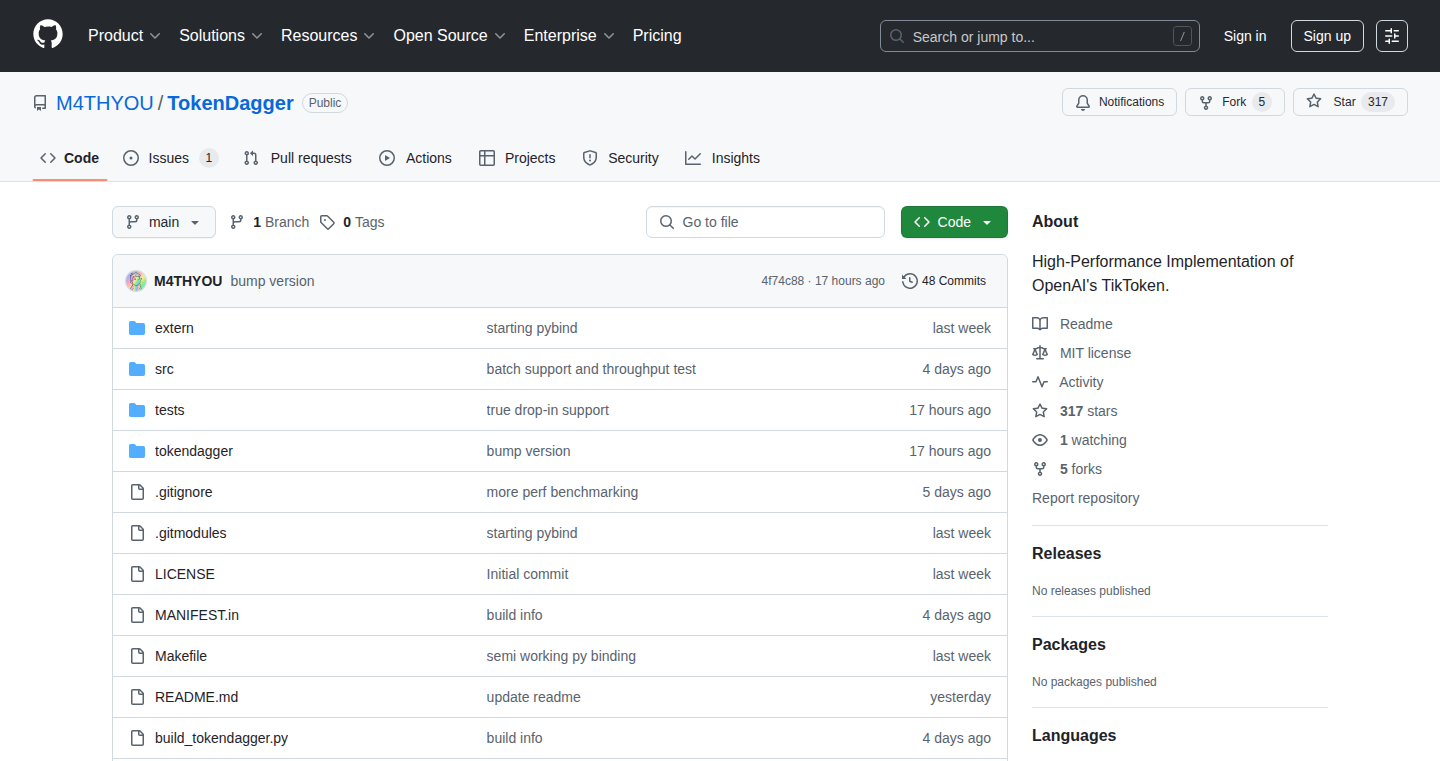
Author
matthewolfe
Description
TokenDagger is a drop-in replacement for OpenAI's Tiktoken, the tool that breaks down text into smaller units (tokens) for large language models (LLMs) like Llama 3 and GPT. This new version is written in C++ and focuses on speed. It offers significant performance improvements by using a faster regex engine and a simplified algorithm. So, this means faster processing of text, which translates to faster model performance and reduced costs.
Popularity
Points 256
Comments 71
What is this product?
TokenDagger is a faster version of the tokenizer used by many popular LLMs. Tokenizers are crucial for breaking down text into manageable pieces that LLMs can understand. This project reimplements the tokenizer in C++ and optimizes it for speed. Instead of relying heavily on the original method's regex matching, it leverages a faster regex engine and simplifies the tokenization algorithm. So, it’s essentially a speed upgrade for LLMs.
How to use it?
Developers can use TokenDagger as a direct replacement for Tiktoken in their projects. This means simply swapping out the existing code with TokenDagger. This will then allow developers to tokenize texts, which is essential for any project that uses large language models. For example, if you are building an AI chatbot, TokenDagger can process the user's input faster, leading to quicker responses. Also, you can use it for fine-tuning LLMs, training, and model evaluation. The drop-in replacement nature allows for effortless integration.
Product Core Function
· Faster Tokenization: TokenDagger processes text into tokens significantly faster than Tiktoken. This is achieved through code optimization and the use of a faster regex engine, leading to a 4x speed improvement on single-thread tokenization. This means you can process more text in less time.
· High Throughput: TokenDagger exhibits higher throughput, especially when processing large text files (1GB). This improved throughput translates to increased efficiency, especially in scenarios like batch processing large volumes of text or real-time applications where speed is critical.
· Drop-in Replacement: The ease of integration is very important for developers. TokenDagger is designed to work the same way as the original tokenizer, and simply swapping them out, allows for easy integration into existing LLM projects without major code changes. This saves developers time and effort.
· Maintain BPE vocab and special token rules: TokenDagger maintains the exact same BPE (Byte Pair Encoding) vocab and special-token rules. This ensures compatibility with existing models and avoids the need to retrain models. This means you can use it in existing projects without problems.
Product Usage Case
· AI Chatbot Development: When building an AI chatbot, TokenDagger can tokenize user inputs and bot responses faster. This reduces the latency and makes the interaction more real-time and responsive. This is very important to ensure user satisfaction.
· Large-Scale Text Processing: For applications that process large volumes of text, such as summarizing documents or performing sentiment analysis, TokenDagger's increased speed can dramatically improve performance. It provides a faster and more efficient tool for the job.
· Model Training: When training large language models, efficient tokenization is very important. Faster tokenization means faster training, allowing researchers and developers to iterate on models more quickly and accelerate the development process. TokenDagger helps you build your model more rapidly and effectively.
· Real-time Applications: In real-time applications like live translation or content generation, TokenDagger can help to tokenize the text faster. This will lead to faster results and a better user experience.
2
Ensō: Flow State Writing Tool

Author
rpastuszak
Description
Ensō is a writing tool designed to help you enter a state of 'flow' by separating the writing process from the editing process. This is achieved by making it harder to edit your work while you're still writing. The innovation lies in creating an environment that minimizes self-editing, allowing writers to focus on generating content without interruption. This addresses the common problem of writers getting stuck in editing mode prematurely, hindering their creative flow. So, this helps you to focus on creating, not correcting, making writing easier and more productive.
Popularity
Points 237
Comments 83
What is this product?
Ensō is a writing application built on the idea of separating writing and editing. It likely utilizes techniques such as distinct modes or time-based restrictions to prevent immediate editing. For instance, it may initially obscure the text you've written, requiring you to progress further before you can go back and edit. This could be achieved through a simple interface, potentially with a focus on distraction-free writing. The technical innovation lies in the thoughtful design of the user interface and workflow to foster a flow state, not necessarily the underlying technology itself (which is likely standard text editing functionality) but the way it uses it to solve a common issue. So, it helps you stay in the creative zone without getting bogged down in corrections.
How to use it?
Developers can use Ensō as a writing tool for documentation, blog posts, or any type of writing where sustained focus is beneficial. It can be integrated into their workflow to draft technical specifications, user guides, or even comments in code, prioritizing content generation over immediate perfection. This would involve opening Ensō, writing, and then exporting the text to the developer's preferred format. So, it allows you to rapidly create the content, which you can then refine using your usual tools.
Product Core Function
· Focus Mode: Prevents immediate editing. This is achieved by temporarily hiding or obscuring the written text until a certain time or progress is reached, preventing writers from prematurely self-editing, which helps maintain their flow. So, it lets you focus on generating content without constantly interrupting yourself.
· Minimal Interface: A clean, distraction-free interface to promote focus. By removing unnecessary buttons and formatting options, Ensō minimizes visual clutter and keeps the writer's attention on the text. This creates a more conducive writing environment. So, it gives you a cleaner, simpler writing space to concentrate.
· Workflow Separation: Separates writing from editing steps. This design might involve separate modes or sections for writing and editing, making the distinction between creation and refinement more deliberate. So, it explicitly creates a difference between writing and fixing, which aids in getting more done.
· Export Functionality: Allows exporting text in various formats. The ability to export the finished text enables easy integration with other tools and platforms that developers use for their work. So, it easily integrates with the tools and systems that you are already using.
Product Usage Case
· Documenting API Specifications: Developers can use Ensō to draft API documentation without getting sidetracked by formatting details or typos during the initial drafting phase. After completing the draft, they can export the text and format it using their documentation tools. So, this streamlines the writing of technical documentation.
· Writing Technical Blog Posts: A developer working on a blog post can use Ensō to generate the content quickly, focusing on explaining concepts and writing code examples. After the initial content is done, they can then refine it in a separate editing phase. So, it helps you write blog posts with less distraction.
· Creating Code Comments: While writing code, a developer might use Ensō to write detailed comments explaining complex algorithms. The flow-state nature of the tool helps the developer articulate complex ideas without getting bogged down in the minute details of the code. So, this allows for better and more elaborate comments.
· Writing Project Proposals: Developers often need to propose technical solutions. Ensō can help draft project proposals, allowing them to focus on describing the technology and its impact without getting caught up in formatting or perfect wording early on. So, it allows them to efficiently create proposals.
3
BeanBook: AI-Powered Coffee Companion

Author
rokeyzhang
Description
BeanBook is an iOS app built by coffee enthusiasts to streamline the coffee experience. It leverages AI to automatically detect coffee details from a photo of a coffee bag and extract recipes from YouTube links or images. It solves the problem of scattered coffee information, offering a centralized platform to log beans, track recipes, and analyze coffee habits. The key innovation is the integration of AI to automate data extraction and analysis, providing a richer, more organized coffee tracking experience.
Popularity
Points 52
Comments 47
What is this product?
BeanBook is a mobile application that uses Artificial Intelligence (AI) to organize and track your coffee journey. When you take a picture of your coffee bag, the app intelligently identifies the roaster, origin, roast date, and other important information about the beans. You can also paste a link to a YouTube video or upload a picture of a recipe, and BeanBook can extract the recipe details. This allows coffee lovers to keep all their coffee information in one place, from the type of beans they use to their preferred brewing methods. So, this means you can ditch the messy notes and scattered information and have everything you need, right at your fingertips. The innovation lies in using AI to automate data entry and provide a more intuitive user experience.
How to use it?
As a coffee lover, you can simply snap a picture of a coffee bag, and BeanBook will automatically fill in the details. You can add your grind size, brewing notes, and ratings to each coffee entry. You can also save recipes by pasting links from YouTube or uploading recipe images. All the data is saved in a clean and easy-to-use interface. So, if you're a coffee enthusiast, you can use BeanBook to quickly log your coffee beans, track your brewing methods, and keep detailed notes about your coffee experiences. It's like having a digital coffee journal. You can also analyze your coffee habits over time. For example, if you're a developer, you can use this app to easily track your coffee consumption and find the best coffee for your coding sessions!
Product Core Function
· Auto-detection of coffee details: The app uses image recognition to automatically identify the roaster, origin, process, roast date, notes, producer, and farm from a picture of a coffee bag. This is useful because it saves time and effort when logging coffee information. So, if you're tired of manually entering all the details, this feature does it for you, making coffee tracking effortless.
· Recipe extraction from YouTube and images: You can paste a YouTube link or upload a photo of a recipe, and BeanBook will extract the structured recipe automatically. This feature allows users to easily save and organize their preferred brewing methods. So, if you’re a coffee enthusiast who loves to experiment with different brewing techniques, this is your go-to feature, allowing you to keep all your favorite recipes in one place.
· Logging grind size, roast timeline, ratings, and notes: The app allows users to log detailed brewing information such as grind size, roast timeline, ratings, and notes, all saved in a clean and elegant UI. This provides a comprehensive view of the coffee experience. So, this feature is great for keeping track of all the variables that affect the final cup of coffee. If you are serious about your coffee, you need this feature to track every detail.
· Coffee year in review: BeanBook offers a 'Coffee Year in Review' feature, allowing users to track their habits, trends, and favorites. This helps to understand your coffee preferences and brewing habits over time. So, it's like a personalized coffee analytics dashboard. If you're curious about which beans you love most or want to see how your brewing skills have improved over time, this feature is perfect.
· Ask BeanBook AI: Get instant answers about brew temps to bean facts with the help of the app's integrated AI functionality. The AI provides a quick and easy way to get coffee-related information. So, whether you're a newbie or a seasoned coffee aficionado, this feature is a quick and easy way to have your coffee questions answered.
Product Usage Case
· Personal coffee journal: A coffee lover can use BeanBook to document their coffee journey, including bean information, brewing recipes, and personal notes. The AI-powered features make it easy to capture and organize coffee details. So, instead of scattered notes, you have an organized digital journal. If you are interested in keeping a detailed log of your coffee experiences, this is perfect.
· Recipe management and sharing: Baristas or home brewers can use the app to document and share their coffee recipes with friends or other users. This provides a way to catalog and share the art of brewing. So, if you want to share your coffee creations with others, this feature will help you do so, making recipe management easy and fun.
· Coffee habit tracking and improvement: Coffee drinkers can track their coffee consumption, brewing preferences, and experiment with different beans and brewing methods. By analyzing their coffee habits and experimenting with variables, users can refine their techniques. So, by analyzing your coffee habits over time, you can use this feature to improve and refine your techniques.
4
Direct File Revival: A Self-Hosted Tax Filing Tool
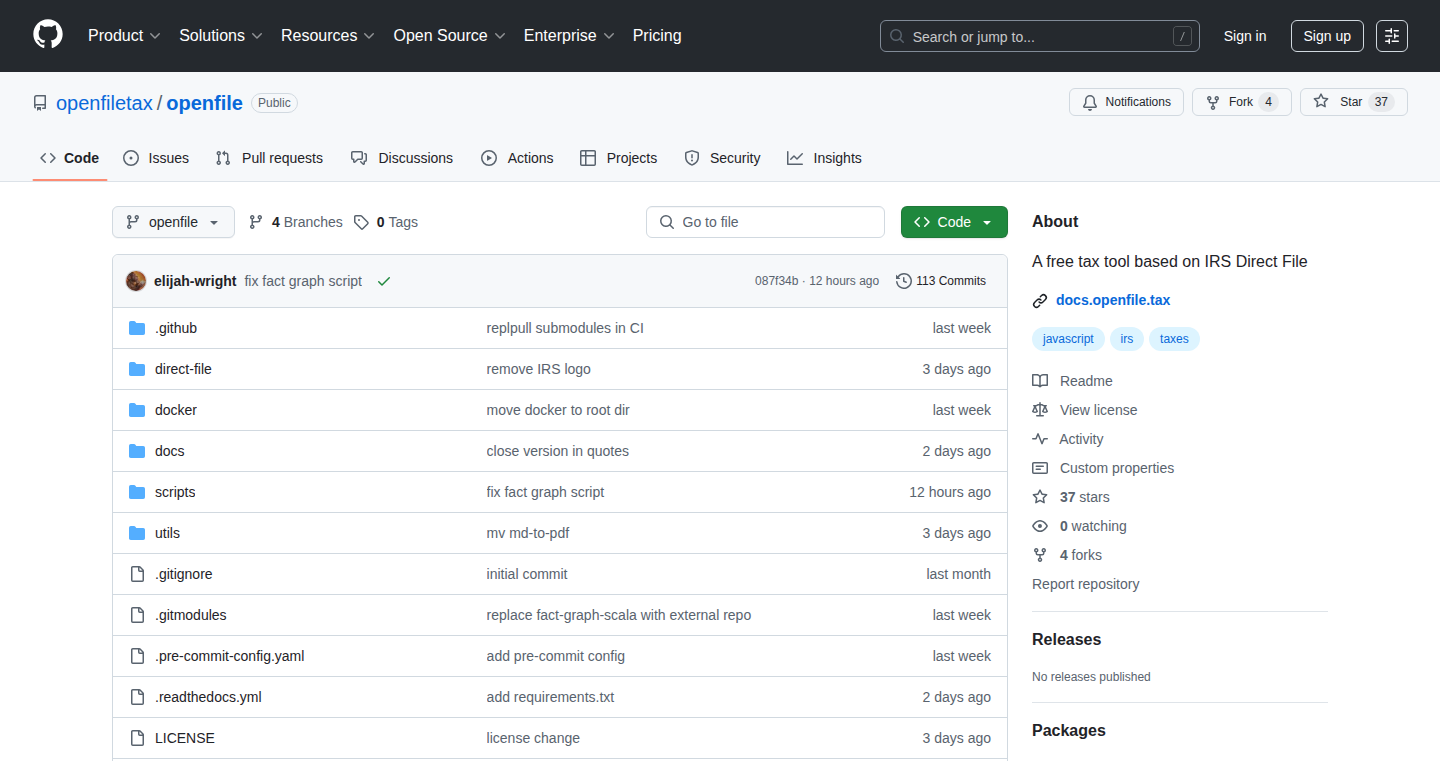
Author
elijahwright_
Description
This project is a continuation of the IRS's Direct File project, a tax filing tool they open-sourced. Due to various reasons, the IRS is no longer actively developing it. This project aims to keep the tool alive and allow users to self-host it. It tackles the technical challenge of providing a secure and accessible tax filing system, addressing the need for a free and open-source alternative for tax preparation, ensuring data privacy and user control.
Popularity
Points 67
Comments 5
What is this product?
This project revives the IRS's Direct File, a tax filing software, allowing users to run it themselves (self-hosting). It's based on the original IRS code but developed independently. The innovation lies in offering a user-friendly tax filing experience while giving users complete control over their data and ensuring transparency through open-source code. It's essentially a do-it-yourself tax preparation system, but with a focus on being open, free, and private. So this is useful because it gives you an alternative to commercial tax software.
How to use it?
Developers can use this project by downloading the source code and setting up the environment to run it locally or on their own servers. This involves configuring databases, security settings, and adapting to specific tax regulations. The project provides documentation and guides to help developers. You could integrate this into a larger financial management tool or use it as a base to customize for specific tax needs or geographic locations. So this lets you have your own tax filing system, customizable to your needs.
Product Core Function
· Tax Form Processing: The core function is handling tax forms. It uses logic to interpret and process tax data, which ensures accuracy in tax calculations. This is important because it accurately calculates your taxes.
· Secure Data Handling: It is designed with security as a top priority. It implements measures to protect user data during the filing process. This is vital because it makes your tax filing secure.
· User Interface: The project provides a user-friendly interface for entering tax information, making the complex process of tax filing easier to navigate. This helps people easily file their taxes.
· Self-Hosting Capabilities: This enables users to run the software on their own hardware, offering complete control over data and privacy. This is important because users can ensure privacy and data control.
Product Usage Case
· Personal Use: Individuals can self-host the software and file their taxes directly, ensuring privacy and control over their data. So you can have control over your tax information.
· Community Project: A group of developers can collaborate to enhance and maintain the software, making it better and more accessible. So you can improve and share the software with others.
· Educational Purposes: Students and developers can study the codebase to understand the technical aspects of tax filing systems and open-source software. So it can provide you with an educational opportunity.
· Customization: Developers could modify the software to support tax regulations in specific regions or to add advanced features. So you can build your own tax filing software that works for you.
5
Local LLM Notepad: Pocket-Sized AI for Everyone
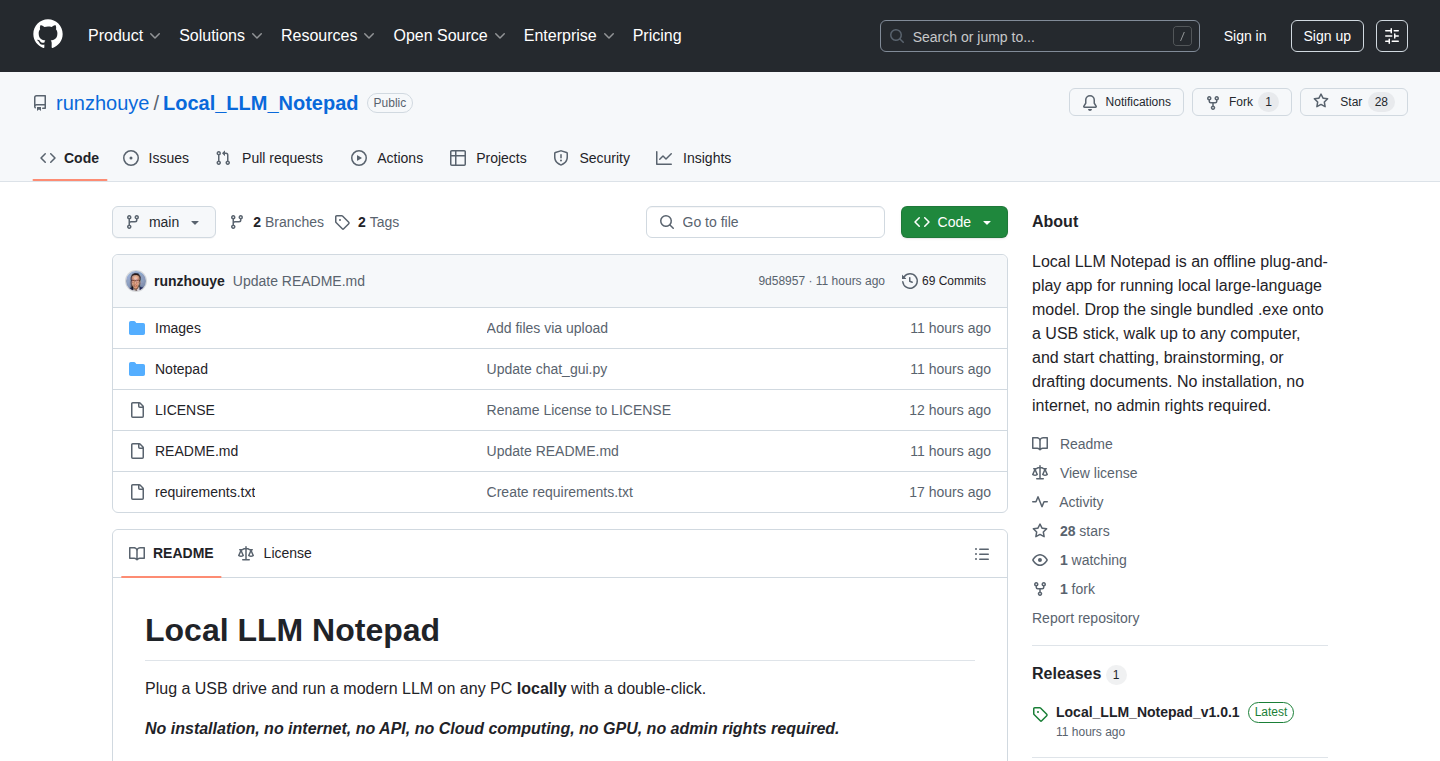
Author
davidye324
Description
This project packages a powerful, GPT-style language model (LLM) into a single, self-contained Windows executable (just 45MB!). You can copy it and a model file onto a USB drive, plug it into any Windows PC, and start chatting with an AI without needing internet, administrator rights, or complex installation. The magic happens through a clever combination of tools: PyInstaller bundles everything needed, llama.cpp enables the LLM's processing, and a simple UI provides the interface. It focuses on simplicity and portability, enabling anyone to experience AI locally, even without technical expertise. So this means you can have AI on the go, and have it with you everywhere, without the need of an Internet connection.
Popularity
Points 18
Comments 5
What is this product?
This is a local AI assistant, all contained on a USB drive. It uses llama.cpp, a highly efficient library for running LLMs on standard computers. The project ingeniously packages this along with a UI (user interface) into a single executable file. This makes it incredibly easy to use – you don't need to install anything or have any special technical skills. It loads the LLM directly from your USB drive and streams responses, even on less powerful hardware. The key innovation is this extreme portability and ease of use. So this project allows anyone to use an LLM with ease.
How to use it?
Developers use this by copying the executable and a compatible model file (.gguf) onto a USB drive. Then, they can simply plug the drive into any Windows PC and double-click the executable to start the AI assistant. The UI provides a straightforward interface for interacting with the model. This is perfect for demos, client visits, or environments where internet access or complex installations aren't feasible. Developers can also adapt the project's code to integrate a local LLM into their own applications. So this allows the developers to create an on-demand AI application with ease, which is an ideal solution for situations where internet access is restricted.
Product Core Function
· Single-file Executable: The project bundles everything into one .exe file. So this means no complicated installation procedures, everything is ready to use right away. This allows developers to easily distribute their AI applications for deployment in offline scenarios or in environments with security constraints.
· USB Drive Portability: Designed to run directly from a USB drive. So this means the AI assistant is truly portable. This is perfect for demonstrating AI capabilities on the go or in secure environments where data cannot be transferred.
· llama.cpp Integration: Leverages the efficiency of llama.cpp. So this means it provides fast performance, even on standard hardware. This allows developers to experiment with and deploy LLMs on a wide range of hardware.
· Minimalist UI: Includes a simple user interface for easy interaction. So this means users without technical backgrounds can easily chat and interact with the AI model. This makes the AI accessible to a much wider audience.
· Prompt Highlighting: Highlights tokens originating from the prompt. So this means the user can quickly identify and verify the model's reasoning, improving transparency and trust.
Product Usage Case
· Client Demonstrations: Imagine you're showcasing an AI-powered feature to a client who has strict network security. You can use the Local LLM Notepad from a USB stick to show the AI in action without needing internet access. This ensures a smooth and secure demonstration. So this means you can impress your customers at all times.
· Offline Research: A researcher wants to analyze text data using an LLM but has limited or no internet access. By using Local LLM Notepad, they can load a model and perform their analysis completely offline, protecting the data. So this helps data scientists and researchers focus on their core tasks.
· Education and Training: Educators can use this to teach AI concepts without the need for complex setups. Students can experiment with LLMs without requiring powerful computers or internet connections. This makes AI more accessible for learning. So this improves learning experiences by allowing students to engage with AI without any limitations.
6
Flexprice: Open-Source Usage-Based Billing Toolkit
Author
Koshima
Description
Flexprice is an open-source platform designed to simplify and streamline usage-based billing for AI and agentic companies. It tackles the complexities of handling high-volume data, real-time usage tracking, and prepaid credit systems, offering a robust solution to common billing challenges. The core innovation lies in providing developers with tools to reliably ingest events, debug billing data, and automate billing workflows, ultimately reducing revenue leaks and customer disputes.
Popularity
Points 7
Comments 14
What is this product?
Flexprice is a toolkit that helps developers build and manage usage-based billing systems. It works by providing tools for ingesting and processing event data (like API calls or token usage), calculating usage charges, managing credits and trials, and automating invoicing and subscription changes. The key innovation is providing a set of pre-built, production-ready components that address common billing pain points, such as handling large data volumes, dealing with missing events, and managing prepaid credits. So it provides a robust, scalable, and customizable solution for billing needs, reducing the need for custom coding and maintenance.
How to use it?
Developers can integrate Flexprice into their applications using SDKs (Python, JavaScript, Go) to send usage events. These events are then processed by Flexprice, which calculates charges, manages credits, and provides real-time usage analytics. Developers can then integrate with the provided API to get billing-grade summaries or configure webhooks to automate invoicing or subscription changes. This allows developers to quickly implement a robust billing system without having to build everything from scratch. For example, an AI service provider would integrate the SDK into their API endpoints to track token usage; then the provider could use Flexprice’s analytics to monitor customer usage, generate invoices, and apply discounts.
Product Core Function
· Fire-and-forget event ingestion with SDKs (Python, JS, Go) and auto retry handling: Allows developers to reliably send usage events to Flexprice, even under heavy load. This ensures no events are lost, preventing underbilling and ensuring accurate customer invoices. So, it means a developer doesn't have to worry about building custom systems to ensure all usage data is captured.
· Real-time event debugger for tracking ingestion status, filtering payloads, and inspecting failures: Provides a real-time view of the ingested events, helping developers to quickly identify and fix any issues. It's like a live view into how your app's billing data is being processed, allowing you to debug problems quickly. Thus, it helps to catch errors in billing logic before they impact customers.
· Usage analytics API providing billing-grade summaries with filters, groupings, and time-bucketed results: Enables developers to easily query and analyze usage data for reporting and customer insights. It allows for generating detailed reports on how customers are using the service. Therefore, the developers can quickly gain visibility into usage patterns and make informed business decisions.
· Prepaid credit system supporting trial credits, expirations, and configurable priority on deduction: Enables the management of prepaid credits, trials, and discounts, addressing a common challenge in usage-based billing. This feature simplifies the management of promotions and customer incentives. Hence, developers can offer flexible pricing models.
· Webhook system to automate billing workflows like invoicing or subscription changes: Allows developers to automate repetitive tasks like invoicing and plan changes, integrating with existing billing and CRM systems. This makes it simpler to handle the billing process and reduces manual work. Consequently, it allows developers to automate the entire billing lifecycle, freeing them from manual tasks.
Product Usage Case
· An AI service provider using the Python SDK to track the number of tokens used by each customer in real-time. They then use the analytics API to generate usage reports for their sales team and create invoices automatically via the webhook system. So this removes the need for manual tracking and invoicing, saving time and reducing errors.
· A SaaS company that offers a free trial period for new users. Flexprice's credit system is used to manage trial credits and automatically convert users to paid plans after the trial expires. Hence, the developer avoids having to build a custom trial management system, reducing complexity.
· A platform that provides API access to a machine learning model. The developer uses Flexprice's event ingestion system to track the number of API calls each customer makes. The developer then leverages the analytics API to create a dashboard showing the real-time usage of different customers. So they get accurate billing, even with a high volume of API requests, and can offer tiered pricing based on usage.
7
WhisperMac: Real-time Private Transcription
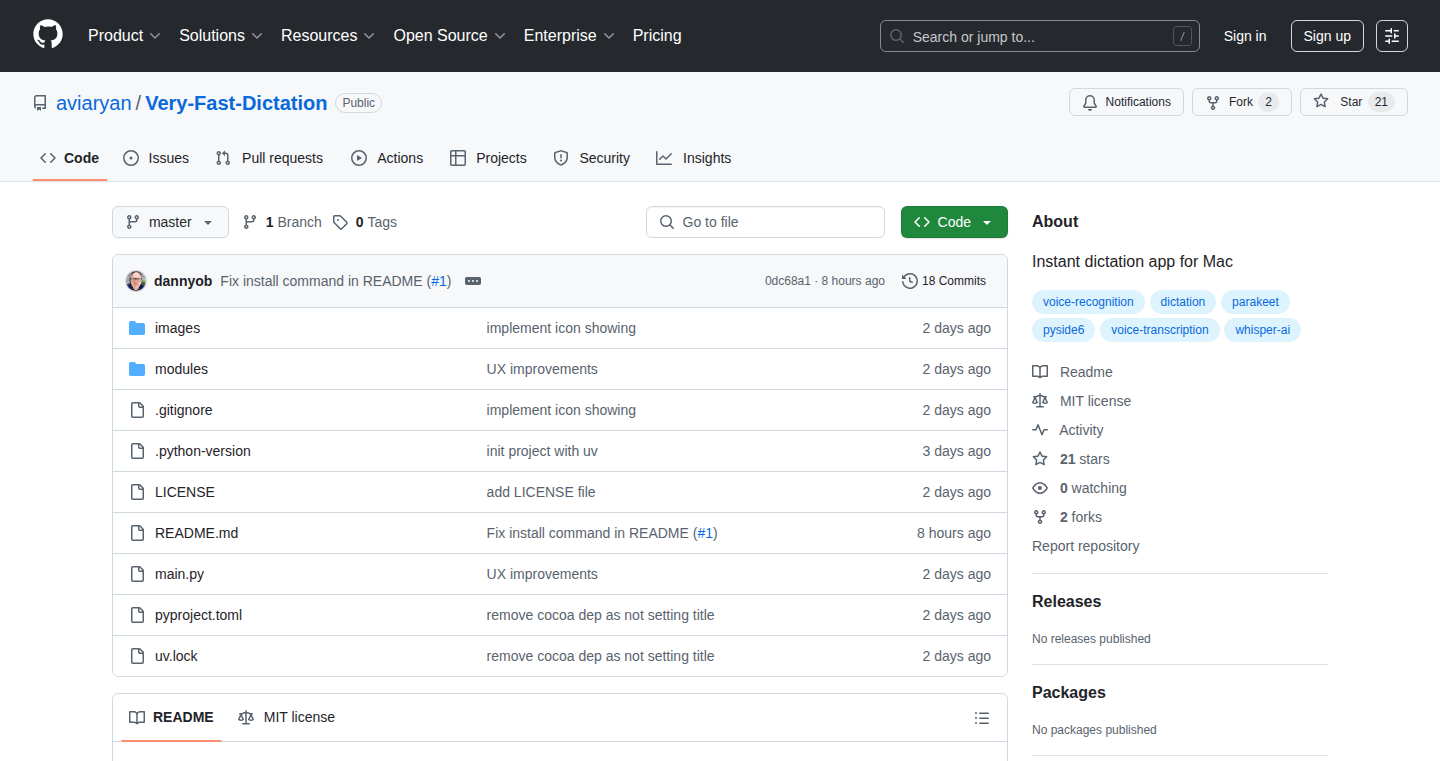
Author
aviaryan
Description
WhisperMac is a real-time dictation application for macOS that leverages the power of local processing and the Whisper model, offering private and accurate transcription without sending your audio to the cloud. It solves the privacy concerns associated with cloud-based transcription services and allows for fast, offline speech-to-text conversion, making it ideal for note-taking, writing, and accessibility.
Popularity
Points 15
Comments 4
What is this product?
WhisperMac is a macOS application that converts your spoken words into text in real-time. The magic behind it is the use of a powerful open-source AI model called Whisper, which processes your speech directly on your Mac, ensuring your audio data never leaves your computer. This means your conversations and recordings stay private, unlike many online services that require you to upload your audio to their servers. So it's like having your own personal, offline transcriptionist. This innovation focuses on privacy and speed, making the transcription process seamless and secure.
How to use it?
Developers can use WhisperMac in various ways. For instance, you could integrate it into their own applications for note-taking, accessibility features for people with disabilities, or for building voice-controlled interfaces. It works by capturing your microphone input and displaying the transcribed text in real-time, which you can then copy and paste, save to a file, or integrate into your workflow. So if you are building a tool that requires voice input, this is a great starting point.
Product Core Function
· Real-time transcription: The core function is the ability to convert spoken words into text as you speak, providing an immediate textual representation of audio input. This is useful for generating live captions or transcribing meetings.
· Local processing: WhisperMac runs entirely on your Mac, without requiring an internet connection or sending your audio to the cloud. This ensures privacy and works even when you are offline.
· Whisper model integration: It utilizes the Whisper AI model, known for its accuracy in speech recognition, even in noisy environments or with varying accents. This ensures reliable transcription, improving the quality of text outputs.
· User-friendly interface: The application features a simple and intuitive interface, making it easy to start and manage transcriptions with minimal technical setup. So, it does not require you to be a technical expert to use it.
· Privacy-focused design: The app prioritizes user privacy by processing all audio locally. Your spoken words are never uploaded or stored on external servers, providing peace of mind regarding data security.
Product Usage Case
· Note-taking application: Developers can integrate WhisperMac to allow users to take notes by dictation, transcribing their thoughts in real time. It speeds up note-taking in lectures and meetings.
· Accessibility features: Developers can use WhisperMac to build applications that offer real-time captions for deaf or hard-of-hearing users, making content more accessible.
· Voice control integration: Developers can leverage WhisperMac to build voice-controlled interfaces for their apps. This enables users to interact with applications using their voice, enhancing the user experience.
· Content creation: It can be used for rapid transcription of podcasts, interviews, or any other audio content into text, making it easy to create written summaries or articles from audio recordings.
8
Dittofeed: Embedded Messaging Components for Applications
Author
chandlercraig
Description
Dittofeed simplifies the integration of messaging features like workflow builders and user segmentation into any application. It addresses the common problem of developers spending significant time reimplementing these features, especially in vertical SaaS. By providing embeddable components (initially iframes, later headless React components), Dittofeed allows developers to quickly add messaging capabilities, saving them months of development time. This approach, inspired by Looker's embeddable analytics, provides a streamlined solution for communication within any application.
Popularity
Points 14
Comments 4
What is this product?
Dittofeed offers pre-built messaging components that can be easily integrated into your application. Instead of building features like drag-and-drop workflow builders, user segmentation, and template editors from scratch, you can embed Dittofeed's components. These components are initially available as iframes, making them simple to integrate. The core innovation is in providing a ready-made, customizable messaging layer, which drastically reduces development time and effort. So this means you get a ready-made, customizable messaging system without having to build one yourself.
How to use it?
Developers can integrate Dittofeed's components using iframes or, soon, headless React components. You'd embed the components into your application's interface. The specific usage will depend on the component, but common scenarios include building workflows for automated messaging (e.g., sending emails based on user actions), segmenting users for targeted campaigns, and creating message templates. To get started, you would get the admin API key from Dittofeed's support. So you get ready-to-use components and you can configure them to fit your exact needs.
Product Core Function
· Embedded Workflow Builders: This allows developers to include visual tools for creating automated messaging workflows. It's like a drag-and-drop interface for setting up message triggers and actions. Application: automate onboarding emails or send personalized messages based on user behavior. So you can easily automate complex messaging sequences without writing code.
· User Segmentation Builders: These tools enable developers to segment users based on specific criteria (e.g., behavior, demographics) to send targeted messages. Application: This is useful for sending personalized promotions, product updates, or support messages to relevant groups of users. So you can ensure that the right message gets to the right people, improving engagement.
· Template Editors: These features allow developers to create and customize message templates for consistent branding and efficient messaging. Application: You can use these templates for email marketing, in-app notifications, and other forms of communication. So you can maintain a consistent brand voice and save time creating messages.
· Admin API Key: This allows you to get access to Dittofeed's features. Application: You can get full control over Dittofeed's components, helping you to customize every detail. So you can get a high level of customization and control over the messaging features.
Product Usage Case
· Vertical SaaS for Healthcare Providers: A healthcare app can use Dittofeed to build communication tools for doctors to reach out to patients. They can set up automated appointment reminders, send post-visit surveys, or share health updates, all within the app. This saves developers from building these features from scratch. So you can build a communication hub directly into your product and increase its usefulness.
· E-commerce Applications: An e-commerce platform can use Dittofeed to create targeted email campaigns, sending personalized product recommendations or cart abandonment reminders. This enhances customer engagement and drives sales. So you can increase your sales by communicating directly with your users within your platform.
· Customer Support Portals: A customer support app can integrate messaging components to provide in-app chat and support ticket management. This improves the customer experience by offering instant support. So you can boost customer satisfaction by offering instant support.
9
Praxos: The AI Agent's Memory & Understanding Engine
Author
mogusian
Description
Praxos is like a smart assistant for AI, giving it a super-powered memory and the ability to understand complex information. It takes messy data from all sorts of sources (documents, databases, conversations) and turns it into a well-organized knowledge graph. This lets AI agents work more accurately and make fewer mistakes, especially when dealing with complicated tasks like understanding insurance policies or answering questions based on many sources. It tackles the problem of AI 'forgetting' or misinterpreting information by explicitly defining relationships within the data, making it easier for AI to access and use context.
Popularity
Points 11
Comments 3
What is this product?
Praxos is a system designed to help AI agents understand and remember information better. It works by taking raw data (like PDFs, spreadsheets, or chat logs) and transforming it into a structured 'knowledge graph'. Think of this graph as a smart database where everything is connected in a meaningful way. The key innovation is that Praxos explicitly defines relationships between different pieces of information. For example, it knows that a 'property' is related to a 'building' and that 'John' is the owner of that property. This makes it easy for the AI to find and use the right information without making mistakes or having to re-interpret it every time. It offers an SDK (Software Development Kit) to help developers quickly integrate this system into their projects. So what does this mean for you? It means your AI powered tools can be much more reliable.
How to use it?
Developers can use Praxos by integrating its SDK into their AI agent applications. You feed Praxos your raw data, and then you define what kind of information is important (the 'ontology'). Praxos then builds the knowledge graph. When the AI needs information, it asks Praxos, which can quickly retrieve the relevant data and context. This is especially useful for applications that need to understand complex relationships within the data. For example, if you are building a customer service chatbot that needs to understand a customer's order history and preferences, Praxos can help you do this in a much more efficient and accurate way. This is for you because it allows you to quickly and reliably make more intelligent AI tools.
Product Core Function
· Data Parsing: Praxos can understand all sorts of data, like documents, tables, and even conversations. This is valuable because it eliminates the need to manually clean and pre-process data from different sources, saving time and effort.
· Knowledge Graph Creation: It builds a 'knowledge graph', organizing data into a structured, interconnected format. This helps the AI understand the relationships between different pieces of information. This means the AI can make more informed decisions, by understanding how all the pieces fit together.
· Semantic Typing & Relationship Mapping: Praxos labels and connects data in a meaningful way, such as explicitly indicating the relationships between entities in the data. This enhances the accuracy and relevance of the AI's responses. So your AI powered solutions are much more accurate.
· Efficient Information Retrieval: Praxos can quickly find the right information by using graph traversal techniques, vector similarity, and key-value lookups. It’s like having a super-smart search engine for the AI. This reduces the time it takes for the AI to respond and provide value.
· Learning and Adaptation: Praxos allows intermediate and final outputs, along with user edits, to be added back to the knowledge graph, enabling on-the-fly learning. This enables AI apps to adapt over time and become more effective based on new information and user feedback. So, your AI gets smarter over time.
· End-to-End Processing: The system can process data from start to finish, meaning you can feed it raw files and it will handle everything from start to finish. That means it handles cleaning and organizing the data for you. This simplifies development by handling the complexities of the data processing.
Product Usage Case
· Insurance Claims Processing: An AI agent can use Praxos to understand insurance policies and quickly answer questions about coverage and claims. The AI can quickly navigate complicated documents, understand all the details, and provide accurate answers to users' questions.
· Customer Service Chatbots: Imagine a customer service chatbot that can understand a customer's past orders, their preferences, and any problems they've had. Praxos allows the chatbot to provide personalized and helpful responses, which means more satisfied customers.
· Legal Document Analysis: A system that can read and understand legal documents, identify key clauses, and explain them in plain English. It can help you to quickly and efficiently analyze legal documents.
· Scientific Research Analysis: AI that can understand research papers, connect related findings, and provide summaries. Praxos allows researchers to synthesize massive amounts of research and make discoveries faster.
· Supply Chain Management: A system that can track goods, understand supplier relationships, and predict potential disruptions. This helps to make better decisions by giving real-time insights into the supply chain.
10
OntoCast: Agentic Knowledge Graph Extractor

Author
acrostoic
Description
OntoCast is an open-source framework that helps you automatically extract useful information (semantic triples) and build knowledge graphs from unstructured documents like PDFs, JSON, and Markdown. The core innovation is its 'agentic workflow' that uses Large Language Models (LLMs, like OpenAI or Ollama) to not just extract information, but also to dynamically select or create the best-fitting ontology (a kind of data structure for organizing knowledge) and refine it iteratively. This makes information extraction much more accurate and context-aware, especially for complex documents spanning multiple domains. So this helps me accurately extract knowledge from messy data.
Popularity
Points 8
Comments 5
What is this product?
OntoCast is a tool that turns unstructured data (like text documents) into structured knowledge graphs. It uses LLMs as 'agents' to drive the process. First, it figures out the best way to organize the information (ontology). Then, it uses this ontology to extract specific facts (semantic triples) from the documents. This means it understands not just the words, but also the relationships between them. This is different from simple keyword searches, because it understand the context and relationships of words. So this helps me to build structured data from unstructured documents for better data analysis.
How to use it?
Developers can integrate OntoCast into their systems via an API server that's compatible with the MCP standard. You provide the documents and OntoCast extracts the knowledge, and stores it in a knowledge graph database (Jena Fuseki or Neo4j). You can then query this knowledge graph to find relationships, patterns, and insights. So this helps me automatically extract knowledge in a structured way, by writing just a little bit of code.
Product Core Function
· Agentic Workflow: Utilizes LLMs to automate the extraction and ontology refinement process. This means the system can learn and adapt to different types of documents and information, leading to more accurate results. So this helps me to automatically adapt to new data formats.
· Dynamic Ontology Selection/Creation: Automatically selects or generates a relevant ontology. This is crucial for handling complex documents and diverse information, as a pre-defined ontology often isn't enough. So this helps me work with different kinds of data that may have been difficult to analyze before.
· MCP-compatible API server: Provides an easy way to integrate the knowledge extraction process into existing software and applications, making it simple for developers to use. So this helps me to easily integrate into other existing applications.
· Flexible Storage: Supports popular knowledge graph databases like Jena Fuseki and Neo4j, providing options for storing and managing the extracted knowledge. This offers flexibility in terms of scaling and data management. So this allows me to choose the best storage method depending on my project requirements.
· Open Source: As an open-source project, developers can contribute, customize, and build upon the existing code. This fosters collaboration and innovation in the field of knowledge graph generation. So this provides me with transparency and control over the tool and community support.
Product Usage Case
· Extracting structured knowledge from scientific papers: OntoCast can automatically extract key findings, relationships between concepts, and experimental setups from scientific papers, enabling researchers to quickly synthesize information and identify relevant studies. So this helps me quickly understand scientific papers.
· Processing financial reports: Analyze financial reports to identify key performance indicators, relationships between companies, and market trends, making it easier to make investment decisions. So this helps me to perform complex analysis on financial reports.
· Analyzing clinical trial documents: Quickly extract information from clinical trial documents, such as patient demographics, treatment protocols, and outcomes, helping researchers and medical professionals gain insights and accelerate research. So this allows me to automate the analysis of clinical trial data.
11
CORE: Context Oriented Relational Engine
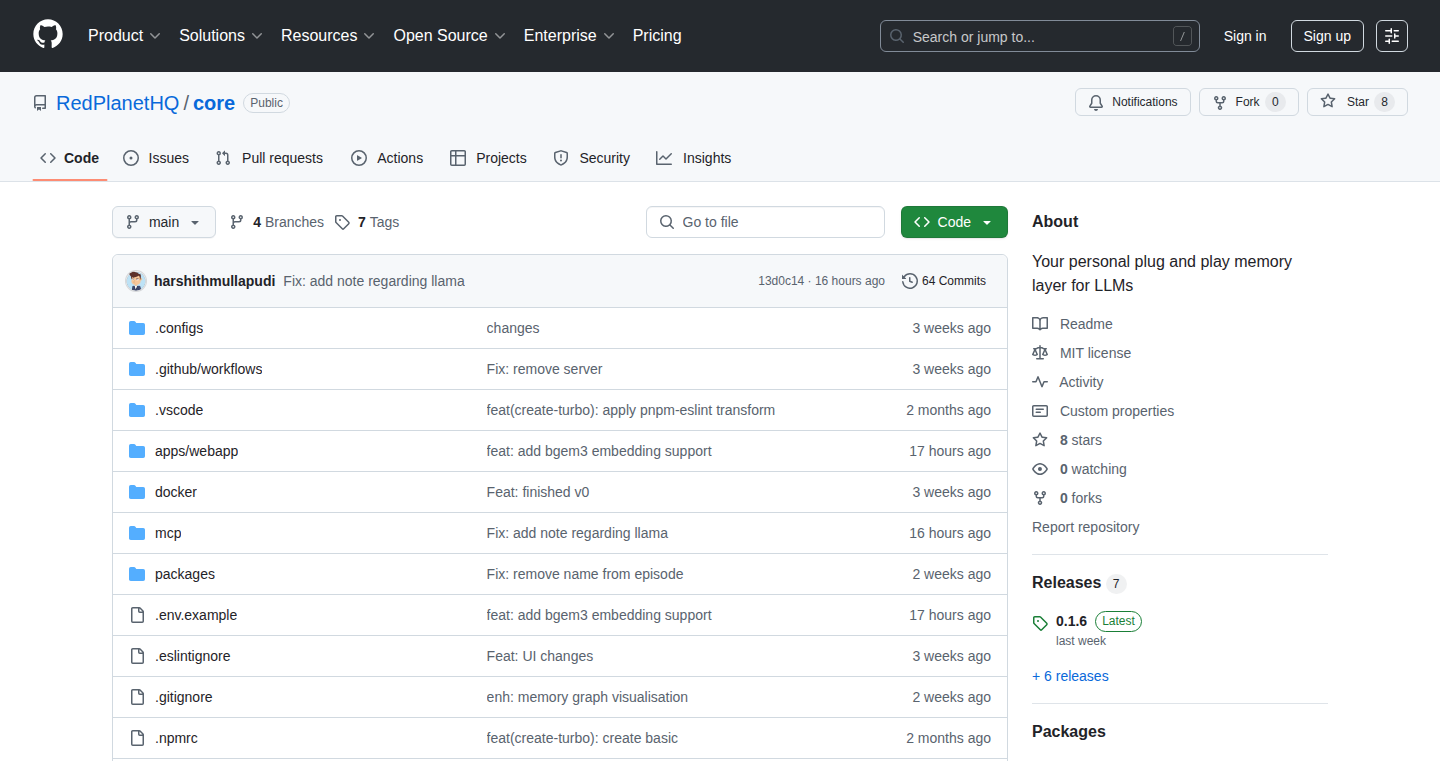
Author
Manik_agg
Description
CORE is an open-source knowledge graph designed to solve the problem of AI applications forgetting your past interactions and context. It allows you to create a shareable memory vault that can be accessed by different AI tools like ChatGPT, Cursor, and Claude. The core innovation lies in its temporal and relational approach to storing information, preserving a complete history of facts and their provenance. This avoids the common issue of context being locked within individual AI applications. Essentially, it provides a unified and persistent memory for your AI interactions.
Popularity
Points 9
Comments 0
What is this product?
CORE is a system that acts as a central brain for your AI assistants. It stores information in a structured way, allowing you to build a detailed history of your interactions and projects. Unlike typical AI tools that have isolated memories, CORE lets you share your knowledge across different applications. It’s based on a 'knowledge graph', which is like a smart database that understands relationships between pieces of information. The system keeps track of who added information, when, and why, so you always know where it came from and how it's changed over time. So this gives you a memory that’s portable and you control.
How to use it?
Developers can use CORE to create a shared memory for their AI-powered applications. They can integrate it into existing projects using Docker, run it locally, or use a hosted instance. This involves connecting their AI tools to the CORE database to retrieve and store context. For example, you might use CORE to store project details and then allow both ChatGPT and Cursor to access this information. Integration involves using APIs to read and write to the knowledge graph. So this means you can make your AI tools more consistent and aware of your work.
Product Core Function
· Shareable Knowledge Graph: This feature allows you to create a central repository of information that can be accessed by multiple AI tools, such as different chatbots or coding assistants. So this allows you to avoid re-explaining yourself to each tool and provides a consistent understanding across them.
· Temporal and Relational Data Storage: CORE stores information with timestamps and version history, allowing users to see how information has evolved and who made the changes. This provides transparency and allows you to track the context's evolution over time. So you can ask things like “What was our roadmap last quarter?” and understand how decisions evolved.
· Local-first or Hosted Deployment: CORE offers the flexibility to run the system on your own computer (local-first) or use a hosted version. This gives you control over your data, whether you prioritize privacy or ease of use. So you can choose the setup that best fits your needs and level of technical expertise.
· Fact Tracing: This capability allows users to understand the origin and history of each piece of information stored in the system. It provides insights into the source, when it was added, and any changes that have occurred. So this allows you to understand the reasoning behind the AI’s response.
· Contextual AI Integration: Designed to be easily integrated with popular AI platforms (ChatGPT, Claude, etc.), allowing for seamless retrieval and use of the information stored in CORE. So it makes the AI more helpful and less forgetful.
Product Usage Case
· Project Management: A development team can store all their project-related information, such as roadmaps, decisions, and meeting notes, in CORE. Different AI tools used by the team can then access this unified memory, ensuring consistency and avoiding information silos. So this ensures the whole team is always on the same page.
· Personal Knowledge Management: An individual can use CORE to build a persistent memory of their work, ideas, and preferences. By integrating their AI tools, they can ensure that these tools have access to their personal knowledge base. So you can have all your tools working together in sync with your information.
· Customer Support: A company can use CORE to store customer interactions, product information, and support documentation. When a customer service representative uses an AI assistant, it can access this memory to provide more informed and consistent answers. So you can give your customers a great experience by always providing correct answers.
· Research and Development: Researchers can use CORE to store research findings, experimental data, and project documentation. This allows them to maintain a comprehensive and accessible record of their work, which can be easily accessed by their AI tools. So you can speed up your research and reduce wasted time.
12
NumPad: A Local-First Notepad Calculator with CRDT Syncing
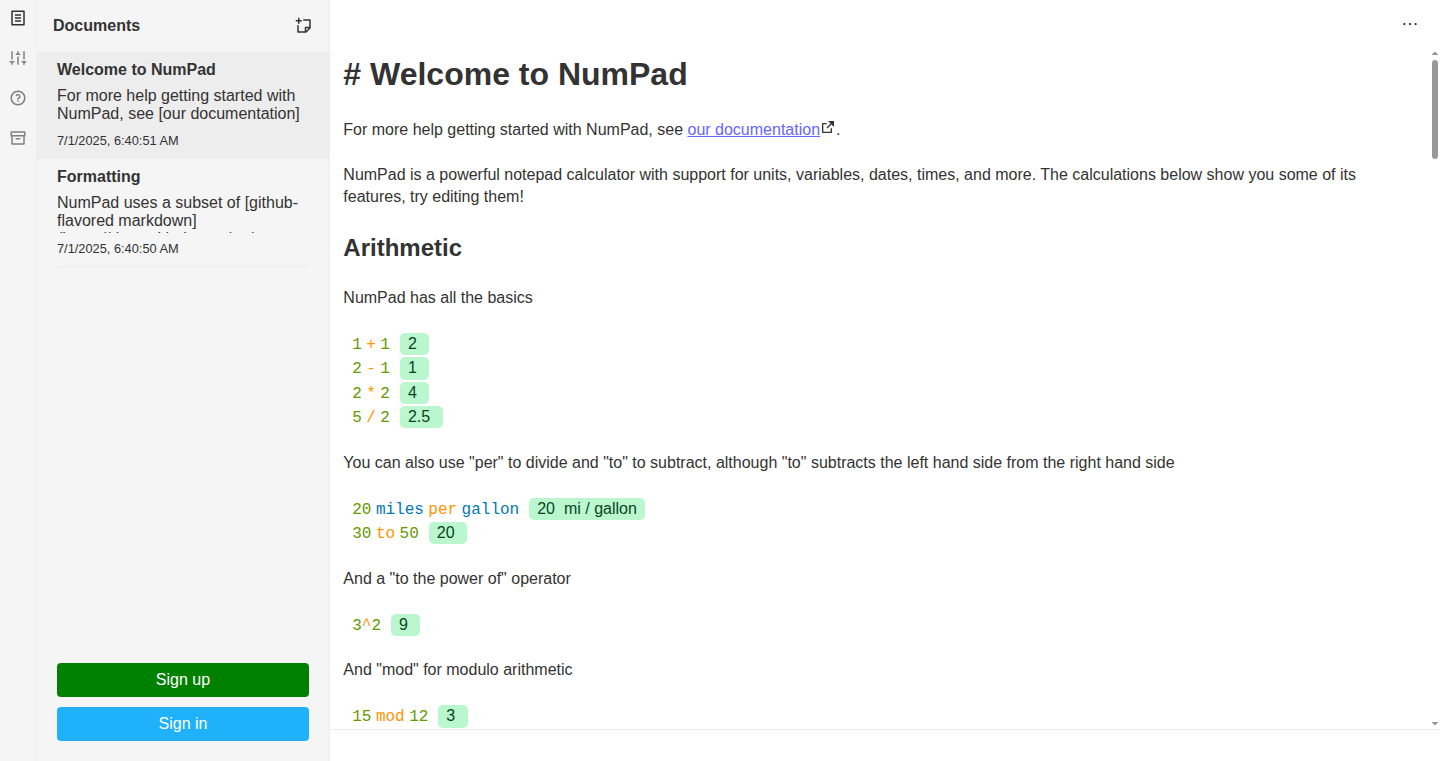
Author
tonyonodi
Description
This project is a complete rewrite of a notepad calculator application, now built as a Progressive Web App (PWA). It allows users to create and manage multiple documents, which are stored locally using IndexedDB. The key innovation is the implementation of real-time syncing for paying users, utilizing Automerge, a Conflict-free Replicated Data Type (CRDT) library. This means multiple users can collaborate on the same document, even offline, and changes are automatically merged when they reconnect. This solves the problem of data loss and the limitations of traditional online-only applications. So this is useful if you need a calculator that saves your work, works offline, and allows real-time collaboration with others.
Popularity
Points 6
Comments 1
What is this product?
NumPad is a notepad calculator that goes beyond a simple calculator. It's a PWA, meaning it can be installed and used like a native app, even offline. The core technology is Automerge, which allows for concurrent editing and syncing across multiple devices and users. Automerge works by using a CRDT approach, which is a clever way of merging different versions of the same data without conflicts, like magic. When you edit a document on one device and someone else edits it on another, Automerge figures out all the changes and merges them together seamlessly. So this offers a robust way to store and sync the data without depending on a central server all the time.
How to use it?
Developers can use NumPad as a reference for building their own local-first applications. They can study how the PWA is structured, learn how IndexedDB is used for local storage, and see a practical example of integrating Automerge for real-time syncing. For example, developers can copy the sync system to their own apps. For users, you can simply use the app as a note taking app and calculator. For paid users, you can share your documents. So you can reuse this project as a reference or building a similar PWA app.
Product Core Function
· Multiple Document Management: Allows users to create, save, and manage multiple calculator documents, similar to how you might manage notes in a text editor. This is useful for organizing calculations and keeping track of different projects.
· Local Storage with IndexedDB: Persists documents locally using IndexedDB, ensuring data is available offline and improving the user experience. This is valuable because it makes the app faster, more responsive, and protects against data loss due to internet connectivity issues.
· CRDT Syncing with Automerge: Provides real-time syncing for paying customers, enabling collaborative editing across multiple devices. Automerge handles merging changes automatically, even when users are offline. This offers a great way to enable collaboration, like Google Docs, without the need to build the backend infrastructure. So you can use this feature for collaborative projects.
· PWA Architecture: Built as a Progressive Web App, allowing installation and offline access. This creates a user-friendly, accessible application that behaves like a native app.
Product Usage Case
· Collaborative Financial Modeling: A team of financial analysts can use NumPad to collaboratively create and edit financial models, with real-time syncing ensuring everyone has the latest data, even when offline. They could work on the same spreadsheet from different devices.
· Offline Note-Taking with Synchronization: A student can use NumPad to take notes during a lecture and have them automatically synced to their other devices. This is useful in case there is a bad network connection.
· Shared Scientific Calculations: Scientists working on the same research project can use NumPad to share and collaborate on complex calculations, ensuring everyone is working with the same inputs and outputs, and saving and syncing everything locally for security. This is helpful since you can use the app in a remote location, and maintain the research data.
· Development Reference: Developers building similar apps can use NumPad as a blueprint to understand how to implement local-first architecture, offline storage, and real-time syncing using CRDTs. This will teach developers to implement their own tools.
13
PassFace: AI-Powered Boarding Pass Transformation

Author
jimhi
Description
PassFace is a playful project that leverages computer vision and image processing to morph a boarding pass photo into a 'bald JD Vance' representation for airport check-in. This showcases the power of facial recognition, style transfer, and image manipulation, demonstrating how AI can be used for fun and creative purposes, even in everyday scenarios like travel. It also highlights the adaptability and accessibility of these technologies for developers looking to experiment with image processing.
Popularity
Points 3
Comments 3
What is this product?
PassFace uses AI, specifically computer vision and style transfer, to transform the image on your boarding pass. It detects faces, applies a bald-head style transfer, and generates a funny, albeit slightly absurd, modified image. This project is a fun demonstration of what's possible with readily available AI tools and APIs. It's about taking existing technologies and using them in a novel way to create something unique.
How to use it?
Developers could use PassFace's core principles to build similar projects. For example, you could adapt the code to: integrate with a camera to detect faces, apply different styles to photos, or create a custom image manipulation pipeline. The project likely uses open-source libraries like OpenCV for image processing and potentially a pre-trained model for style transfer. Think of it as a starting point for developers interested in exploring facial recognition, image transformation, and creative AI applications.
Product Core Function
· Face Detection: The project uses an algorithm to identify faces in a boarding pass photo. This could be helpful for applications that need to automatically identify people in images, such as security systems or social media platforms. So what? If you're working on an app that deals with photos of people, knowing where the faces are is crucial for things like cropping, tagging, and applying effects.
· Style Transfer: Applying a pre-defined style (like 'bald JD Vance') to a face. This technique allows you to change the aesthetic of an image quickly. Imagine how this could be used to create artistic filters or personalize avatars. So what? If you're developing an image editing app, style transfer can enable users to transform their photos into different artistic styles with minimal effort.
· Image Manipulation: Combining the face detection and style transfer results to generate the final transformed boarding pass image. This could be applied to many other applications, such as adding special effects to pictures or creating custom animations. So what? This could be useful in a wide variety of applications where image modification is needed such as in video games or AR applications.
· User Interface (Hypothetical): Although not explicitly mentioned, a user interface likely exists to accept the boarding pass image as input and display the output. This concept can be extended to many other projects that require user interactions to take an image as input and generate a modified output. So what? This is fundamental to making the whole system usable, such as apps that allows users to upload images or apply artistic filters.
Product Usage Case
· Personalized Profile Pictures: Developers could adapt the technology to create a website or mobile application that allows users to upload photos and apply various artistic styles, allowing them to generate unique profile pictures or avatars for social media. This demonstrates how quickly AI can customize personal branding or profiles.
· Entertainment Applications: Integrating face detection and style transfer into games or augmented reality (AR) applications to create realistic effects. Imagine being able to transform your face into a character in a game or apply fun filters to your video calls. So what? Creating engaging experiences like this are highly sought after in gaming and entertainment, leveraging AI to enhance immersive experiences and interactivity.
· E-commerce: Applying style transfer to product photos to showcase them in different environments or with varying features. For example, applying a different hairstyle on a model to a specific product. So what? This can significantly enhance product presentation and provide customers with a more accurate idea of how a product would look when used.
14
PrivacyPolicy Summarizer: LLM-Powered Transparency

Author
pearinc
Description
This project uses Large Language Models (LLMs) to summarize complex privacy policies into easily understandable summaries. The core innovation is applying AI to make dense legal text accessible to the average user, solving the problem of opaque and confusing privacy policies. It retrieves the privacy policy text from a URL, uses an LLM (likely something like Perplexity's Sonar API) to generate a summary, and then manually refines the results. This project showcases the potential of AI to improve user understanding of online data practices, making the internet safer and more transparent.
Popularity
Points 2
Comments 4
What is this product?
It's a tool that takes the lengthy and often confusing privacy policies of apps and websites and turns them into short, easy-to-understand summaries. It works by feeding the privacy policy text into an AI (specifically, a LLM) which processes the information and generates a concise version. So you can quickly grasp what data an app collects, how it's used, and who it's shared with. It's like having a translator for legal jargon. So this is useful for everyone.
How to use it?
Developers can integrate this tool by feeding the privacy policy URL to an API (like the Perplexity Sonar API used in this case) and obtaining the summarized text. This summarized text can be displayed directly to the user. For instance, a developer creating a privacy-focused app could display summaries of other apps' privacy policies, allowing users to easily compare privacy practices. The project is still in early stages but is designed to be automated with web scrapers like ParseHub or Scrapy. So it’s a quick way to show others what they are doing.
Product Core Function
· Privacy Policy Extraction: The project extracts the text of privacy policies from provided URLs. This is the foundational step, accessing the source material for summarization. So this is how we can get all the info.
· LLM-Based Summarization: An LLM (e.g., using a tool like Perplexity Sonar API) is used to process the privacy policy text and generate a concise summary. This uses AI to distill complex information. So this is how we make it simple.
· Manual Refinement: The generated summaries are reviewed and edited to ensure accuracy and clarity. This is a critical step for maintaining quality. So this is how we make it human-friendly.
Product Usage Case
· Transparency Dashboards: A privacy-focused website could use the tool to create a dashboard comparing the privacy practices of different apps or services. Users could easily compare what data each app collects and how it’s used. So this is useful for making a fair comparison.
· Privacy App Ratings: Developers of privacy-focused apps could use the summaries to help rate the privacy of other apps, giving users valuable information about the data collection practices of other services. So this can help other apps to be safe.
· User Education: Websites or blogs focused on online privacy could use the tool to create informative articles and guides on privacy policies, making the topic accessible to a wider audience. So this is a good way to learn about privacy.
15
Glitchy BARD: Client-Side Robot Poetry Generator

Author
stankot
Description
Glitchy BARD is a quirky project that generates poetry using a combination of n-grams derived from input text and rhymes sourced from the CMU Pronouncing Dictionary. It then uses the browser's built-in SpeechSynthesis API to read the generated poetry aloud, all running directly in your web browser. This project is a fun experiment showcasing how to blend language models, rhyme generation, and web technologies like CSS animation and speech synthesis in a creative way. It demonstrates a practical application of these technologies, making the process of creating and sharing unique content simple and engaging.
Popularity
Points 5
Comments 1
What is this product?
Glitchy BARD is a web application that creates poems. It takes source text, breaks it down into n-grams (sequences of words), and finds rhyming words from a dictionary. It then combines these elements to form poetic lines. The resulting poem can be heard using your browser's text-to-speech functionality. The whole process occurs within your web browser, so no data is sent to any server. The project is designed as a fun experiment to combine language models, rhyme generation, and web technologies. So, it's all about experimenting with how to create unique content easily.
How to use it?
You don't 'use' Glitchy BARD in the traditional sense. It's more of a demonstration. However, as a developer, you can examine its open-source code to learn how it uses n-grams for language generation, how it implements rhymes, and how it interfaces with the SpeechSynthesis API. You can then use these techniques in your projects, perhaps to generate unique content, create interactive stories, or build a web application that can speak. You can integrate the generation of this type of content into your websites or applications. Essentially, it's a learning tool and a source of inspiration for developers who want to play with language and web technologies.
Product Core Function
· N-gram Generation: This is the core of the poetry generation. By breaking down the input text into sequences of words (n-grams), the program can then recombine them in novel ways, creating unexpected and potentially interesting phrases. So this allows you to create original text based on existing text.
· Rhyme Generation: The project utilizes the CMU Pronouncing Dictionary to find words that rhyme. This adds structure and musicality to the generated poems, making them more engaging. Therefore, this is helpful for building interactive text-based experiences.
· Speech Synthesis: The poems are read aloud using the browser's SpeechSynthesis API. This adds an auditory dimension to the experience, making it more interactive and accessible. So, it's about making your website or app talk in a fun and engaging way.
· Client-Side Execution: The entire application runs in the web browser. This means no server-side processing is required, making it fast, efficient, and easy to share. Therefore, users can enjoy the poetry without waiting or sending any information to a server.
· Random Number Generator Seed Sharing: The project uses a random number generator (RNG) to create randomness in the poetry generation. It allows users to share specific poems by sharing a URL that includes the RNG seed. This feature promotes reproducibility and allows others to recreate the same poem. Therefore, this is helpful for anyone building applications that depend on randomness.
Product Usage Case
· Interactive Storytelling: A developer could use the n-gram and rhyme generation techniques to create an interactive story where the user's choices influence the poem's generation. This could add depth and replayability to a simple game. For instance, imagine a game where the player chooses words or phrases that influence the narrative generated in a poetic style.
· Content Creation Tools: Developers could build tools that help writers generate ideas, overcome writer's block, or experiment with different styles of writing. Imagine a tool for generating headlines or blog post outlines. This could speed up the content creation process.
· Educational Applications: The project can be adapted to teach about language, poetry, and the mechanics of writing. This is particularly helpful for language learning or creative writing exercises.
· Personalized Experiences: Integrate similar technologies into websites and apps to create dynamic content. For example, you could create personalized greetings that change with each visit or automated feedback systems with creative replies. This makes interactions more interesting.
16
Vibe HTTP: LLM-Powered HTTP Server
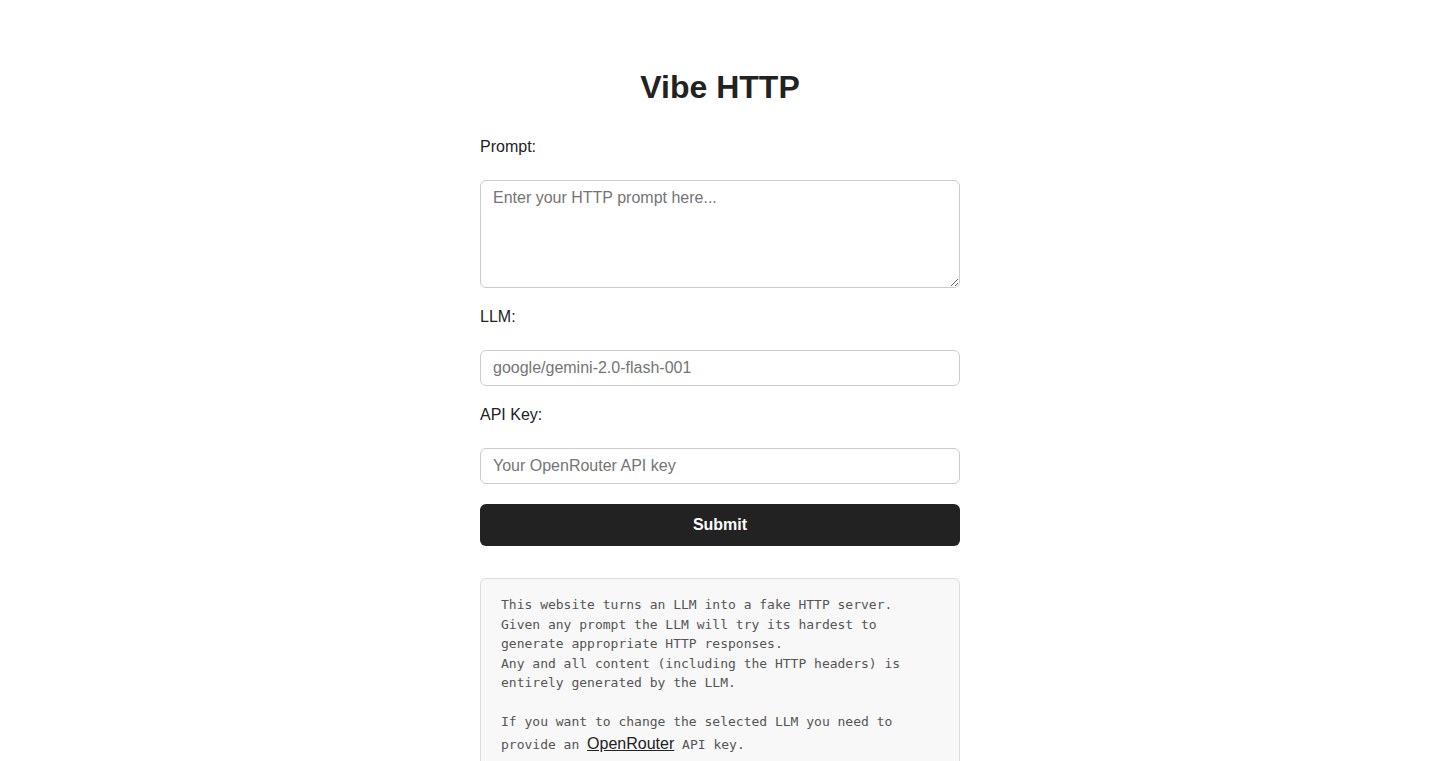
Author
bangoose
Description
Vibe HTTP is a novel approach to building HTTP servers by leveraging the power of Large Language Models (LLMs). It transforms the traditional server architecture, enabling the LLM to interpret and respond to HTTP requests, effectively acting as a smart, conversational web server. This represents a significant departure from conventional server logic, opening doors to dynamically generated content and interactive applications. The core innovation lies in the LLM's ability to understand and process natural language input from HTTP requests, generate responses based on that understanding, and return them as HTTP responses. So this is useful for creating highly flexible and adaptable web services that can understand complex user intent.
Popularity
Points 2
Comments 3
What is this product?
Vibe HTTP utilizes a Large Language Model (LLM) to act as an HTTP server. Instead of hard-coded responses or traditional server-side logic, the LLM analyzes incoming HTTP requests (e.g., GET, POST requests). It then generates responses based on its understanding of the request, effectively creating dynamic and intelligent web interactions. This allows for building applications that can understand natural language queries and provide contextually relevant answers. So this lets you build websites or APIs that can truly understand what users are asking for.
How to use it?
Developers can integrate Vibe HTTP by pointing their HTTP requests to a Vibe HTTP server instance. The server then processes the requests, uses the LLM to generate a response, and returns the output. This can be incorporated through various programming languages and frameworks that support HTTP communication. This means developers can build APIs or web applications without having to write much of the backend logic themselves – the LLM handles it. For example, if you want to create a chatbot that responds to HTTP requests, or create a web application that generates content, this is for you.
Product Core Function
· Dynamic Response Generation: The core function of Vibe HTTP lies in its ability to dynamically generate HTTP responses based on the content of the incoming requests. This eliminates the need for pre-defined responses, as the LLM can create them on the fly. This is valuable for creating web applications that can adjust to different user inputs in real time. So you can build a website that adapts to user requests, making it feel more responsive and intelligent.
· Natural Language Understanding: The project allows the LLM to parse and understand natural language queries embedded within HTTP requests. This facilitates the creation of more intuitive and user-friendly web interfaces. So you can build an interface that lets users ask questions in plain English and get answers instantly.
· Contextual Awareness: The LLM can maintain context across multiple requests, allowing for more complex and conversational interactions. This enables building interactive web applications. So you can create applications where the user and the application can have a conversation.
· Content Generation: The project demonstrates the potential for generating content like text, code snippets, and more, directly from HTTP requests, making it an ideal option for content-driven applications. So you can build apps that create personalized content based on a user's request.
Product Usage Case
· Building Conversational APIs: Developers can create APIs that engage in a conversation with the user, understanding the context of each request and providing tailored responses. This could be a travel booking API that has a dynamic response. This is perfect for building intuitive and user-friendly interfaces for any web service.
· Automated Content Creation: Developers can utilize Vibe HTTP to build applications that automatically generate articles, summaries, or other content based on user requests or input, saving time and effort. This will empower you to have websites that generate content on the fly.
· Interactive Educational Platforms: Vibe HTTP can power interactive learning platforms where users can ask questions and receive immediate, contextually relevant answers and generate educational content. This would allow the creation of platforms that can tailor their responses to specific student needs.
· Dynamic Website Content: Vibe HTTP enables creating websites that generate content dynamically based on user input or other external factors, making websites feel more interactive. For example, a news website that generates personalized headlines based on the user's interests.
17
FoundersAround: A Geo-Social Platform for Founders
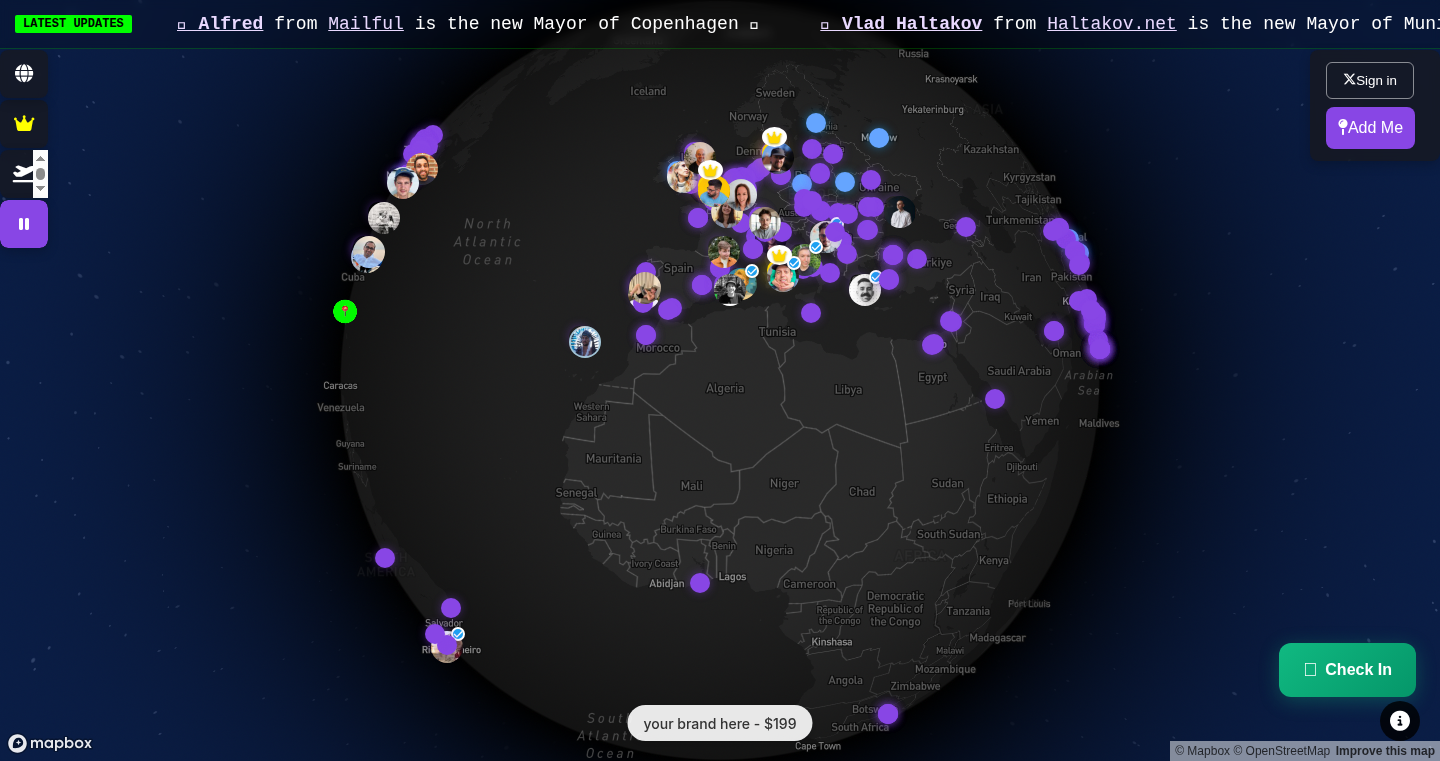
Author
leonagano
Description
FoundersAround is a simple, location-based platform allowing founders to discover and connect with each other. It leverages the power of geographical data and simple user-generated content to solve the common problem of founder isolation and networking challenges. This project utilizes a mapping system and a basic profile system to facilitate real-world connections, fostering a sense of community among entrepreneurs. So what's in it for me? It helps you quickly find and connect with other founders in your area, expanding your network and opening doors to potential collaborations and support.
Popularity
Points 4
Comments 1
What is this product?
This project is a digital map where founders can add their location. The technology behind it likely uses a combination of a mapping API (like Google Maps or Leaflet) and a database to store founder profiles and their associated geographical coordinates. When a user visits the website, the system queries the database for founders within a specified radius of their location and displays them on the map. The innovation lies in its simplicity and focus: it's a hyper-local networking tool designed specifically for founders. So what's in it for me? It lets you find founders near you. No more cold emails, you can connect and meet up with founders in person.
How to use it?
As a founder, you simply add your location to the map, creating a profile. The website will then show you other founders near you. You can then reach out to those founders, perhaps to get feedback, find collaborators, or even just make new friends. You might integrate this with your existing professional network, using it to discover events or even to travel and connect with founders abroad. So what's in it for me? It enables you to build your network easily.
Product Core Function
· Location-Based Discovery: The core function is the ability to visualize founders' locations on a map. This uses geographical data to connect people based on their proximity. The value is providing a quick way to see who's around you. It helps with networking and collaboration.
· Profile Creation: Founders can create simple profiles to share information about their ventures. This allows for filtering or choosing the right type of founder to connect with. The value is adding context to the simple location data so users know who they are meeting with.
· Map Visualization: It visualizes founder locations on a map, showing users who is nearby. The value is its simplicity makes it easy to find and connect with founders without any barriers.
· User interaction: The system provides ways for founders to directly interact with each other, like reaching out and starting a conversation. The value is to transform the founders map from a tool to find users to a tool to start conversations and meet founders.
Product Usage Case
· Networking: A founder uses FoundersAround to find other founders in their city and meets them for coffee, leading to a new collaboration and a potential investment opportunity. This helps to boost a founder's local network.
· Travel: A founder is traveling to a new city and uses FoundersAround to see which founders are located there. This allows the founder to connect with those individuals and schedule in-person meetings. This helps a founder to have a global network and make new friends.
· Finding Mentors: A founder looking for advice finds a more experienced founder in their area through FoundersAround and reaches out for mentoring. This gives the younger founder a chance to get mentorship.
18
OOMOL: Local-First Workflow Automation Engine
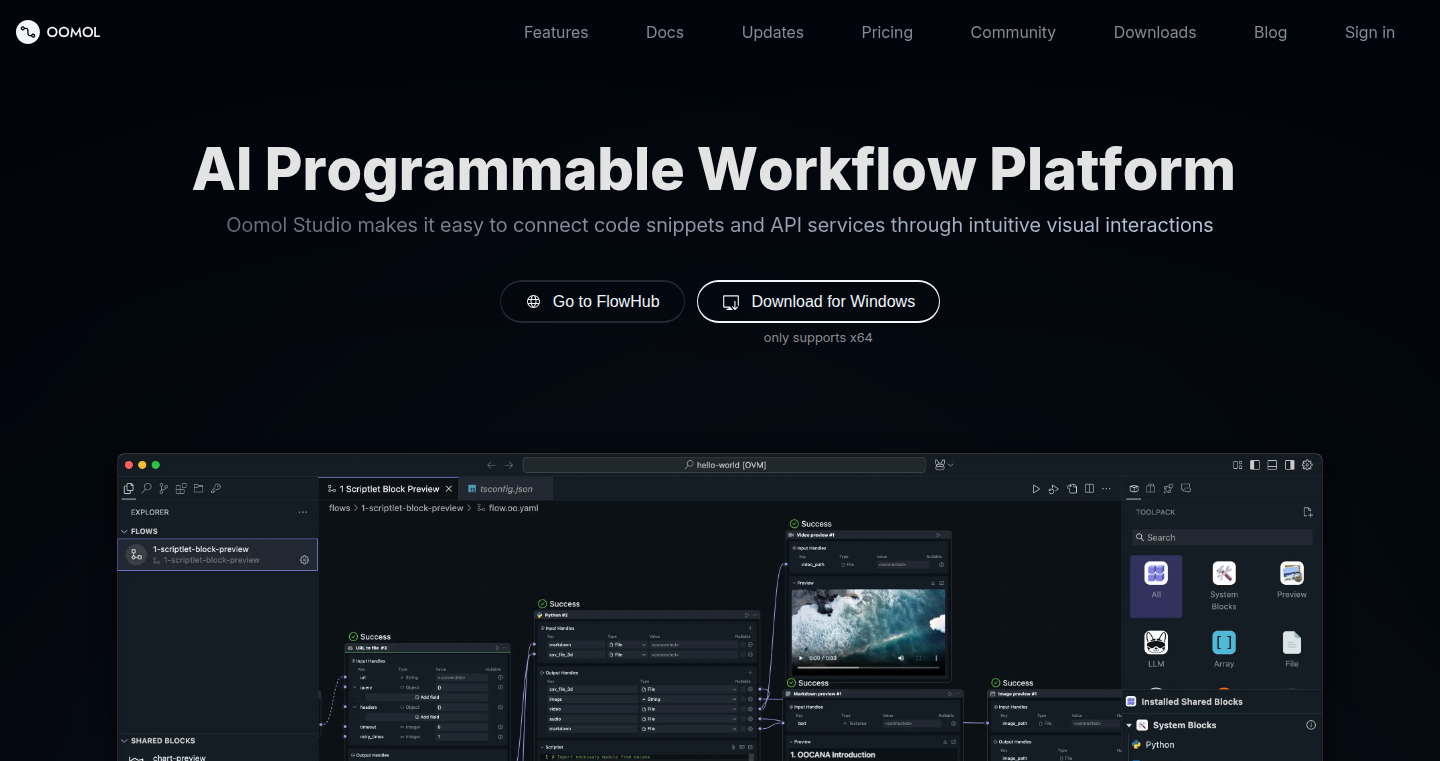
Author
monica-guli
Description
OOMOL is a workflow automation platform designed for developers, allowing them to automate tasks using Python and Node.js code within a local, containerized environment. Unlike cloud-based solutions like Zapier, OOMOL offers developers greater control and flexibility by running workflows on their own machines. It supports integrating third-party libraries and allows for mixing Python and Node.js in a single workflow. It's like a visual code editor that builds and runs your automation workflows locally.
Popularity
Points 2
Comments 2
What is this product?
OOMOL allows developers to visually create and manage automated workflows using both Python and Node.js code. It runs entirely on your computer, offering more control and privacy than cloud-based services. The core innovation lies in its 'local-first' approach, supporting both programming languages and integrating external libraries. This provides a powerful, flexible, and private way to automate any kind of tasks you can think of, such as automating file processing, data scraping, or system integration. So this is important because you retain full control of your data and how it is used, while providing powerful automation capabilities.
How to use it?
Developers use OOMOL by visually building workflows in a graphical interface. They can drag and drop pre-built nodes and customize them with Python or Node.js code to perform specific actions. These workflows can be as simple as processing a file or as complex as integrating different software systems. Once a workflow is built, it can be run locally or shared as a container or subflow. This project can be used as a replacement for Zapier or n8n. So you can design your automation workflow as you like. This means greater flexibility and control for developers.
Product Core Function
· Local-first execution: Workflows run on your machine within a container, ensuring data privacy and control. This is valuable because it eliminates the need to trust a third-party cloud service with your data, which is especially important for sensitive information and internal processes.
· Python and Node.js support: Allows developers to write code in both popular languages, enabling them to leverage a wider range of libraries and tools. This is valuable because it gives developers the flexibility to use the languages they are most comfortable with, integrating existing codebases and a vast ecosystem of tools.
· Third-party library support: Integrates easily with Python's pip and Node.js's npm, allowing developers to incorporate external libraries into their workflows. This is valuable because it expands the functionality of the automation system, enabling integration with various APIs, databases, and other services.
· Visual workflow design: Offers a drag-and-drop interface with programmable nodes, making workflow creation easier and more intuitive. This is valuable because it allows developers to build workflows quickly, reducing the time and effort required to automate complex tasks.
· Sharing and reuse of workflows: Enables developers to share and reuse their workflows as containers or subflows, promoting collaboration and code reusability. This is valuable because it saves developers time and effort by allowing them to leverage existing workflows, streamlining the automation development process, and improving team efficiency.
Product Usage Case
· Automating data scraping and processing: A developer can create a workflow that automatically scrapes data from a website, processes it using Python libraries, and then stores the processed data in a local database. This is a valuable because it reduces manual data entry and analysis efforts.
· Integrating multiple services: A developer can build a workflow that automatically triggers actions in different services. For example, when a new email arrives, it triggers the creation of a task in a project management tool, and send a notification via Slack. This is valuable because it creates a workflow to improve productivity.
· Automating file processing and transformation: A developer can create a workflow that automatically converts files from one format to another, such as converting PDFs to text or images, or automatically resizing images. This is valuable because it automates repetitive file tasks.
19
AltGenAI: AI-Powered Automated Image Alt Text Generator

Author
andrej-wp
Description
AltGenAI is an online tool and WordPress plugin that leverages Artificial Intelligence (AI) to automatically generate alternative text (alt text) for your images. This tool tackles the time-consuming and often tedious task of manually writing alt text, which is crucial for website accessibility and SEO. By analyzing images and generating descriptive text, AltGenAI saves developers and content creators valuable time while improving their website's visibility and user experience. The innovation lies in its use of AI to understand image content and translate it into meaningful text descriptions.
Popularity
Points 4
Comments 0
What is this product?
AltGenAI is a tool that uses AI to analyze your images and generate text descriptions for them. Think of it like giving your website a smart assistant that can 'see' your images and explain them to both search engines and users who might not be able to see the images, like those using screen readers. The innovation is in the AI’s ability to understand what’s in the image and automatically create the alt text. This is much faster and easier than writing the text yourself.
How to use it?
Developers can use AltGenAI in two main ways: 1) Through the online tool, where you upload an image and get the alt text generated. 2) By installing the WordPress plugin, the tool integrates directly into your WordPress website, allowing you to automatically generate alt text as you upload images. This is particularly useful for content creators and anyone managing a website with a lot of images, making their content more accessible and SEO-friendly.
Product Core Function
· Automated Alt Text Generation: The core function is automatically generating alt text from image analysis. This is done by employing image recognition AI to analyze the image's content and produce a textual description. So what? This saves time and effort compared to manual creation and improves website accessibility for users with visual impairments, as well as search engine optimization (SEO) by providing context for images.
· WordPress Plugin Integration: The WordPress plugin allows for seamless integration into WordPress websites. This integrates the AI-powered alt text generation directly into your content creation workflow. So what? This simplifies the process of adding alt text to images as you upload them, greatly streamlining the process of improving website accessibility and SEO.
· Batch Processing: The tool will likely offer the ability to process multiple images at once, generating alt text for numerous images in a single operation. So what? This is highly valuable for large websites or those needing to update alt text quickly and efficiently, saving significant time and effort by automating a tedious process.
· User-Friendly Interface: Both the online tool and the plugin likely have a straightforward and easy-to-use interface. So what? This makes the technology accessible even to users who are not technically inclined, thus broadening its user base and enabling more people to utilize AI-powered alt text generation without needing advanced technical expertise.
Product Usage Case
· E-commerce Websites: An online store can use AltGenAI to automatically generate alt text for product images, increasing the website's visibility on search engines. For example, imagine an online store selling shoes. The tool will generate alt text like 'black leather sneakers with white soles'. So what? This improves SEO by making product images easier to find in search results.
· Blog Posts: Bloggers can use the plugin to generate alt text as they upload images into their posts. For instance, a food blogger can automatically generate alt text for pictures of recipes, such as 'close-up image of a delicious chocolate cake with strawberries'. So what? This improves accessibility by providing context for visually impaired users and potentially enhances SEO by including relevant keywords in the image descriptions.
· Web Design: A web designer can integrate the tool in their workflow to make websites more accessible and meet SEO standards, especially when creating new client websites. For example, when inserting images of a new product launch, the tool would automatically generate text like 'New XYZ Product - Wireless Headphones'. So what? This helps web designers provide accessible, SEO-friendly sites to their clients quickly and efficiently.
· Accessibility Audits: Website owners performing accessibility audits can quickly generate alt text for existing images. So what? This dramatically speeds up the process of creating alt text for a website, ensuring better compliance with accessibility guidelines.
20
Passgen: Offline Cryptographic Password Weaver
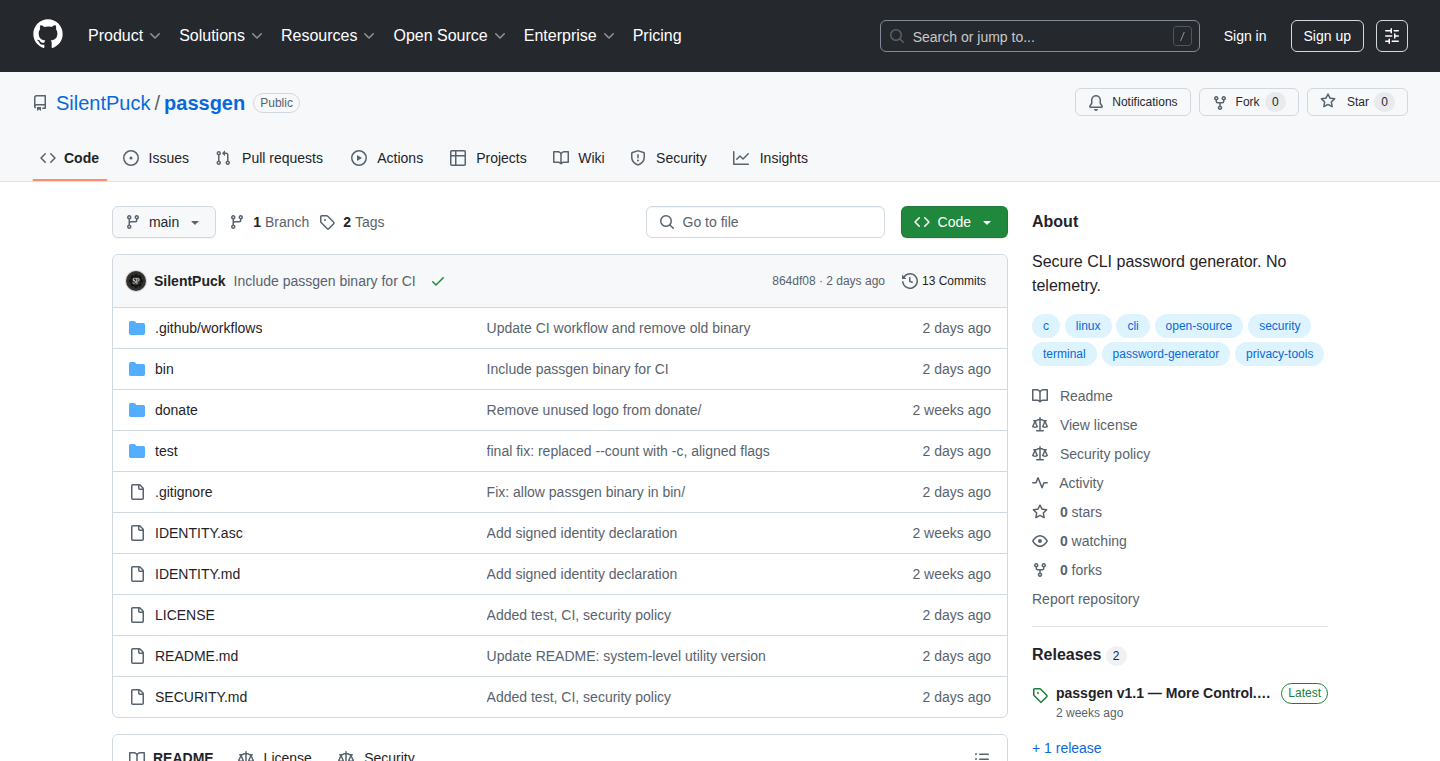
Author
silentpuck
Description
Passgen is an offline password generator. The core innovation lies in its ability to generate strong, unique passwords locally, without relying on any network connection or external services. It leverages cryptographic principles and a seed value provided by the user to produce highly secure passwords. This tackles the security risks associated with online password generators that may log or leak password data, and provides a reliable solution for situations with limited or no internet access.
Popularity
Points 1
Comments 3
What is this product?
Passgen is a tool that creates strong, unique passwords entirely on your computer. Its innovation is that it operates completely offline. It uses complex mathematical formulas (cryptographic algorithms) along with a user-provided starting point (the seed) to generate passwords. Think of it like a secure lockbox, where the key is your seed, and the lock is the password generator. So this helps prevent your passwords from being intercepted or stolen while being generated.
How to use it?
Developers can use Passgen as a command-line tool or integrate its core logic into their applications. You can use it in scripts, automating password generation for user accounts or system processes. It can also be embedded in applications for offline password management. For example, if you're building a security-focused application, you can incorporate Passgen's password generation capabilities to ensure robust password security. So this gives you a secure, customizable solution for generating passwords within your software.
Product Core Function
· Offline Password Generation: The primary function is generating passwords without needing an internet connection. This is crucial for security, as it avoids transmitting password-related data over the network. It means your passwords are safe from online threats. So this ensures that no one can intercept the process of creating your passwords.
· Cryptographically Secure Password Generation: Passgen uses cryptographic algorithms to generate passwords. These algorithms are designed to be resistant to cracking attempts, making the generated passwords very difficult to guess. This ensures passwords are strong and unpredictable. So this gives you peace of mind knowing your passwords are well-protected.
· User-Defined Seed: The user provides a seed value (e.g., a passphrase or a unique identifier). This seed is used as the starting point for the password generation process. This allows users to customize the password generation and helps ensure that the generated passwords are unique. So this means you can control the starting point of your password generation.
· Customizable Password Length and Character Sets: Passgen likely allows users to specify the desired length of the generated passwords and choose which character sets (uppercase letters, lowercase letters, numbers, symbols) to include. This allows the user to tailor the password to the specific security requirements of the system or application. So this gives you the flexibility to generate passwords suitable for different requirements.
Product Usage Case
· Building a Secure Password Manager: Developers can integrate Passgen's logic into their own password managers to generate strong, offline-generated passwords. This prevents the password manager from becoming a point of attack for hackers because the core password generation is done locally. So you can make your password manager secure against online threats.
· Creating Security-Focused Applications: Developers can utilize Passgen in applications that require strong authentication, such as secure messaging apps or encrypted file storage. This helps protect user data and enhances overall security. So this is great for applications where security is crucial.
· Automating System Administration Tasks: System administrators can use Passgen to generate secure passwords for user accounts and system services. This automates password creation for servers or any system where many users need strong and complex passwords. So this helps create secure systems quickly and effectively.
· Offline Password Generation for Limited Connectivity Environments: Developers in environments with limited or no internet access (such as embedded systems, isolated networks, or even on airplanes) can benefit from Passgen to generate and manage secure passwords. So this is essential for situations where internet access is unreliable or nonexistent.
21
Epanet-JS: Local-First Water Network Simulation App

Author
lbutler
Description
Epanet-JS is a browser-based application that lets you simulate water distribution networks directly in your web browser. It's "local-first," meaning it prioritizes offline functionality and data privacy by storing and processing all your simulation data on your own device. The project is FSL-licensed, which means it's freely available for anyone to use, modify, and redistribute. The key innovation is bringing complex engineering simulations, typically requiring specialized software, to a readily accessible, browser-based environment, accessible even without an internet connection. So, what's that mean? It means you can design, analyze, and troubleshoot water systems without being tied to expensive software or needing a constant internet link.
Popularity
Points 3
Comments 1
What is this product?
Epanet-JS allows users to build and simulate water distribution networks. At its core, the application uses the EPANET library (a well-established water distribution modeling software) but runs it in your browser using JavaScript (hence "JS"). The innovation lies in making this complex simulation accessible and running entirely within a web browser. Furthermore, the "local-first" approach ensures that your data is stored and processed locally on your computer, meaning you retain complete control over it. This is important because it protects your data. So, what's that mean? It's like having powerful water network analysis tools in your pocket that you can use anytime, anywhere, without needing an internet connection or worrying about data privacy.
How to use it?
Developers can use Epanet-JS by visiting the application in their browser or by contributing to the open-source code. You can import or create water network models, define network components (pipes, pumps, reservoirs, etc.), set simulation parameters, and run the simulations. The results, such as water flow rates and pressures, are then displayed within the browser. You can integrate it into web applications that need hydraulic simulation capabilities. So, what's that mean? You can quickly test out a water design to see how much water will go where before you build a real water pipe.
Product Core Function
· Network Modeling: Enables users to visually build and define water network models, including pipes, pumps, tanks, reservoirs, and junctions. This is valuable because it allows engineers and designers to create a digital representation of a real-world water system.
· Hydraulic Simulation: Executes EPANET simulations within the browser, calculating water flow, pressure, and water quality parameters. This is useful for predicting how a water system will behave under various conditions, such as changes in demand or pump failures.
· Local Data Storage and Offline Functionality: Stores and processes all data locally in the browser, ensuring data privacy and enabling offline use. This is an important feature for people who need to work on designs even without internet access or who want to keep their designs secret.
· Result Visualization: Displays simulation results in an intuitive manner, allowing users to easily understand and interpret the performance of their water network. This is important because it makes it easier to identify potential problems or optimize designs.
Product Usage Case
· Water System Design: Engineers can use Epanet-JS to design new water distribution systems, evaluating different pipe sizes, pump configurations, and tank locations to meet specific water demand requirements. So, what's that mean? It can help you figure out the best way to get water from a water source to all the homes in a new housing development.
· Network Analysis and Optimization: Operators can use Epanet-JS to analyze existing water networks, identify areas of low pressure or excessive flow, and optimize system performance by adjusting pump settings or modifying pipe diameters. So, what's that mean? You can figure out why there's low water pressure on the top floor of an apartment building.
· Emergency Response Planning: Emergency managers can use Epanet-JS to simulate the impact of pipe breaks or pump failures on a water network and plan for contingency measures. So, what's that mean? You can test out different responses to see which would be most effective in restoring water service after a major event.
22
Cross-Platform MySQL Parser
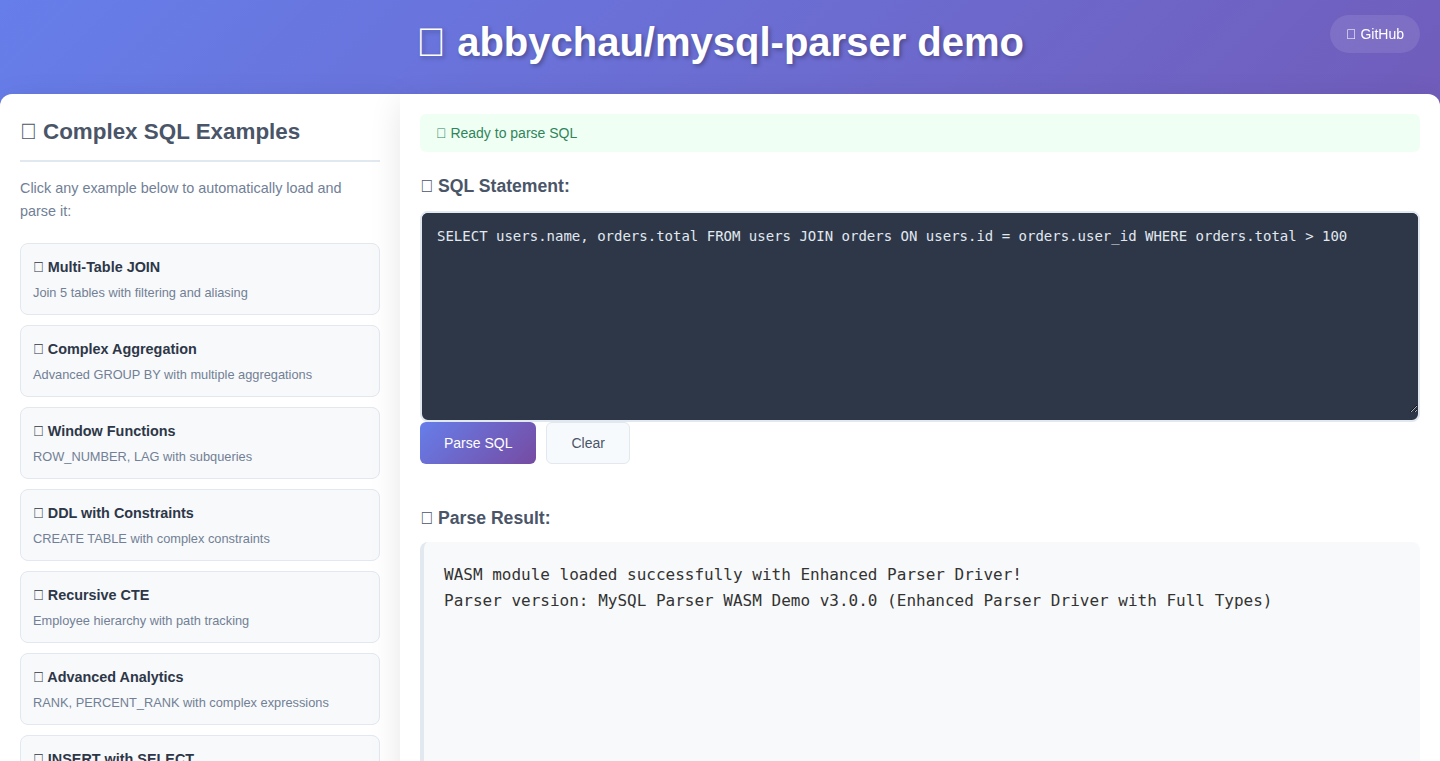
Author
abbychau
Description
This project is a custom-built MySQL parser, designed to be compatible with various platforms including WASM (WebAssembly). It solves the problem of porting existing MySQL parsers, such as TiDB's parser, to environments like WASM where dependencies can be problematic. The key innovation is extracting and re-exporting necessary types from the original parser, making it cross-platform and suitable for environments with limited dependencies. It addresses the issue of monolithically structured projects preventing easy integration into different compilation targets. So this allows developers to use MySQL parsing in various environments without being tied to heavy dependencies.
Popularity
Points 4
Comments 0
What is this product?
This is a Go-based MySQL parser. A parser is like a translator that takes SQL queries written by humans and turns them into a format the computer can understand. The innovation lies in its cross-platform design, especially its ability to function correctly in WASM environments, where traditional MySQL parsers often fail due to dependency issues. The developer achieved this by carefully extracting and re-exporting the necessary components from an existing parser (TiDB's). This means developers can now use MySQL parsing functionalities within web browsers or other WASM-compatible environments. So this lets developers work with MySQL queries anywhere.
How to use it?
Developers can integrate this parser into their projects by importing it as a Go package. They can then feed the parser SQL queries, and it will return an abstract syntax tree (AST), which represents the structure of the query. This AST can be used for various purposes, such as query analysis, validation, or transformation. You can use this parser in any Go project that needs to parse MySQL queries, especially if you're targeting WASM or other cross-platform environments. This involves importing the package and calling the parser functions, providing your SQL queries as input. So this means you can analyze, validate, and modify SQL queries directly within your applications, opening up a wide range of use cases.
Product Core Function
· Parsing SQL queries: The parser takes a string containing an SQL query as input and converts it into a structured representation (AST). This allows developers to understand the query's meaning and structure programmatically. So this helps you interpret SQL queries.
· Cross-platform compatibility: The parser is designed to work seamlessly across different platforms, including WASM. This means developers can use it in web browsers or other environments where standard database libraries may not be available. So this ensures your code works everywhere.
· Dependency management: The project addresses dependency issues by carefully managing external libraries and their types, thus preventing conflicts during compilation, especially for targets like WASM. So this prevents dependency conflicts.
· Extraction and re-exporting of types: This is the core technical solution. By extracting and re-exporting types from the original parser, the developer ensures the parser works correctly without relying on the complete original project, thus simplifying integration. So this simplifies integration with other systems.
Product Usage Case
· Web-based SQL query analysis: A developer could create a web application that allows users to analyze their SQL queries directly in their browser. This would be useful for debugging, understanding, and optimizing queries without needing a database connection. So this allows building SQL tools that run in your browser.
· WASM-based database tools: A developer might use the parser to build database tools or applications that can run in WASM environments, such as embedded systems or web browsers. This allows users to run database functionality locally without reliance on server-side resources. So this enables running database functionalities locally.
· SQL query validation in applications: A developer building an application that takes SQL queries as input could use the parser to validate those queries before executing them, helping to prevent SQL injection vulnerabilities or syntax errors. So this strengthens application security.
23
Ravana: The Multi-AI Brain for Your Browser
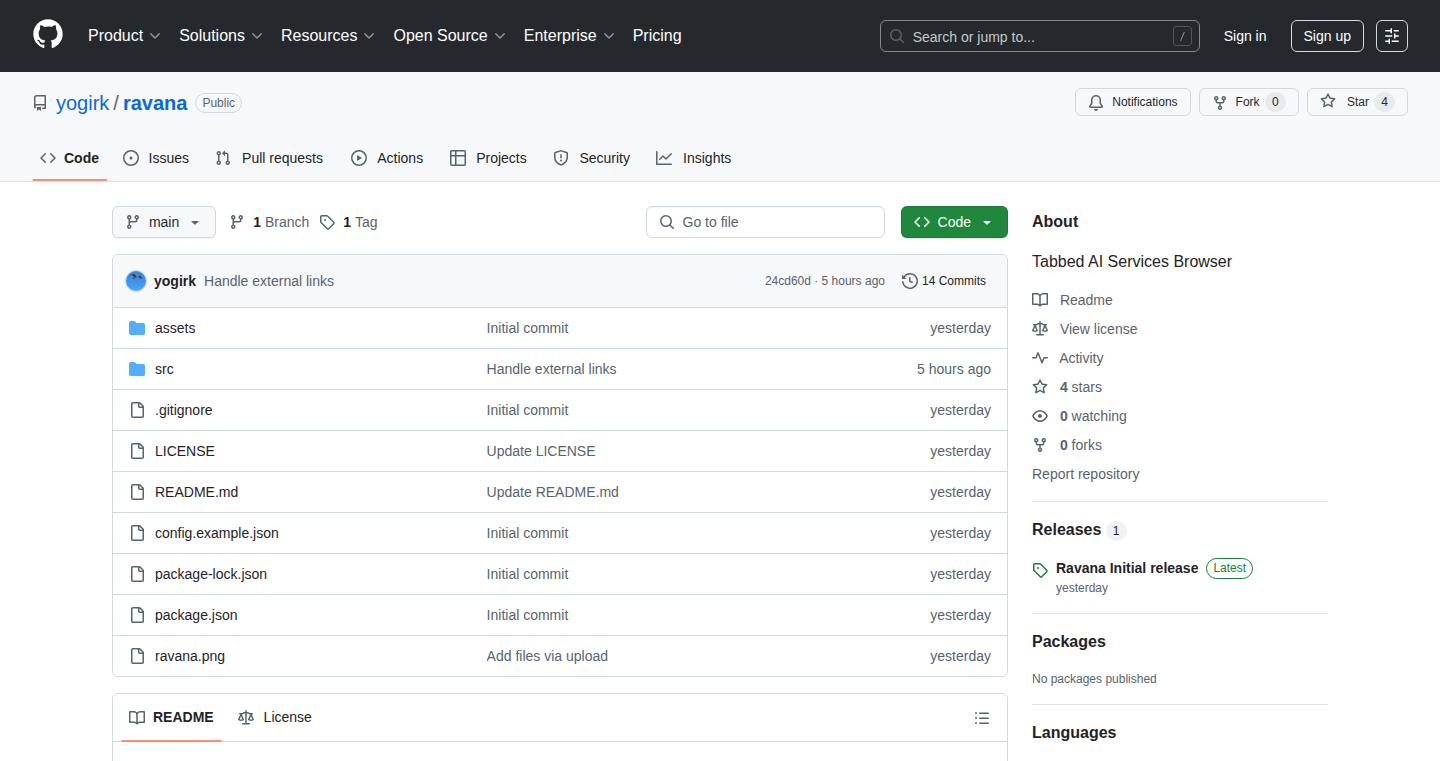
Author
ashtavakra
Description
Ravana is a desktop application that brings multiple AI assistants together within your browser. It allows you to interact with different AI models simultaneously, streamlining tasks like content creation, research, and code generation. The innovation lies in its ability to orchestrate and manage multiple AI interactions, providing a unified interface for complex workflows. So this means you get a super-powered browser experience.
Popularity
Points 3
Comments 1
What is this product?
Ravana acts like a central hub for your AI tools. Instead of switching between different AI chatbots or apps, you can use Ravana to interact with them all at once. It takes your requests, figures out the best way to use different AI models to answer, and presents the results in a clear format. Think of it as a smart assistant that manages all your AI needs. It's innovative because it simplifies complex interactions with multiple AI tools.
How to use it?
Developers can use Ravana as a research tool, a coding assistant, or a content creator. You can integrate it by providing a prompt or a task, and Ravana will leverage different AI models to complete it. This can be as simple as asking it to write a blog post, generate code snippets, or summarize articles. So, you can use this to boost productivity and save time on repetitive tasks.
Product Core Function
· Multi-AI Orchestration: This allows users to simultaneously utilize several AI models. This is valuable because it allows you to get the best results from different AI tools, comparing answers and combining their strengths, and it saves time.
· Unified Interface: A single interface for all AI interactions simplifies workflow. This is valuable because you don't have to jump between different apps, and this improves user experience.
· Context Management: Ravana intelligently handles the context of your queries across different AI models. This is valuable because AI can generate more relevant and accurate responses.
· Customizable Workflows: Users can define their own workflows to suit different tasks. This is valuable because you have ultimate flexibility and power over how you want the AI to perform.
Product Usage Case
· Research Assistant: A developer needs to research a complex topic. They can use Ravana to query multiple AI models simultaneously, comparing insights, summarizing different viewpoints, and creating a comprehensive understanding of the subject. This helps to get a broader view with less work.
· Code Generation & Debugging: A developer is stuck on a coding problem. They can use Ravana to generate code snippets, then utilize another model for debugging and error analysis. This is helpful because it can quickly identify and fix issues, improving the coding speed.
· Content Creation & Marketing: A marketer needs to create engaging content and SEO strategies. They can prompt Ravana to draft blog posts, social media copy, and then use another AI model to analyze keywords and recommend SEO improvements. This allows you to streamline the content creation process and boost your marketing performance.
24
DotnetEbpf: C# to eBPF Transpiler
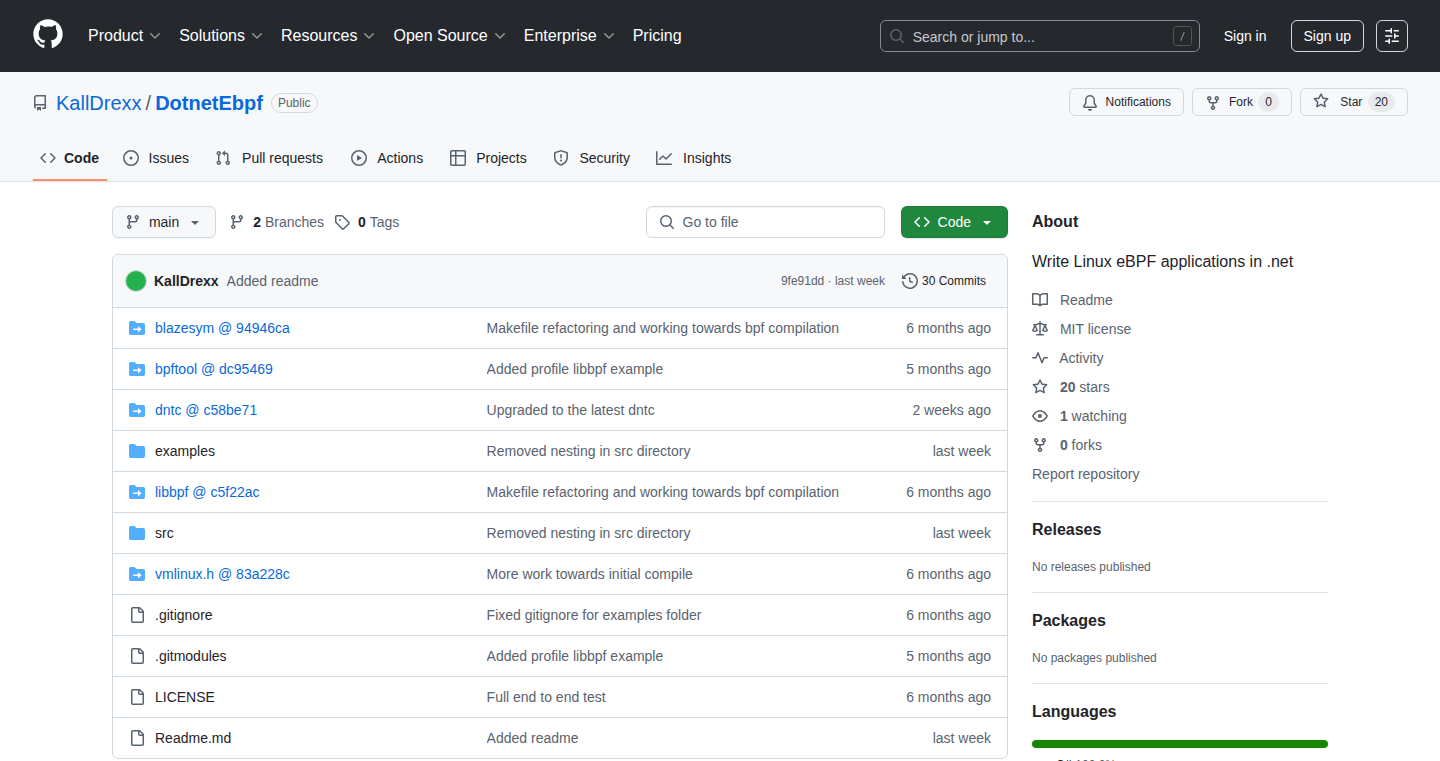
Author
KallDrexx
Description
This project, DotnetEbpf, allows developers to write Linux kernel-side eBPF (Extended Berkeley Packet Filter) applications using C# instead of the traditional C language. It's essentially a translator that converts C# code into eBPF bytecode, enabling developers to create high-performance, efficient programs that run directly within the Linux kernel. This project addresses the challenge of writing complex kernel-level programs while leveraging the modern features and ease of use of C#, including unit testing and generics. So this helps you write powerful kernel programs using a more user-friendly language.
Popularity
Points 4
Comments 0
What is this product?
DotnetEbpf works by transpiling C# code into eBPF bytecode. The core idea is to take C# code (which is easier to write and maintain) and automatically convert it into a format that the Linux kernel can understand and execute. This leverages the strengths of both languages: C# for developer productivity and eBPF for performance and low-level system access. The innovation lies in bridging the gap between these two worlds, making kernel programming more accessible. So this lets you use C# to create programs that run inside the Linux kernel, improving performance and security.
How to use it?
Developers use DotnetEbpf by writing their eBPF applications in C#. They define the logic and functionality using C# syntax, including support for generics and unit testing. The project then handles the conversion to eBPF bytecode. This bytecode can then be loaded into the Linux kernel, where it will execute. It provides a better syntax and more features to use than C. So you can use DotnetEbpf to write kernel applications with better syntax and many extra features.
Product Core Function
· C# to eBPF Transpilation: The core function is translating C# code into eBPF bytecode. This enables developers to use C# features in kernel-level programs.
· Support for Generics: Allows developers to use generic types in their eBPF applications, enhancing code reusability and type safety. This makes it easier to write more flexible and maintainable code.
· Unit Testing Capabilities: Enables developers to write and run unit tests for their eBPF code. This allows for better testing and debugging of programs that run in the kernel and enhances code quality.
· Data Structure Wiring: Enables the possibility of correct wiring up of data structures between both the C# kernel side and a C# user space side. This will enable writing full stack eBPF security software fully in C#.
· Simplified Kernel Programming: Allows writing full stack eBPF security software fully in C#.
Product Usage Case
· Network Monitoring: Developers can create eBPF programs to monitor network traffic, filtering and analyzing packets directly within the kernel using C# code. For example, write code to detect anomalies. This helps identify security threats and performance bottlenecks.
· Security Auditing: Write eBPF applications to monitor system calls and events to detect malicious behavior or security breaches within the kernel. This is especially useful for improving security.
· Performance Optimization: Programmers can optimize network performance by writing eBPF programs that modify or reroute packets within the kernel. This reduces latency and improve throughput.
· System Tracing: Utilizing eBPF to trace and analyze system calls, which provides insights into how the system works and pinpoint performance issues.
· Application Performance Monitoring: Write eBPF code to measure the performance of specific applications, monitoring CPU usage, memory allocation, and other relevant metrics directly within the kernel. This provides better understanding of the system.
25
SemanticDictionary: Smart Lookup for Your Python Code
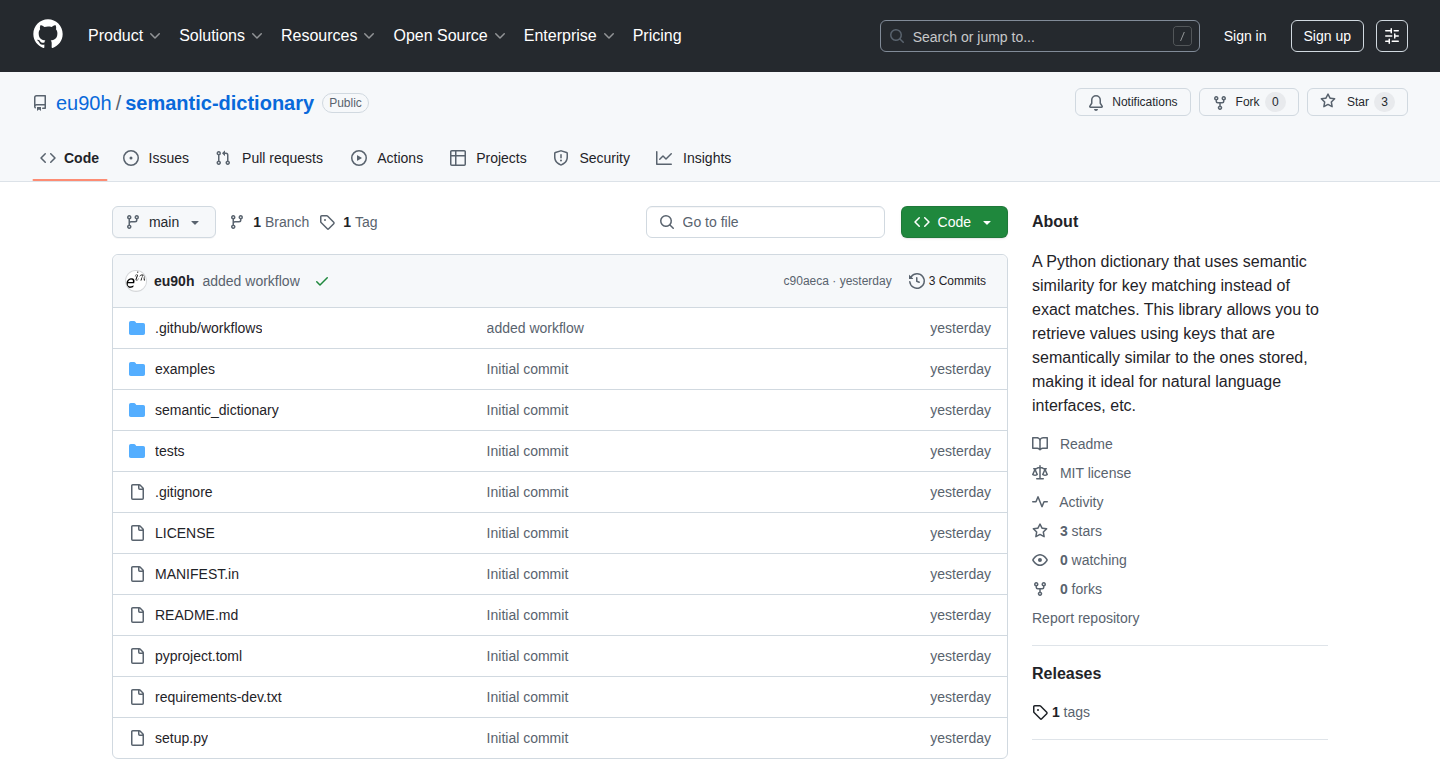
Author
eu90h
Description
SemanticDictionary is a Python dictionary that uses the power of 'understanding' to find things. Instead of relying on exact matches, it uses the concept of 'semantic similarity' to find what you're looking for. Imagine searching for 'Database' and it also finds 'Database System' even though the words are slightly different. This is achieved using a special AI model that understands the meaning of words. It's designed to help developers, especially those working with AI or data, to build smarter and more flexible applications. So, it helps you find what you need, even if you don't know the exact keyword.
Popularity
Points 4
Comments 0
What is this product?
This is a Python dictionary, like a container to store information, but it's way smarter. It uses something called an 'embedding model'. Think of this model as a translator that converts words or phrases into numerical representations (vectors) capturing their meaning. When you search for something, the dictionary calculates how close the vectors are, even if the words are not exactly the same. So, if you store information with the key 'Database' and later search using the key 'Database System', SemanticDictionary will recognize they are similar and return the stored value. This innovation solves the problem of missing related information due to slight differences in wording. So this means it will automatically find related items even when your keywords are not perfect, saving you time and improving your code's accuracy.
How to use it?
Developers can easily integrate SemanticDictionary into their Python projects. You initialize it, store data with keys and values, and then use it to retrieve data. When retrieving data, you provide a search key. SemanticDictionary then uses its internal model to find the closest match based on meaning. You can use it anywhere you'd use a regular dictionary, but with the added benefit of semantic understanding. For example, you could use it to build a more intelligent search function in an application, or to improve data retrieval in a machine learning project. So, it seamlessly fits into your existing Python projects and boosts your software's intelligence.
Product Core Function
· Semantic Lookup: This is the core feature. It allows searching based on the meaning of words, not just exact matches. If you look for 'Coffee' it might find 'Espresso' or 'Brewed Coffee', because it understands they are related. This is useful in building more flexible search capabilities and improved data retrieval.
· Similarity Scoring: It calculates how close two words or phrases are in meaning using an embedding model. This score tells you how well the search term matches the existing data. It's useful in ranking search results or determining the relevance of information.
· Easy Integration: It's designed to be used just like a regular Python dictionary, so it can be easily added to any existing Python project. This makes it simple to upgrade your software with semantic understanding without rewriting your whole code base.
· Customizable Embedding Models: Developers can use different embedding models (like word2vec, or transformer models). This allows for flexibility and allows you to tailor the model to the specifics of your project data. This is useful when you are working in highly specialized fields where different models are needed to understand the meaning.
· Handles Various Data Types: It can store and retrieve any data type that a standard Python dictionary can handle (strings, numbers, objects, etc.). So you are not limited in the types of data you can store.
· Scalable: It can be used with large datasets since the vector calculations can be optimized. This is important when dealing with large amounts of data, to ensure quick and reliable performance.
Product Usage Case
· AI Agents: Building AI assistants that need to understand user input. Imagine an assistant that retrieves your 'favorite database'. The user may phrase it in many ways such as: 'Which database do I prefer?', or 'What's my favored database system?'. SemanticDictionary would understand these are related and retrieve the correct answer. So it improves the natural language understanding abilities of your AI, making it more user-friendly.
· Data Management: Retrieving data from databases or other data sources. When you have a database with names like 'Product Category', the user might search for 'Category of Product'. The SemanticDictionary can match these and find the related data. This prevents you from missing information due to minor wording differences. It improves the accuracy of data retrieval and helps find information faster.
· Search Engines: Adding smarter search to an existing application. It could improve search results by finding relevant results even when the keywords don't exactly match. For example, if someone searches for 'sports car', it could also find 'racing car', 'muscle car', or 'convertible'. This improves the search experience, by offering better results, even when the user doesn't have perfect search terms.
· Natural Language Processing (NLP) Tasks: Working with text data, such as analyzing customer reviews. It helps identify similar concepts, even with variations in wording. If customers write about their 'pleasant experience', or their 'wonderful stay', the system would recognize these are related. It helps categorize and summarize text data more effectively.
· Chatbots and Conversational Systems: Building bots that understand user intent, despite variations in the questions they ask. It makes the chatbot more responsive, as it can match the intent of the questions. It will make the chatbot better at understanding user intent, even if the user doesn't use the exact phrases.
26
ZenNotes: Minimalist Markdown Editor with Focus Mode
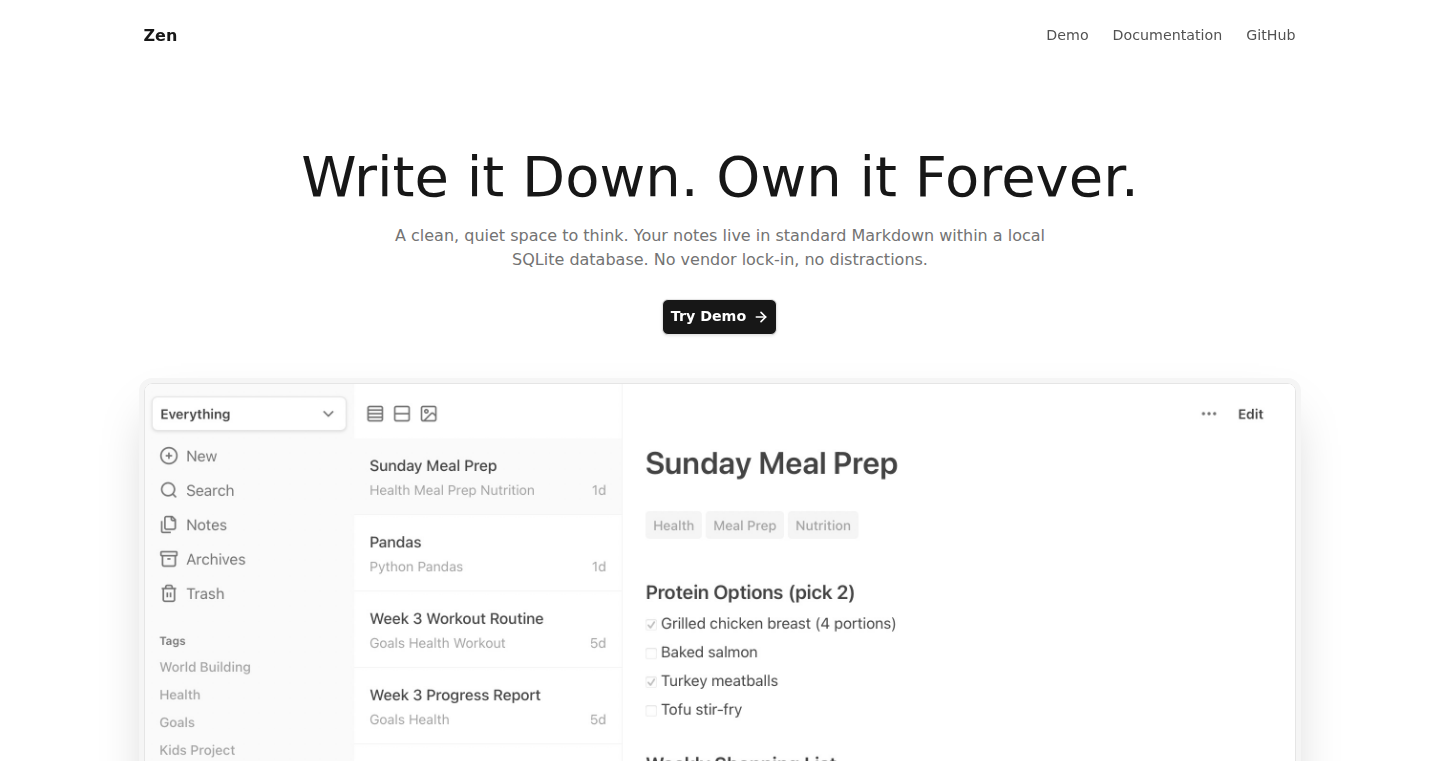
Author
rkwz
Description
ZenNotes is a web-based note-taking application designed to eliminate distractions and maximize focus. It leverages a clean, minimal interface and supports Markdown for easy formatting. The core innovation lies in its distraction-free mode, achieved through intelligent UI design and efficient resource management, allowing users to concentrate solely on their content. This directly addresses the common problem of information overload and the difficulty of staying focused while writing, which is a significant pain point for anyone who writes regularly.
Popularity
Points 2
Comments 2
What is this product?
ZenNotes is a simple, web-based tool for writing notes using Markdown. It’s designed to be distraction-free. The main idea is to give you a clean screen so you can focus on writing. It uses a simple interface and loads quickly, so you spend less time fiddling with the app and more time writing. So, this is a great tool if you just want a clean space to get your thoughts down without a lot of extra buttons or menus getting in the way.
How to use it?
Developers can use ZenNotes to quickly jot down notes, ideas, and code snippets, without getting bogged down by complex formatting options. You can access it in any web browser. To use it, you simply open the website, and start typing. You can use Markdown for formatting, like adding headers, making text bold, and creating lists. ZenNotes is great for people who need to quickly take notes while working on a project, write documentation, or even just brainstorm ideas. You can integrate this in your workflow by opening it as a window next to your IDE or using it on your mobile device.
Product Core Function
· Distraction-Free Mode: This is the core feature, stripping away unnecessary UI elements to create a clear writing environment. This is valuable because it minimizes cognitive load, leading to improved concentration and productivity. (So this is great if you’re constantly getting distracted by your email or social media notifications while you’re trying to write.)
· Markdown Support: Enables users to format their notes with simple syntax. This makes it easy to create formatted text, lists, and headers without needing to use complicated formatting tools. This saves time and makes notes more readable. (So this is useful if you want to easily make your notes look organized and neat, without spending a lot of time learning complex formatting).
· Real-time Saving: The application automatically saves your notes as you type. This ensures that your work is never lost due to a browser crash or accidental closing. (So this is awesome because you can focus on writing and not have to worry about saving your document constantly.)
· Minimalist Interface: The clean and uncluttered design reduces visual noise and helps users stay focused. This design choice emphasizes content and reduces the mental effort required to interact with the application. (So this is great because it’s designed so you can concentrate fully on your notes).
Product Usage Case
· Technical Documentation: Developers can use ZenNotes to write documentation for their code. With Markdown support, they can easily format code examples, create headings, and structure their documentation clearly. The distraction-free mode helps them focus on the content rather than getting distracted by formatting issues. (So this is perfect if you’re a developer who needs to explain how your code works!)
· Project Planning: Developers can use ZenNotes to outline project plans, break down tasks, and manage their workload. The clean interface prevents distractions and allows them to focus on organizing their thoughts. (So this helps you focus on what needs to be done when you’re planning your work.)
· Meeting Notes: Engineers can take quick and focused notes during meetings, recording action items and key discussion points without being overwhelmed by the interface. (So this is great to quickly capture and organize information during the meeting!).
27
Sysadmin.ca: A No-Nonsense Toolkit for IT Professionals
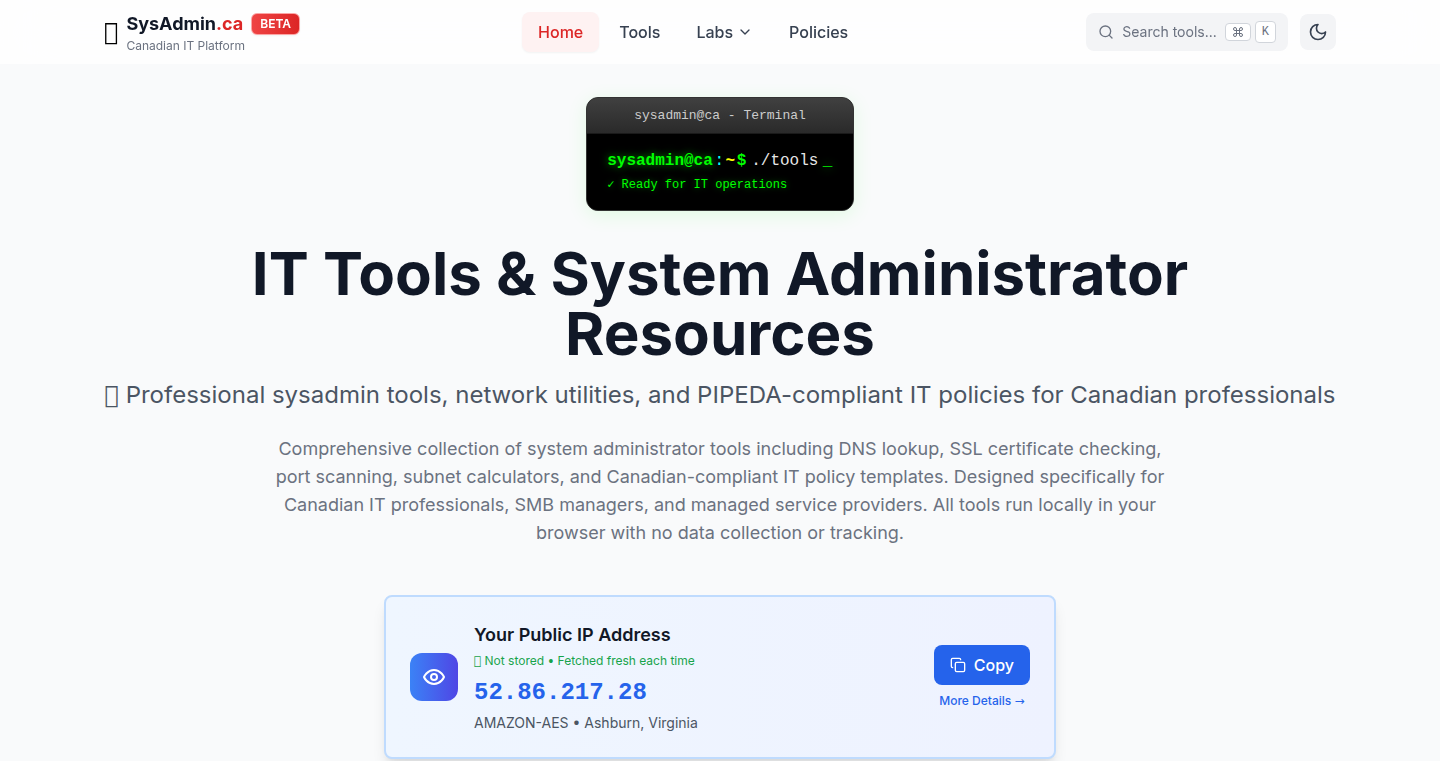
Author
WallyCanada
Description
Sysadmin.ca is a collection of practical tools and resources specifically designed for IT administrators. It tackles the everyday challenges faced by sysadmins by providing tools like outage trackers, cheat sheets, and templates for vendor calls. The project's innovation lies in its focus on real-world usability, privacy, and simplicity, avoiding complex setups or data collection. This ensures that IT professionals can quickly access essential information and tools without any hassle, offering a direct solution to productivity challenges faced by sysadmins.
Popularity
Points 4
Comments 0
What is this product?
Sysadmin.ca offers a suite of free, easy-to-use resources for system administrators. It's built on the idea that sysadmins need quick access to practical tools, not just theoretical knowledge. The project stands out because it prioritizes privacy (no signups), simplicity (no fluff), and actual usefulness (built by an IT admin for IT admins). It aims to solve the problem of finding reliable, readily available resources in the IT world, thus providing a valuable solution to day-to-day operational issues.
How to use it?
Sysadmins can directly access the tools and resources on the website. For example, they can use the outage tracker to document and manage system failures, download pre-built templates to prepare for vendor calls, or consult cheat sheets for quick reference. This is integrated by simply visiting the site on any device with a browser, selecting the desired tool or resource, and using it directly. This straightforward process minimizes setup time and immediately boosts productivity.
Product Core Function
· Outage Tracker: A tool to log and monitor system outages. Technical Value: Provides a structured way to document and analyze system failures, leading to improved troubleshooting and preventative measures. Application: IT teams can use it to track downtime, identify recurring issues, and generate reports for management. So this is useful for reducing downtime and improving service reliability.
· Vendor Call Prep Templates: Pre-formatted templates to help IT professionals prepare for vendor calls. Technical Value: Streamlines communication with vendors and ensures that all necessary information is readily available. Application: Simplifies the process of dealing with external support providers by providing a framework for asking relevant questions and documenting responses. So this is useful for saving time and ensuring effective communication.
· Cheat Sheets: Quick reference guides for common IT tasks and commands. Technical Value: Offers fast access to important information, reducing the need to search through documentation or remember complex commands. Application: Sysadmins can use them as a quick reference to quickly troubleshoot issues and perform routine tasks. So this is useful for increasing efficiency and reducing errors.
· Daily Tools: Includes a set of practical tools such as calculators, and converters that help in day-to-day IT operations. Technical Value: Automates common IT tasks. Application: IT professionals can use these tools to swiftly perform calculations, format code, and execute basic tasks, significantly improving the daily workflow. So this is useful for saving time and reducing manual effort.
Product Usage Case
· An IT administrator is dealing with a network outage. They use the outage tracker on Sysadmin.ca to document the problem, its impact, and the steps taken to resolve it. This helps the team identify the root cause and prevent similar issues in the future. The tracker provides a detailed log of events. So this is useful for quick and effective incident management.
· A sysadmin is preparing for a vendor call to troubleshoot a server issue. They use the vendor call prep templates to outline the problem, gather relevant information, and organize their questions. This ensures a productive conversation and faster resolution. These templates provide a clear structure for the call. So this is useful for maximizing efficiency in vendor interactions.
· A new IT team member needs to quickly learn how to configure a new firewall. They use the cheat sheets on Sysadmin.ca to find the necessary commands and configuration steps without having to spend hours searching documentation. The cheat sheets provide a quick guide to getting started. So this is useful for accelerating the onboarding process and improving team efficiency.
· A system administrator needs to calculate the required bandwidth for a new application deployment. They use the various calculators on Sysadmin.ca to quickly determine the exact bandwidth requirements, ensuring optimal performance. These tools provide rapid calculations. So this is useful for ensuring proper resource allocation and application performance.
28
Attach Gateway: Secure Your Local LLMs with Ease
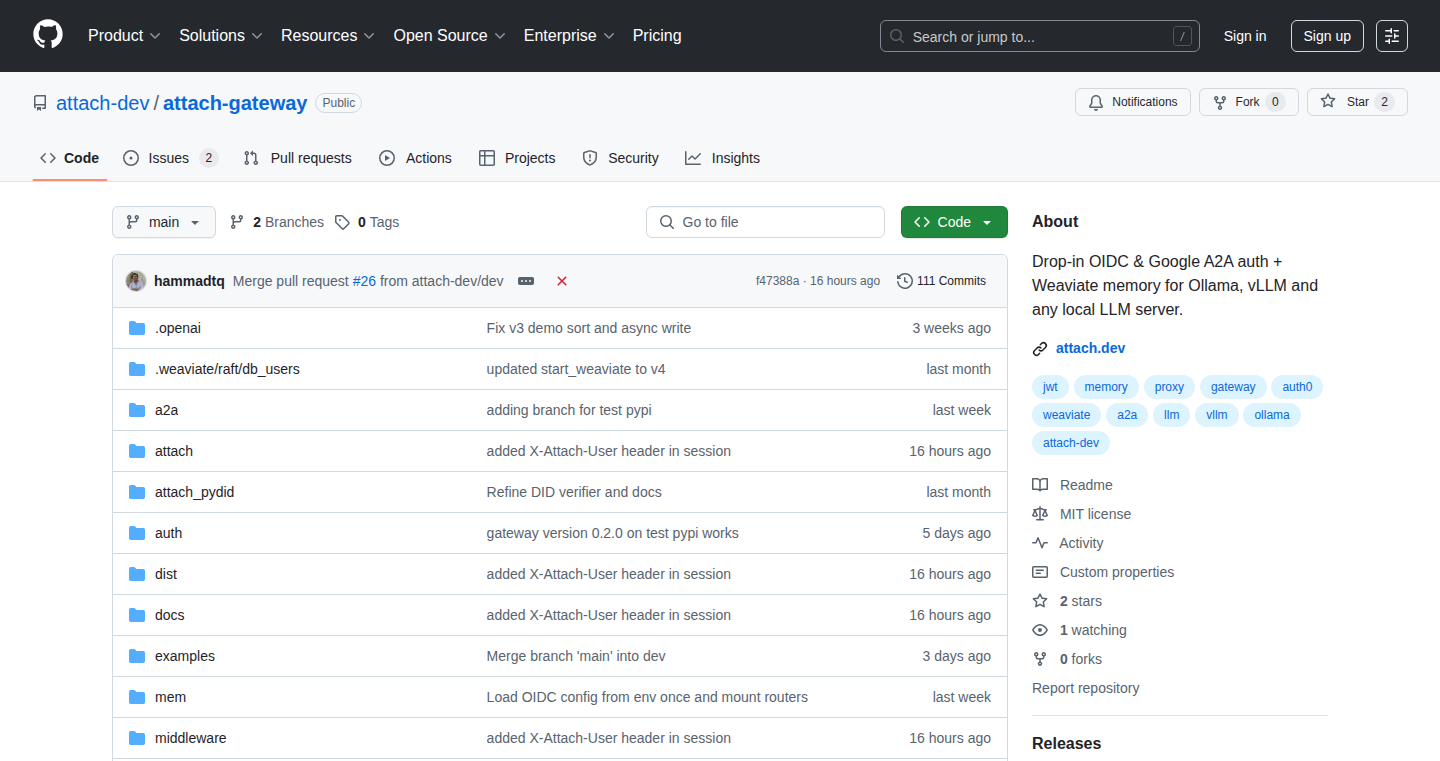
Author
hammadtariq
Description
Attach Gateway is a straightforward solution designed to secure your local Large Language Models (LLMs) like Ollama or vLLM. It acts as a gatekeeper, handling authentication (verifying user identities) and adding security headers to your requests. This simplifies the process of protecting your LLMs and allows different agents (like AI assistants) to securely interact with them. The gateway mirrors your prompts and completions to Weaviate for easy logging and debugging. So, it's like having a security guard and a surveillance system for your AI models. It achieves this in a single process, deployable quickly with a simple pip install and token setup. The core innovation lies in its ease of use and focused approach to solve common security and identity challenges in local LLM deployments. So, you can easily protect your local AI models.
Popularity
Points 4
Comments 0
What is this product?
Attach Gateway works by sitting in front of your local LLM server. It verifies user identities using standards like OIDC and DID (think of these as secure digital passports). It then adds special headers to the requests, labeling each one with the user's identity and session information. This is crucial for multi-agent setups where different AI agents need to share the same identity. Furthermore, it offers a Google-style 'handoff' endpoint for advanced usage, allowing seamless task transfer. It also logs all prompts and completions to Weaviate, which helps with debugging and tracking what's happening. So, it offers a simple way to securely manage access and track usage of your locally running LLMs. This simplifies the deployment of secure LLMs by providing ready-to-use features.
How to use it?
Developers use Attach Gateway by first installing it with `pip install attach-dev`. Then, they'll need to configure a security token. Once set up, running `attach-gateway` starts the protection. Developers can then point their applications to the gateway instead of directly to the LLM server. The gateway handles the authentication and passes the requests on. So, it integrates directly into your existing development workflow with minimal changes to your application setup. This makes securing your models easy and seamless.
Product Core Function
· OIDC/DID Authentication: Verifies user identities using standard authentication protocols. It's like verifying your digital ID before entering a restricted area. This provides a secure way to control access to the LLM. So, you can ensure that only authorized users or applications can use your LLM.
· Header Injection: Adds `X-Attach-User` and `X-Attach-Session` headers to each request. This propagates the user's identity across multiple agents or services. It's like tagging each message with the sender's identity. So, your different AI agents can work together seamlessly, sharing context and understanding who is initiating the requests.
· A2A Endpoint: Provides an optional endpoint for 'agent-to-agent' handoffs, allowing for task delegation and collaboration. This allows for a seamless way to pass tasks and data between different AI agents. So, your AI agents can work together more efficiently, handing off tasks as needed.
· Prompt and Completion Mirroring to Weaviate: Logs all prompts and completions to Weaviate. This helps with debugging, monitoring, and auditing the usage of the LLM. It's like having a detailed record of all interactions with your model. So, you can easily track what your LLM is doing, troubleshoot problems, and improve its performance.
Product Usage Case
· Secure Multi-Agent Systems: Imagine you're building a system where multiple AI assistants collaborate. Attach Gateway allows each assistant to authenticate and share the same user identity. So, you can track and manage requests from different AI agents seamlessly.
· On-Premise LLM deployments: For teams running LLMs on their own servers, Attach Gateway provides a quick and easy way to add security. This means you can secure your local models with minimal configuration. So, you can keep your AI models secure and prevent unauthorized access.
· Development and Debugging: During development, you can use the Weaviate mirroring feature to log prompts and completions, which helps with debugging. This makes it easy to understand the issues. So, you can easily debug and improve the performance of your AI models.
· Integrating LLMs into existing workflows: If your application already uses OIDC/DID for authentication, Attach Gateway makes it simple to integrate your LLM into your current security infrastructure. This reduces the need for new security processes. So, you can easily integrate your LLM into your existing application workflows without worrying about building authentication from scratch.
29
Audiopipe: One-liner Audio Magic
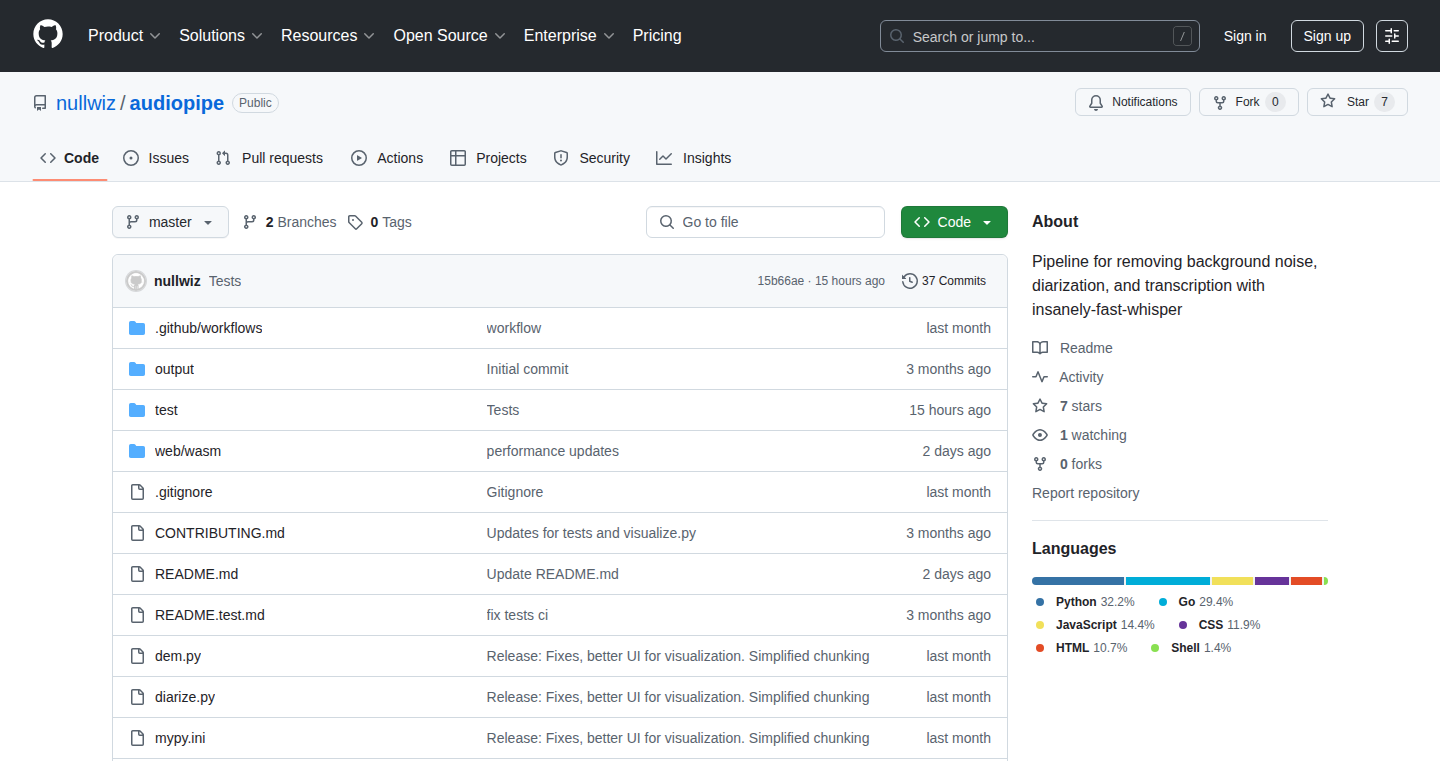
Author
nullwiz
Description
Audiopipe is a clever tool that takes audio, cleans it up (denoising), figures out who's talking (diarization), and then turns the spoken words into text (transcription) – all with a single command! It uses cutting-edge technology called demucs, pyannote, and insanely-fast-whisper, making the whole process incredibly efficient. The project also includes a web interface to view and work with the transcribed text and audio files. This project focuses on making audio processing easy and accessible.
Popularity
Points 4
Comments 0
What is this product?
Audiopipe is like a super-powered audio editor. It utilizes several advanced techniques. First, it uses 'demucs' to remove background noise and improve audio quality. Then, 'pyannote' identifies different speakers in the audio, labeling who said what. Finally, 'insanely-fast-whisper' converts the audio into written text quickly and accurately. So, it's a streamlined process for analyzing and understanding audio recordings. So this is useful for anyone who needs to analyze and understand audio content.
How to use it?
Developers can use Audiopipe by simply running a single command in their terminal. They give it an audio file, and it processes it through the pipeline. This makes it easy to integrate into other applications. Imagine automatically transcribing podcasts or analyzing meeting recordings. You can use the command line tool, or incorporate its functionalities within your own programs using various programming languages like Python. So, it's perfect for automating tedious tasks and integrating audio processing into workflows.
Product Core Function
· Denoising: Removes unwanted background noise from audio recordings, making the sound clearer. Useful for improving the quality of recordings and reducing distractions. So this is useful for anyone who works with audio recordings.
· Diarization: Identifies and separates different speakers within an audio file. Helps in understanding who is speaking at any given time. Useful for transcribing interviews, meetings, or podcasts where multiple people are talking. So this is useful if you need to know who said what in an audio file.
· Transcription: Converts spoken words into written text. Allows for easy searching, sharing, and archiving of audio content. Useful for creating transcripts of podcasts, interviews, or lectures. So this is useful if you need to get the text out of audio files.
· Web UI: Provides a visual interface to upload, view, and edit the transcriptions and audio files. Makes it easier to review and correct transcriptions. Useful for interactive audio processing and collaboration. So this is useful for anyone who needs to check the outputs from audio analysis.
Product Usage Case
· Podcast Transcription: Automatically convert podcast episodes into text, making them searchable and easier to consume. Helps generate show notes or create articles based on podcast content. So, this can save hours of time for podcasters.
· Meeting Summarization: Process meeting recordings to produce transcripts, identify speakers, and provide summaries of key discussion points. Useful for quickly reviewing what was discussed in a meeting. So, this could save time for busy professionals who need to analyze the content of meetings.
· Interview Analysis: Transcribe and analyze interviews, identifying key themes and quotes. Useful for researchers, journalists, or anyone conducting interviews. So, this is useful for summarizing the content of interviews for research and analysis.
· Educational Content Generation: Generate transcripts for lectures or online courses. This makes the content more accessible to students and provides a searchable text version. So, this is very helpful for educational purposes.
30
ChessNotationAI: Instant Chess Notation Transcription and Analysis

Author
coolwulf
Description
ChessNotationAI allows users to instantly convert handwritten chess notation into a digital format compatible with platforms like Lichess and chess.com. This project innovatively combines Optical Character Recognition (OCR), Large Language Models (LLMs), and chess engines to accurately transcribe, validate, and even correct chess notation. It addresses the common problem of manually transcribing handwritten chess moves, saving time and reducing errors for chess players. Furthermore, it provides side-by-side comparison tools and AI-powered correction features, enhancing the analysis capabilities.
Popularity
Points 2
Comments 2
What is this product?
ChessNotationAI is a tool that uses cutting-edge technology to solve the problem of manually typing in chess moves. It takes a picture of handwritten chess notation and uses OCR to read the characters (like the moves 'e4' or 'Nf3'). Then, it uses a chess engine to validate the moves and an LLM to correct any mistakes. It also offers the ability to compare the original notation with the output from a large language model. So, it makes it super easy to get your games ready for analysis on popular chess websites. The innovation here lies in the combination of OCR, LLMs, and chess engines to automate a complex process. So what's the innovation? It’s about automating a tedious task and making it faster and more accurate to analyze your chess games!
How to use it?
Developers can use ChessNotationAI by either utilizing the platform directly through its web interface or potentially integrating its API into their own chess analysis applications. Users upload images of chess notation, and the tool converts it into a digital format. They can then compare the results with the LLM's output and use AI-powered tools to correct errors. This allows chess players and developers to focus on analyzing the game rather than inputting the moves. So, you can use the website, take a picture of your chess notation, and it instantly becomes digital! You can also build your own apps around it using the underlying technology.
Product Core Function
· Instant Notation Conversion: Converts handwritten chess notation images into standard digital formats. This saves time and effort for chess players who want to analyze their games. So, this means you can skip the boring part of typing in your moves.
· AI-Powered Auto-Correction: Corrects errors in the notation using a combination of chess engines and LLMs. This ensures accuracy and allows for deeper game analysis. So, this means the computer can help you fix mistakes and find better moves!
· Side-by-Side Comparison: Compares the original notation with the results generated by a large language model, providing insights into potential variations and helping in understanding the game. So, you can check different ways the moves could go.
· Secure Data Storage: Allows users to securely store their notation data with Google Sign-In. So, it keeps your data safe and organized in the cloud.
Product Usage Case
· Chess Training: Chess coaches can quickly transcribe and analyze their students' games by taking pictures of their handwritten notations. So, this allows coaches to give more immediate feedback on the students' gameplay.
· Game Analysis: Chess players can upload their games recorded in notebooks to quickly analyze them using online platforms. So, this means you can quickly analyze your games and find mistakes.
· Tournament Preparation: Players can digitize their games from tournaments for easy review and sharing. So, this allows players to study their performance right after the game.
31
Text-Based Ishihara Plate Generator

Author
datron
Description
This project generates Ishihara-like plates, but instead of numbers, it uses text. The core innovation lies in the algorithm for creating these plates. It's a fun, experimental project built in Rust to create images that could potentially be used to test for color blindness, but now with words!
Popularity
Points 2
Comments 1
What is this product?
This is a tool that creates images similar to the Ishihara color blindness test, but with a twist: it uses text instead of numbers. The technology behind it involves an algorithm, written in Rust, that strategically places text characters with varying colors and sizes to create patterns. The challenge lies in making the text stand out (or blend in) based on the color perception, mimicking the original Ishihara test's purpose. So this tool plays with visual perception and language. So this is useful if you want to explore the intersection of image generation, text manipulation, and color perception in a creative way.
How to use it?
Developers can use this project by either running the Rust code directly (if they know Rust) or by incorporating the generated images into their own applications. The code generates image files. You could integrate it into a web application, a game, or any other project where you need to generate visually interesting images, particularly if you are interested in experimenting with visual accessibility or user interface design. The tool offers a unique way to generate text-based patterns. It's as simple as running the program and getting the image, but you can also take the source code and customize it.
Product Core Function
· Text-Based Pattern Generation: This is the core feature. The tool generates images with text characters arranged to create specific visual patterns, much like the Ishihara plates but with words. It offers a novel approach to generating images for visual tests or artistic purposes. So this is useful for creating custom image assets for various applications.
· Color and Size Control: The project allows control over the text's color and size, enabling users to customize the visual appearance of the generated plates. The algorithm could vary colors and sizes, blending text into the background and creating challenges for the viewer. So this lets you adapt the generated images to your specific needs.
· Rust Implementation: The project is implemented in Rust, a modern programming language known for its performance and safety. This means the tool could be fast and efficient. So this is useful if you're interested in the performance or working with the Rust language.
Product Usage Case
· Visual Accessibility Testing: Use the generated plates to explore how different text and color combinations affect visual perception, particularly for individuals with color vision deficiencies. This is useful for understanding design principles related to visual accessibility.
· Artistic Image Generation: Use the project to create unique visual art pieces or design elements where text is integrated into the images, allowing for creating visually striking or conceptual art. So this is useful if you want to experiment with text-based image generation for aesthetic purposes.
· Educational Tools: Integrate the generated plates into educational applications to teach about color perception, visual patterns, and language. So this is useful in educational contexts, such as designing interactive learning modules or visual experiments.
32
CommandChronicles: Secure, Synchronized CLI History
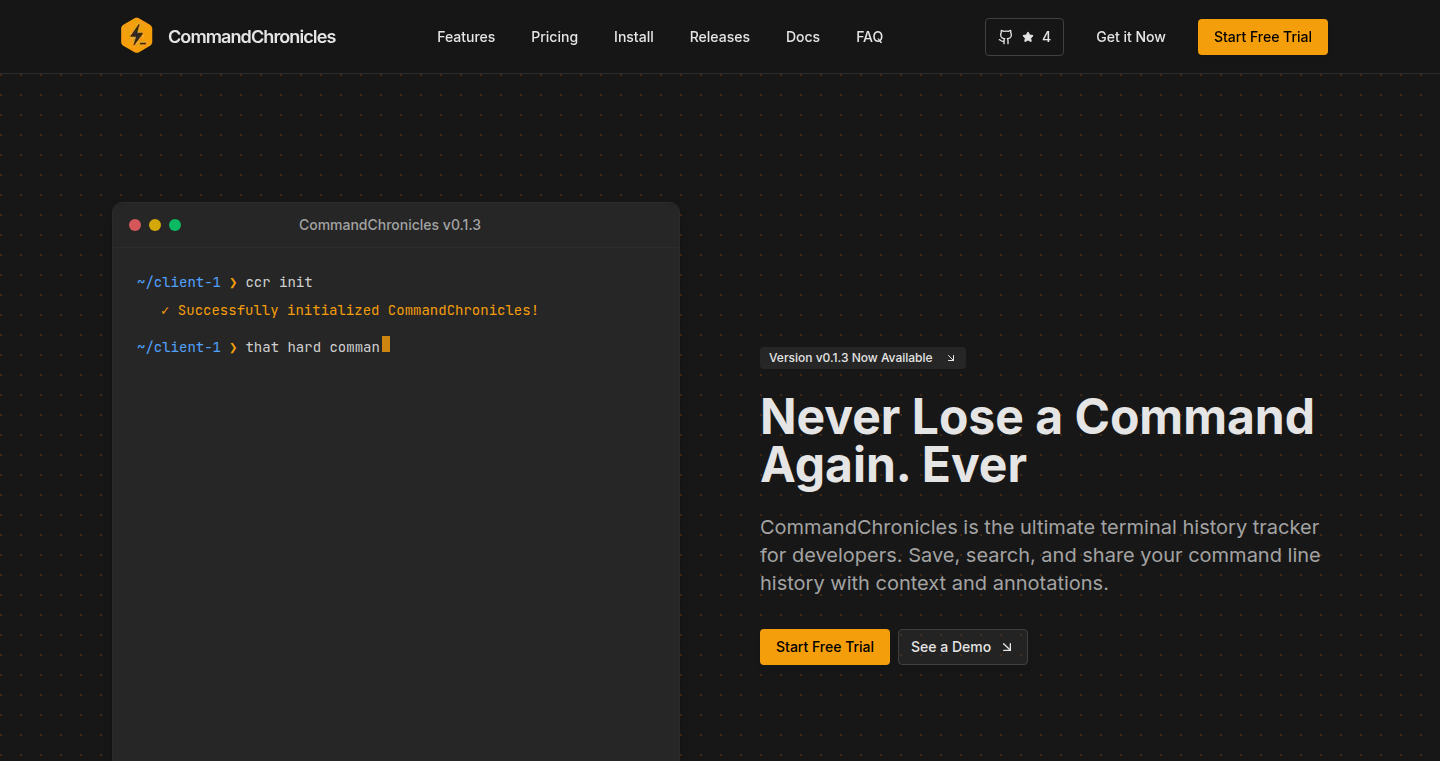
Author
lallerone
Description
CommandChronicles is a command-line interface (CLI) history tool designed for security and project-awareness. It focuses on providing a secure, synchronized, and project-specific history of commands executed in the terminal. This solves the problem of insecure command history storage and the lack of context when revisiting past commands. So, it's like having a super-powered, project-aware memory for your terminal.
Popularity
Points 2
Comments 1
What is this product?
CommandChronicles works by securely storing your command history, potentially encrypting it to prevent unauthorized access. It understands different projects you are working on and associates commands with the relevant project directories. It also synchronizes your command history across different devices. The innovation lies in its security-first approach and the ability to link commands directly to the context of the project you were working on. It's essentially a more robust and intelligent version of your shell's built-in history functionality.
How to use it?
Developers can use CommandChronicles by integrating it into their terminal setup. After installation, the tool will automatically record and manage your commands. Users can then easily search their history, filtered by project, date, or command content. This is achieved through a CLI interface, allowing you to easily search your past commands. So, imagine you're trying to remember how to deploy a particular feature; you can quickly search within the specific project, making it incredibly fast to find and reuse your past work.
Product Core Function
· Secure Storage: CommandChronicles likely encrypts command history, protecting sensitive information like passwords or API keys that might be in your commands. This is important to prevent data breaches. So, this protects your sensitive information.
· Project-Aware History: The tool automatically associates commands with the project directories, enabling quick filtering based on the project context. So, you can find exactly what you did for a particular project, avoiding the noise from irrelevant commands.
· Synchronization: CommandChronicles synchronizes your command history across different devices, like your laptop and desktop, so that your command history is always available when and where you need it. So, you can pick up where you left off, no matter which machine you're using.
· CLI Search and Filtering: The command-line interface allows users to quickly search and filter their command history by project, time, or command content. So, you can rapidly find and reuse old commands and configurations.
Product Usage Case
· Software Development: A developer is working on multiple projects. Using CommandChronicles, they can quickly recall specific commands used to set up a development environment, deploy a new feature, or troubleshoot a bug, all within the context of the particular project. So, you save time and reduce errors.
· System Administration: A system administrator needs to repeat a command to configure a server. CommandChronicles allows them to quickly find the relevant command from past sessions, and then reuse it on the same server or other servers. So, it makes automation and repeatable operations much simpler.
· Security Auditing: A security analyst needs to review the commands that were executed on a server. CommandChronicles enables them to track down the exact commands associated with a specific security incident, or a particular system user, and can help with investigations. So, it improves security and reduces time to respond to incidents.
33
Wasmrun - A Modular WebAssembly Runtime with Plugin Support
Author
anistark
Description
Wasmrun is a WebAssembly (WASM) runtime that lets you run code written in various languages in your web browser or other environments. What's new is its plugin architecture. Think of it as a customizable toolbox for WASM. The first plugin, wasmgo, allows you to compile TinyGo (a Go variant optimized for small size) code directly into WASM, expanding its capabilities. This modular approach allows developers to extend the runtime's functionality easily.
Popularity
Points 3
Comments 0
What is this product?
Wasmrun is a software that executes WebAssembly code, which is a kind of code that can run efficiently in web browsers and other places. The innovation is its plugin system. This allows developers to add new features without changing the core of the runtime. For example, the wasmgo plugin lets you compile and run TinyGo code, making it easier to use Go in WASM projects. So, it provides a flexible platform for building and deploying applications across different platforms.
How to use it?
Developers use Wasmrun by integrating it into their projects. You can use it to run pre-compiled WASM modules or use plugins like wasmgo to compile code from languages like TinyGo directly. The provided command `wasmrun plugin install wasmgo` installs the TinyGo compiler plugin. This allows you to compile Go code and run it in environments supported by Wasmrun. In practice, it helps you build cross-platform applications, create web-based tools, or build sandboxed execution environments. So, it helps you to write code once and run it everywhere with ease.
Product Core Function
· WebAssembly Execution: Wasmrun runs WASM code, enabling developers to run code written in various languages within a web browser or other environments. This has a wide range of applications, from web applications to IoT devices and edge computing.
· Plugin Architecture: The plugin system allows for extending Wasmrun's functionality without modifying the core runtime. This is a powerful feature, providing a way to customize the runtime's capabilities.
· TinyGo Compiler Plugin (wasmgo): The wasmgo plugin enables compiling TinyGo code directly into WASM, greatly simplifying the process of using Go in WASM projects. This makes Go language available for developing web and cross-platform applications.
Product Usage Case
· Building Web Applications: Developers can use Wasmrun to run complex web applications written in languages like Go, leveraging the speed and efficiency of WASM, resulting in faster and more responsive user experiences.
· Cross-Platform Applications: With Wasmrun, you can write code once in languages like Go (using TinyGo) and have it run on different platforms, including web browsers, servers, and embedded devices. So, it allows you to save time and resources by reducing the need to rewrite the application for each platform.
· Sandboxed Environments: Wasmrun can be used to create secure and isolated environments for executing untrusted code. This can be useful for running third-party plugins or extensions, or for sandboxing user-provided code in web applications. This enhances security and prevents the spread of vulnerabilities.
34
MailMap: Email-Powered Interactive Map Stories

Author
Premananda
Description
MailMap is a platform that allows you to create interactive map stories simply by sending an email. It automatically extracts GPS data from photos attached to emails, plots them on a Google Map, and allows users to add stories to specific locations. The core innovation lies in leveraging the ubiquitous nature of email to remove the friction of sharing location-based experiences. It simplifies the process of creating and sharing geographical stories without requiring app downloads or account creation, making it easy for anyone to contribute to a map with their experiences. It also provides a moderation system for users to curate their maps.
Popularity
Points 3
Comments 0
What is this product?
MailMap is a web application that transforms emails containing geotagged photos into interactive stories on a Google Map. It works by extracting GPS coordinates from the image's EXIF data (like where and when the photo was taken). When a user sends an email with a photo to a specific address, the service processes the data, plots the location on a Google Map, and allows the user to associate a story with that location. The innovation here is the seamless integration of email, location data (GPS), and map visualization, combined with the ease of use. The service is built to make sharing experiences on maps simple and fast, which makes it especially good for travel stories, documenting places or sharing interesting stories about where you've been. It also supports users to add stories directly on the map.
How to use it?
Developers can use MailMap to integrate map-based stories into their applications or services. They can leverage its email-to-map functionality by providing a dedicated email address that users can send geotagged photos to. The service can then be used to automatically generate map entries, improving their offerings. For instance, a travel blog could use this tool to create an interactive map of the writer's journey, with each photo on the map corresponding to a story post, enhancing user engagement. The core integration involves sending the geotagged picture to a provided email address.
Product Core Function
· Email-based story creation: By sending an email with a photo that has GPS data, users can automatically create a story on the map. This simplifies the process of sharing experiences without needing to use a specialized application. So this is useful for anyone who wants to quickly share their location-based stories without extra steps.
· Automated GPS data extraction: The platform automatically extracts GPS coordinates from the image metadata (EXIF data). This automates the mapping of the photo's location. So this is useful for those who are sharing geo-tagged photos but don't want to go through the complex processes of manual mapping.
· Interactive map exploration: Users can explore stories on an interactive Google Map. This provides an intuitive way for users to browse and view geographical information with a visual map. So this provides a user-friendly way to view and engage with stories and a richer experience compared to a simple list.
· Story voting and sharing: Users can vote on stories and share them, promoting user interaction and content distribution. So this allows the stories to grow and be noticed, and it helps others discover more stories. This is how a community is built.
· Community moderation: The platform has a community moderation system to ensure story quality and maintain a positive user experience. So this provides a safeguard to prevent inappropriate content and ensures good content quality.
Product Usage Case
· Travel bloggers: A travel blogger could use MailMap to create an interactive map of their trips. Each email with a photo and story becomes a pin on the map, creating a visually rich travel diary for their audience. So the readers will have a map to navigate the journey, and they can view the places mentioned in detail.
· Event organizers: Event organizers can use MailMap to create a map of event locations. Participants can send emails with photos and descriptions from different event spots, creating a real-time map of the event. So this allows participants to easily view the event locations in a visual manner and have a more enjoyable experience.
· Real estate professionals: Real estate professionals could utilize MailMap to create maps showcasing properties, neighborhoods, or points of interest. This can be done by attaching relevant location-based photos. So this gives potential buyers a visual and interactive experience of a property, helping them feel more connected.
35
Quoth: Semantic Quote Search with AI
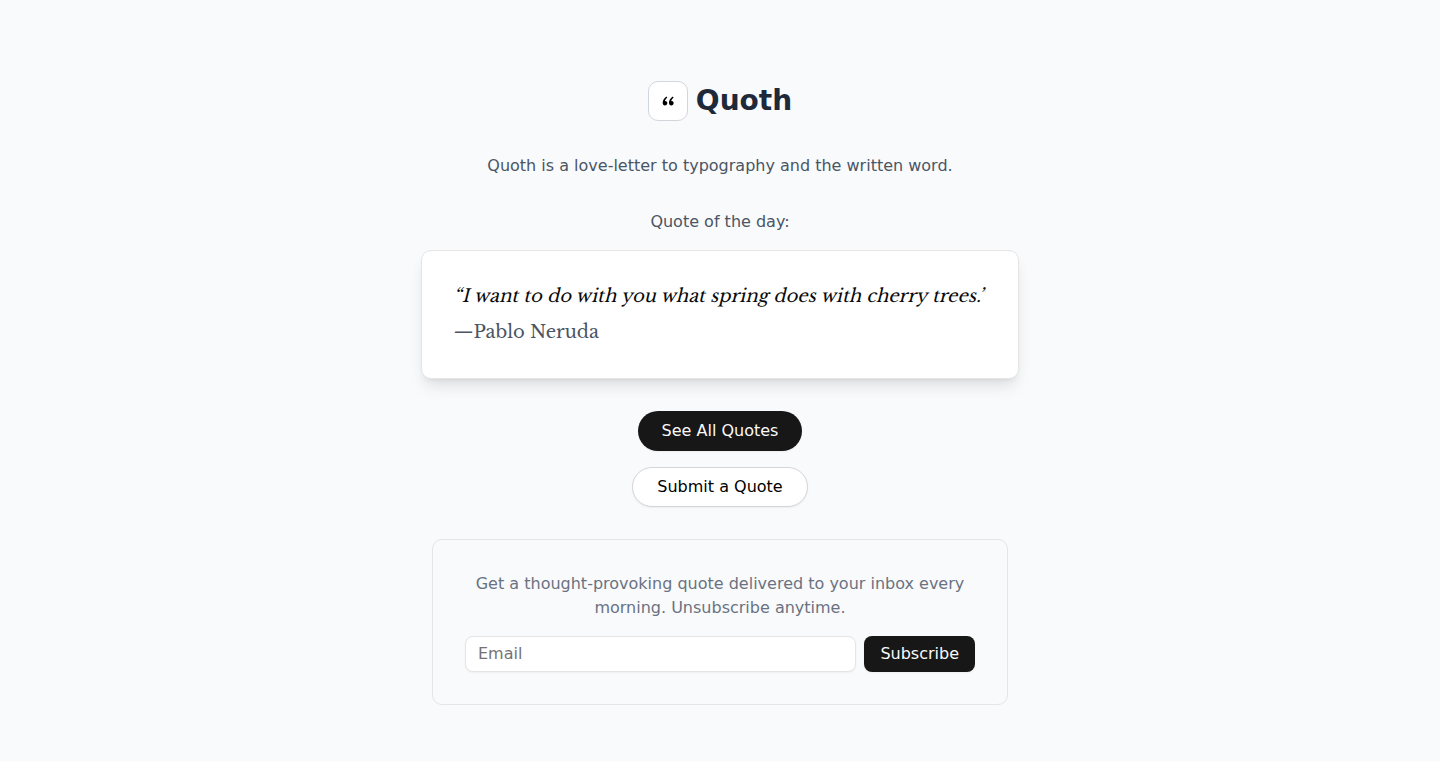
Author
nickdaze
Description
Quoth is a platform that allows you to search for quotes based on their meaning, not just the exact words used. It uses advanced techniques like 'semantic search' powered by pgvector and OpenAI embeddings to understand the context of your search. For example, you can search for 'adventure' and find quotes related to exploration. The project addresses the limitations of traditional keyword searches by providing a more intelligent and nuanced way to discover quotes. It leverages AI to analyze and categorize quotes, allowing users to uncover hidden gems and explore new perspectives. So this is helpful because it expands the way you find and use quotes for inspiration, writing, and learning.
Popularity
Points 3
Comments 0
What is this product?
Quoth uses a combination of technologies to deliver its semantic search capabilities. It employs 'embeddings' from OpenAI, which are essentially numerical representations of the meaning of a quote. These embeddings are stored in a PostgreSQL database enhanced with 'pgvector', a specialized extension designed for storing and searching vectors efficiently. When you search, Quoth analyzes your query, converts it into a similar embedding, and then uses pgvector to find the quotes with the closest matching embeddings. This allows it to return quotes that are conceptually similar to your search term, even if they don't contain the exact words. So, this means you get more relevant results, going beyond just keywords.
How to use it?
Developers can use Quoth as a learning resource or inspiration source. For example, a developer working on a motivational app could leverage Quoth to find quotes related to 'perseverance' or 'innovation' to integrate into their application. The platform also allows developers to study the code (if it is released) for understanding how to implement semantic search using pgvector and OpenAI's embeddings. By examining the codebase, developers can learn how to build similar search functionalities for their own projects. Further, the project is built with modern technologies like Next.js 15 with App Router, TypeScript, Prisma 6, and PostgreSQL with pgvector, which provides a good reference point.
Product Core Function
· Semantic Search: The core functionality is the ability to search for quotes based on their meaning rather than just keywords. This provides a more intelligent and intuitive search experience, allowing users to discover relevant quotes even if they don't know the exact phrasing. This means you can explore new quotes in unexpected ways.
· AI-powered Understanding: The project uses OpenAI embeddings to understand the meaning of quotes and search queries. This allows the system to make connections between concepts and find quotes that are related, even if they don't contain the same words. This ensures a richer and more relevant search experience.
· Vector Database Integration: Using pgvector, a PostgreSQL extension, Quoth efficiently stores and searches through the embeddings. This specialized database setup is crucial for the speed and accuracy of semantic search, enabling quick retrieval of relevant quotes. This translates into faster search times and a more responsive user experience.
· Curated Quote Collection: Quoth provides a curated collection of quotes, ensuring high-quality and relevant search results. Community submissions and a verification system help to keep the content accurate and valuable. It ensures a trustworthy source of inspirational content.
· Dynamic OG Image Generation: For social sharing, Quoth generates custom Open Graph (OG) images with typography. This makes the shared content more visually appealing and engaging, making it easier for users to share and discover quotes. This improves the user experience by creating appealing content for social media and improving the spread of quotes.
· Daily Newsletter: Quoth sends a daily newsletter to users, featuring new quotes. This keeps users engaged and encourages them to return to the platform regularly. This allows for consistent engagement and the building of an active user base.
Product Usage Case
· A developer creating a writing assistant tool could integrate Quoth to provide users with relevant quotes to inspire their writing or add depth to their content. For example, a user writing about 'resilience' could use Quoth to quickly find quotes related to overcoming challenges. This means your writing becomes more engaging.
· An educator or content creator could use Quoth to curate a collection of quotes for a lesson or presentation. The semantic search capability makes it easy to find quotes on specific themes, regardless of the exact wording. This enables efficient content creation.
· A social media manager could use Quoth to find and share inspirational quotes on social media platforms, enhancing their content strategy and improving engagement. This provides engaging content for their audience.
· A developer can study the architecture of the project to learn how to implement semantic search functionality using pgvector and OpenAI embeddings. This allows them to implement a similar search in their own products and service. This improves their technical capabilities
36
Flutter Browser IDE: Code in Your Browser

Author
tadaspetra
Description
This project is a complete Integrated Development Environment (IDE) for Flutter, running directly within a web browser. Instead of installing heavy development tools locally, developers can write, debug, and test Flutter applications entirely online. The core innovation lies in leveraging web technologies (like WebAssembly and Flutter itself) to emulate a full-fledged IDE environment, offering a smooth and accessible Flutter development experience. This tackles the common issue of local setup complexity and allows for rapid prototyping and collaboration, significantly reducing the barrier to entry for Flutter development.
Popularity
Points 3
Comments 0
What is this product?
This is a browser-based IDE for Flutter. It allows you to write, debug, and run Flutter code directly in your web browser. It works by using advanced web technologies to replicate the functionality of a desktop IDE, providing features like code completion, syntax highlighting, and debugging tools. This means you don't need to install a bulky IDE on your computer, making it easier to start developing Flutter apps. It's innovative because it brings the power of a full IDE to your browser, offering a truly cross-platform and accessible development experience. This innovation makes Flutter development more convenient, especially for beginners or those who want to experiment without a complex setup. So what's it for? It's for anyone who wants to develop Flutter apps without the hassle of installing and configuring local tools, or those who want a more accessible and collaborative way to work on Flutter projects.
How to use it?
Developers can access this browser-based IDE through a web link. They can then write their Flutter code directly in the browser's code editor. The IDE provides features like code completion, syntax highlighting, and error checking, making coding easier. They can then run the Flutter app directly within the browser, or connect to external devices/emulators for testing. This can be used for quick prototyping, educational purposes, and collaborative coding sessions, where multiple developers can work on the same project simultaneously, all without needing to install any software. Developers can integrate it into their existing workflows by simply using their web browser. So what's it for? It provides a streamlined and accessible way to develop Flutter applications, making it easier to learn and experiment with Flutter without the complexities of a traditional setup.
Product Core Function
· Code Editor: The IDE provides a code editor with features like syntax highlighting, code completion, and auto-formatting. This helps developers write clean and correct code more efficiently. Application: Developers can quickly edit and debug Flutter code in the browser without needing to install heavy local tools. So what's it for? It improves the coding experience and reduces the time spent on repetitive tasks.
· Debugging Tools: This allows developers to step through their code, inspect variables, and identify and fix bugs. Application: This feature is useful for quickly identifying and fixing issues in the Flutter application, leading to a more stable and reliable app. So what's it for? It helps developers find and fix errors in their code, saving time and improving code quality.
· Live Preview: The IDE has the ability to render the Flutter UI and display the changes as developers write code in real-time. Application: The live preview feature allows developers to see changes as they make them, speeding up the development process and improving the user experience. So what's it for? It allows developers to see changes immediately, which speeds up development and makes creating UIs easier.
· Project Management: Allows developers to organize code and create multiple files and folders for a better code structuring. Application: This function is helpful in large projects where having a good structure of code makes it easier to debug and maintain the app. So what's it for? It allows developers to better manage large projects.
Product Usage Case
· Rapid Prototyping: A developer wants to quickly build a prototype for a new Flutter app idea. Using this browser-based IDE, they can skip the local setup and immediately start coding, testing different features and designs directly in the browser, saving time. So what's it for? It's perfect for quickly testing app ideas without complex setup.
· Educational Purposes: A teacher wants to demonstrate Flutter development to students during an online course. The browser-based IDE allows students to follow along without needing to install any software, removing the barrier to entry for beginners. So what's it for? Great for teaching Flutter to beginners without the setup hurdle.
· Collaborative Development: Multiple developers are working on a Flutter project. Using this IDE allows them to easily share code, work simultaneously, and test changes in a shared environment, simplifying the collaborative process. So what's it for? Enables easy collaboration on projects without the need for complex environment setups.
37
Weather AI: Rapid AI-Powered Weather Forecasting

Author
timetodine17
Description
Weather AI is a project that leverages the power of Artificial Intelligence (AI) to generate quick and accurate weather forecasts. It tackles the limitations of traditional weather models by employing machine learning techniques to analyze vast amounts of historical weather data and produce predictions significantly faster. This project is all about accelerating weather forecasting, making it more accessible, and potentially more accurate.
Popularity
Points 3
Comments 0
What is this product?
Weather AI uses AI, specifically machine learning, to predict the weather. Instead of relying solely on complex mathematical models like traditional weather forecasting, it learns from past weather patterns. Think of it like teaching a computer to recognize weather based on historical data, like temperature, wind speed, and cloud cover. The innovation lies in its speed and efficiency, providing quicker forecasts than existing methods. So, the key is to predict future weather faster and better, compared to existing methods.
How to use it?
Developers can integrate Weather AI into their applications through APIs, potentially enhancing any app or service that needs weather information. Imagine integrating it into travel apps, agricultural platforms, or even home automation systems. It's particularly useful for those needing real-time or rapid weather updates. For instance, you could use it to create a smart irrigation system that adjusts based on upcoming rain forecasts. So, you can easily add up-to-the-minute weather predictions to your own apps and services.
Product Core Function
· Fast Forecast Generation: The core function is to quickly generate weather forecasts. This means getting weather predictions in a fraction of the time it might take traditional methods. This is valuable for applications that need up-to-the-minute weather data, like flight planning or outdoor event scheduling. So, I can get weather data in real-time, saving time and effort.
· AI-Powered Predictions: It utilizes AI to analyze historical weather data and make predictions. The AI model learns from the past to anticipate future weather patterns, which can lead to more accurate forecasts, especially over shorter time scales. This is crucial for hyperlocal weather predictions. So, it helps me get better weather forecasts for specific locations.
· API Integration: Weather AI likely offers an API (Application Programming Interface), making it easy for developers to integrate its forecasting capabilities into their own applications. This simplifies the process of incorporating weather data into various projects. So, it's easy to add weather forecasting to my existing apps.
· Potential for Improved Accuracy: By using machine learning, Weather AI has the potential to improve forecast accuracy, especially in complex weather scenarios. This can be extremely useful for businesses and individuals who rely on weather forecasts for decision-making. So, I can potentially get more accurate weather information.
Product Usage Case
· Travel Application: A travel app integrates Weather AI to provide users with up-to-the-minute weather forecasts at their destinations. This allows travelers to pack appropriately and plan activities accordingly. So, I can plan my trip better.
· Agricultural Platform: An agricultural platform uses Weather AI to predict rainfall and temperature variations, allowing farmers to optimize irrigation schedules and crop management. This leads to better resource allocation and potentially higher yields. So, it helps me manage my farm more efficiently.
· Home Automation: A home automation system utilizes Weather AI to control smart home devices based on predicted weather conditions, for example, adjusting the thermostat or closing window shades automatically. This improves energy efficiency and comfort. So, it can automate my home based on the weather forecast.
38
QuizKnit: AI-Powered Quiz Generator
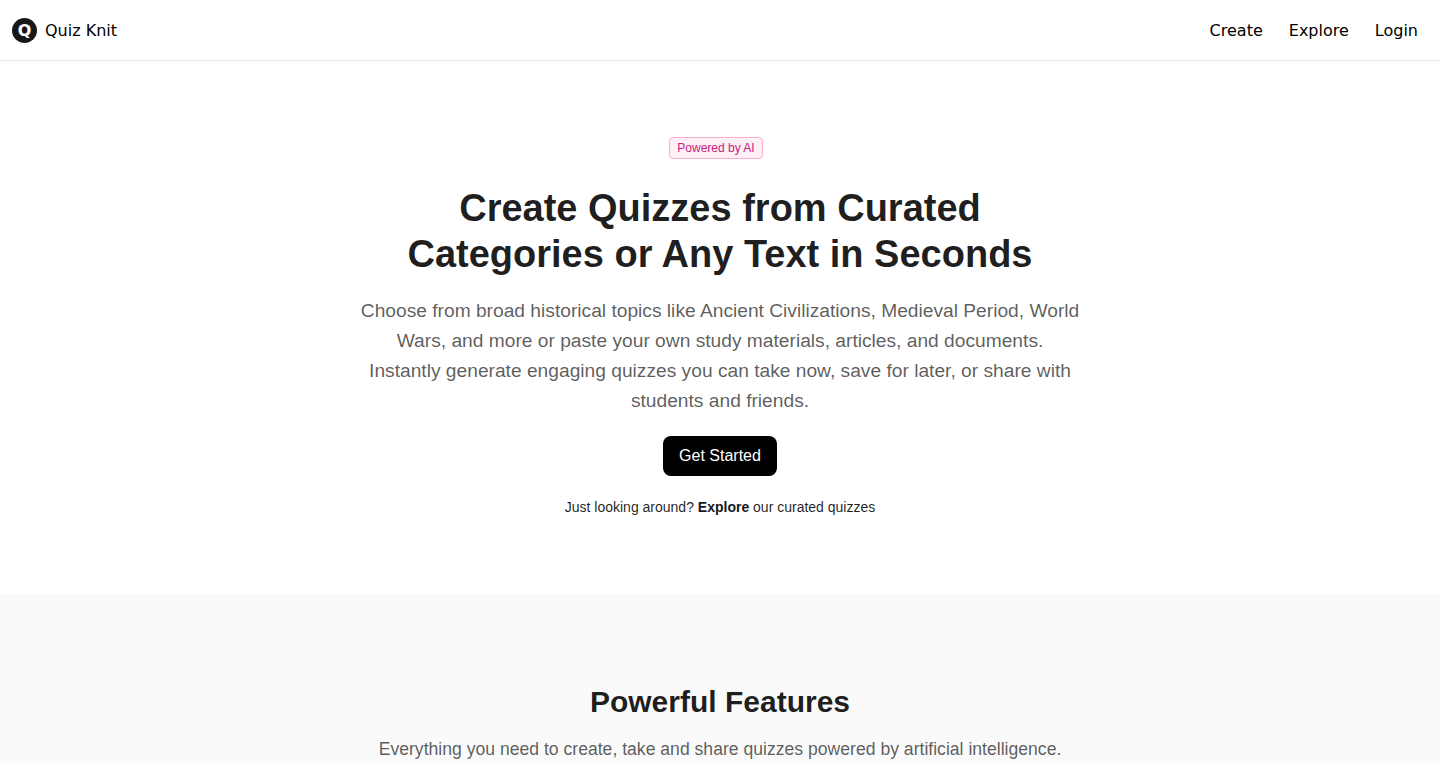
Author
jibolash
Description
QuizKnit is an open-source quiz creator that leverages OpenAI's API to generate quizzes from text or historical categories. It started as a personal project and evolved into a full-fledged application that allows users to create, take, save, and share quizzes via a URL. The core innovation lies in its ability to automatically generate quizzes, making it easy for anyone to create engaging and educational content without manual effort. So, if you need to create quizzes quickly, this is for you.
Popularity
Points 3
Comments 0
What is this product?
QuizKnit utilizes OpenAI's powerful language models. You can feed it text, and it will create quiz questions and answers based on that content. Alternatively, it provides access to a range of historical categories to choose from. It then creates quizzes based on those. This means you can create quizzes with minimal effort. It's like having an AI assistant that does all the quiz-making work for you. So, if you're a teacher or trainer, this streamlines the quiz creation process.
How to use it?
Developers can integrate QuizKnit into their own projects by using its API (backend code available). This allows them to create custom quiz functionalities within their own applications, websites, or educational platforms. You can also contribute to the project directly. So, if you are a developer, you can enhance educational applications or build custom quiz creation tools.
Product Core Function
· Quiz Generation: The core functionality is its ability to automatically create quizzes from text inputs or chosen categories. This uses OpenAI's API to understand the content and generate relevant questions and answers. This saves significant time and effort compared to manual quiz creation. So, if you need to quickly create quizzes, this feature is essential.
· Quiz Taking and Saving: Users can take the generated quizzes directly within the application, and their progress and scores are saved. This provides a simple and efficient way to track performance. So, if you're an educator, you can track student progress easily.
· Sharing via URL: Quizzes can be shared with others using a simple URL, making it easy for anyone to access and participate in the quizzes. This feature enhances collaboration and knowledge sharing. So, if you want to easily share your quiz with colleagues or students, this is convenient.
Product Usage Case
· Educational Platforms: Integrate QuizKnit into an online learning platform to automatically generate quizzes for different courses and topics, making learning more interactive and engaging. So, if you have an online course, create quizzes in moments.
· Corporate Training: Use QuizKnit to create training assessments for employees, evaluate their understanding of new skills, and track their progress. So, if you train employees, this can provide training assessments automatically.
· Personal Learning: Use QuizKnit to study for tests or exams. Simply input the study material, and the tool will create quizzes to test your knowledge. So, if you're a student, this helps you prepare for tests and study more efficiently.
39
NSFW Subreddit Picker - A Simple Random Content Explorer

Author
nmradnom
Description
This project is a straightforward tool that provides a one-click solution to browse random adult-themed subreddits on Reddit. The innovation lies in its simplicity and focus on user experience, addressing a specific user need that was not adequately met by existing search solutions. It utilizes a static HTML page powered by a curated list of subreddits and JavaScript to fetch and open random subreddits, also incorporating a preview bar and grid view to dynamically display image thumbnails, all without user signups or tracking. So, it's a fast and easy way to explore NSFW content.
Popularity
Points 3
Comments 0
What is this product?
This is a single-page web application that allows users to randomly access adult-themed subreddits on Reddit with a single click. It uses a plain text file (`urls.txt`) containing a curated list of subreddits as its backend. The frontend uses JavaScript to retrieve a random subreddit URL from the list and opens it in a new tab. It also employs Reddit's API to display thumbnails and offers preview functionalities. This project solves the problem of users searching for a convenient way to discover NSFW content on Reddit, providing an ad-free, privacy-focused experience. So, you get instant access to random NSFW content, solving the problem of tedious searching.
How to use it?
Users simply click a button on the web page, and a new tab opens, displaying a randomly selected adult-themed subreddit. Developers can utilize similar logic by adopting the same approach: create a curated list of items (in this case, subreddit URLs), use JavaScript to fetch and display a random item from the list when a user interacts with a button or other trigger. This project demonstrates a practical example of integrating external APIs (Reddit's API) for retrieving data and dynamically displaying content on a web page. So, you can easily build similar random content pickers for any kind of content or integrate it to existing applications.
Product Core Function
· Random Subreddit Selection: The core function is randomly selecting a subreddit URL from a pre-defined list. Technical value: This showcases a simple yet effective way of using client-side scripting (JavaScript) to process data and offer a dynamic user experience, such as generating random content in a web app. Application scenario: This is applicable to other use cases. You can create a simple random item generator, such as a random fact generator, a random quote generator, or even a random product selector for e-commerce sites. So, it can make your web apps more dynamic and interesting.
· Backend data with urls.txt: The project uses a plain text file to store the subreddit URLs. Technical value: This is an incredibly basic method to store data, which lowers the complexity for the user. Application scenario: This approach can be employed in situations where you want an easily manageable and flexible data source. For example, you might use a similar system to handle configuration options or store a simple list of product SKUs. So, if you want to avoid the complexity of databases, this method will work for simple cases.
· Dynamic Thumbnail Preview using Reddit API: The implementation of preview functionality using Reddit's API. Technical value: Demonstrates API integration for dynamic content display. Application scenario: Integrating API calls to show data from an external source, such as fetching and displaying product details from a third-party e-commerce platform, displaying weather information from a weather API, or displaying real-time stock data from a financial API. So, you can easily enrich your web apps with data from other sources.
Product Usage Case
· Random Quote Generator: A developer can create a website with a simple button that randomly displays a quote from a list of quotes stored in a text file, using the same core principle of picking a random item from a curated list. So, you can get creative with content for web apps.
· E-commerce Product Recommendation: An e-commerce site can implement a similar mechanism to suggest random products to users based on a curated list, enhancing product discovery. So, you can easily add some recommendation features to your e-commerce sites.
· Interactive Learning Tool: An educational platform could use this approach to provide a random question generator or a flashcard selector from a predefined set of learning materials. So, you can use this to make your apps more interactive and enjoyable.
40
Crush Check AI: Decoding Romance with Machine Learning

Author
omarfarooq360
Description
Crush Check AI is a tool that analyzes your text message conversations (iMessage, WhatsApp, Instagram) using artificial intelligence. It gives you a 'crush score' (0-100) based on things like how quickly they respond, how much they engage, and the overall tone of the conversation. It also flags potential red flags, like manipulative behaviors, and provides a timeline of your chat. So, it helps you understand your conversations better and identify potential issues.
Popularity
Points 3
Comments 0
What is this product?
Crush Check AI uses natural language processing (NLP) and machine learning to dissect your chat logs. It identifies patterns in your conversations that humans might miss. It looks at things like response times (latency), how much each person contributes to the conversation (reciprocity), and the overall sentiment (are they being positive or negative?). It's like having a relationship expert analyzing your texts. The innovation lies in applying these techniques to a very specific and relatable problem: understanding the dynamics of your romantic interactions. So, it's a clever application of AI to everyday life.
How to use it?
To use Crush Check AI, you export your chat history from iMessage, WhatsApp, or Instagram and upload it to the app. The app processes the text and generates a report. This report includes the crush score, any red flags, and a timeline of your chat. You can also ask questions about your conversation to get specific insights. You can use it to analyze past conversations, understand current interactions, or even get feedback before sending a message. So, it helps you make informed decisions about your communication.
Product Core Function
· Crush Score Calculation: The core function is to calculate a 'crush score' (0-100) based on various conversational factors. This score provides an immediate assessment of the relationship's potential, helping users quickly gauge the level of interest and engagement. For example, if you are unsure about how someone feels about you, this provides a numerical value for it. This is useful because it helps you easily understand the dynamics.
· Red Flag Detection: Identifies and flags potentially negative or manipulative behaviors, such as 'breadcrumbing' or 'love-bombing'. This functionality leverages NLP to discern patterns of inconsistent engagement or over-the-top affection, enabling users to recognize and avoid harmful relationship dynamics. For instance, if the other person uses a specific tone for communicating, it can be identified as a red flag. This is helpful because it helps users identify potential problems.
· Chat Timeline Generation: Creates a chronological timeline of the conversation, highlighting key moments, shifts in sentiment, and response times. This visual tool allows users to review their interactions and identify patterns or turning points in their exchanges. If you want to review your conversation and understand its evolution, this function is helpful.
· Question Answering: Allows users to ask questions about their conversation and receive AI-driven insights. This feature acts as a virtual relationship advisor, providing specific feedback and helping users better understand the nuances of their interactions. For example, you can ask the tool to analyze a certain part of a conversation for further insights. It's useful because it deepens your understanding of the context.
· Sentiment Analysis: Analyzes the emotional tone of the conversation. The tool utilizes NLP techniques to identify positive, negative, or neutral sentiments expressed by each participant in the text. This feature is crucial in determining the overall atmosphere and identifying any areas of conflict or interest within the interactions. If you want to understand the sentiment of the message, this feature helps you do that.
Product Usage Case
· Analyzing a Past Relationship: A user exports an old chat history and uses Crush Check AI to understand what went wrong in a previous relationship. The tool identifies instances of inconsistent communication (red flags) or reveals a low crush score, helping the user gain clarity and learn from past experiences. So, you can use this to get closure.
· Evaluating Current Interactions: A user is unsure about someone they're interested in. They upload their ongoing chat logs to Crush Check AI, receiving a crush score and identifying early warning signs, like frequent delays in response. This allows the user to evaluate the person they are interested in, and make informed choices about how to proceed with a relationship. So, this can guide you on how to handle the relationship.
· Pre-Message Analysis: Before sending a crucial text, a user runs a draft message through Crush Check AI. The tool offers sentiment feedback and suggestions to improve the tone and clarity of the message. So, you can be sure of the message you send.
· Understanding Communication Patterns: A user consistently struggles to decipher messages from someone. Crush Check AI provides an analysis of the conversation’s timeline, identifying periods of high and low engagement. The user gains insights into the other person's communication patterns, learning to adjust their expectations and communication accordingly. So, you'll better understand how other people communicate with you.
· Improving Conversation Skills: By observing a historical chat with a high 'crush score', a user identifies the communication styles that led to the positive outcome. Then, the user can try to replicate these methods with other potential partners. The user learns what to do to improve their communication with other people. So, this is useful for learning.
41
FODMAP Food Detective: A Database for IBS Diet Management
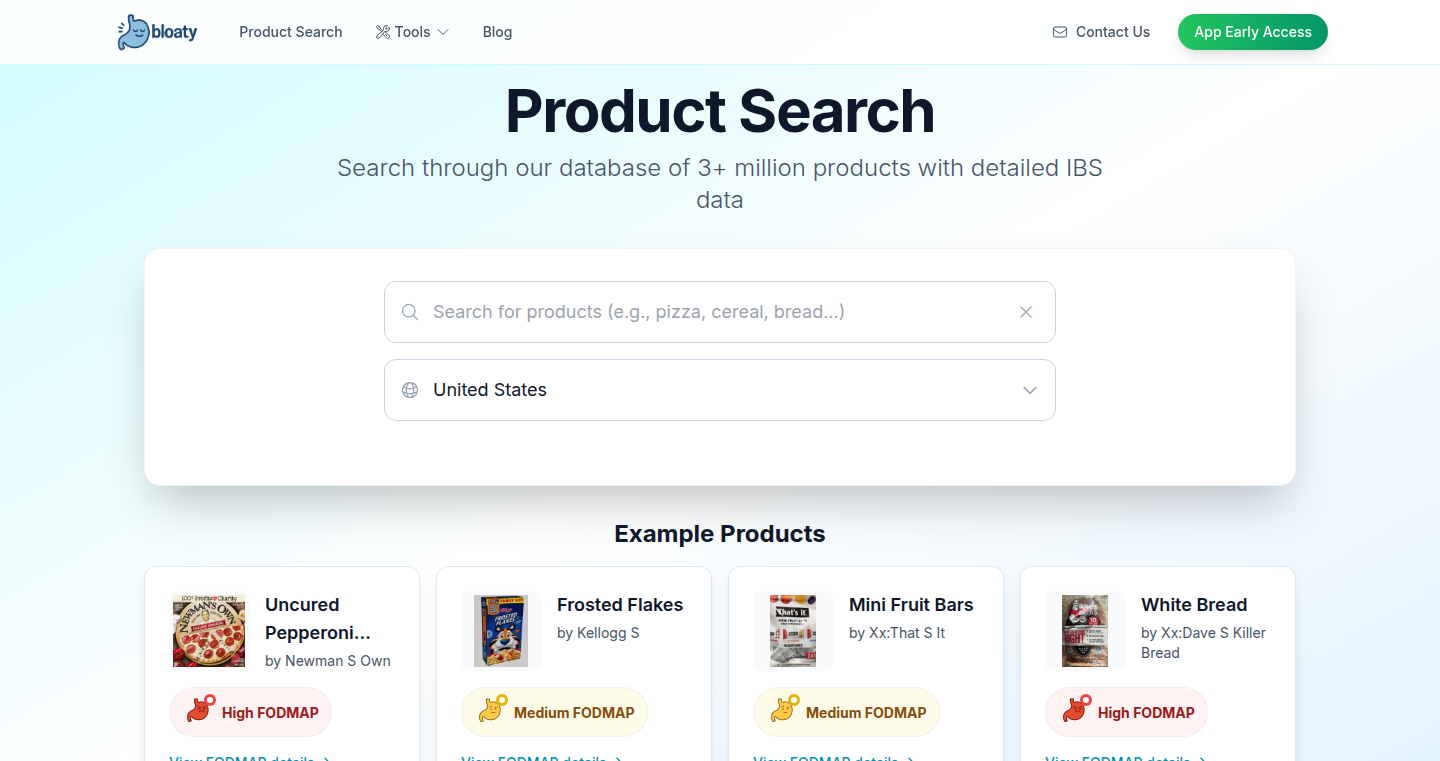
Author
qwesr123
Description
This project is a database designed to estimate the FODMAP (Fermentable Oligosaccharides, Disaccharides, Monosaccharides, and Polyols) content of approximately 3 million mass-produced foods. The creator uses publicly available data from sources like the FDA and USDA to infer the ingredient composition of food products and assign them a likely FODMAP level. This is particularly useful for individuals with Irritable Bowel Syndrome (IBS) who need to follow a low-FODMAP diet to manage their symptoms. The innovation lies in automatically analyzing extensive food data to provide a quick and easy way to assess the suitability of processed foods for a low-FODMAP diet, addressing the challenge of manually researching food ingredients and contents.
Popularity
Points 3
Comments 0
What is this product?
This is a database that uses data from the FDA and USDA to guess the FODMAP content of 3 million mass-produced foods. FODMAPs are types of carbohydrates that can trigger IBS symptoms in some people. The system works by analyzing the ingredients listed on food labels and estimating how much of these triggering carbs are present. It essentially helps people with IBS quickly identify which processed foods are safe to eat and which ones to avoid. So, you don't have to spend hours researching every ingredient.
How to use it?
Developers could integrate this database into their own apps or websites. Imagine a mobile app where users can scan a barcode and instantly see whether a food item is likely low or high in FODMAPs. Or, a recipe website could use this data to filter recipes based on FODMAP content, allowing users to easily find IBS-friendly meals. The database would likely be accessed via an API or direct data download, enabling flexible integration into various projects. So, it can make it easier for developers to create tools that help people with IBS.
Product Core Function
· Food FODMAP Estimation: The core function is to estimate the FODMAP content of a massive amount of processed foods. This value is determined by analyzing publicly available ingredient information. This is useful for providing users with an immediate assessment of a food's suitability for a low-FODMAP diet, allowing them to make informed food choices. This helps people with IBS avoid foods that might cause discomfort.
· Data Sourcing and Processing: The project relies on collecting and processing data from the FDA and USDA. The data is parsed and used to create a searchable food database. This is technically valuable as it automates the process of gathering and structuring a huge dataset for analysis, providing developers with a ready-to-use resource. This means quicker and easier access to the necessary information for IBS management.
· Ingredient Inference: The system infers ingredient composition to estimate FODMAP content where specific data is missing. This is important for accurately assessing the FODMAP profiles of products, which in turn provides reliable information to end users. So, more accurate food recommendations are available.
· API or Data Access: The database could be accessed via an API or a direct data download, allowing flexible integration into various projects. This is a developer-friendly feature, making the data accessible to developers and allowing the data to be used in many applications, like mobile apps or websites. This benefits developers creating tools for people with IBS to access the information easily.
Product Usage Case
· Mobile App for IBS Diet Planning: A mobile app could be developed that uses the database to allow users to scan product barcodes and instantly determine whether a food item is low-FODMAP. This helps users make quick and informed decisions while shopping. So, it streamlines the process of finding suitable foods in the grocery store.
· Recipe Filtering Website: A recipe website could integrate the database to filter recipes based on FODMAP content. Users could search for recipes that specifically cater to their dietary needs. So, individuals with IBS can find suitable recipes quickly.
· Nutritional Tracking Tool: A tool could be created that helps users track their food intake and monitor their symptoms, with the database integrated to automatically determine the FODMAP content of consumed foods. This provides more information about their symptoms and diet. So, users can understand their diet and its impact on their IBS symptoms.
· Smart Shopping List: An app could automatically generate a smart shopping list based on the user's dietary restrictions, checking the products against the FODMAP database. This is very useful for helping individuals create a shopping list with safe and appropriate foods. So, users can avoid accidentally purchasing items that could trigger IBS symptoms.
42
ShipName: Bilingual AI-Powered Name Blender
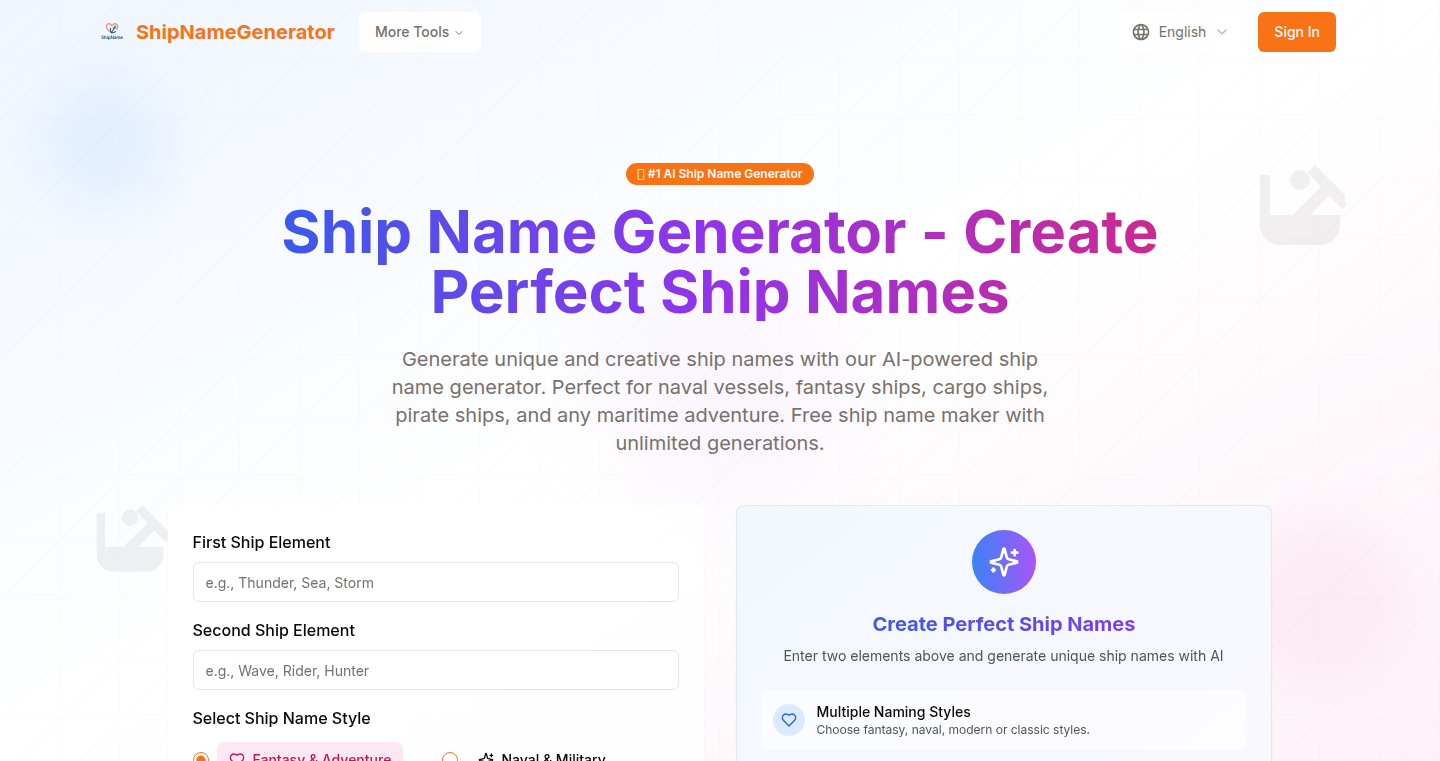
Author
virusyu
Description
ShipName is a web application that uses AI to generate catchy couple nicknames (also known as "ship names") in English, Chinese, or mixed languages. It addresses the common problem of existing tools that struggle with non-Latin characters or are behind paywalls. The project uses a combination of Next.js, Vercel Edge Functions, and the phi-3-mini-128k model via OpenRouter for name generation, along with server-side rendering for shareable image creation. It provides a zero-friction, bilingual experience for fans, couples, and wedding planners. So this is a useful tool for generating fun, shareable nicknames for couples, with solid technical foundations.
Popularity
Points 2
Comments 0
What is this product?
ShipName is an AI-powered name generator that takes two names as input and produces a variety of blended nicknames. The core innovation lies in its bilingual support (English and Chinese), handling of non-Latin characters, and creation of shareable images. It utilizes Next.js for the frontend, Vercel Edge Functions for optimized performance, and the phi-3-mini-128k model (accessed through OpenRouter) to generate creative name combinations. It then uses Satori/Resvg for server-side image generation, ensuring shareable content for social media platforms. This combination of technologies allows the app to quickly generate creative output, and to do it in two languages, which sets it apart from others. So this is a creative tool that's also techincally interesting.
How to use it?
Developers can use ShipName's public REST API (planned in the roadmap) to integrate name generation into their own applications or create a Discord bot. They can leverage the API to automatically generate names based on user input, creating interactive experiences. The underlying architecture, built with Next.js and Vercel Edge Functions, showcases efficient web development practices. For example, a developer building a social platform for couples could integrate ShipName's API to provide a fun feature that generates ship names for users. So this means developers can easily integrate name generation capabilities into their own projects.
Product Core Function
· Bilingual Name Generation: The core feature is generating blended names in both English and Chinese. This demonstrates an understanding of internationalization and handling of different character sets, making it accessible to a wider audience. So this is great for reaching a global audience.
· AI-Powered Name Blending: Uses an AI model (phi-3-mini-128k) to create name combinations, offering a level of creativity and diversity not found in simple name generators. It automates a traditionally manual creative process. So this leads to generating more interesting and unique names.
· Shareable Image Generation: Creates shareable images (PNG format) of the generated names, allowing users to easily share the results on social media platforms like X, Discord, and Weibo. This demonstrates an understanding of user experience and social media integration. So this means easy sharing and more exposure.
· Server-Side Rendering (Satori/Resvg): Enables fast and efficient generation of shareable image, optimized for sharing on social media platforms. This improves performance and provides a better user experience. So this gives users fast and better performance.
Product Usage Case
· Social Media Integration: A social media platform could integrate ShipName's API to automatically suggest names for users to use as nicknames or display on their profile pages. This provides a fun, engaging feature and improves user retention. So this means a more engaging user experience.
· Wedding Planning Apps: Wedding planning apps could integrate ShipName to suggest creative nicknames for couples during the planning process, creating a memorable experience. This adds a value-added feature. So this is a nice feature for the wedding planners to help their clients.
· Fan Communities: Fan communities or content creators can use the API to generate ship names for characters in books, movies or TV shows and use them in their fanfic or other fan-made content. This is a simple way to engage the fan base. So this lets you create more content and gain more followers.
43
Velvet Security Framework - A Delicate Touch for Robust Security
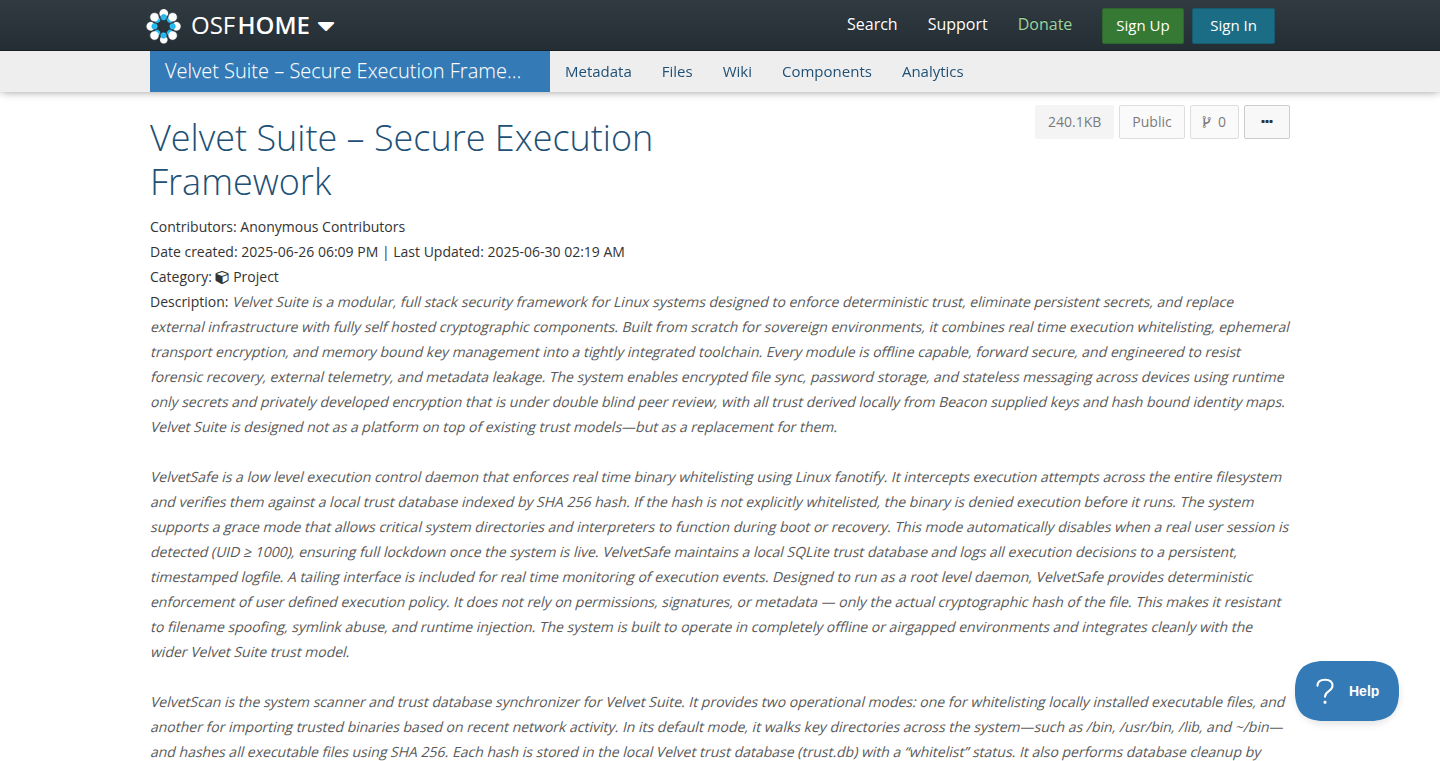
Author
LambriniWorks
Description
Velvet Security Framework is a novel approach to application security that emphasizes proactive vulnerability detection and continuous monitoring. It moves beyond simple static analysis to provide a more dynamic and adaptive security posture. The framework focuses on runtime analysis and behavior modeling, enabling developers to identify and mitigate security flaws that might otherwise go unnoticed. The key innovation lies in its lightweight, agent-based architecture that integrates seamlessly with existing development workflows, allowing for continuous security feedback. It addresses the persistent problem of security vulnerabilities in applications by shifting the focus from reactive patching to proactive prevention.
Popularity
Points 1
Comments 1
What is this product?
This framework works by placing small, intelligent agents inside your application. These agents constantly observe your application's behavior as it runs, looking for anything that seems suspicious, like attempts to access unauthorized data or unusual network activity. Think of it like having a security guard constantly watching over your application. The innovation is in how it does this: it learns the normal behavior of your application and then flags any deviations. This proactive approach helps catch vulnerabilities early and continuously, before they can be exploited. So this lets you find security problems before attackers do.
How to use it?
Developers can integrate Velvet Security Framework into their existing CI/CD pipelines. The framework provides an API that allows developers to define security policies and configure alerts. During development, the agents monitor the application in real-time and provide immediate feedback on any security violations. Developers can also use the framework to perform penetration testing and simulate attacks to validate their application's security. You just need to install the agent, define your rules, and the framework will start giving you security insights. This is useful because it helps you build security into your development process seamlessly.
Product Core Function
· Runtime Behavior Analysis: The core function analyzes application behavior as it executes. By monitoring system calls, network traffic, and data access patterns, it identifies anomalous activities indicative of potential security threats. This is valuable because it uncovers vulnerabilities that static analysis tools might miss, giving you deeper security insights.
· Real-time Threat Detection: The framework provides real-time alerts on detected threats. These alerts are triggered when the agent detects suspicious behavior, allowing developers to respond promptly. This is valuable because it reduces the time it takes to identify and respond to security threats.
· Policy-Based Security: Developers can define security policies, specifying what is considered acceptable behavior within their application. The agents then enforce these policies, blocking unauthorized actions. This is valuable because it gives developers control over the security rules that apply to their application, making it more secure.
· Continuous Monitoring: The framework continuously monitors the application for threats and vulnerabilities. This continuous monitoring ensures that the application remains secure over time, even as the codebase changes. This is valuable because it provides ongoing protection, adapting to new threats and changes in your application.
Product Usage Case
· Web Application Security: In web applications, Velvet Security Framework can detect common vulnerabilities like SQL injection and cross-site scripting (XSS) by analyzing user inputs and database interactions. It would alert developers to suspicious requests, enabling them to quickly patch the vulnerability. This is useful because it can automatically find and fix common security flaws in your web apps.
· API Security: For APIs, the framework can monitor API calls and data access patterns to detect unauthorized access or data breaches. It can also identify and block malicious API requests. This is useful because it helps you safeguard sensitive data that is exposed through your APIs.
· Cloud Environment Protection: When deployed in cloud environments, Velvet Security Framework can monitor the behavior of applications running in the cloud and identify suspicious activity, such as unauthorized data access or unexpected network traffic. This is useful because it gives you an extra layer of security to protect your cloud-based applications.
· Integration with CI/CD Pipelines: During software development, the framework can be integrated into the continuous integration and continuous deployment (CI/CD) pipeline. This provides developers with immediate feedback on the security posture of their code changes. This is useful because it incorporates security checks directly into your development process, ensuring security is part of the build.
44
Anagnorisis: Adaptive Knowledge Navigator
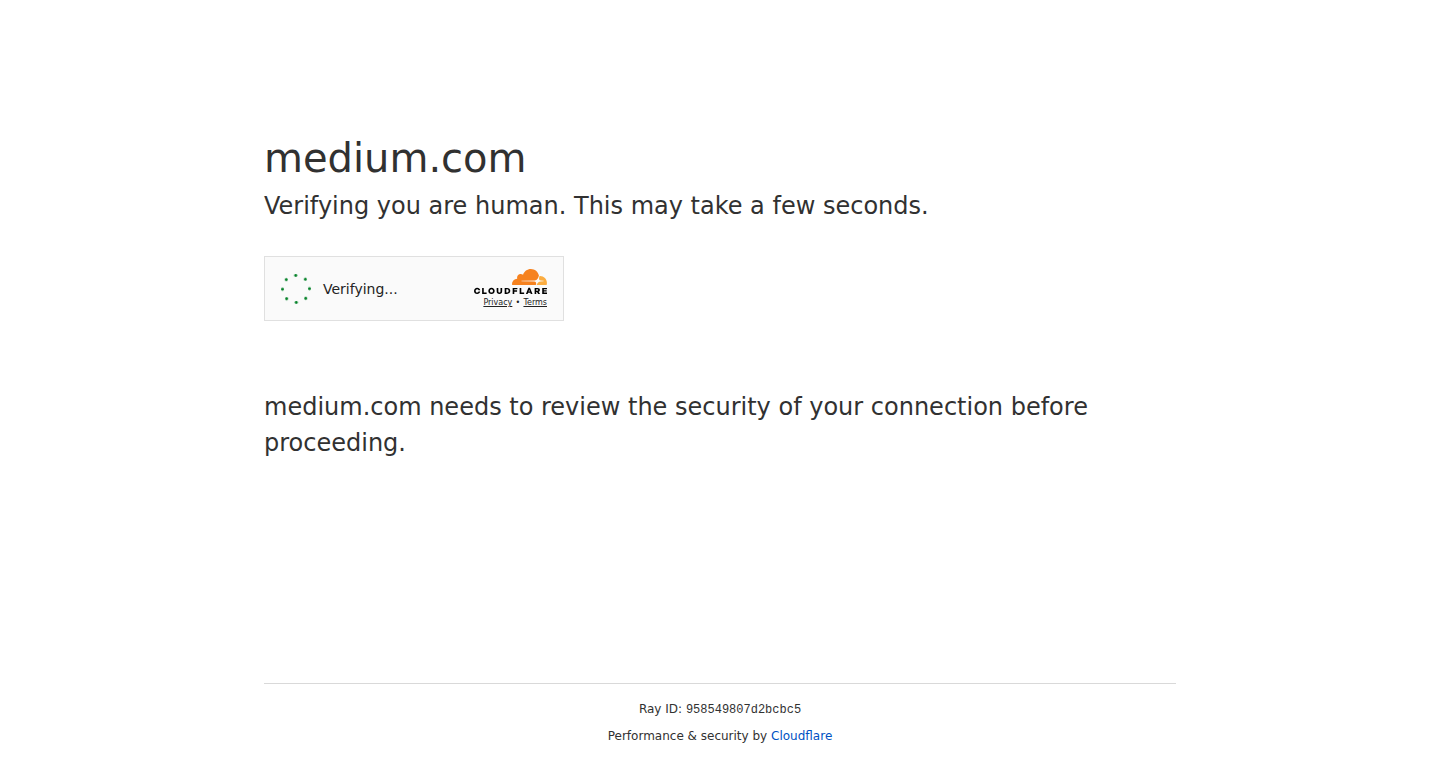
Author
volotat
Description
Anagnorisis is a project aimed at creating a better way to manage and explore information, focusing on adaptive navigation and contextual understanding. It tackles the problem of information overload by dynamically adjusting how information is presented and accessed, based on the user's interaction and the context of the information. This innovative approach uses techniques like semantic linking and personalized exploration to provide a more intuitive and efficient knowledge management experience.
Popularity
Points 2
Comments 0
What is this product?
Anagnorisis is like a smart map for your information. Instead of just storing data, it tries to understand what the data *means* and how it relates to other data. It does this through semantic linking, meaning it connects pieces of information based on their meaning, not just their keywords. The project also adapts to how you use it, so it learns what's important to you and adjusts how it shows you information. Think of it as a knowledge management system that's constantly learning and evolving to fit your needs.
How to use it?
Developers could use Anagnorisis to create more intelligent and user-friendly knowledge bases, documentation systems, or even personal note-taking apps. You could integrate it into existing applications or use it as a foundation for building new ones. The core idea is that you feed it information, and it helps users explore and understand that information in a smarter way. This could involve using APIs to integrate with note-taking software, developing custom interfaces, or building knowledge graphs for specific domains.
Product Core Function
· Semantic Linking: This function analyzes the meaning of information and connects related pieces, instead of simply matching keywords. So what? It means you can find connections between ideas that you wouldn't see otherwise, leading to deeper understanding. Think of it as connecting the dots between seemingly unrelated concepts. This is valuable for research, learning, and exploring complex topics.
· Adaptive Navigation: The system changes how information is presented and how you navigate based on your interaction with it. So what? It helps you focus on what's most relevant and adapt to your way of exploring information. This is useful for people who have difficulty processing large amounts of information, or who want to explore information in an intuitive and personalized way.
· Contextual Understanding: This allows the system to understand the context of information, so it shows you the right information at the right time. So what? It provides a more efficient and relevant experience. This is super useful for people who work with a lot of different sources of information because it cuts down on noise and highlights what's important.
Product Usage Case
· A researcher using Anagnorisis to build a knowledge graph for a specific scientific field. So what? They can discover new connections between concepts and gain deeper insights into their research.
· A developer building a smart documentation system for their open-source project. So what? Users will be able to find information faster and understand the documentation more easily, leading to better user experience.
· A student using Anagnorisis to take notes and organize their study materials. So what? They can connect ideas more easily, making it easier to study and remember information.
45
InvoiceFast: Instant Invoice Generator
Author
skyzouw
Description
InvoiceFast is a minimalist online tool designed to instantly create professional and legally compliant invoices. The innovation lies in its simplicity and speed. It cuts through the complexities of traditional accounting software, offering freelancers and small businesses a friction-free way to get paid faster. It addresses the common problem of wasted time on invoice creation, providing a focused solution that prioritizes ease of use and rapid invoice generation.
Popularity
Points 1
Comments 1
What is this product?
InvoiceFast is a web application that simplifies the process of creating invoices. Instead of using complicated accounting software or manual methods like Word templates, you can quickly input essential information (client details, services provided, amounts, etc.) and generate a PDF invoice ready to send to clients. The core innovation is its minimalist approach, focusing solely on the essential features needed for invoice creation. It avoids unnecessary complexities, making it exceptionally user-friendly. This means that it prioritizes speed and simplicity. So what? It lets you focus on your work instead of administrative tasks.
How to use it?
You can access InvoiceFast via a web browser. Users input their business information and client details, add line items for services rendered, and specify amounts. The application then automatically generates a PDF invoice, which can be downloaded and sent to the client. It's designed for easy integration into any workflow where invoicing is needed. So what? It provides an easy way to create and send invoices, without the need for complex software or manual methods.
Product Core Function
· Instant PDF Generation: The tool instantly generates a professional PDF invoice after the user inputs the required information. This saves significant time compared to manual invoice creation or using complex software. This is useful for freelancers and small businesses who need to send invoices quickly. So what? It enables you to generate invoices in seconds, saving you valuable time.
· Compliance with Legal Requirements: InvoiceFast includes all necessary legal elements in the generated invoices, ensuring compliance. This feature saves users the effort of manually ensuring their invoices meet legal standards. This is extremely useful for businesses that must adhere to invoice regulations to ensure payments. So what? Your invoices will always be legally compliant.
· Minimalist Interface: The tool’s interface is designed to be clean and focused, with minimal distractions, allowing users to create invoices quickly and efficiently. This is good for anyone who prefers a straightforward and easy-to-use tool. So what? It simplifies the invoice creation process, making it quick and easy.
· Professional Design: The invoices generated by InvoiceFast have a clean, professional design, suitable for sending to clients. This ensures that the invoices reflect the professional image of the business. So what? It generates professional-looking invoices that improve your business's image.
Product Usage Case
· Freelancers: A freelance web developer can use InvoiceFast to quickly generate invoices after completing each project, ensuring they get paid promptly without wasting time creating invoices manually. So what? Generate invoices instantly for clients, so you get paid quickly.
· Consultants: A consultant can use InvoiceFast to bill clients for hourly services, providing a professional-looking invoice that includes all the necessary details, ensuring accuracy and reducing the chances of payment delays. So what? Bill clients easily and professionally with automated invoice generation.
· Small Business Owners: A small business owner can use InvoiceFast to create and manage invoices for various clients, eliminating the need for complex accounting software, thereby streamlining the billing process. So what? Simplify the billing process and reduce administrative overhead for your small business.
46
Doggobo: Animated Storytelling Engine

Author
tujuit
Description
Doggobo is a library designed for creating animated stories, specifically targeting children and parents. The innovation lies in its focus on human-crafted animation, distinguishing it from AI-generated content. It offers a platform for delivering engaging, educational stories with visually appealing animations. This project aims to provide not only entertainment but also inspire curiosity and impart valuable life lessons. So this is useful because it provides a curated, high-quality storytelling experience free from AI-generated content.
Popularity
Points 2
Comments 0
What is this product?
Doggobo is essentially a digital animation engine for animated stories. It emphasizes human craftsmanship in its animations, focusing on visually captivating content. The technical innovation lies in curating animated content in a way that's suitable and engaging for both children and adults. It's more than just a video player; it is a curated experience. So this is useful because it allows for high-quality, artistic animated stories to be easily accessible.
How to use it?
Developers can integrate Doggobo's library into their applications or platforms to provide animated storytelling features. The specific integration details are not outlined but the general approach is to include animated storytelling experiences into an existing platform. So this is useful because it provides an easy way for developers to add high-quality animated storytelling to their applications, saving time and resources.
Product Core Function
· Animated Story Playback: Core functionality is the ability to play animated stories. This functionality enables users to enjoy the animated content designed for children. Application: In educational apps, it can be used to illustrate concepts through animated narratives; in entertainment apps, it serves as the core feature for delivering animated content. So this is useful because it provides the fundamental feature of the application, offering content consumption in an engaging manner.
· Curated Content Library: The Doggobo project emphasizes curated content that doesn't involve AI. It is likely that Doggobo will have a library of stories. Application: The library ensures high-quality content. This feature provides a safety net that will ensure that users can enjoy the product without the risk of AI-generated content. So this is useful because it will guarantee an appropriate and high-quality experience.
Product Usage Case
· Educational Apps: Developers creating educational applications for children can integrate Doggobo's library to create interactive lessons. They can create animated stories to explain complex scientific concepts in a more engaging and understandable format. Application: This use case enhances learning through visual storytelling. So this is useful because it offers a way to use high-quality animations to support education.
· Entertainment Platforms: Streaming services or children's entertainment platforms can incorporate Doggobo to offer a new category of animated content. Application: By utilizing Doggobo, these platforms provide a curated, high-quality animated story experience. So this is useful because it helps provide a new streaming category that's high quality.
47
UniLinkPay - Universal Payment Gateway for Global Creators
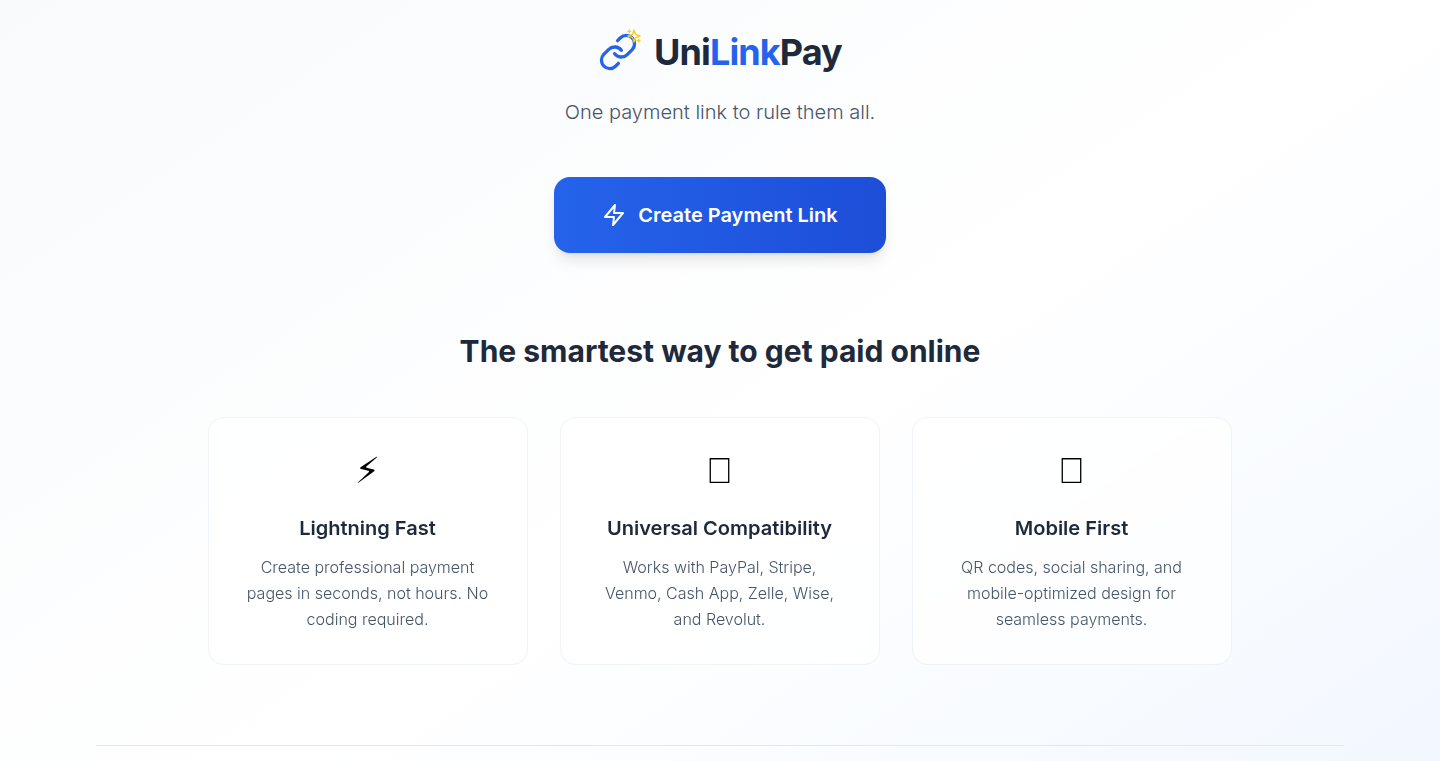
Author
freebzns
Description
UniLinkPay simplifies the process of getting paid online from anywhere in the world. It creates a single, smart link that dynamically routes payments based on the user's location and preferred payment methods. The core innovation lies in its automated payment routing, currency conversion, and support for multiple payment processors, making it a powerful tool for creators and businesses operating internationally. It solves the common problem of dealing with complex payment integrations and fluctuating exchange rates.
Popularity
Points 1
Comments 1
What is this product?
UniLinkPay is a single link that helps you receive payments from anyone, anywhere. Behind the scenes, it's a smart engine that automatically figures out the best way to get you paid. Think of it as a universal translator for money. It looks at where the person paying is located and which payment methods they prefer, then picks the right payment processor (like Stripe, PayPal, etc.) and handles the currency conversion. So this lets you easily sell your products or services to customers from different countries without the headache of setting up multiple payment systems.
How to use it?
Developers integrate UniLinkPay by simply including the single link on their website or in their content. When a customer clicks the link, UniLinkPay takes over, handling everything from selecting the payment processor to currency conversion. You can also integrate it with your existing e-commerce platforms or create custom integrations using the UniLinkPay API. So this eliminates the need to manually integrate with each payment provider, saving a ton of development time and keeping everything streamlined.
Product Core Function
· Smart Payment Routing: The system intelligently selects the best payment processor based on the customer's location and payment preferences. Value: Simplifies the payment process for both the seller and the buyer, increasing conversion rates. Application: Ideal for international sales where payment options vary by region.
· Automated Currency Conversion: UniLinkPay automatically converts currencies, ensuring the seller receives the correct amount in their preferred currency. Value: Eliminates the need for manual currency calculations and minimizes financial risks related to exchange rate fluctuations. Application: Extremely useful for creators selling digital products or services globally.
· Multi-Processor Support: Supports integration with various payment processors like Stripe, PayPal, and more. Value: Provides flexibility and a wider range of payment options for customers. Application: Ensures that sellers can accept payments from almost anyone, regardless of their preferred payment method.
· Customizable Link: Allows users to customize the payment link with branding and other specific details. Value: Enhances the user experience and reinforces brand identity. Application: Essential for businesses wanting a consistent brand presence during the payment process.
Product Usage Case
· A freelance developer uses UniLinkPay to invoice international clients. The system automatically converts the invoice amount into the client's currency and processes the payment through the client's preferred method, making the payment process effortless. So this saves time and reduces friction in getting paid from different clients.
· An online course creator uses UniLinkPay to sell courses to students worldwide. The platform selects the optimal payment method based on the student's location, allowing them to pay easily. So this expands market reach and increases sales by removing payment barriers.
· An e-commerce store integrates UniLinkPay to handle cross-border transactions. The system handles currency conversions and payment processing, simplifying operations and reducing the overhead of maintaining multiple payment integrations. So this simplifies international business and reduces the operational complexity.
48
ArcFont: Deep Learning for Dynamic Font Embedding
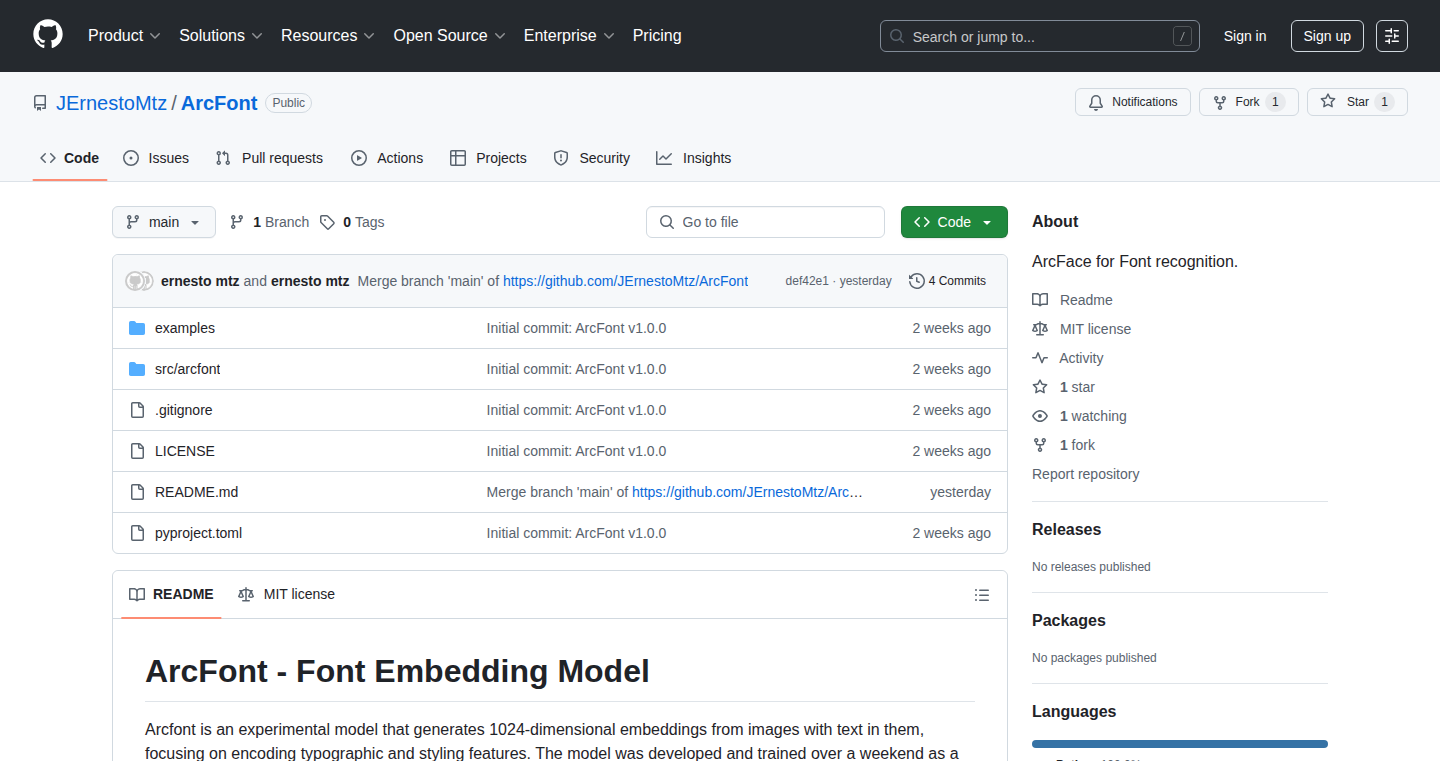
Author
jernestomg
Description
ArcFont is a project utilizing deep learning to embed fonts. Instead of statically embedding a font, it learns a vector representation of the font, allowing for dynamic generation and manipulation. This solves the problem of needing to store and manage multiple font files for different sizes or styles, offering a more efficient and flexible way to handle typography in applications.
Popularity
Points 2
Comments 0
What is this product?
ArcFont uses a neural network to understand the essence of a font. It takes font glyphs (characters) as input and generates a vector (a series of numbers) that represents that font. This vector is then used to reconstruct the glyphs. The innovation lies in learning a model that captures the font's characteristics, allowing for modifications like scaling and style changes without needing the original font files. So this means you get dynamic font manipulation and save storage space.
How to use it?
Developers can integrate ArcFont into their projects by using the generated font vectors. Instead of including large font files, they only need the model and the vector. When rendering text, the model is used to dynamically generate the glyphs based on the vector. This is useful in applications like web design, game development, and document processing, where you need to handle a variety of fonts efficiently. So this gives developers more flexibility with their font choices and simplifies their code.
Product Core Function
· Font Vector Generation: Generates a numerical representation (vector) of a font, capturing its key characteristics. Value: Simplifies font management by replacing large font files with compact vectors. Application: Allows for the creation of font catalogs and efficient font usage in different applications. So this means less font file clutter and faster loading times.
· Dynamic Font Manipulation: Enables scaling, styling, and other transformations of fonts using the generated vectors. Value: Provides greater control over typography without requiring multiple font files. Application: Useful for creating responsive designs, interactive text elements, and generating personalized content. So this lets you customize your fonts on the fly.
· Font Style Interpolation: Supports the creation of intermediate font styles by blending vectors of different fonts. Value: Facilitates the creation of new font variations and design exploration. Application: Beneficial for font design, user interface customization, and generating unique visual styles. So this lets you create interesting new font styles by mixing existing ones.
· Storage Optimization: Reduces the storage footprint of font resources by storing font vectors instead of entire font files. Value: Reduces the amount of memory/storage your application requires. Application: Improves performance in environments with limited storage or bandwidth (e.g., mobile devices, web applications). So this saves space and makes your application run faster.
Product Usage Case
· Web Design: A web developer can use ArcFont to create a website with a wide variety of font styles without downloading a ton of font files. ArcFont handles the variations internally and the user sees the fonts immediately. So this means your website looks better and loads faster.
· Game Development: A game developer utilizes ArcFont to implement a dynamic in-game text system. They can manipulate font sizes, colors, and styles in real-time based on game events. So this makes for a richer gaming experience.
· Document Processing: A document processing application employs ArcFont to offer users a flexible font selection without having to install hundreds of font files. Users can customize their documents with different font styles on the fly. So this makes it easier to create professional documents.
· User Interface Design: A UI designer uses ArcFont to create a dynamic UI with text elements that adapt to the user’s screen size. The application dynamically scales and adjusts the font based on the device. So this makes your app look good on all devices.
· E-commerce Applications: An e-commerce platform uses ArcFont to create customized product listings with visually distinct and attractive text. This enhances the user experience and captures the user's attention. So this means your products look better and it may lead to more sales.
49
IdeaSpark: Daily SaaS Idea Curator
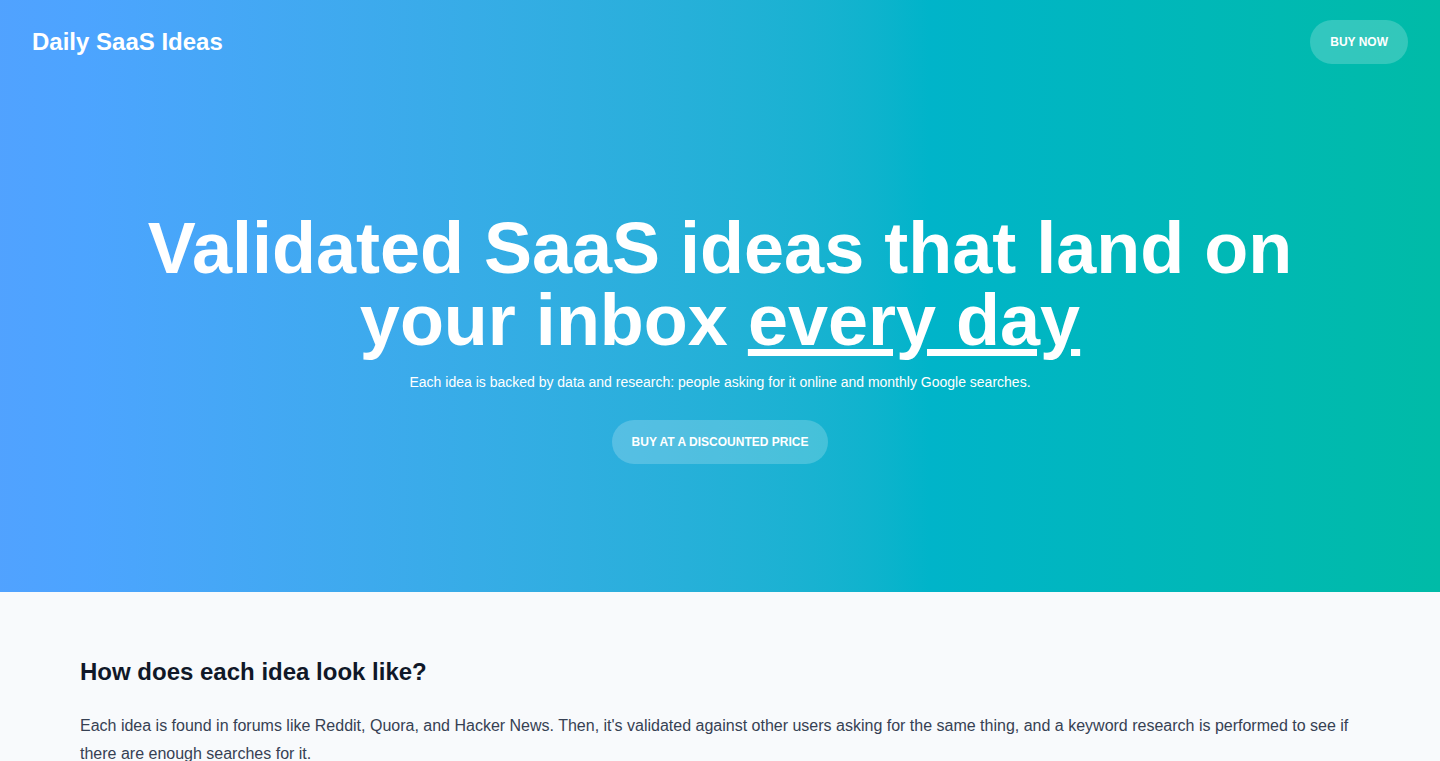
Author
sandandcode
Description
IdeaSpark is a micro-tool that finds potential Software-as-a-Service (SaaS) ideas for you by scouring popular online platforms like Reddit and Hacker News, analyzing competitors, and conducting basic keyword research to gauge demand. It then validates these ideas manually and delivers them to your inbox daily. The core innovation lies in automating the early-stage idea validation process, which is often a time-consuming and manual task for aspiring entrepreneurs.
Popularity
Points 2
Comments 0
What is this product?
IdeaSpark automates the initial stages of identifying promising SaaS business ideas. It leverages web scraping, competitor analysis, and keyword research to find potential opportunities. The ideas are then manually vetted for feasibility and market relevance. So, it helps you discover and quickly validate business ideas. The innovation is in the automated gathering and initial filtering of ideas, saving you considerable time and effort at the idea generation phase.
How to use it?
Developers can sign up for the daily email. The tool delivers validated SaaS ideas directly to their inbox. You can use these ideas to inspire new projects or to learn about market trends and unmet needs. This project is easily integrated into your daily routine, providing a constant stream of potential business opportunities.
Product Core Function
· Idea Discovery: Automates the process of finding SaaS ideas by scraping data from various sources such as Reddit, Hacker News and competitor websites. It removes the need for manual browsing and searching. So, it saves time spent on market research.
· Keyword Research: Performs basic keyword research to gauge the demand for the SaaS ideas. This helps to understand market interest and potential profitability. So, you gain insights into the search volume and popularity of each idea.
· Competitor Analysis: Analyzes existing competitors to understand the market landscape and identify opportunities for differentiation. You understand what other businesses do, and you can find gaps and find new angles.
· Manual Validation: Manually vets each idea for feasibility and market relevance. This ensures that the delivered ideas are of high quality and have a greater chance of success. So, it increases the likelihood of identifying truly viable business ideas.
Product Usage Case
· A developer wants to launch a new SaaS product but struggles with generating ideas. IdeaSpark provides a daily stream of validated SaaS ideas, helping the developer identify potential projects that align with market demand and reduce the time needed for idea generation. So, the developer has a continuous source of potential projects.
· A developer is interested in building a product in the AI space but isn't sure which direction to go. IdeaSpark's daily suggestions give her a better understanding of the market needs and also gives her inspiration to build a product. So, the developer gains insights into the current trends in the AI market.
· A team of developers is looking for startup ideas. IdeaSpark's automated data gathering tools allows them to quickly scan many resources. This accelerates their idea validation pipeline. So, the team can quickly narrow down potential ideas and invest more time in the most promising ones.
50
Snippet Curator: Offline Note Explorer
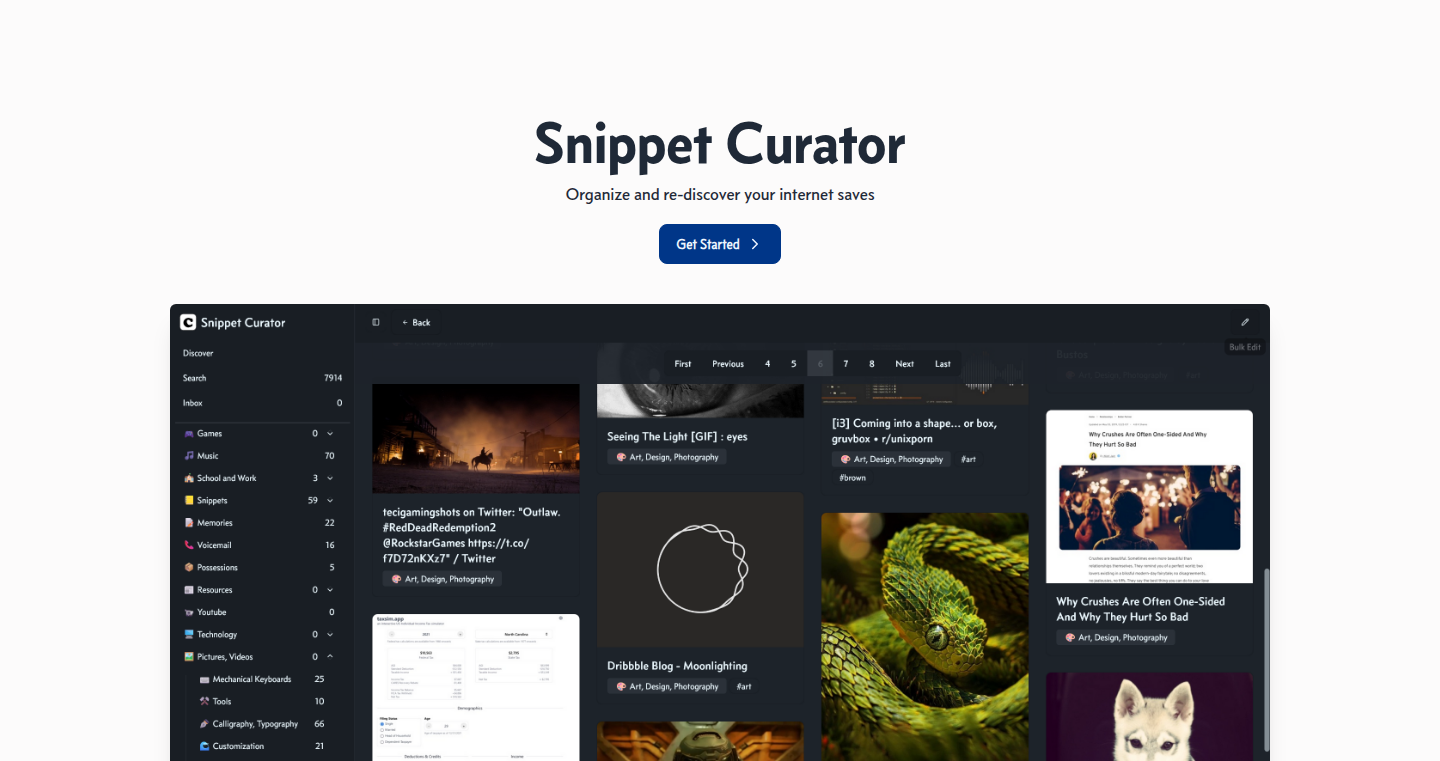
Author
kangruixiang
Description
Snippet Curator is a personal note management tool designed as an alternative to Evernote, focusing on offline access and rediscovery of your saved content. Unlike many note-taking apps that emphasize writing, this focuses on curating and exploring existing notes, images, web clips, and bookmarks, imported from Evernote ENEX files and SingleFile HTMLs. It uses a ranking system based on ratings and viewing history to help users find their most relevant and valuable notes. This project addresses the need for a private, offline solution for accessing and organizing accumulated digital knowledge, without relying on cloud services or AI. So, this lets you manage your notes independently without needing an internet connection or fearing privacy breaches.
Popularity
Points 2
Comments 0
What is this product?
This project is like a personal digital archive. It takes your saved content from Evernote (or similar formats like SingleFile HTML) and lets you browse and sort them. The cool part is it works entirely offline, meaning your data stays private and you can access it anytime, anywhere. It ranks your notes based on how often you look at them and your own ratings. It's all about making it easy to find those valuable bits of information you've saved over time. So, think of it as your personal offline library of everything you've collected.
How to use it?
Developers can use Snippet Curator by importing their Evernote ENEX files or SingleFile HTML documents. Then, you can use the app's interface to browse, search, and sort your notes. It’s particularly useful for developers who collect code snippets, research papers, or documentation. You can rate your notes, and the app will prioritize showing you the ones you've found most useful. Integration is straightforward: just import your data, and you're set. This makes it perfect for anyone who wants a secure and private way to manage their personal knowledge base.
Product Core Function
· ENEX and SingleFile Import: Allows importing notes from Evernote and web pages saved as SingleFile HTML. This value is its ability to easily ingest large amounts of data from popular sources, making it easy to migrate your content to a new system. So, you can bring all your saved information in one place.
· Offline Access: All data is stored locally, ensuring access without an internet connection and protecting user privacy. This gives you the freedom to access your notes anywhere and keeps your data safe from prying eyes. This is useful for anyone who values their privacy and needs to access information on the go.
· Note Ranking: Sorts notes based on ratings and viewing history, helping users find the most relevant information quickly. This helps users to prioritize the most valuable notes, saving time and improving productivity. So, you can quickly find the notes that are actually useful to you.
· No AI, No Ads: The project avoids using AI or displaying ads, guaranteeing a clean and focused user experience. This keeps the experience streamlined without distractions or unwanted data collection. For developers, it means the system is less resource-intensive and easier to maintain. This ensures a distraction-free experience focused solely on your content.
· Free and Subscription-Free: The project is offered without any monthly fees, making it a cost-effective solution. This makes it accessible to anyone, regardless of their budget. This means you get a powerful tool without paying extra fees.
Product Usage Case
· A developer uses Snippet Curator to organize and search through a collection of code snippets and technical articles saved from various sources. They import their Evernote ENEX files and use the ranking feature to quickly access the most used and relevant snippets for their current project. So, they can access code snippets anytime even offline.
· A researcher imports their collection of research papers, web clips, and bookmark links into Snippet Curator. They rate and view the notes, enabling them to easily rediscover important information for their upcoming publications. So, the researcher can quickly find the information they need to work effectively.
· A student uses Snippet Curator to organize notes from different sources (web clips, PDF files, etc.). They use the offline feature to access the notes during study sessions. The ranking functionality helps them to quickly find the most relevant information for their exams. So, a student can organize and access notes in a secure and quick way for any exam.
51
Git Pocket: Your GitHub Read-It-Later Companion
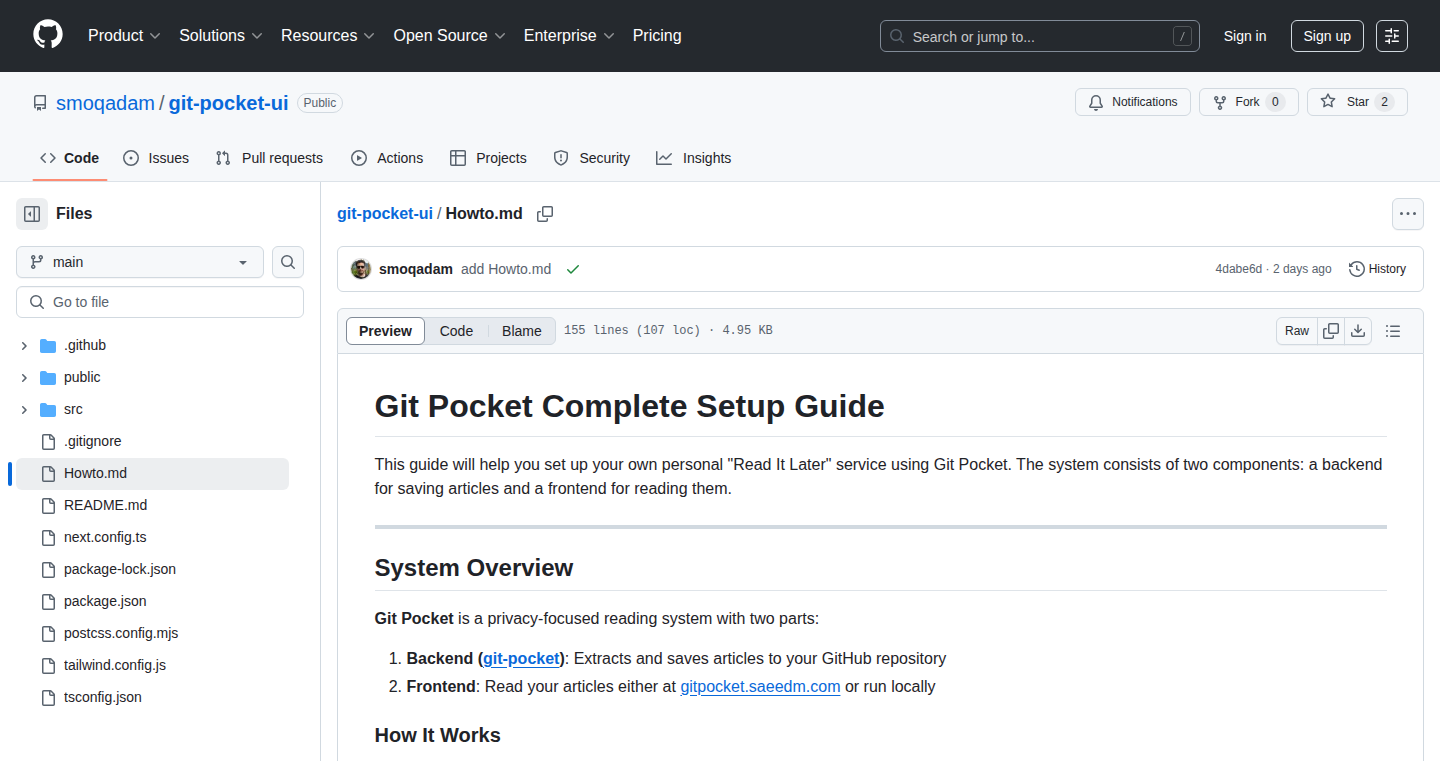
Author
smoqadam
Description
Git Pocket is a simple yet clever application that allows you to 'save' interesting GitHub content (like repositories, issues, and pull requests) for later reading. It leverages the GitHub API to fetch and store this content, offering a streamlined reading experience without having to keep countless tabs open. The technical innovation lies in its lightweight design and focus on providing a quick and convenient way to manage your GitHub reading list, addressing the common problem of information overload on the platform.
Popularity
Points 2
Comments 0
What is this product?
Git Pocket is essentially a 'read it later' app, but specifically designed for GitHub. It works by letting you bookmark interesting GitHub pages. When you save something, the app uses the GitHub API to grab the content and store it. This means you can easily access your saved items without having to constantly refresh your browser or manage a mountain of open tabs. The innovation here is the laser focus on a specific platform (GitHub) which allows for a clean and efficient user experience, solving the problem of too much information on GitHub.
How to use it?
Developers can use Git Pocket by simply installing it (likely as a browser extension or a web app). Then, whenever you're browsing GitHub and find something you want to read later (a project, an interesting issue, a pull request), you click the 'save' button. The app then stores that content for you to access later. This is perfect for developers who spend a lot of time on GitHub and want to curate a focused reading list. It integrates with your existing GitHub workflow, saving you time and improving your productivity.
Product Core Function
· Saving GitHub content: The core function is to save GitHub content (repositories, issues, pull requests) with a single click. This allows you to create a personalized list of things to read later, decluttering your immediate workflow and allowing focused exploration. So, what's in it for you? It saves you time and allows you to explore GitHub more efficiently.
· Content retrieval and storage: Git Pocket fetches and stores the content of saved items. This could include things like the README of a repository or the discussion in an issue. This means you can access your saved content even if the original page changes or is removed. So, what's in it for you? You have a persistent archive of the GitHub content that is important to you.
· Organized reading list: The app likely provides a clean and organized interface for accessing saved items. This allows you to easily navigate and review your saved GitHub content. So, what's in it for you? You can manage your saved GitHub links more efficiently than managing tabs or bookmarks.
Product Usage Case
· Researching new libraries: A developer discovers a promising new JavaScript library on GitHub but doesn't have time to fully investigate it at the moment. They use Git Pocket to save the repository for later review, allowing them to continue their current task without losing track of the library. So, what's in it for you? It helps you to quickly bookmark the libraries for future use.
· Following up on interesting discussions: A developer is reading a lengthy discussion in a GitHub issue but needs to switch focus. They use Git Pocket to save the issue, ensuring they can easily pick up where they left off later. So, what's in it for you? You will never lose important discussion details.
· Reviewing code changes later: A developer sees an interesting pull request that requires more in-depth analysis. They save the pull request using Git Pocket to review the code changes later. So, what's in it for you? It allows you to deep dive into code changes at a convenient time.
52
Circuit MCP: Automating Web and Electron App Interaction Like a Human
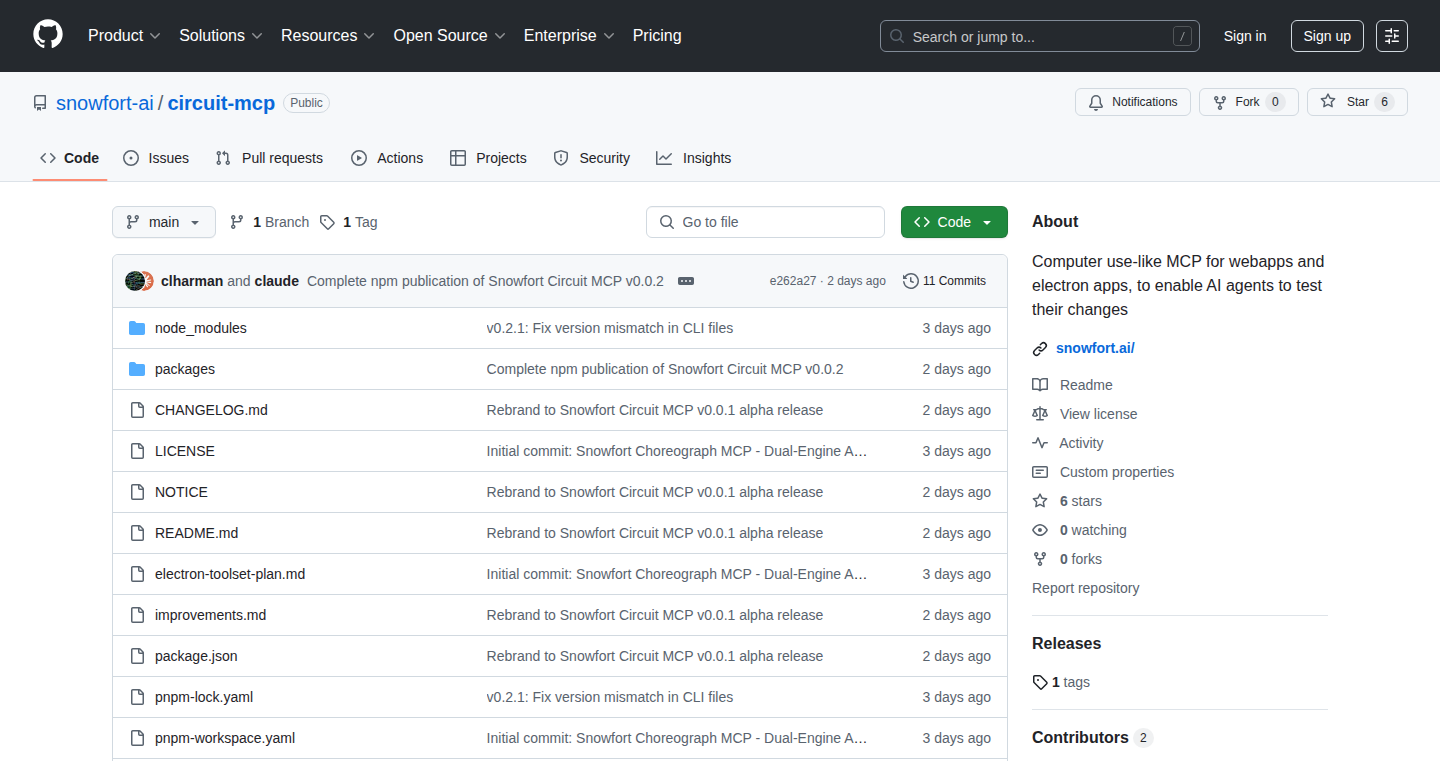
Author
clharman
Description
Circuit MCP is a tool that lets your software agents (like AI assistants) interact with web applications and Electron applications (desktop apps built with web technologies) just like a human user would. The core innovation is to provide a bridge between AI agents and these applications, allowing the agents to test, interact with, and control them automatically. It solves the problem of needing to automate interactions with Electron apps, which previously had limited automation options. So, it's like giving your AI the ability to use a web browser or a desktop app on its own. It achieves this using the Playwright automation library under the hood, making it powerful and versatile for both web and Electron applications.
Popularity
Points 2
Comments 0
What is this product?
Circuit MCP uses the power of browser automation to allow AI agents to navigate and interact with web applications and Electron apps. It leverages the Playwright library, which is like a robot that can control a browser. The project allows you to define a configuration that tells your agent how to launch and control the web/Electron app. The agent can then use this to perform actions like clicking buttons, filling forms, and reading information from the app. The innovation lies in extending this automation capability to Electron applications, which often lack easy automation tools, while also supporting web applications, providing a unified solution.
How to use it?
Developers can integrate Circuit MCP by configuring their AI agent to use it. This involves specifying how to launch the target application (web or Electron). After configuration, your AI agent will have the capability to automate the app's interaction. This is often used for testing purposes, where the agent can automatically perform actions on your web application and then report if there are any issues.
Product Core Function
· Automated interaction with web applications: Circuit MCP allows agents to interact with web apps by using Playwright for automation. This helps to automate the testing process, reducing manual effort and improving efficiency. So, it is very useful for developers who want to automate web app testing and create integration tests that run automatically after each code commit
· Automated interaction with Electron applications: Circuit MCP extends automation capabilities to Electron apps, a space where automation tools have been limited. So, this is a huge win for developers who use Electron to build their desktop applications, as it enables automated testing and quality assurance
· Support for AI agent integration: Circuit MCP is designed to integrate with various AI agents. So, developers can easily incorporate it into their existing workflows to enable agent-driven testing or automation of web and Electron app interaction
· Configuration-driven approach: Developers can configure the tool with a simple setup to automate their applications. So, you don’t need to write complex automation code; the configuration will manage that for you.
Product Usage Case
· Automated testing of web applications: Imagine you have a web application with complex forms and user flows. With Circuit MCP, your AI agent can automatically fill out the forms, submit them, and verify that the correct results are displayed, all without human intervention. So, this is perfect for ensuring that your application works as expected after every code change.
· Automated testing of Electron desktop applications: Consider an Electron app with a complex user interface and multiple features. The agent can automate testing all its functionality. So, you can ensure the app works seamlessly across various desktop environments without having to manually test every feature on different systems.
· Integration with CI/CD pipelines: Circuit MCP can be integrated into your Continuous Integration/Continuous Deployment (CI/CD) pipeline. This means that every time you commit a new version of your application, the tests are automatically run by the AI agent, allowing you to automatically detect bugs or issues and prevent them from reaching production. So, you can ensure the quality of your application and save you a lot of time and effort
53
Git Snapshot Branch Creator

Author
meribold
Description
This project provides a new Git command that lets you create 'snapshot' commits on a branch without actually checking it out. It solves the common problem of needing to capture the current state of a branch for reference or comparison without disrupting your current workflow. It achieves this by cleverly manipulating Git's internal workings, allowing you to snapshot a branch's content in a single command. So, this allows developers to preserve a branch's state quickly without the overhead of switching contexts, which is particularly useful when working with multiple branches simultaneously.
Popularity
Points 2
Comments 0
What is this product?
This is a command-line tool (a new Git command) that creates a snapshot of a Git branch's state as a new commit, *without* you having to switch to that branch. It avoids the need for a full context switch. It works by interacting directly with Git's internal objects. The innovation here is the streamlined way to capture the state of a branch at a specific point in time, making it much quicker and less disruptive than the traditional checkout-and-commit approach. So, it uses clever scripting with Git commands to save time and effort when you need to understand how your project worked at a previous moment.
How to use it?
Developers use this by simply running the new `git snapshot <branch_name>` command in their terminal. This command will create a snapshot commit on the specified branch. After this command, you will be able to see a new commit on your target branch, as a snapshot of its previous state. This makes it very easy to create a frozen copy of a branch for debugging, for reviewing past work, or for easy comparison to the current state of the project.
Product Core Function
· Snapshot creation: The primary function is to create a commit that preserves the exact state of the target branch without you having to switch to it. This is done by creating a commit based on the branch's current state, without the usual switching and checkout steps. It’s useful when you need to quickly capture the state of a branch before making changes, or to create a 'checkpoint' without disrupting your active work.
· Simplified workflow: This tool reduces the number of steps required to snapshot a branch, making the process faster and more efficient. It bypasses the need to check out a branch, commit changes, and then switch back to the original branch. This simplifies complex workflows and saves considerable time for developers who need to frequently switch between branches.
· Easy history tracking: The tool facilitates the creation of snapshots within the Git history. The snapshot commits will appear in the branch history, allowing developers to track changes easily, inspect the state of a branch at specific points, and quickly revert or compare states without much hassle. You can see a record of project states at different moments for easy investigation.
Product Usage Case
· Debugging: When a bug occurs on a specific branch, you can create a snapshot before making any changes. If the bug persists after your changes, you can quickly revert back to the snapshot and examine the project state when the bug occurred, saving debugging time. So, you can easily go back to a working version when things go wrong.
· Feature development comparison: Before merging a feature branch, developers can create a snapshot of the branch, compare it to the current state of the main branch, and review any differences, ensuring that the new features have been thoroughly tested before merging. This process minimizes integration problems.
· Research and experiment: During an experimental development phase, developers can use snapshots to archive the current state of branches prior to testing any modifications. This ensures that they can easily restore the code to its original state. They can also create checkpoints to compare and validate different approaches in parallel.
54
Timezig: Intelligent Timezone Converter for Better Global Meetings
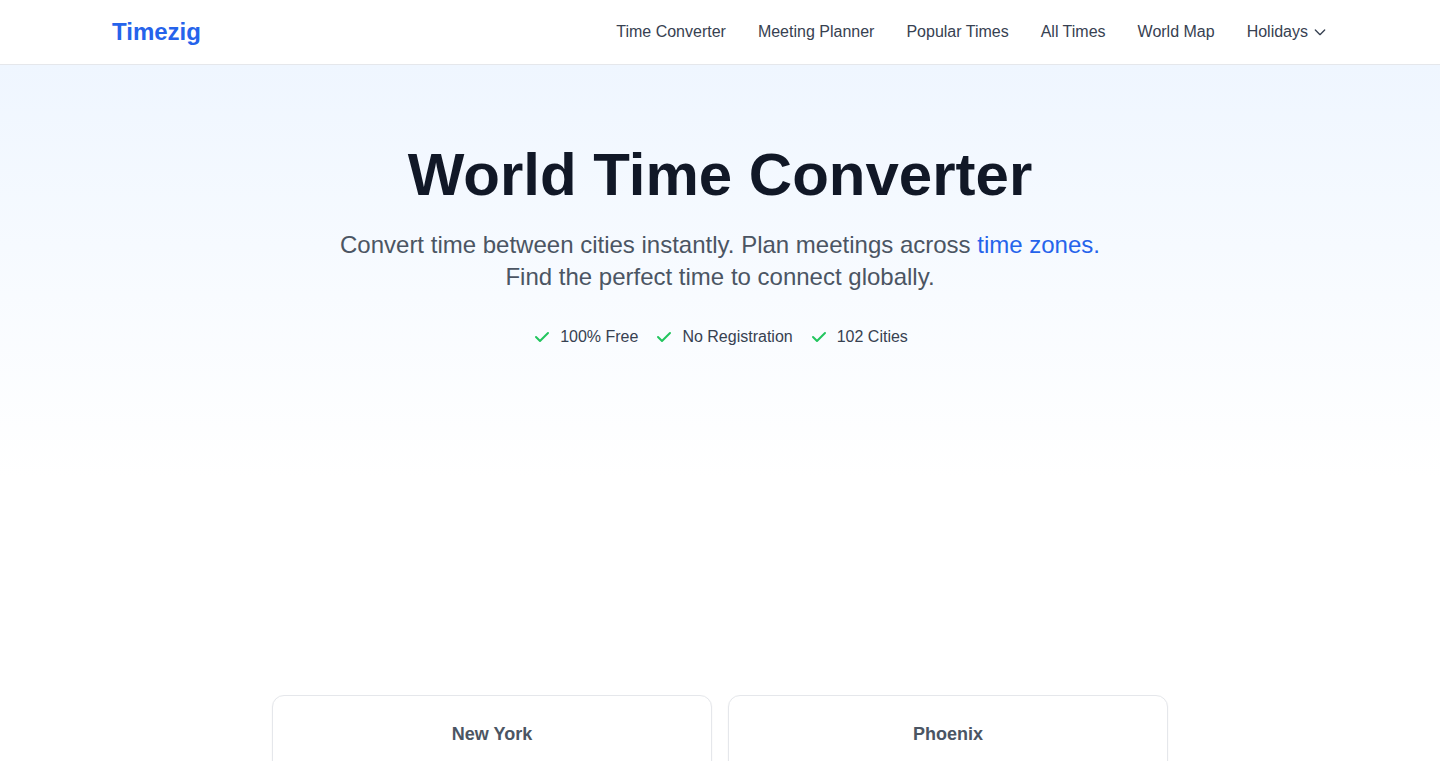
Author
skrid
Description
Timezig is a timezone converter that goes beyond simple time conversions. It intelligently analyzes meeting times across different timezones and provides a 'meeting quality rating' (excellent, good, fair, poor) to indicate how convenient the proposed meeting time is for the other person. It also displays visual cues for day/night, holiday information, and handles complex workweek scenarios. The core innovation is the use of pre-generated static pages for every city combination, ensuring instant loading speeds without the need for backend calculations or a database. This approach highlights a smart way to optimize performance and user experience, focusing on speed and efficiency.
Popularity
Points 2
Comments 0
What is this product?
Timezig is a web-based tool that converts timezones and, more importantly, assesses the quality of a meeting time for participants in different locations. Instead of just showing the equivalent time, it considers factors like whether it's nighttime for one party, if it's a holiday, or if the workweek structure differs. The clever part is how it's built: it uses pre-generated, static web pages for every possible time conversion. This means the website doesn't need to do calculations on the fly, resulting in incredibly fast loading times. So this is about making global collaboration smoother by considering the human element, not just the numbers.
How to use it?
Developers can use Timezig by simply visiting the website. There's no complex integration required. You enter the starting timezone and time, and then select the target timezone. Timezig will show you the converted time and provide the meeting quality rating. This is useful for anyone scheduling meetings with colleagues or clients in different parts of the world. For example, when organizing a project launch with a team in London and San Francisco, you can quickly check the best time to minimize disruption. So this saves you the hassle of figuring out the ideal meeting time and shows you if your choice is considerate of your global team.
Product Core Function
· Timezone Conversion: Converts time between different timezones, a fundamental feature for international collaboration. So this is a must-have for global teams.
· Meeting Quality Ratings: Provides an assessment of the meeting time's suitability for the remote participant, based on day/night status. This helps avoid scheduling meetings during inconvenient hours. So this is a feature to improve the experience for your remote colleagues.
· Holiday Awareness: Displays whether it's a holiday in the target location. This prevents scheduling meetings on public holidays. So this helps avoid meeting on holidays.
· Workweek Handling: Accounts for different workweek structures (e.g., Dubai's Sunday-Thursday) to ensure accurate time calculations. So this avoids time-wasting on meetings.
· Static Page Generation: Employs pre-generated HTML pages for lightning-fast loading speeds, avoiding backend calculations. So this provides a quick user experience.
Product Usage Case
· Project Management: A project manager schedules a critical status update with a team in Japan. Timezig quickly reveals that the proposed time is at 2 AM for the Japanese team, prompting the manager to reschedule for a more suitable time. So this ensures a productive project meeting.
· Sales & Marketing: A sales rep is setting up a demo for a client in Australia. Timezig indicates the best time to reach the client, considering their holiday and working hours. So this helps schedule your sales meeting correctly.
· Software Development: A software development team, with members in both the US and Europe, uses Timezig to find the perfect time for a daily stand-up meeting, ensuring maximum team participation and minimal disruption. So this benefits software development teams.
· Remote Support: An IT support team can leverage Timezig to schedule calls with clients globally, optimizing for the client's local time and avoiding late-night calls. So this improves the experience for global users.
55
AGI-SaaS v1.0.0: A Python RAG Framework for LLM Pipelines
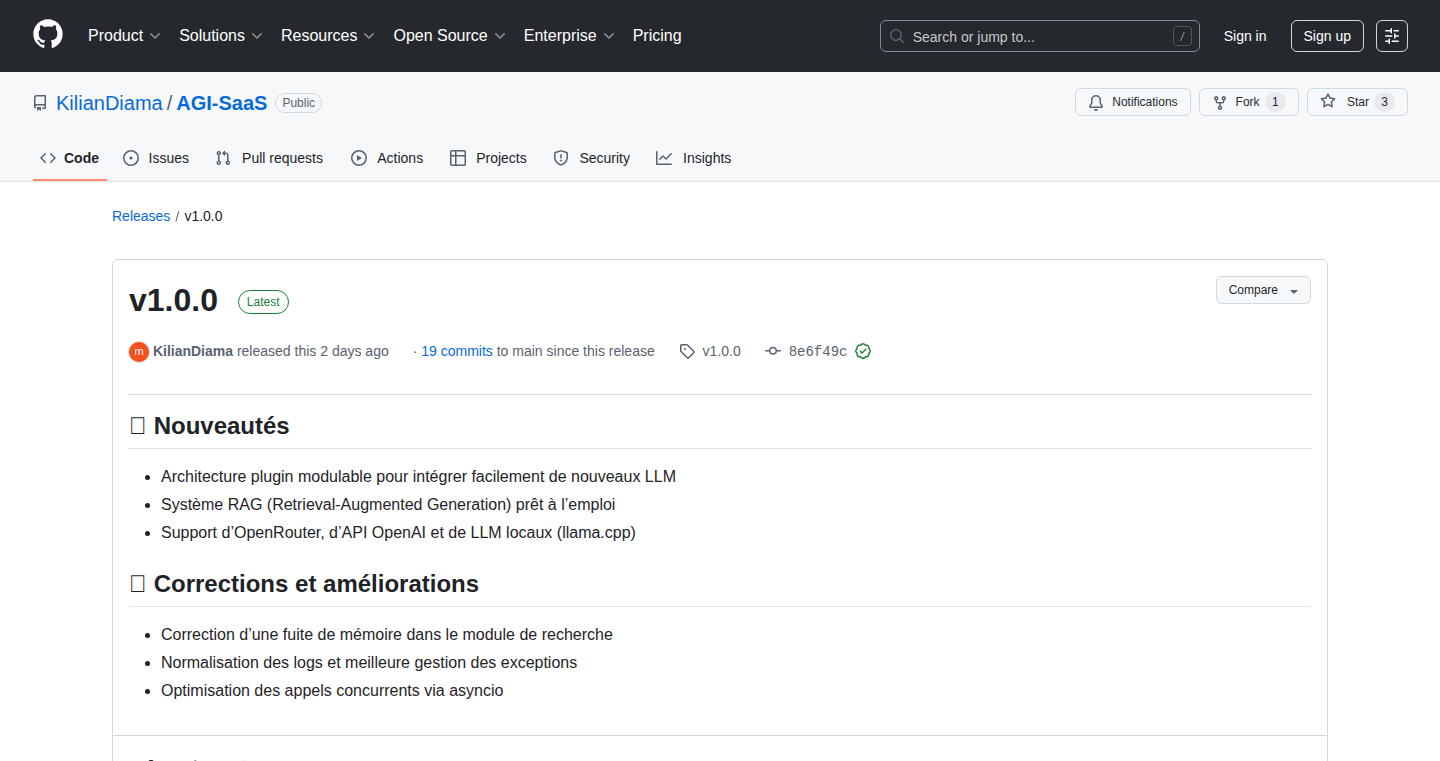
Author
diamajax
Description
AGI-SaaS is an open-source Python framework designed to streamline the creation of Retrieval-Augmented Generation (RAG) pipelines, which essentially means it helps you build smarter AI applications. It focuses on making it easier to combine Large Language Models (LLMs) with your own data. The core innovation is its modular, plug-in based architecture that allows developers to mix and match different components like LLMs, data retrieval methods, and output formats, enabling them to customize AI solutions. It also offers asynchronous, concurrent API calls for faster processing and supports multiple LLM providers (OpenRouter, OpenAI & llama.cpp), providing flexibility in model selection. This addresses the common challenge of building complex and scalable AI applications.
Popularity
Points 1
Comments 0
What is this product?
AGI-SaaS is a toolkit that helps you build applications that use Large Language Models (like GPT-3 or others) with your own data. Think of it as a way to teach an AI to answer questions based on your specific documents or information. It works by first 'retrieving' relevant information from your data, then 'augmenting' the language model with this information to generate a more accurate and relevant answer. It has a plug-in architecture, meaning you can swap out different parts (like the language model itself) easily. The framework also makes things faster by allowing many tasks to run simultaneously. So, this allows developers to efficiently create and customize AI applications that leverage their own data.
How to use it?
Developers install AGI-SaaS using pip (pip install agi-saas==1.0.0) and then use Python code to build their RAG pipelines. You define your data sources (like documents or databases), choose an LLM provider (OpenAI, etc.), and configure the framework to retrieve relevant information. Then, when a user asks a question, AGI-SaaS fetches information from your data, uses the LLM to generate an answer based on that information, and returns the answer. This is most useful if you want to create a custom chatbot for your company, a search engine specific to your internal documents, or any application that needs to answer questions based on a specific body of knowledge.
Product Core Function
· Modular, Plugin-based Architecture: AGI-SaaS allows you to swap different components of the RAG pipeline easily, like the model or the data retrieval method. This gives developers flexibility to customize their AI applications to fit specific needs. So this gives developers the ability to quickly adapt the framework to different use cases and experiment with different technologies, speeding up development and innovation.
· Asynchronous, Concurrent API calls: This means that AGI-SaaS can handle multiple requests at once, making it much faster and more efficient, especially when working with large datasets or complex queries. This helps developers optimize the application's performance and improve user experience.
· Support for Multiple LLM Providers: AGI-SaaS supports multiple LLM providers (OpenRouter, OpenAI & llama.cpp). This allows developers to choose the most suitable model for their needs, considering factors like cost, performance, and desired features. So developers are not locked into a single provider, allowing them to experiment and potentially reduce costs.
· Retrieval-Augmented Generation (RAG) Pipelines: It helps users to build RAG pipelines. This technique allows LLMs to combine external data with the internal knowledge, resulting in improved accuracy and relevance for the model's responses. This means that developers can create AI applications that produce answers based on up-to-date information, not just the knowledge learned during its training.
· Open-Source: As an open-source framework, developers have access to the underlying code, allowing them to inspect, customize and contribute to the project. This fosters a collaborative environment, where developers can learn from each other and improve the framework together.
Product Usage Case
· Building a Custom Chatbot for Customer Support: A company could use AGI-SaaS to build a chatbot that can answer customer questions based on its internal knowledge base (product documentation, FAQs, etc.). The RAG pipeline ensures the chatbot has access to the most current information, and the modular design allows for easy customization. So this allows companies to automate customer support and improve responsiveness.
· Creating a Search Engine for Internal Documents: A business could use AGI-SaaS to build a search engine that can quickly and accurately find information within its vast collection of documents. By augmenting the LLM with the document content, users can ask complex questions and get precise answers. So this improves knowledge management and information retrieval within the organization.
· Developing a Research Assistant: Researchers could use AGI-SaaS to create a tool that can quickly find and summarize relevant research papers and other academic sources. The system could retrieve information from a database of research papers, use the LLM to synthesize the information, and provide concise summaries. This makes the research process much faster.
· Enhancing Knowledge Management Systems: Integrate AGI-SaaS into existing knowledge bases to provide more advanced search and question-answering capabilities. Users can get instant answers to complex queries by leveraging the power of LLMs and their own data. So this leads to more efficient knowledge retrieval.
56
Happiness Navigator: A Personalized Well-being Platform

Author
chbkall
Description
This project, created by chbkall, is a platform designed to facilitate support groups for adults seeking happiness. It leverages principles of positive psychology and community building to create a space for individuals to share experiences, offer support, and learn from each other. The core innovation lies in the emphasis on peer-to-peer support, providing a digital infrastructure for fostering genuine human connection in the pursuit of well-being. So, this helps people connect and find community to improve their happiness.
Popularity
Points 1
Comments 0
What is this product?
Happiness Navigator is a digital community built around helping people achieve greater happiness. It uses a simple, structured approach, likely involving forums or discussion boards, where users can share their struggles and successes. It's innovative because it focuses on the power of human connection and peer support, offering a low-tech, accessible platform to foster a sense of community and mutual encouragement. This is different from many other apps that might focus on tracking metrics or offering personalized advice. So, it's a simple way to build a community around helping each other be happy.
How to use it?
Developers would use this platform to build a community around a specific topic, potentially creating their own support groups. They could integrate the platform into their own websites or apps as a forum for users to discuss their experiences. The platform could be customized for specific niches, providing a framework for people to find support based on shared interests or goals. So, if you want to help people connect, this provides a blueprint to get them talking.
Product Core Function
· Forum for discussions: Allows users to create and participate in discussions, sharing their experiences and offering support. This fosters peer-to-peer interaction and facilitates a sense of community. So, it enables users to share and receive support.
· User Profile System: Provides user profiles to enable users to share their story and connect with others who have common interests. This personalizes the experience and helps users to find each other. So, it helps users find like-minded individuals.
· Moderation and Community Guidelines: Ensures a safe and supportive environment by enforcing community guidelines and providing moderation tools. This is important for creating a positive user experience. So, it helps to keep the community safe and friendly.
· Notifications and Activity Feed: Keeps users informed about new posts, comments, and activity within the community. This increases user engagement and helps them stay connected. So, it makes sure that people stay connected.
Product Usage Case
· A wellness coach could use Happiness Navigator to host online support groups for their clients, providing a space for sharing experiences and building community. So, coaches could improve their clients experience.
· A mental health advocate could create a public forum for discussions related to mental well-being, offering a platform for individuals to connect and share their stories. So, it provides a forum for public mental health discussion.
· A developer could integrate the platform into their own application to enable a support group for their users. So, developers can add a community feature to their app.
57
VidVeo3: AI-Powered Video Genesis
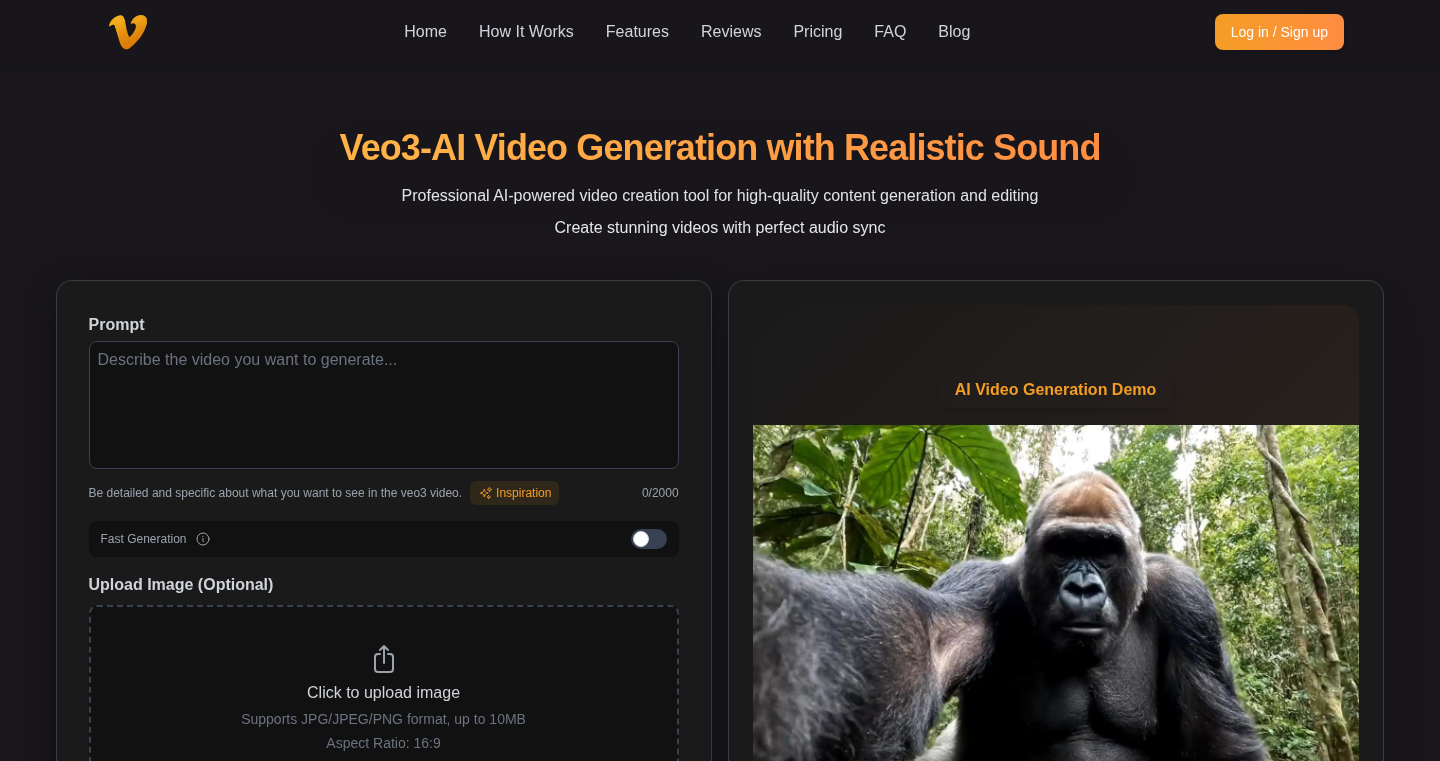
Author
Viaya
Description
VidVeo3 is an AI tool that generates videos from text prompts. Think of it like giving the computer a detailed description of a scene, and it creates a high-resolution video for you. The innovation lies in its ability to not only generate visuals but also include realistic audio, such as background sounds, special effects, and even character dialogue, all seamlessly integrated. This solves the problem of needing to source and combine different media components to produce a compelling video.
Popularity
Points 1
Comments 0
What is this product?
VidVeo3 leverages Google's Veo 3 model, a cutting-edge AI capable of generating high-quality videos from text descriptions. The core technology involves natural language processing to understand the prompt, visual generation using complex algorithms, and audio synthesis to create matching soundscapes. So what? It's like having a personal video production studio that can realize your creative ideas quickly.
How to use it?
Developers and content creators can use VidVeo3 by simply typing in a description of the desired video. For example, 'a futuristic cityscape with flying cars' or 'a cat playing with a ball of yarn.' The tool then generates the video, which can be integrated into various projects, from marketing content to personal projects. You get the video, then you can use the APIs of this platform, or you can embed the code directly into your website. So what? It simplifies and accelerates the video creation process, allowing developers to focus on the creative aspects rather than the technical ones.
Product Core Function
· Text-to-Video Generation: Takes a text prompt and creates a corresponding video. Technical Value: This is the core functionality, transforming textual descriptions into visual media. Application: Generate promotional videos, create animated explainer videos, or bring stories to life.
· AI-Powered Audio Synthesis: Generates realistic audio, including background sounds, effects, and dialogue. Technical Value: Enhances the video experience with immersive audio. Application: Adds professional-quality sound to any video, saving time and effort on audio editing.
· High-Resolution Video Output: Produces videos in high resolution. Technical Value: Ensures visual quality suitable for various platforms and purposes. Application: Creates videos for professional use and marketing purposes.
· Seamless Audio-Visual Integration: Ensures the video and audio elements are perfectly synchronized. Technical Value: Provides a polished, professional-looking end product. Application: Builds high-quality content that looks and sounds great across different platforms.
Product Usage Case
· Marketing Campaigns: A marketing team uses VidVeo3 to create short, engaging videos based on product descriptions, generating promotional content quickly and efficiently. So what? Saves time and resources by automating video production.
· Educational Content: An educator uses VidVeo3 to generate visual explanations of complex concepts, creating engaging educational videos with accompanying sound. So what? Enhances learning through visual storytelling and professional-quality content.
· Game Development: A game developer uses VidVeo3 to quickly prototype game cinematics or create environmental videos, saving time and effort compared to traditional methods. So what? Allows game developers to focus on the core gameplay and mechanics rather than video creation.
58
RepoInsightAI - LLM-Powered Repository Explorer
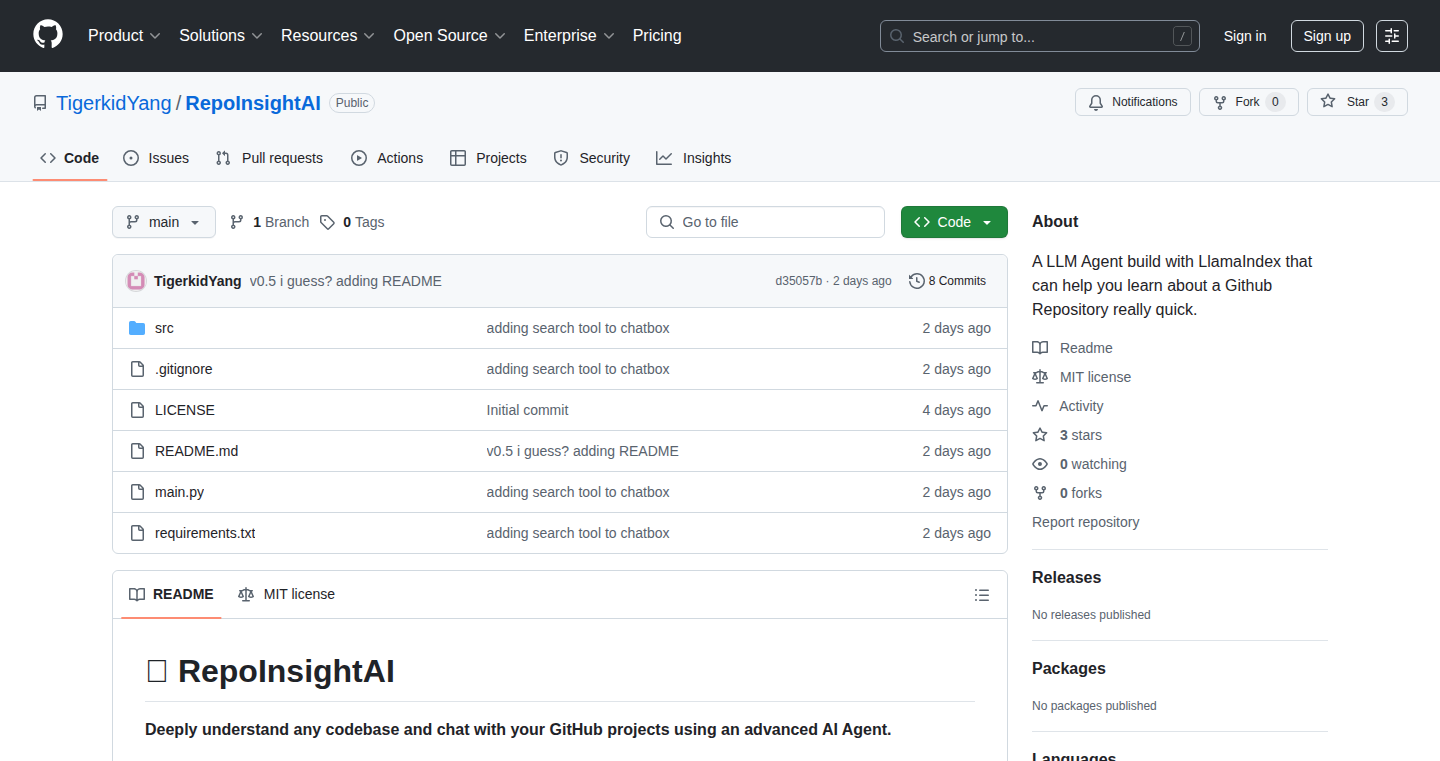
Author
tigerkid
Description
RepoInsightAI is a project leveraging Large Language Models (LLMs) to understand and summarize GitHub repositories. It helps developers quickly grasp the essence of a codebase by answering questions about its functionality, architecture, and usage. The core innovation lies in its ability to automatically analyze code, documentation, and commit history to generate insightful summaries, offering a faster and more intuitive way to explore unfamiliar projects. It tackles the problem of quickly understanding large and complex codebases, reducing the time developers spend on initial project familiarization.
Popularity
Points 1
Comments 0
What is this product?
RepoInsightAI uses LLMs to become a smart assistant for understanding Git repositories. Imagine asking a question like 'What is the main function of this module?' and getting a concise, AI-generated answer based on the repository's code and documentation. This works by feeding the LLM with relevant parts of the repository like code files, README files, and commit messages. The LLM then processes this information and tries to give you useful answers. This is innovative because it automates the time-consuming process of manual code analysis, providing a more efficient way to learn about a project. So, this allows you to understand a project quicker.
How to use it?
Developers can use RepoInsightAI by providing the URL of a GitHub repository. They can then ask questions about the code, functionality, or design choices. The tool will analyze the repository and provide answers based on the information it finds. This can be integrated into a developer's workflow to speed up understanding unfamiliar projects. This also can be used by developers new to a project by getting familiar with the code structure. So, you can quickly get up to speed on a new project.
Product Core Function
· Repository Summarization: Automatically generates summaries of a repository's purpose, architecture, and key features. This helps you quickly get an overview of a project. So, you can understand a project's goals faster.
· Code Understanding: Answers questions about specific code files, functions, and modules. This streamlines the process of understanding how the code works. So, you can quickly understand how different parts of the code function.
· Documentation Analysis: Analyzes README files, documentation, and comments to extract key information about usage and design. This makes learning the intended use of the code base easier. So, you can understand how to use the project and what it is for.
· Commit History Insight: Provides insights into the evolution of the codebase, including the rationale behind changes and the developers' decisions. This helps you get context around development. So, you get a better understanding of why certain code was written a certain way.
· Question Answering: Answers natural language questions about the repository. This provides an intuitive way to explore a project's structure and functionality. So, you can ask questions and get answers quickly and simply.
Product Usage Case
· Onboarding New Developers: A new developer joins a project and uses RepoInsightAI to quickly understand the project's architecture, key components, and how to get started. This reduces the time it takes to become productive. So, you can skip hours of reading and go straight to coding.
· Code Review Assistance: During a code review, a developer uses RepoInsightAI to understand the purpose of a particular function or module, and the context of the change. This helps them make better decisions about the code. So, you have all the information you need at your fingertips.
· Project Research: A developer is researching a new technology or framework and uses RepoInsightAI to understand how a specific project is built and what it can do. This helps them make the correct decisions of technologies to implement. So, you save hours of research.
· Troubleshooting: When encountering an issue, a developer uses RepoInsightAI to understand how a particular part of the code works and identify potential causes of the problem. This helps them narrow down the cause faster. So, you'll be able to quickly fix it.
59
Imaginary Unit 'i' Unveiled: A Mathematical Proof Explorer
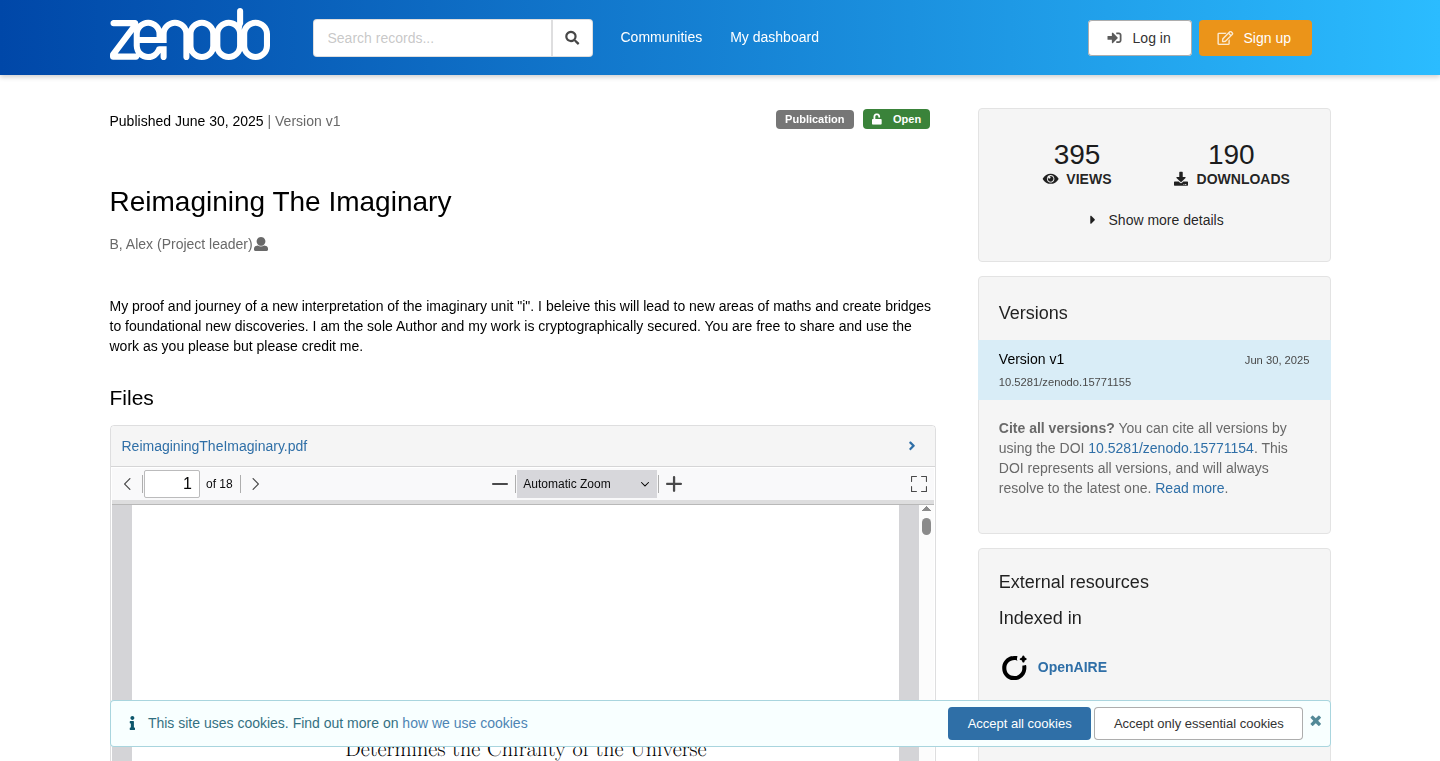
Author
purrplexia
Description
This project presents a rigorous, mathematically sound proof demonstrating that the imaginary unit 'i' (used in complex numbers) isn't just some abstract concept, but rather a real and continuous form of definite integration. This proof is cryptographically signed for authenticity, ensuring its integrity and reliability. It tackles the perplexing behavior of 'i' and its role in Euler's identity, providing a deeper understanding of its underlying nature.
Popularity
Points 1
Comments 0
What is this product?
This project is a mathematical proof. It uses advanced math to show that 'i', the imaginary unit, is actually a form of continuous integration. The innovation lies in providing a solid mathematical foundation for a concept that often feels abstract. So, what does it do? It provides a new way to think about and understand complex numbers, especially for mathematicians, physicists, and anyone working with complex analysis. The core of the project is a complete mathematical proof signed with PGP (Pretty Good Privacy), guaranteeing the integrity of the findings.
How to use it?
This project is intended for people with a strong math background, like academics, researchers, and engineers. They would read the proof, analyze its methodology, and possibly apply the findings to their own research. For instance, if you're working on signal processing, understanding the underlying reality of 'i' could help you better model and simulate real-world signals. It’s used by downloading the cryptographically signed proof (likely as a PDF or similar format) and reviewing the mathematical arguments.
Product Core Function
· Rigorous Mathematical Proof: This is the heart of the project. It offers a mathematically sound explanation of 'i's behavior, dispelling any perceived ambiguity.
· Authenticity Verification: The proof is cryptographically signed using PGP, which confirms that the proof has not been tampered with. This is important for researchers to trust the project’s result.
· Deep Dive into Complex Numbers: The proof helps to bridge the gap between the abstract and the real for complex numbers, leading to a deeper understanding of the mathematical principles behind them.
· Euler's Identity Validation: It validates the behavior of Euler's identity, a fundamental formula in mathematics that connects imaginary numbers, trigonometric functions, and exponential functions. This supports the reliability of existing mathematic principle.
Product Usage Case
· Theoretical Physics: Physicists can benefit from a deeper understanding of how 'i' works to refine models in quantum mechanics or other theoretical fields, which rely heavily on complex number analysis.
· Signal Processing: Engineers can utilize the insights to create more accurate and efficient signal processing algorithms, as complex numbers are key in this area.
· Control Systems: In the field of control systems, a clear understanding of 'i' could aid in the design and analysis of dynamic systems, allowing to better understand their behavior.
· Cryptography Research: The mathematical principles in the proof can inform the development of new encryption methods or analyses of existing cryptographic systems that use complex numbers.
60
Recruiter Radar: An AI-Powered Resume Highlighter

Author
lebonnnn
Description
This project uses Natural Language Processing (NLP) to identify keywords and phrases in your resume that recruiters often look for, highlighting them to increase visibility. It addresses the common problem of resumes getting overlooked by automatically pinpointing relevant information, making it easier for recruiters to quickly assess your skills and experience.
Popularity
Points 1
Comments 0
What is this product?
It's a tool that analyzes your resume using AI. It scans the text and identifies key skills, experiences, and qualifications that recruiters commonly seek. The tool then highlights these important pieces of information. So the innovative part is its ability to automatically tailor the resume to what recruiters want to see, saving you time and increasing your chances of being noticed.
How to use it?
Developers can use this by uploading their resume text or pasting it into the tool. The tool analyzes it and provides a visual representation of the highlighted keywords. Developers can then review these highlighted sections to ensure they are accurately reflecting their qualifications and expertise. This information can then be used to tailor their resumes for better matches. So you can use it to optimize your resume before applying for jobs, making your qualifications stand out.
Product Core Function
· Keyword Extraction: The tool utilizes NLP techniques to identify and extract relevant keywords from the resume. This is valuable because it allows the tool to quickly identify skills and qualifications most likely to be searched for by recruiters. It creates a focused view of the most important aspects of your experience. So it helps you understand what aspects of your resume are most important to hiring managers.
· Phrase Recognition: It recognizes common phrases related to experience, skills, and education. This ensures that even more complex qualifications are accurately identified. This is valuable as it provides a more comprehensive analysis of the resume by recognizing how different phrases might be related to each other. So it can pick up subtle cues in your language that match the job descriptions better.
· Highlighting Engine: This function visually highlights the extracted keywords and phrases within the resume text. This feature offers instant visual feedback on how well the resume aligns with recruiter preferences. It's valuable as it makes it super easy for developers to see exactly what parts of their resume are the most relevant and could improve readability for recruiters. So it helps you instantly see the parts of your resume that recruiters are most likely to pay attention to.
· Recruiter Keyword Database: The tool likely incorporates a database of keywords commonly used by recruiters in various industries. This enables tailored analysis specific to the job market. This is important because it helps tailor analysis to ensure that it is accurately reflects industry trends and preferences. So it helps make your resume relevant for more jobs by using data related to the specific job you are applying for.
Product Usage Case
· Software Engineer Application: A software engineer updates their resume and uses the tool. The tool highlights important programming languages, frameworks, and project descriptions related to their roles. They then adjust their resume to emphasize these points, increasing their chances of being selected for an interview. This highlights how the tool can specifically help professionals tailor their resume to match requirements in specific industries.
· Data Scientist Resume Review: A data scientist uploads their resume to the tool. The tool identifies and highlights relevant skills such as statistical modeling, machine learning algorithms, and data visualization tools. The data scientist then edits their resume to prominently feature these highlighted keywords and phrases, improving their relevance to job postings. This shows how the tool is useful for creating a resume targeted towards a specific role.
61
Brabus Recon Suite (BRS) - The Offline Infrastructure Reconnaissance Toolkit
Author
easyprotech
Description
Brabus Recon Suite (BRS) is a command-line interface (CLI) toolkit for discovering and auditing the security of computer infrastructure. The innovation lies in its modular design and reliance on existing, well-established security tools like Nmap, Hydra, and SQLMap, all packaged within a Bash environment. This means it works offline, without needing to download additional software packages like Node.js or Python, offering a lean and efficient solution. It's also multilingual, logs results, and prioritizes user privacy. So this is useful for anyone who needs a quick, reliable way to assess their network's security.
Popularity
Points 1
Comments 0
What is this product?
BRS is a collection of pre-configured security tools accessible through a command line. It automates common reconnaissance tasks, helping users identify vulnerabilities in their systems. It utilizes existing tools such as Nmap (for port scanning), Hydra (for password cracking), and SQLMap (for SQL injection testing). The primary innovation is its simple, modular structure built on Bash, making it easy to use, customize, and deploy without complex dependencies. So, this provides a focused and efficient way to perform security audits without relying on heavy, often cloud-based, scanning solutions.
How to use it?
Developers use BRS by running commands in their terminal. They specify the target system (IP address or domain) and the type of scan they want to perform. For example, a developer could use a command to initiate a port scan with Nmap. The results are then logged and presented in a user-friendly format. You can integrate it into existing scripts to automate security checks. So, this makes it easy to quickly assess the security posture of a system, allowing for immediate response to detected vulnerabilities.
Product Core Function
· Network Scanning: Uses tools like Nmap to identify open ports and services on a target system. This helps uncover potential entry points for attackers. So, this helps identify vulnerabilities by mapping out the network's attack surface.
· Vulnerability Scanning: Integrates with tools like Nikto to scan for known vulnerabilities. So, this alerts you to known security flaws.
· Password Cracking: Employs tools like Hydra to attempt to crack passwords. This helps identify weak password policies. So, this strengthens security by finding weak passwords.
· SQL Injection Testing: Leverages tools like SQLMap to test for SQL injection vulnerabilities in web applications. This helps prevent data breaches. So, this is important for protecting sensitive user data from unauthorized access.
Product Usage Case
· Penetration Testing: A security consultant uses BRS to perform a penetration test on a client's network. They use the various tools within BRS to identify vulnerabilities and demonstrate the potential impact of a security breach. So, this allows the consultant to provide comprehensive security assessments.
· System Administration: A system administrator regularly uses BRS to scan their servers and network infrastructure for vulnerabilities. This proactive approach helps them identify and fix security issues before they can be exploited. So, this provides peace of mind by ensuring the systems are up-to-date with the latest security patches and configurations.
· Red Teaming Exercise: A red team uses BRS to simulate a cyberattack on an organization's network. They use the toolkit to gather information, identify vulnerabilities, and attempt to gain access to sensitive data. So, this helps the organization understand its security weaknesses and improve its defenses.
62
Twins Finder: Face Similarity Engine
Author
denis_kramar
Description
Twins Finder is an Android app that uses face recognition to find the most similar-looking people in a group photo. It leverages PerchEye's face comparison technology to identify potential twins or people with similar facial features. The innovation lies in its ability to automate the process of comparing faces, a task that would be incredibly time-consuming if done manually. This addresses the problem of quickly identifying people who look alike in a sea of faces, offering a practical solution for anyone sorting through photos or curious about facial similarities.
Popularity
Points 1
Comments 0
What is this product?
Twins Finder utilizes a face recognition system (powered by PerchEye) to analyze images. It works by extracting key features from each face in a photo and then comparing these features to determine the similarity between faces. The core innovation is its automated face comparison engine, enabling efficient identification of individuals with similar facial characteristics. So this app takes pictures and intelligently looks for people who look like each other.
How to use it?
Developers can integrate similar face recognition technology into their apps by using face comparison APIs or SDKs (Software Development Kits). The Twins Finder app provides a ready-to-use solution on Android. You take a picture, and the app automatically identifies similar faces within that picture. Developers can leverage similar tech to build apps for finding look-alikes, matching faces for security purposes, or creating photo organization tools. So you can quickly and easily find people who look alike in your photos.
Product Core Function
· Face Detection: The core function is to identify and locate faces within a given image. This is essential for the subsequent comparison process. This is useful because the app can automatically isolate each face from the background clutter.
· Facial Feature Extraction: The app extracts key features from each face, creating a 'fingerprint' of sorts for each individual. This involves analyzing things like the distance between eyes, the shape of the nose, etc. This is valuable because it provides a reliable method to compare facial features.
· Face Similarity Comparison: The app compares the extracted facial features of different individuals, assigning a similarity score. This score reflects how alike two faces are. This is useful because the app can intelligently group faces based on similarity scores, making it easy to identify potential twins or similar-looking people.
· User Interface for Results Display: The app presents the identified similar faces to the user in a clear and intuitive manner, allowing easy visualization of the results. This is valuable because it simplifies the understanding of the information the app extracts and gives the user an immediate understanding of results.
Product Usage Case
· Social Media Apps: A social media platform could integrate face recognition to automatically suggest people to tag in photos, based on facial similarity. This would make the tagging process faster and more accurate. This provides users a more streamlined experience when organizing their images.
· Photo Organization Tools: A photo organizing application could use face recognition to automatically group photos of the same person or people who look alike, helping users to organize their photo libraries more efficiently. This is useful because it saves time and helps users categorize their pictures automatically.
· Security Applications: Face recognition could be used to identify individuals at entrances or to verify the identities of users for security purposes. This ensures accurate identity checks.
· Genealogy Research: Researchers could use this kind of technology to analyze family photos for resemblances. This can significantly assist in identifying relationships.
· Entertainment and Fun: Create apps where users can find their celebrity look-alikes, increasing user engagement.
63
Made for Teams: A Lightweight Async Planning Tool
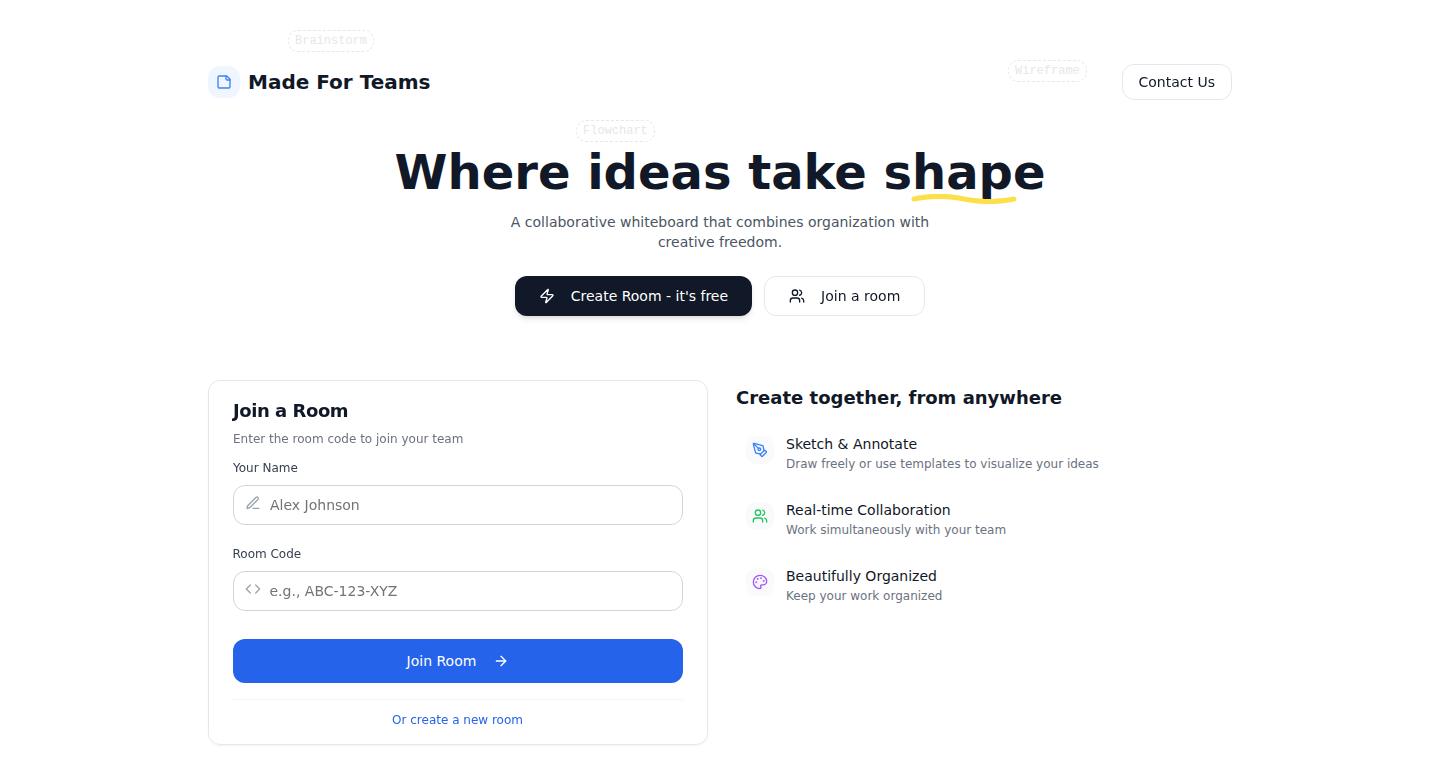
Author
eveuroy
Description
This project introduces a simplified asynchronous planning tool designed for teams. It focuses on facilitating daily updates and task tracking without the complexity of traditional project management software. The core innovation lies in its lightweight approach, leveraging a minimal feature set to encourage frequent, easy-to-digest updates, solving the problem of information overload and inefficient communication in remote or distributed teams. So this is useful for streamlining communication and planning, even for small teams.
Popularity
Points 1
Comments 0
What is this product?
Made for Teams is a web application that allows team members to provide daily updates and plan their work asynchronously. Instead of lengthy meetings or complex project dashboards, it focuses on simplicity. It enables quick check-ins and provides a clear overview of what each team member is working on. The innovative aspect is its emphasis on asynchronous communication and minimalist design, minimizing distractions and promoting focused work. So it helps in keeping the team aligned without requiring constant real-time interaction.
How to use it?
Developers can use Made for Teams by simply signing up and inviting their team members. Each member can then submit daily updates, outlining their accomplishments, plans for the day, and any blockers they are facing. The tool aggregates these updates into a digestible format, providing a quick overview of the team's progress. Integration is straightforward; it doesn’t require any complex setup and can be quickly adopted by teams of any size. So you can start using it quickly to improve team communication.
Product Core Function
· Daily Updates: Allows team members to post daily updates. This feature replaces status meetings and keeps everyone informed of progress and roadblocks. The value lies in its ability to reduce the need for synchronous meetings and promotes more focused work. So, you can stay in the loop without disrupting your workflow.
· Task Tracking: Enables tracking individual tasks and their statuses. This gives a clear picture of what each member is working on, facilitating better task management and coordination. The value is in better project management. So, it helps you understand the project status.
· Asynchronous Communication: Focuses on asynchronous communication. This design choice is very important for remote teams because it facilitates constant communication without interrupting individual focus. This is particularly useful for distributed teams with different time zones. So, this helps with time management by allowing communication without constant presence.
· Lightweight Design: It is designed with a minimal feature set, avoiding unnecessary complexity. This simplifies user adoption and reduces information overload. The value is in providing an easy-to-use system that is easy to adopt and use regularly. So, it allows for quick adoption and user-friendly experience.
· Progress Overview: The tool provides a combined view of team progress, enabling quick assessment of project statuses. The value here is in enabling quick insights into project statuses. So, it gives a good overview of project statuses without a long meeting.
Product Usage Case
· Remote Development Teams: A distributed software development team can use Made for Teams to share daily progress updates and identify and resolve issues in real-time without interrupting their work schedules. So, the tool facilitates easy collaboration and information flow.
· Startup Project Management: A small startup can use this tool for quick task tracking and communication without the need for complex project management tools, saving time and effort on administrative overhead. So it allows effective team communication.
· Freelancer Collaboration: Freelancers working on a shared project can use the tool to share updates and track progress, promoting project transparency and coordination, helping prevent miscommunication. So, the project helps with collaborative work.
· Personal Project Tracking: Developers working on personal projects can use the tool to track their own progress, goals, and the issues they are encountering. So, it helps track project goals.
64
ArabiziFlip: Instant Arabic-to-Arabizi Converter Chrome Extension
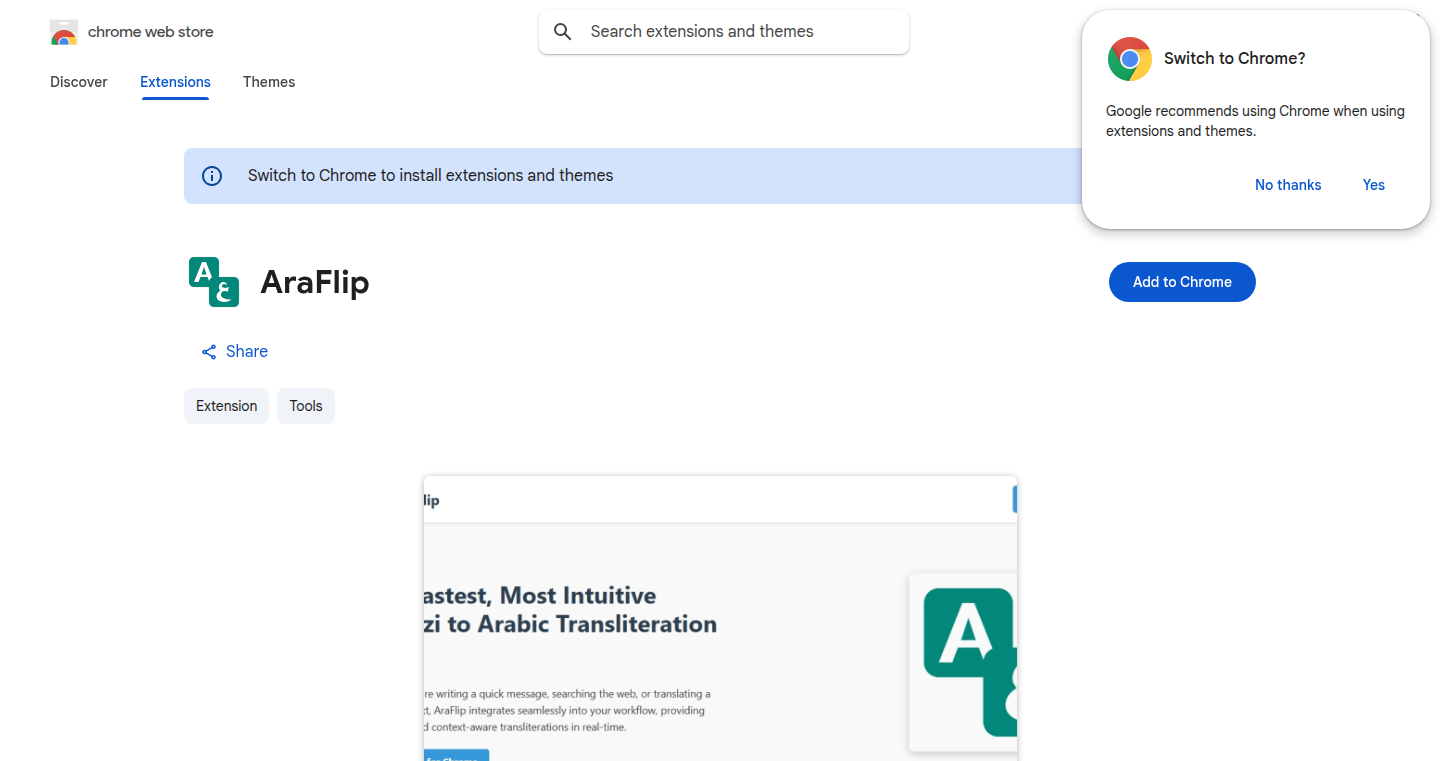
Author
DSpider
Description
This Chrome extension instantly converts Arabic script (the formal written Arabic) into Arabizi (the informal Romanized Arabic, often used in chat and social media). It tackles the problem of communication barriers for Arabic speakers who prefer or are more comfortable with Arabizi, enabling seamless text exchange across different platforms. The core innovation lies in its real-time, on-the-fly conversion directly within the browser.
Popularity
Points 1
Comments 0
What is this product?
ArabiziFlip is a browser extension that automatically transforms Arabic text into its Romanized (Arabizi) equivalent. Think of it as a live translator, but specifically for the Arabic language and its informal transcription. It uses an algorithm to map Arabic characters to their Roman alphabet counterparts, allowing you to read and write Arabic in a familiar way, even if you're not fluent in the Arabic script. So this is useful if you want to easily understand Arabic text in a more accessible format.
How to use it?
Install the Chrome extension and it will automatically detect and convert Arabic text on any webpage you visit. No need to copy, paste, or click any buttons. It works seamlessly within the context of your browser. For example, if you are browsing a website with Arabic content, the extension will convert the text on the fly. This is useful for anyone who frequently reads Arabic content online, such as social media, news articles, or forums.
Product Core Function
· Real-time Conversion: The core function is the immediate conversion of Arabic text to Arabizi as you browse. This means no manual input or delays; the transformation happens automatically. This is valuable because it provides instant readability, reducing the friction of switching between scripts and improving the user experience for those comfortable with Arabizi.
· Browser Integration: The extension integrates directly into your Chrome browser, making the conversion process completely transparent. This is useful because it simplifies the user workflow, making the conversion process feel natural and effortless, and providing convenience for users who regularly use Arabic content.
· Automatic Detection: The extension automatically identifies Arabic text on any webpage. This eliminates the need to select text or activate a tool manually. This is useful because it saves time and effort, allowing users to focus on reading and understanding content without additional interaction.
· Unicode Handling: The extension probably handles various Arabic characters and diacritics correctly, ensuring accurate and reliable conversion. This is useful because it guarantees the fidelity of the conversion, maintaining the meaning and nuance of the Arabic text.
Product Usage Case
· Social Media: Users can effortlessly read and engage with Arabic content on platforms like Facebook, Twitter, and Instagram. This is useful because it breaks down language barriers, allowing Arabizi speakers to easily interact with posts and comments written in Arabic.
· News Websites: Readers can quickly understand Arabic news articles and online publications. This is useful because it makes news accessible to those more familiar with Arabizi, expanding their access to information.
· Online Forums: Individuals can easily participate in discussions and threads in Arabic-speaking forums. This is useful because it facilitates communication, enabling users to express themselves and engage with the community in their preferred format.
· Educational Resources: Students learning Arabic can use the extension to quickly decipher texts and improve their comprehension. This is useful because it aids in language acquisition, making learning materials more approachable and helping learners connect with the material.
65
Pinky Lang: A WebAssembly Compiler Playground
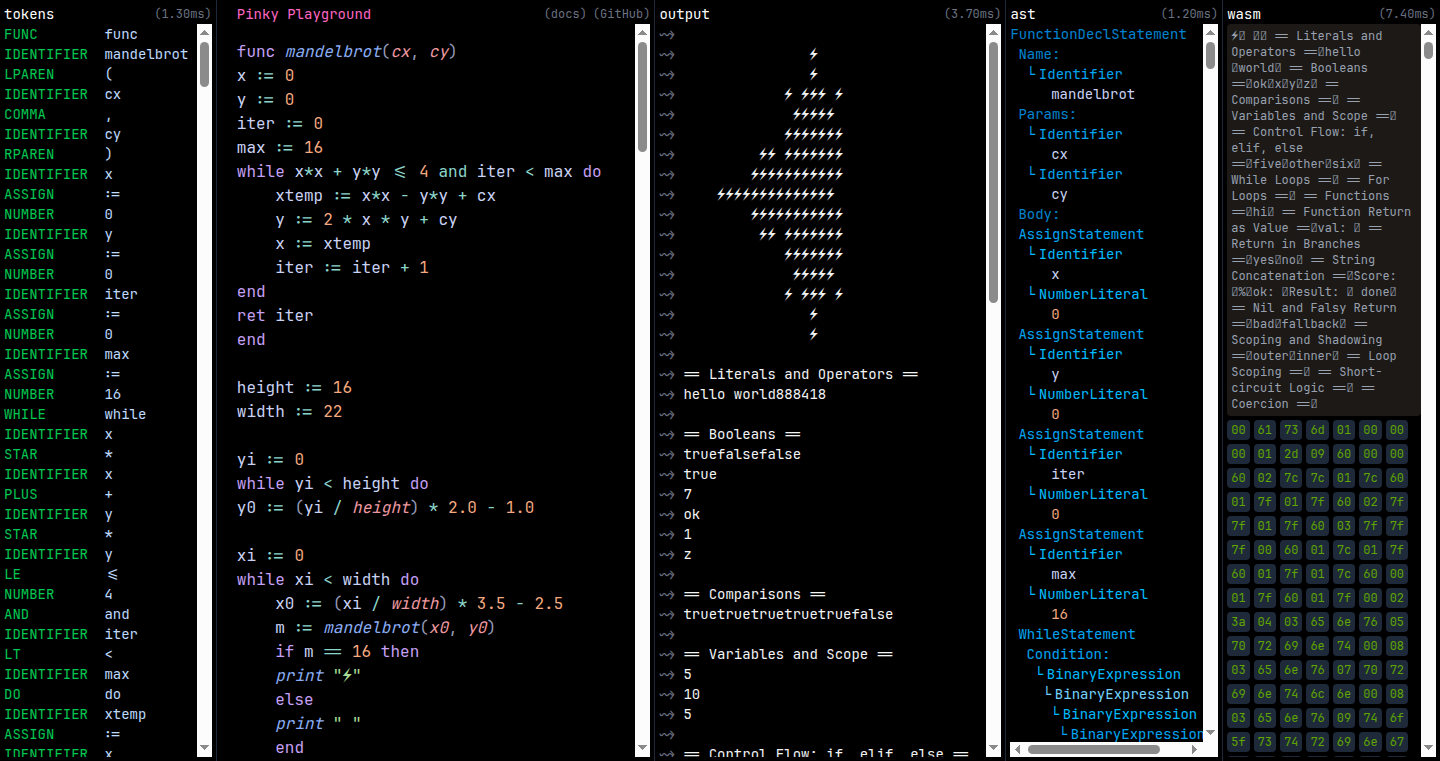
Author
kbatdorf
Description
Pinky Lang is a compiler for a scripting language called Pinky. It takes your Pinky code, translates it into WebAssembly (WASM) – a low-level code format that runs very fast in web browsers and other environments. It's built using TypeScript and includes a playground where you can see the different stages of compilation: tokenization (breaking code into parts), abstract syntax tree (AST – the code's structure), bytecode (the WASM instructions), and the final output. So, it teaches you how compilers work and allows you to experiment with WASM. The core innovative aspect is its ability to generate WASM bytecode, a key technology behind fast web applications, directly from Pinky code.
Popularity
Points 1
Comments 0
What is this product?
This is a compiler, think of it like a translator, but for code. It takes code written in Pinky Scripting Language and turns it into WebAssembly, which is like a highly optimized set of instructions that your computer can understand very quickly. The playground allows you to see each step of this translation process. It's a learning tool because it demonstrates how a compiler actually works. This project uses helper functions within TypeScript to represent WASM bytecode, making it easier to generate efficient WASM instructions. So, it's useful if you want to understand how code is translated into a format computers understand quickly, and how you can use WASM.
How to use it?
Developers can use the Pinky Lang playground by writing code in Pinky Scripting Language. The playground then displays the generated tokens, abstract syntax tree (AST), bytecode, and final WASM output. You can then use the generated WASM output in web browsers, game engines, or other environments that support WASM. This provides a practical way to learn compiler design and WebAssembly fundamentals. You could integrate this into a web application or game that needs to execute user-defined code quickly and efficiently. So, you can use this to test how your code translates to WASM and use it for rapid development of WebAssembly modules.
Product Core Function
· Lexer and Parser: The project includes a lexer (tokenizer) and a parser. The lexer breaks down the source code into individual units (tokens), and the parser organizes these tokens into a hierarchical structure (AST). This is the fundamental first step in understanding and interpreting the user's code. It shows how the code is analyzed and understood by the compiler. So, you can understand the initial steps of compiling the code.
· WebAssembly Bytecode Generation: This is the core of the project: it translates the Pinky Lang code into WASM bytecode. WASM is a low-level language designed for high performance. By seeing the WASM output, you understand how code can be optimized for speed. So, you'll be able to learn how to create efficient web apps.
· Playground Environment: The playground lets you write Pinky Lang code and immediately see the resulting tokens, AST, bytecode, and WASM output. This instant feedback loop helps you learn and experiment with compiler design. It allows developers to quickly experiment with the language, test different code snippets, and see how they translate into WASM. So, it simplifies the process of learning the internals of a compiler.
Product Usage Case
· Game Development: Use Pinky Lang to write simple game logic that can be compiled to WASM and run inside a web browser-based game engine. The WASM generated code can be very fast, allowing complex games to run in the browser. So, it can make your games faster and more responsive.
· Web Application Scripting: Build a web application where users can write simple scripts in Pinky Lang to customize the application's behavior. The Pinky Lang code is then compiled to WASM at runtime, enabling flexible customization. So, this adds custom scripting capabilities to any application.
· Educational Tool for Compiler Design: The project acts as a learning resource for people interested in compiler design. By examining the generated tokens, AST, and bytecode, learners can understand how code is translated into machine-executable instructions. It's an excellent way to understand the internals of compilers. So, you'll gain an understanding of how compilers work and improve your coding skills.
66
TorServ: Privacy-Focused Static Web Server
Author
wonder-boy
Description
TorServ is a lightweight web server designed for privacy. It instantly sets up a static website as a Tor hidden service, eliminating the need for complex configurations or a presence on the regular internet. This makes it ideal for developers, educators, and activists who prioritize security and anonymity. The latest version includes optional sandboxing using Firejail, enhancing security by isolating the server's environment. It simplifies the process of hosting content securely and privately, offering a 'plug and play' solution for those who want to avoid tracking and surveillance.
Popularity
Points 1
Comments 0
What is this product?
TorServ is essentially a simplified web server that hides your website behind the Tor network. It works by setting up your website as a 'hidden service', meaning it's only accessible through Tor. The core technology is a small, self-contained program that runs when you unzip and run it. It automatically handles the complex steps of setting up a Tor hidden service, making it easy to host a static website without revealing your IP address or any other identifying information. So, if you want to share information anonymously, this is a good choice. It uses a technology called 'sandboxing' to run inside a protected environment, making it harder for attackers to access your system if there's a security vulnerability. Therefore, if you want to publish a website, it can be set up in minutes without having to understand how Tor works or need to set up complex configurations.
How to use it?
Developers can use TorServ by simply unzipping the downloaded package, putting their website files in the designated folder, and running the executable. TorServ automatically handles the connection to the Tor network and makes the website available as a hidden service. To access the website, users need to use a Tor browser and enter the .onion address generated by TorServ. This is extremely useful for projects that need to share information privately or want to provide services without revealing their location. It supports a variety of static website formats, making it compatible with most common website builders. So, if you are working on a project that values privacy or want to avoid censorship, TorServ provides a quick and easy way to implement it.
Product Core Function
· Instant Tor Hidden Service Setup: This is the key feature, allowing users to launch a website as a Tor hidden service with minimal configuration. The user doesn't have to deal with the complexities of setting up Tor, making it accessible for even non-technical users. So, this allows you to host a website without exposing your IP address or your location to the public.
· Zero-Configuration: The server requires no initial setup or complicated configuration files. Just unzip and run the program, and your website is online. This simplicity is crucial for developers looking for a quick and easy solution. So, this saves you a lot of time and effort in getting your website up and running, which is great for beginners.
· Sandboxing with Firejail Support: The software can run in a sandbox environment if Firejail is installed, adding an extra layer of security by isolating the server's processes. This helps to prevent potential security vulnerabilities from being exploited. So, this helps protect your system from potential attacks, which provides more secure and anonymous web hosting.
· Static Website Hosting: Supports hosting static websites. This means the website content doesn't change dynamically. This simplicity makes it very efficient and easy to manage. So, if you have a website that doesn't need dynamic features like databases, this is a simple way to set it up.
Product Usage Case
· Privacy-Focused Journalism: Journalists can use TorServ to host websites containing sensitive information that must be protected from surveillance. For instance, they can publish documents or articles that need to be shared anonymously to protect their sources. So, if you want to keep your information secure from prying eyes, you can use TorServ to host the data without fear of being tracked.
· Activist Projects: Activists can use TorServ to create websites that are resistant to censorship and easy to access. Hosting information or sharing data in countries where internet censorship exists. This allows them to share information securely with others who may be subject to surveillance or censorship. So, activists can easily share information without censorship.
· Secure Educational Resources: Educators can host educational materials that need to be protected from surveillance. The server ensures that students can access the materials without having their activity logged or tracked. So, if you are offering sensitive materials to students, then this is a good way to protect your information and students' privacy.
· Anonymous Forums or Communities: Individuals can create online forums or communities, where users can share information and communicate anonymously, protecting the identities of the participants. This enhances privacy and security. So, if you are looking for a way to create a safe space for people, this is a good choice.
67
FrameGrabber: Serverless Video Screenshot Generator

Author
peterbe
Description
FrameGrabber is a web application that allows users to create screenshots from a video file directly in their browser, without needing a server. The core innovation lies in leveraging the power of web technologies, specifically the browser's built-in video playback capabilities and JavaScript, to process the video locally. This addresses the common issue of needing to upload videos to a server for screenshot generation, saving time, bandwidth, and privacy concerns. Think of it as a local, in-browser video 'photographer'.
Popularity
Points 1
Comments 0
What is this product?
FrameGrabber uses the browser's HTML5 video element and JavaScript to grab individual frames from a video file. It essentially acts like a 'video player' within your browser, but instead of playing the video, it allows you to pause at any point and 'take a picture'. This is done entirely within your browser, meaning the video never leaves your computer, offering enhanced privacy and faster results. The magic is in how it uses the browser's built-in features to perform what usually requires server-side processing. So, it works by downloading the video into your browser and, based on your input, grabbing a single frame as a screenshot. This saves you the hassle of setting up and maintaining a server.
How to use it?
Developers can use FrameGrabber by simply uploading a video file into the web application. They can then navigate through the video using the provided controls or by specifying a timestamp. Once they find the desired frame, they can generate a screenshot that can be downloaded directly. Integration could involve embedding the FrameGrabber functionality directly into a larger web application where users need to extract images from videos. For example, in a video editing or tutorial platform where users need to share specific moments, this tool streamlines the process. So, you can easily capture screenshots from videos without needing any specialized software.
Product Core Function
· Local Video Processing: FrameGrabber processes the video entirely within the user's browser, eliminating the need for server-side processing. This is valuable because it enhances privacy, as the video never leaves the user's device, and reduces processing time, making the process much faster. You get screenshots quickly and privately.
· Frame-Accurate Capture: The tool allows users to pinpoint exact frames within the video, offering precise control over the screenshots generated. This is useful because it allows for capturing specific moments or details that might be critical for visual documentation or analysis. This matters because sometimes every single frame is important.
· Serverless Architecture: By operating entirely in the browser, FrameGrabber eliminates the complexities and costs associated with server infrastructure. This is valuable because it simplifies deployment and maintenance, making it easy to use and share. You don't have to worry about server costs or set-up.
· User-Friendly Interface: FrameGrabber provides a simple and intuitive interface, making it easy for users with varying technical skills to generate screenshots. This is useful because it lowers the barrier to entry, making the tool accessible to a wider audience, including non-technical users. This means anyone can use it without requiring technical expertise.
Product Usage Case
· Tutorial Creation: A developer creating a video tutorial needs to capture specific moments to illustrate concepts. FrameGrabber allows them to quickly extract screenshots of key steps or interface elements from the video, which can then be used in the accompanying documentation. So, you can create visual aids to your tutorial rapidly.
· Content Archiving: A media professional archives a video clip and needs to generate thumbnails for different sections. FrameGrabber enables them to quickly select and capture relevant frames from the video, streamlining the process of creating a visual index of the clip's content. This helps with creating visually appealing and accessible archive content.
· Product Demonstration: A product developer wants to showcase their new software. FrameGrabber can be used to extract screenshots from a product demonstration video, highlighting the key features and functionalities. You can create visual highlights of your product effortlessly.
· Personal Video Analysis: Someone analyzing a sports video wants to capture specific frames showing the movements. FrameGrabber enables the user to select the frames, giving you the capacity to analyze a video frame by frame with ease.
68
Samurai Plus: Design Templates for Webflow & Framer

Author
flowsamurai
Description
Samurai Plus is a curated collection of premium design templates for Webflow and Framer, addressing the pain points of agencies and freelancers who need production-ready designs without starting from scratch. It offers a library of customizable templates, fully editable in Figma, with easy integration into Webflow and Framer. This project showcases a product-led growth (PLG) approach by focusing on user feedback, content marketing, and referral programs to achieve sustainable growth.
Popularity
Points 1
Comments 0
What is this product?
Samurai Plus is essentially a marketplace for pre-designed website templates built for platforms like Webflow and Framer. Instead of spending hours designing a website from scratch, users can choose from a library of professionally designed templates, customize them to fit their needs, and then easily integrate them into their website. The key innovation is offering these templates with full Figma files, allowing for complete customization and providing a seamless user experience across different design and development platforms.
How to use it?
Developers and designers can use Samurai Plus by browsing the template library, selecting a template that fits their project's needs, and downloading the associated Figma file. They can then customize the design within Figma. After customization, they can easily integrate the design into their Webflow or Framer project, significantly speeding up the website creation process. This project benefits those building websites on Webflow and Framer. It streamlines the design and development workflow by providing pre-built, customizable design components and templates, so they can focus on content and functionality, rather than design.
Product Core Function
· Premium Template Library: A curated collection of ready-to-use website templates across various categories, designed to meet diverse project needs. So what? You get access to high-quality, professionally designed templates saving you time and money on design costs.
· Figma Integration: All templates are fully editable in Figma, allowing for complete customization of the design. So what? You have complete control over the template's look and feel, easily adapting it to your specific brand and requirements.
· Webflow and Framer Compatibility: Seamless integration with Webflow and Framer platforms, making it easy to implement the designs. So what? You can quickly build websites on your preferred platform without the hassle of starting from scratch or converting designs.
· Content and SEO Tutorials: Tutorials and guides teaching users how to customize the templates and build their own projects. So what? You get the knowledge to not only use the templates, but also master Webflow and Framer.
· Referral Program: Incentive-based referral system for promoting the product. So what? You can save on design costs and build your own website by referring other people.
· Community-driven Feedback Loop: Actively collecting and incorporating user feedback to improve and expand the template library. So what? Your suggestions have real impact on the evolution of the product, ensuring the templates meet the needs of the community
Product Usage Case
· Agency Project: An agency needed to quickly launch a new website for a client. They used a Samurai Plus template to create the initial design, customized it in Figma to match the client's brand, and integrated it into Webflow in under a day. So what? They saved time and resources while delivering a professional website.
· Freelancer's Task: A freelancer was tasked with building an e-commerce website. They used a Samurai Plus template for the landing page and product pages. So what? They met a tight deadline and delivered a great result.
· Marketing Landing Page: A marketing team needed to launch a landing page for a new product quickly. They used a Samurai Plus template specifically designed for SaaS products, and customized the copy and visuals. So what? They quickly had a functional, beautiful landing page and saved time and budget.
69
CrossPromoWidget: Universal Content & Information Manager
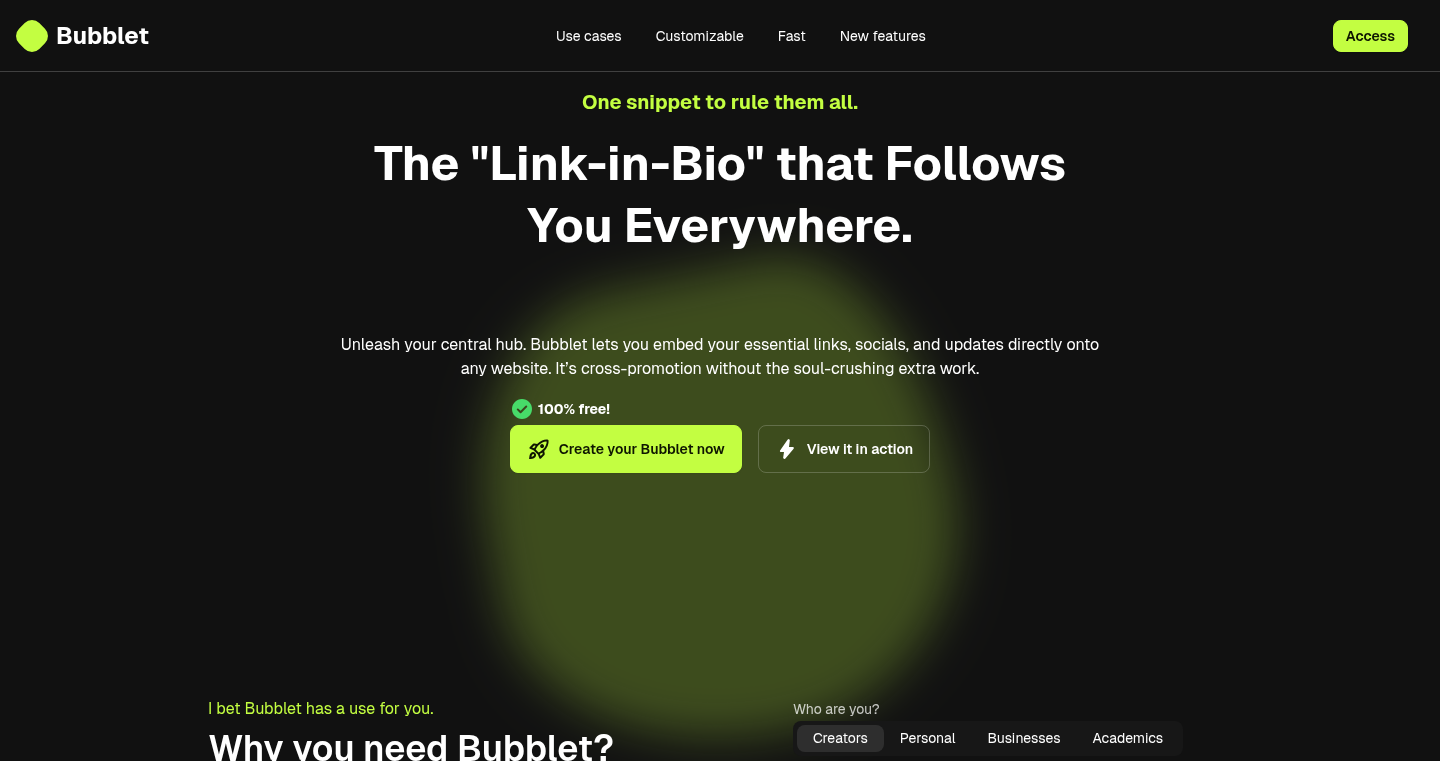
Author
tratteo
Description
This project is a free web widget designed to manage and display content across multiple websites from a single point. It addresses the common problem of having to manually update the same information (contact details, links, media embeds) on numerous websites, which is time-consuming and inefficient. The widget allows developers to make changes in one place, and have those changes reflected everywhere the widget is embedded. The key innovation lies in its ability to centralize content updates and distribute them dynamically, improving workflow scalability. So this is useful for anyone managing multiple websites, making updates far easier and faster.
Popularity
Points 1
Comments 0
What is this product?
This project uses a web widget, essentially a small piece of code that you embed in your website. The widget then dynamically pulls content from a central source. Think of it as a smart container that gets its contents remotely. The technology behind it involves a combination of client-side scripting (JavaScript) to load the widget and make API calls to fetch the updated data, and server-side logic (the exact details aren't provided in the prompt, but it likely involves a database or content management system to store and serve the data) for managing and serving the content. This design provides a simple way to update information across different websites without having to touch each website's code every time. So this means you can manage information like YouTube videos, contact details, or even real-time data (like Stripe revenue - though this isn't fully implemented yet) from one central location.
How to use it?
Developers can integrate this widget by embedding a provided code snippet (likely JavaScript) into the HTML of their websites. Once embedded, the widget will automatically load the content from the developer's central data source. The developer can manage content (text, links, media embeds, etc.) through the widget’s interface. For example, you might change your contact email in the widget's control panel, and it will update across all your websites where the widget is embedded. The widget is intended for projects where there is a need to manage similar information across multiple websites (e.g., a personal brand, a portfolio of projects, or even a small business).
Product Core Function
· Centralized Content Management: The core feature is the ability to update information in one place and have it automatically reflected across all websites using the widget. This greatly simplifies updating common data, eliminating repetitive editing across multiple websites. So it saves developers valuable time and reduces the risk of errors.
· Dynamic Content Display: The widget dynamically displays content, such as YouTube videos, from a central source. As the central content is updated, the widget automatically shows the updated information on all websites. So it keeps information consistent across your online presence.
· Cross-Promotion Capabilities: The widget is designed to cross-promote different parts of your online presence. For example, it can automatically show a list of your most popular videos or recent videos from a YouTube channel. So it’s a great way to drive traffic to your other platforms.
Product Usage Case
· Personal Portfolio Websites: A developer with multiple portfolio sites can use the widget to manage their contact information, links to projects, and social media profiles. Updating the contact email address or a link to a new project only requires a single change, and this change will appear on all the portfolio sites. So this keeps your portfolio updated without having to make multiple edits.
· Cross-Promotion between Products: If a developer has multiple products or services, they can use the widget to display links to each product, highlight special offers, or embed relevant YouTube videos. So it's a quick way to let your users know about your other cool projects.
· Small Business Websites: A small business with several websites can use the widget to keep its contact information, opening hours, and announcements consistent across all platforms. So it helps with brand consistency and makes it easier to reach customers.
70
Emoji Tags: Visual Keyword Enhancement for Code
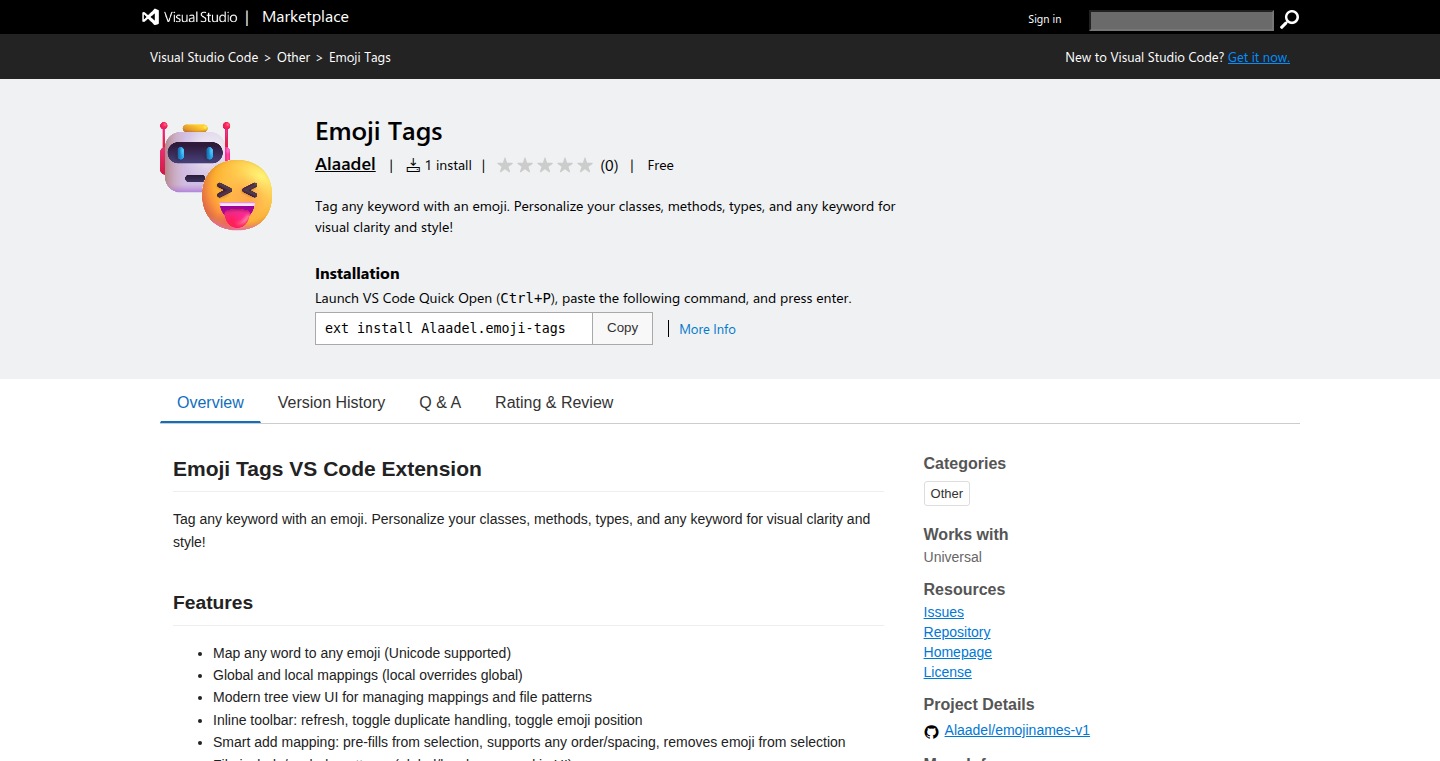
Author
xalaa
Description
This project introduces a Visual Studio Code extension that lets you tag any keyword in your code with an emoji. The core innovation is providing a layer of visual clarity by associating emojis with code elements like classes, methods, or variables. It solves the problem of quickly identifying and understanding different parts of a codebase through a more visually intuitive system, thus improving developer productivity. So this helps you find what you're looking for faster.
Popularity
Points 1
Comments 0
What is this product?
Emoji Tags is a VSCode extension that allows developers to visually tag keywords in their code with emojis. The underlying technology involves mapping words to Unicode emojis and displaying them directly in the code editor. It uses file patterns and a modern tree view UI to manage these mappings globally or locally within a project. It leverages regular expressions to handle the emoji detection, and uses VS Code's decoration API to avoid making any actual code changes. So, it's not changing your code, just how you see it.
How to use it?
Developers can use Emoji Tags to personalize their code and add visual cues. You install the extension in VS Code, and then you can define a mapping between a keyword and an emoji. For example, you could map 'User' to a person emoji, or 'database' to a database emoji. This makes the code more readable and easier to understand at a glance, especially for large projects with many classes and methods. Integrate by simply installing the extension and defining your custom mappings - there's no code modification needed!
Product Core Function
· Keyword-to-Emoji Mapping: The core functionality is the ability to map any keyword (like a variable name, function, or class name) to an emoji. This improves code readability and allows for quick visual identification of different code elements. For instance, you can mark all the database-related codes with a database emoji to easily trace them.
· Global and Local Mapping: This feature allows you to define mappings globally or specific to a project, giving you control over the visual organization. If you're working on multiple projects with different needs, this feature will save you a lot of time in organizing your projects.
· Tree View UI for Mapping Management: A user-friendly UI is provided for managing these mappings and file patterns. This simplifies the setup and maintenance of your custom emoji tags. You can easily add, edit, and remove mappings via an intuitive interface.
· File Include/Exclude Patterns: The extension supports file patterns, allowing you to apply the emoji tags to specific files or directories. This feature enables fine-grained control over where the emoji tags appear, ensuring the visual enhancements align with your project structure. This means you can specify the files where the tags should be applied. For instance, you can mark the files you are most concerned about.
· Smart Add Mapping: The extension can automatically fill in the mapping when you select some code, making it quick to create new visual links. For instance, if you select a function, the extension will automatically suggest mapping it to an emoji. This greatly reduces the time spent setting up emoji tags.
Product Usage Case
· Large Project Navigation: In a large software project, where numerous classes and methods exist, using emoji tags to categorize elements (e.g., user management with a person emoji, database interactions with a database emoji) greatly improves navigation and understanding of the code at a glance. This helps new developers quickly onboard by providing visual hints about code structure.
· Team Code Consistency: Teams can agree on a set of emoji mappings for common elements (e.g., a bug emoji for issues, a checkmark for completed features), ensuring a consistent visual language across the codebase. This enhances the maintainability and reduces the cognitive load of every member of the team.
· Quick Debugging: When debugging, quickly identifying critical functions or sections of code becomes much easier. By tagging those sections, developers can pinpoint areas of interest faster. For example, a critical security-related method could be tagged with a lock emoji to highlight its importance. This can speed up the debugging time significantly.
71
PolySpin - The Daily Polygon Rotation Solver
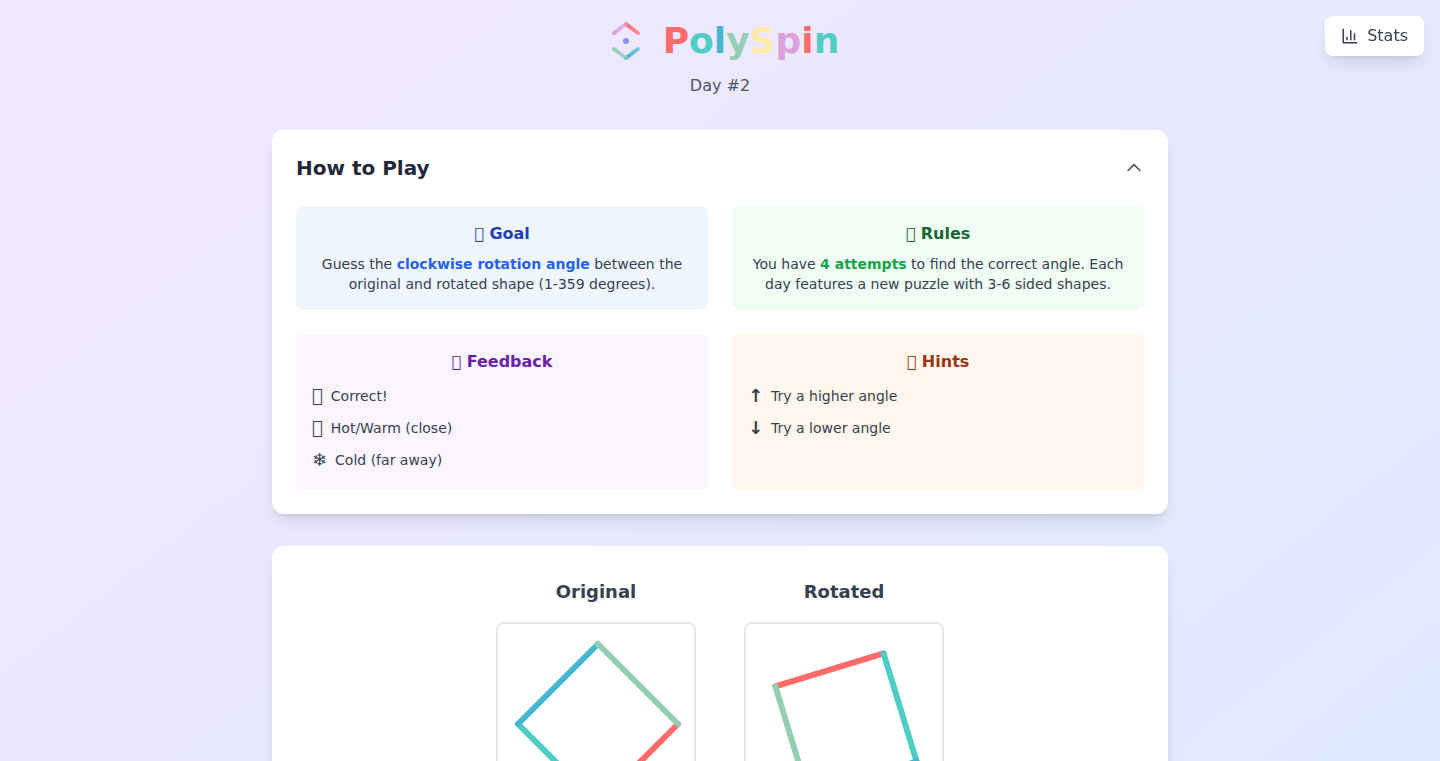
Author
pmx
Description
PolySpin is a daily puzzle game built around rotating polygons to fit a specific shape. The innovation lies in its efficient geometric algorithm for shape matching and puzzle generation. It tackles the problem of finding optimal rotations in a constraint-based environment, offering a unique challenge and demonstrating practical applications of computational geometry.
Popularity
Points 1
Comments 0
What is this product?
PolySpin is a puzzle game where you rotate polygons to fit a target shape. At its core, it uses clever math and computer algorithms (computational geometry) to quickly figure out if and how the polygons can be rotated to match. This is innovative because it simplifies a complex geometric problem, allowing for the rapid creation of new puzzles every day. It's like a digital jigsaw puzzle but with rotation and precise shape matching. So this means I can get a new, challenging puzzle every day!
How to use it?
The game is accessed through a web interface. The user is presented with a target shape and a set of polygons. The user clicks and drags the polygons to rotate them, then positions them to fit the target. Developers could use the underlying geometric algorithms for other applications, such as Computer-Aided Design (CAD) or game development, where shape manipulation and matching are crucial. You could integrate its algorithms into your own puzzle game creation process or even use it as a framework for educational tools that teach geometry. So this means I can learn about the math behind shape rotation and potentially use it for my own projects.
Product Core Function
· Polygon Rotation Algorithm: This is the heart of the game. It allows the polygons to be rotated and matched to the target shape. This technology is valuable because it offers a way to manipulate the shape and position of the polygons based on mathematical calculations. This is useful in CAD tools where precise rotation of objects is important. So this allows me to efficiently rotate and align shapes.
· Shape Matching Algorithm: This part compares the rotated polygons to the target shape, and determines the best fit. This technology offers an efficient way to determine whether the rotated shape is a match. It is useful in applications that require precise shape alignment, such as image recognition or pattern matching. So this can help me verify a match between polygons
· Daily Puzzle Generation: The game automatically generates a new puzzle every day. The algorithm creates unique challenges from a predefined set of shapes and algorithms. This is valuable because it provides an ongoing stream of new challenges. This is particularly useful in the context of game design and other interactive applications. So this means I get a fresh puzzle to solve every day!
Product Usage Case
· Game Development: Using the shape-matching algorithm to check for collision detection in a 2D game. For example, a developer creating a game where characters can rotate to fit through specific openings.
· CAD Software: The geometric algorithms could be adapted to help users align and fit shapes accurately in CAD software. This is very useful when working with complex 3D models or architectural designs.
· Educational Tools: The game's logic can be repurposed to create interactive educational tools to visualize concepts in geometry like rotation and transformation. For instance, this would allow students to actively experiment with geometric shapes.
· Puzzle Game Framework: It provides a framework for building similar puzzle games, giving a foundation for the developer to focus on creative design, rather than the complicated underlying logic.
72
Heap: Offline Webpage Archiver
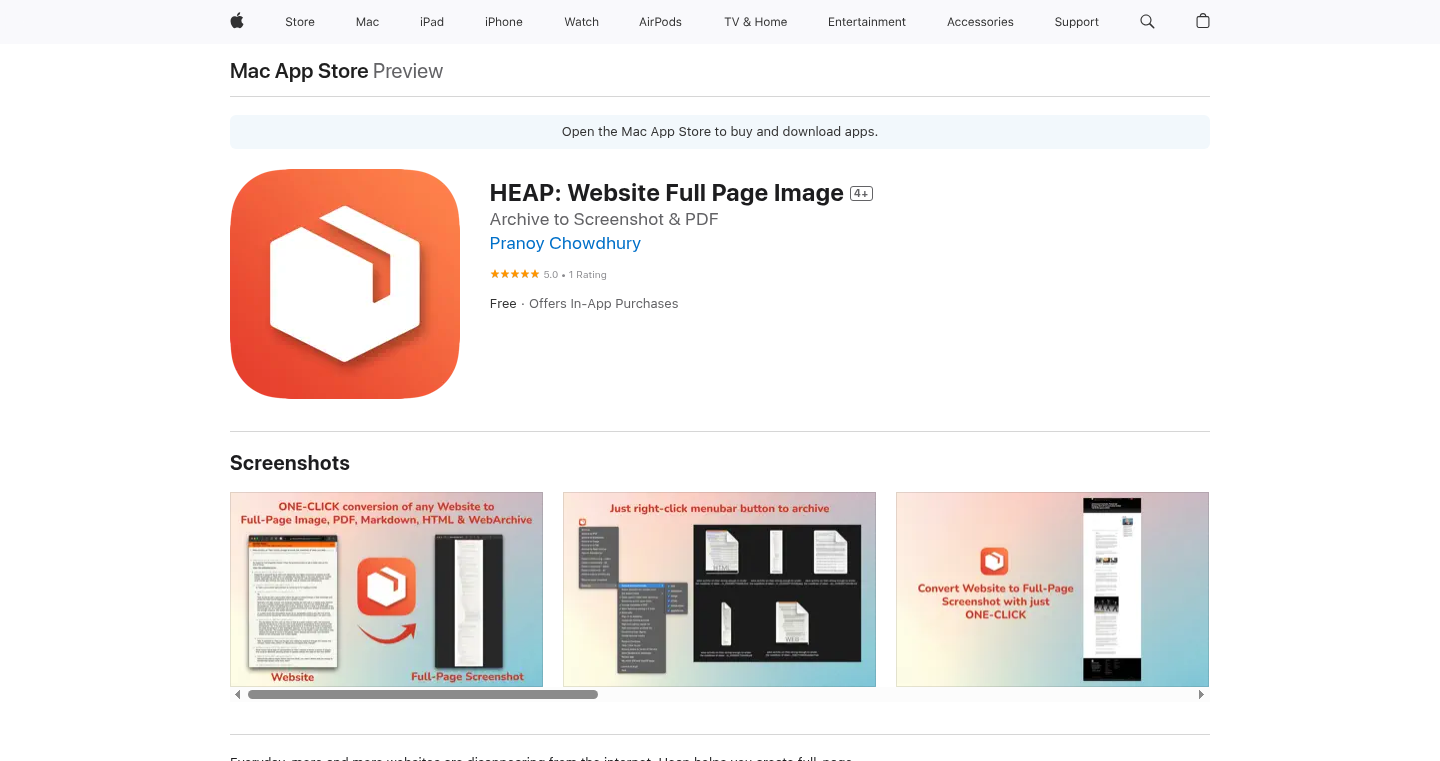
Author
busymom0
Description
Heap is a macOS application designed to create full-page, offline archives of webpages with a single click. The core innovation lies in its ability to capture webpages in multiple formats (image, PDF, Markdown, HTML, WebArchive) via a simple right-click menu, offering users an easy way to preserve web content for later use, even without an internet connection. The application also facilitates advanced features such as running JavaScript before archiving, handling user authentication, and executing Apple Shortcuts post-archiving, providing a high degree of customization for users. It aims to solve the problem of content disappearing from the web and making information accessible offline, thus being useful for data hoarding and self-hosting enthusiasts.
Popularity
Points 1
Comments 0
What is this product?
Heap is a macOS application that works like a digital preservation tool. It lets you save entire webpages, not just text, as images, PDFs, or other formats. The technology behind it focuses on capturing the complete visual layout of a webpage. When you right-click, it uses a mix of techniques to grab the entire page, including images, and formatting. It then saves this as an offline version for you. It includes several core features like running JavaScript to handle dynamic content before archiving, support for signing in with user accounts before archiving content that requires authentication, and support to execute Apple Shortcuts after archiving. The key innovation is its ease of use and flexibility with a single right-click, making it easy to preserve web content. So this gives you an easy way to have offline copies of important information.
How to use it?
Developers and regular users alike can use Heap to archive any webpage they want. After installation, the app sits in your menu bar, ready to archive webpages at a moment's notice. You right-click on the app icon, and it lets you save the current webpage as image, PDF, Markdown, HTML, or WebArchive, all with one click. For more advanced usage, you can configure it to execute JavaScript before archiving, allowing you to handle dynamic content, or sign in to websites, before archiving. You can also set it up to run Apple Shortcuts to integrate archiving into more complex workflows. You can also drag and drop a list of links to archive multiple pages at once. So, you can easily capture and preserve information, making sure you have it available offline and indefinitely.
Product Core Function
· Single-click archiving: This core functionality allows users to save full-page captures of webpages with a single right-click. It simplifies the preservation process, making it accessible for anyone. So, you can archive a webpage quickly and easily.
· Multi-format saving: Heap supports multiple output formats (image, PDF, Markdown, HTML, and WebArchive), providing flexibility based on the user's needs and preferences. This ensures compatibility with different devices and use cases. So, you can choose the format that works best for you.
· JavaScript execution before archiving: This feature lets users run custom JavaScript code on the webpage before saving it, making it possible to handle dynamic content and ensure all information is captured. So, you can capture all content, even if it requires interaction.
· User authentication support: Heap can handle user authentication, allowing the archiving of content that requires a login, making preserving private content much easier. So, you can archive content behind a login.
· Apple Shortcut integration: This enables users to run Apple Shortcuts after archiving, extending the app's capabilities for more customized workflows, such as automatic backup. So, you can integrate archiving into your broader workflow.
· Batch Archiving: Users can drag and drop a list of URLs or a text file containing URLs, to allow the archiving of multiple web pages at once. So you can save multiple web pages with one action.
· Wayback Machine/Archive.today integration: Users can one-click access archived versions of a webpage using existing archive services. This helps with quick access to historical versions of websites.
Product Usage Case
· A journalist needs to archive a news article for later use and fact-checking, but doesn’t want to rely on the webpage remaining online. Heap can create a complete, offline archive, preserving the article's formatting, images, and content. So, you have a permanent backup of important news.
· A researcher is conducting a study and requires multiple webpages as research. They can archive those pages, including dynamic content, ensuring all relevant information is preserved for future reference, and guaranteeing the integrity of their research data. So, you can keep a copy of the pages for your research.
· A developer wants to archive the documentation of a website or app for later use, without internet. They can archive the web content, making it available offline for quick access. So, the developer can access documentation offline.
· A user needs to capture an important webpage that might change or disappear over time. Using Heap they can create a snapshot in HTML, PDF, and image, keeping the data for as long as they want to. So, you can save content that might disappear.
· A privacy-conscious individual wants to archive content from behind a paywall. They can use Heap to log in, and then save the content. So, you can archive content behind a login.
73
TripGenius: AI-Powered Collaborative Trip Planning

Author
kenforthewin
Description
TripGenius is a collaborative trip planning tool leveraging AI to assist friends in planning travel. It allows multiple users to contribute ideas, preferences, and constraints, and the AI synthesizes these inputs to suggest itineraries, destinations, and activities. The key innovation lies in its ability to handle complex group dynamics and diverse preferences, using AI to resolve conflicts and optimize the travel plan based on the collective input. It addresses the common problem of fragmented planning, where multiple tools and communications are needed to organize a trip, providing a centralized and intelligent solution.
Popularity
Points 1
Comments 0
What is this product?
TripGenius utilizes AI to understand individual preferences and group dynamics in travel planning. It integrates inputs from multiple users, including destinations, budget, interests, and time constraints. The AI then generates personalized recommendations and optimizes the itinerary based on these factors. The innovative approach lies in the collaborative nature where everyone contributes to the plan, and the AI adjusts the plan according to each person's preferences, eliminating the problem of having to go back and forth multiple times to finalize the plan. The AI uses different algorithms to suggest ideas for the best travel plan.
How to use it?
Developers can interact with TripGenius by integrating its API into existing travel platforms or building custom planning tools. For example, a travel website could offer a 'Plan with Friends' feature powered by TripGenius. Users provide their preferences through an easy-to-use interface. The application receives the information and relays it to the AI to synthesize the information. The application presents the optimal plan.
Product Core Function
· Collaborative Input: Allows multiple users to input their travel preferences, including destinations, interests, budget, and time constraints. This solves the problem of having to consolidate information from multiple sources and creates a centralized planning environment. The AI handles conflicts, where multiple users may have different preferences
· AI-Powered Itinerary Generation: The AI analyzes user inputs and suggests personalized travel itineraries, including destinations, activities, and transportation options. It helps to solve the challenge of gathering ideas and creating an initial travel plan based on all the inputs. This saves time and effort in the planning process, allowing users to discover more possible travel opportunities.
· Preference Optimization: The AI adjusts the itinerary based on the collective input of all users, prioritizing the preferences of the group. The AI can offer additional suggestions to the user that is based on all the information gathered. This ensures a more satisfying travel experience for everyone. It solves the problem of group disagreements and streamlines decision-making, leading to better travel experiences.
· Real-time Collaboration: Provides real-time updates and feedback, allowing all users to see the progress of the plan. This provides an integrated planning system where everyone is on the same page. This increases communication across everyone that's working on the project.
· Integration with Travel Services: It can potentially be integrated with travel booking services such as airlines and hotels for the final trip booking phase, further streamlining the process. This is particularly useful when traveling with friends, as it simplifies the entire trip planning process from start to end.
Product Usage Case
· Building a travel website feature: A travel website integrates TripGenius's API to offer its users a new 'Plan with Friends' functionality. Users can collaboratively plan a trip directly on the website by inputting their information and TripGenius synthesizes the information. The result is that the planning of the trip is more efficient and everyone has a better understanding of the whole trip plan.
· Creating a personalized travel planning app: A developer creates a mobile app for travel planning. By integrating with TripGenius's AI, the app allows users to create personalized travel plans collaboratively. The developers create the app to cater to a specific group or target users. They get recommendations of where to travel and what to do based on their preferences. The result is the ease of having the ability to quickly plan and organize trips with others.
· Enhancing existing travel platforms: Existing travel planning platforms can use TripGenius to enhance their features. The AI can add features like personalized recommendations and collaborative planning. This expands the platform's offerings, making it easier for users to plan trips with multiple people.
· Integrating with existing calendar applications: Developers can integrate TripGenius's itinerary suggestions directly into popular calendar applications such as Google Calendar. This will provide users with a simple and easy to read travel plan, making it easier for users to keep track of their events.
74
Qwiz: Global Trivia Synchronizer
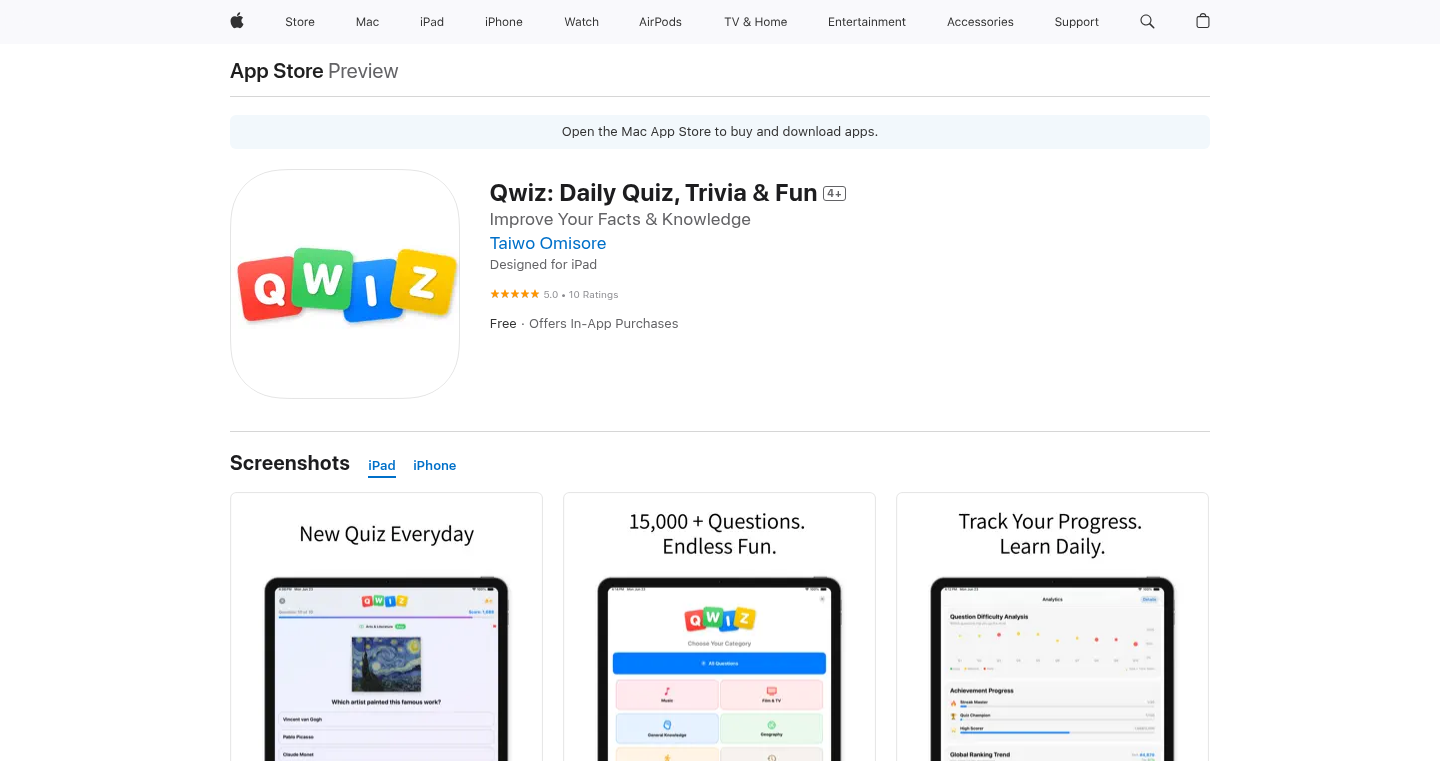
Author
spacebots
Description
Qwiz is a daily trivia game that challenges players worldwide with the same questions at the same time, featuring a global leaderboard. It tackles complex challenges like synchronizing question delivery across time zones, managing a large question database with quality control, handling real-time leaderboards with thousands of concurrent users, and building a privacy-focused analytics engine. The core innovation lies in its robust synchronization mechanisms and backend infrastructure to deliver a fair and engaging experience for all players. So this means if you're a developer looking for interesting techniques on creating globally synchronized applications, and building features that have to handle large amounts of data efficiently, this project has a lot to offer.
Popularity
Points 1
Comments 0
What is this product?
Qwiz is a daily trivia app built to ensure all players globally receive the same set of questions at exactly the same time. The core innovation is the method used to synchronize game events across different time zones, using CloudKit scheduled functions and local timezone calculations. The app also features a custom content pipeline for managing a large database of trivia questions, optimizing for fairness and quality. It uses real-time leaderboards to display player scores and a privacy-focused analytics engine. This is an example of a developer solving difficult problems related to time synchronization, large data management, and user data privacy. So this means you learn how to handle the difficult issue of handling global user synchronization while respecting user privacy.
How to use it?
Developers can't directly 'use' Qwiz in the way they might use a library, but they can certainly learn from it. The technical implementation details highlight how to build applications that require global synchronization (think of games, or shared calendars) and manage large datasets efficiently. The project's source code (if available) provides insights into SwiftUI for the user interface, CloudKit for data storage and synchronization, and the backend design for question management and analytics. You can study the approach to optimize your own apps. So this means you can learn how to create similar apps.
Product Core Function
· Global Synchronization: This uses CloudKit scheduled functions to ensure that all users, regardless of their location, receive the daily questions simultaneously. This demonstrates how to overcome the complexities of time zones in a global application. So this means you learn how to build apps that require synchronization.
· Question Management Pipeline: This includes tools for managing a large database of trivia questions. It handles difficulty balancing, duplicate detection, and fact-checking workflows. This provides insights into creating a robust backend system. So this means you can learn how to effectively and efficiently manage large data.
· Real-time Leaderboards: This handles concurrent score submissions from many users. It uses optimistic updates with conflict resolution. It's an example of building scalable and reliable real-time features. So this means you can learn how to build scalable real-time features in your apps.
· Privacy-Focused Analytics Engine: This is a custom system used to track performance across categories, improvements over time, and global statistics without compromising user privacy. So this means you can learn how to build analytics engines.
· Offline Support and Performance Optimization: The app uses Core Data for offline capabilities and focuses on keeping the app responsive while handling complex scoring algorithms and seamless syncing when back online. This shows how to make an app both feature-rich and performant. So this means you can learn how to build offline-first applications that also run fast and are optimized for a good user experience.
Product Usage Case
· Global Event Synchronization: Imagine building a collaborative task management app. The techniques used in Qwiz could be applied to synchronize tasks across users in different time zones, ensuring everyone sees the same information at the right time. So this means you can create apps where all users have synchronized events.
· Real-time Competitive Applications: You're making a multiplayer gaming app. The real-time leaderboard implementation in Qwiz offers a pattern for managing user scores and standings in a scalable way, improving your user experience. So this means you can make real-time games with scalable features.
· Educational Apps with Content Management: The question management pipeline is a valuable lesson for building an educational app. It's a great example of building a system to manage and maintain your content database, making it easy to update and add new content. So this means you can maintain a database with less pain and effort.
· Applications Requiring Offline Functionality: Qwiz's use of Core Data for offline support is useful if you're developing an app that needs to work even without an internet connection. You can study this implementation to learn how to provide a seamless user experience. So this means your app can run offline.
75
SendMeYourIP: A Simplified IP Address Sharing Tool

Author
jtokoph
Description
This project simplifies the process of getting someone's IP address by providing a unique, shareable link. The user simply clicks the link, and the sender's IP address is displayed. This is a streamlined solution to a common problem, removing the need for clunky IP lookup websites, especially when helping less tech-savvy individuals. It’s a practical application that leverages basic web technologies for a specific and immediate need. So, this is useful because it provides an easy and reliable method for retrieving IP addresses, especially when you need to troubleshoot network issues or configure services.
Popularity
Points 1
Comments 0
What is this product?
SendMeYourIP is a web application that utilizes basic web technology (likely JavaScript and server-side scripting) to capture and display the user's IP address when they click a unique, generated link. When someone clicks your specific link, the website detects the IP address from the request header. It then displays that IP address to the user. The innovation here lies in its simplicity and ease of sharing – bypassing complex websites or instructions. So, it's a simple but effective method for quickly obtaining an IP address without needing any specific technical knowledge on the user's end.
How to use it?
Developers can use this in several ways. For example, to remotely diagnose network problems, configure servers, or whitelist IP addresses for security. To use it, you just share the generated link with the person whose IP you want. The system then displays the IP address to you. You can integrate it with other systems, like a monitoring tool, by programmatically fetching the IP address information from the service. So, you can easily get the IP address of a remote user or machine, streamlining troubleshooting or setup processes.
Product Core Function
· IP Address Detection: The core function detects the incoming user’s IP address. This is achieved through server-side scripting, examining the headers of an HTTP request. This has value because it is the very basic thing that the site does.
· Unique Link Generation: The system creates unique URLs for each user, ensuring that only the intended recipient shares their IP. The value here is improved security and addressability.
· IP Address Display: The system displays the user's IP address in a simple and easy-to-read format when the unique link is clicked. This value is efficiency; a quick display of information is a benefit.
· Simple User Interface: Provides an uncluttered and user-friendly interface that requires no technical expertise. So, this is useful because it is easy to use.
Product Usage Case
· Remote Network Troubleshooting: A developer can use SendMeYourIP to quickly obtain a remote user's IP address to diagnose network connectivity issues, for example, to ping the machine and determine if a connection is possible. So, this helps solve the problem of not having a reliable way to remotely obtain the user's IP.
· Server Configuration: When setting up a server, a developer may need to whitelist a specific IP address for access. SendMeYourIP provides a quick way to get the IP to add to the whitelist. So, you can easily restrict access to a server to approved users only.
· Security Monitoring: Integrate SendMeYourIP into a security monitoring system to track IP addresses and monitor potential threats. This provides a simple way to quickly grab an IP address from a remote machine without getting bogged down with complex tools.
76
Cogeol: Automated Python Version Management with Cog and End-of-Life Data
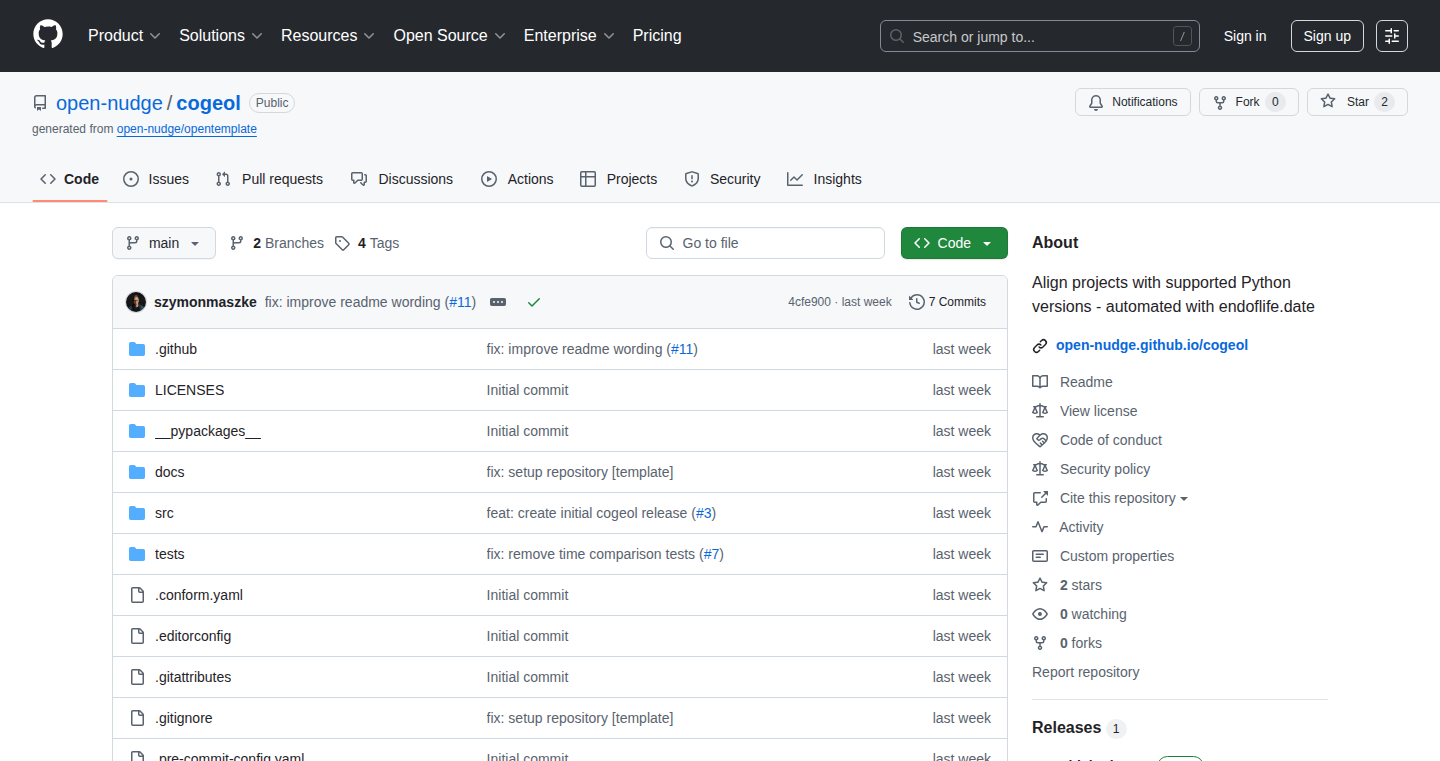
Author
szymonmaszke
Description
Cogeol is a tool that automates the process of managing Python versions for your projects, specifically libraries. It leverages the power of `cog`, a static code generator, and the `endoflife.date` website data to keep your project aligned with the latest Python versions. This removes the manual work of updating Python versions in your project to support the newest releases, and ensures consistent compatibility.
Popularity
Points 1
Comments 0
What is this product?
Cogeol works by integrating with the static code generator `cog`. You define the desired Python versions your project should support (e.g., the three latest versions). Cogeol then uses `endoflife.date` data to check for new Python versions and updates a configuration file in your project accordingly. It then utilizes `cog` to generate code that reflects these new supported versions. This way, your project automatically supports the correct Python versions without you having to manually update the code every time a new Python release happens. So, you can focus on coding rather than version compatibility issues.
How to use it?
Developers use Cogeol by integrating it into their project's build process. You would first define the Python versions you wish to support in a simple configuration file. Then, you run Cogeol, which uses `cog` to generate code reflecting this configuration, like a setup.py file. Cogeol can integrate with your CI/CD pipeline, so every time you push changes, it checks for new Python versions, ensures compatibility and adjusts your project settings. So, you don't need to manually update your project for new Python versions.
Product Core Function
· Automatic Python Version Detection: Cogeol checks `endoflife.date` to identify current Python versions and their support status. This ensures that your project remains up-to-date with supported Python releases.
· Dynamic Configuration Updates: Based on the detected Python versions, Cogeol generates configuration files. This reduces the amount of manual configuration needed.
· Automated Code Generation with Cog: Cogeol uses `cog` to generate code based on the updated configuration. For example, it may update the dependencies of your Python package, making sure your project runs on the proper Python versions. This is a great time saver.
· Project Compatibility Management: By automating Python version updates, Cogeol ensures your project's compatibility with the latest Python versions. This is especially important for libraries that are used by other projects.
· CI/CD Integration: Cogeol integrates easily with CI/CD (Continuous Integration/Continuous Deployment) pipelines. This allows for automated version management every time you build or deploy your code. So, this helps in keeping your project in sync with the latest Python versions automatically, without any user intervention.
Product Usage Case
· Library Development: A developer creates a Python library and wants to support the three latest Python versions. Cogeol would automate the process of updating the library's setup files to reflect the supported Python versions whenever a new version is released. So, the library always works with the latest, supported Python versions, saving the developer time and effort.
· Continuous Integration: A team uses a CI/CD pipeline for their Python project. Cogeol can be integrated into the pipeline. With each code change, the pipeline would automatically check for new Python versions, update configuration files, and generate code to align the project with these versions. So, this guarantees that the project is always compatible with the latest Python versions.
· Dependency Management: A project relies on various Python packages. Cogeol can automate the updates to dependency versions, ensuring compatibility. So, the project can stay up-to-date with necessary dependencies.
77
Shiplo: AI-Powered Autonomy Platform
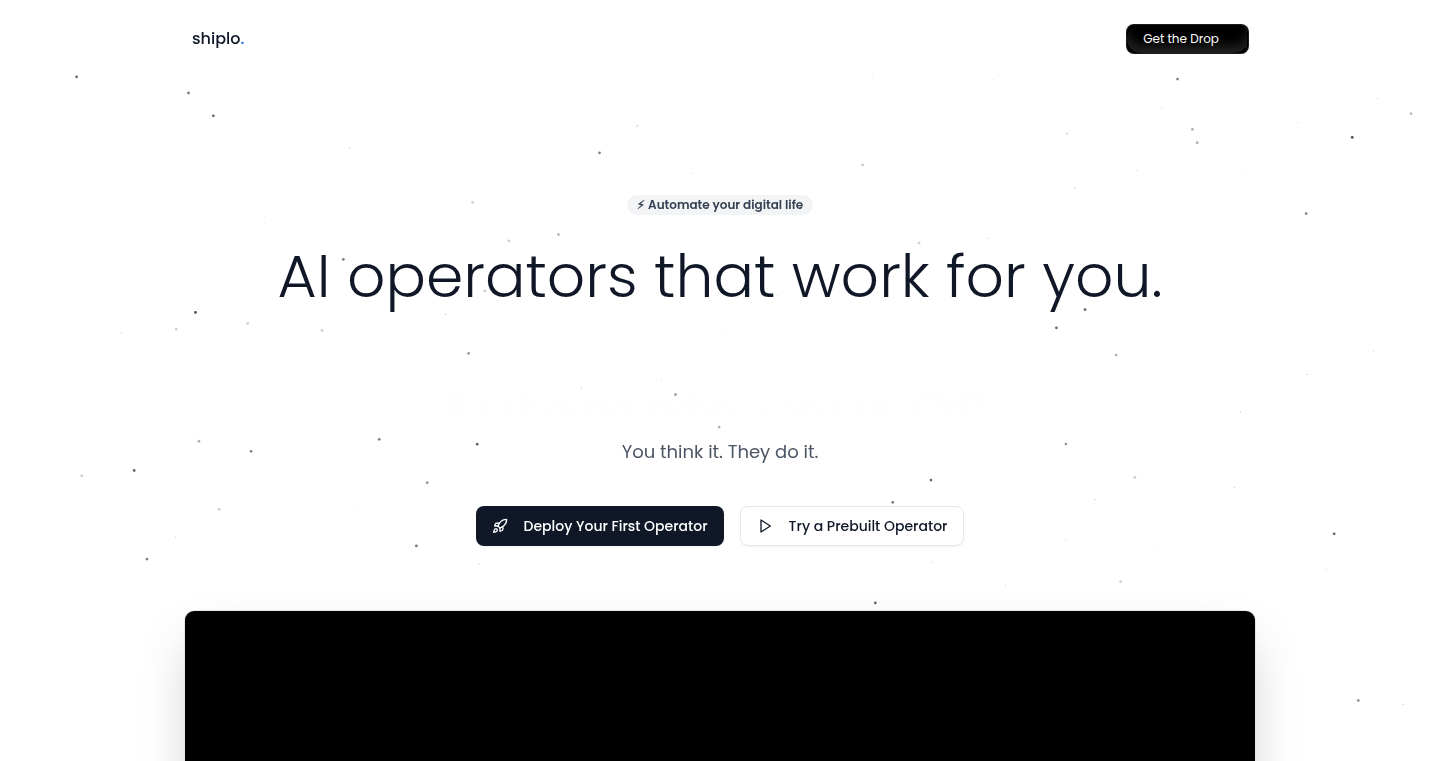
Author
ani_bytes
Description
Shiplo is a platform that gives Artificial Intelligence (AI) the ability to control your computer, just like a human. Imagine AI agents running your browser and desktop, automating tasks while you're away. The core innovation lies in allowing these AI 'Operators' to work together, creating automated systems for complex tasks, like finding internships and applying for them – all without you needing to manually intervene. This solves the problem of digital busywork and helps users reclaim their time.
Popularity
Points 1
Comments 0
What is this product?
Shiplo is essentially a 'brain' for your computer, allowing AI agents to interact with your browser and desktop applications using a mouse and keyboard. This allows these agents to perform tasks autonomously. The innovation here is the ability for these AI agents to work together, coordinating complex workflows. This leverages the power of AI to automate a wide range of digital tasks that used to require human intervention.
How to use it?
Developers can use Shiplo to create AI Operators that handle tasks in their browser and desktop environments. For example, they could build an Operator to automatically respond to emails, manage social media, or automate repetitive data entry tasks. The platform allows these Operators to be chained together, enabling the automation of more complex workflows. To integrate, developers likely interact with an API, providing instructions and monitoring the Operator's actions. So this means, by using Shiplo, developers can free up time and focus on the core aspects of their work.
Product Core Function
· Browser Automation: AI Operators can navigate websites, fill out forms, and scrape data. This saves time on tedious tasks, such as data extraction or form filling. So this means you can automate browsing tasks, making data gathering and online interactions much more efficient.
· Desktop Automation: The platform can control desktop applications, which allows AI to automate desktop applications. This opens up possibilities for automated tasks like file management, software interactions, and task scheduling. So this means you get automated tasks that streamline desktop workflows.
· Operator Collaboration: Allows multiple AI agents to work together to solve complex problems. This is a powerful way to chain together various tasks, creating automated workflows. So this means you can automate complex, multi-step processes that would otherwise require extensive manual effort.
· Customizable Workflows: Users can define specific instructions and configurations for the AI Operators. This gives developers a lot of flexibility in tailoring the automation to their needs. So this means, you have tailored automation to specifically suit your workflow and needs.
Product Usage Case
· Automated Job Application: An AI Operator could search for internships on various platforms, apply to relevant postings, and respond to follow-up messages on LinkedIn. This completely automates the job application process. So this means, you can apply for jobs while you are away from the computer.
· Social Media Management: An AI Operator could automatically schedule posts, respond to comments, and engage with followers on social media. This streamlines social media management. So this means you can maintain a consistent online presence and engagement.
· Data Entry and Reporting: An AI Operator can extract data from multiple sources, perform calculations, and generate reports. This simplifies data analysis and reporting. So this means you can get automated reports without manual data entry.
78
TenZorro: AI Model Gateway

Author
paulo20223
Description
TenZorro is an AI model gateway designed to provide a private and secure interface for generating content using AI models. It allows developers to access and manage various AI models without exposing sensitive data or infrastructure details. The core innovation lies in its ability to act as a proxy, enabling controlled access, rate limiting, and robust security measures for AI model interactions. This addresses the growing need for privacy and control when integrating AI into applications. So this is useful for developers who want to use AI models without having to share their private API keys or worry about security.
Popularity
Points 1
Comments 0
What is this product?
TenZorro is essentially a 'middleman' for your AI interactions. Instead of directly connecting your application to an AI model, you connect to TenZorro. It handles the communication with the AI model, allowing you to control things like who can use the model, how many requests they can make, and how the data is protected. The innovation is in the abstraction – it hides the complexity of interacting with various AI models and provides a single, secure entry point. This involves using techniques like API proxying, request filtering, and robust authentication to ensure privacy and control.
How to use it?
Developers can use TenZorro by integrating its API into their applications. You would point your application's AI requests to the TenZorro endpoint instead of the AI model's endpoint. You would then configure TenZorro to manage your AI models and set up rules around access, rate limiting, and security. For example, you might create specific API keys for different users, allowing them to access only certain models or to limit how often they can make requests. This often involves setting up a reverse proxy and configuring authentication and authorization rules. So you could integrate with any application that needs to generate content with AI, such as chat bots, image generators, or content summarization tools.
Product Core Function
· API Proxying: This allows TenZorro to sit between your application and the AI model, intercepting requests and responses. So this is useful because it enables the gateway to manage and monitor all interactions with the AI models, enforcing security and access control.
· Authentication and Authorization: TenZorro lets you control who can access your AI models. You can set up API keys, user roles, and permissions to ensure only authorized users can use the models. So this protects your AI models from unauthorized use and potential misuse.
· Rate Limiting: This feature prevents abuse by limiting the number of requests a user can make within a specific time frame. So this helps to manage costs, prevent overload, and ensure fair usage of the AI models.
· Model Management: TenZorro provides a centralized way to manage and switch between different AI models. So this offers flexibility and makes it easier to experiment with different AI models without changing your application's code.
· Request Filtering and Transformation: TenZorro can filter and transform requests before they reach the AI model. So this allows you to customize the data sent to the models, enforce data formats, and sanitize input for security.
· Logging and Monitoring: This provides insights into how the AI models are being used, tracking usage patterns, and identifying potential issues. So this allows you to understand the performance of your AI models and debug problems.
Product Usage Case
· Building a secure chatbot: A developer wants to integrate a chatbot using an AI model into their application. They can use TenZorro to handle all the communication with the AI model, providing authentication so only authorized users can use the chatbot and rate limiting to prevent abuse. So it is useful because it guarantees the chatbot’s security and helps avoid excessive costs.
· Image generation service with access control: A developer wants to offer an image generation service. They integrate TenZorro to manage access to the AI image generation model, ensuring that only paying subscribers can use the service. TenZorro can limit the number of images each user can generate. So this is useful because you can monetize the image generation and control the service's costs.
· Content summarization tool with usage tracking: A company uses an AI model for content summarization. They use TenZorro to manage access, track usage, and monitor the performance of the summarization model. TenZorro provides insights into API call volumes, helping to optimize resource allocation and costs. So this is useful because it helps optimize your AI model and helps understand its usage, allowing for informed decisions about the AI model's performance and cost-efficiency.
· Protecting API keys: An application using an AI model requires the model's API key. By using TenZorro, the developer can avoid storing the API key directly in their application, improving security and preventing key exposure. So this is useful because it reduces the risk of API key compromise.
79
Lunova: QuickBooks Alert Engine
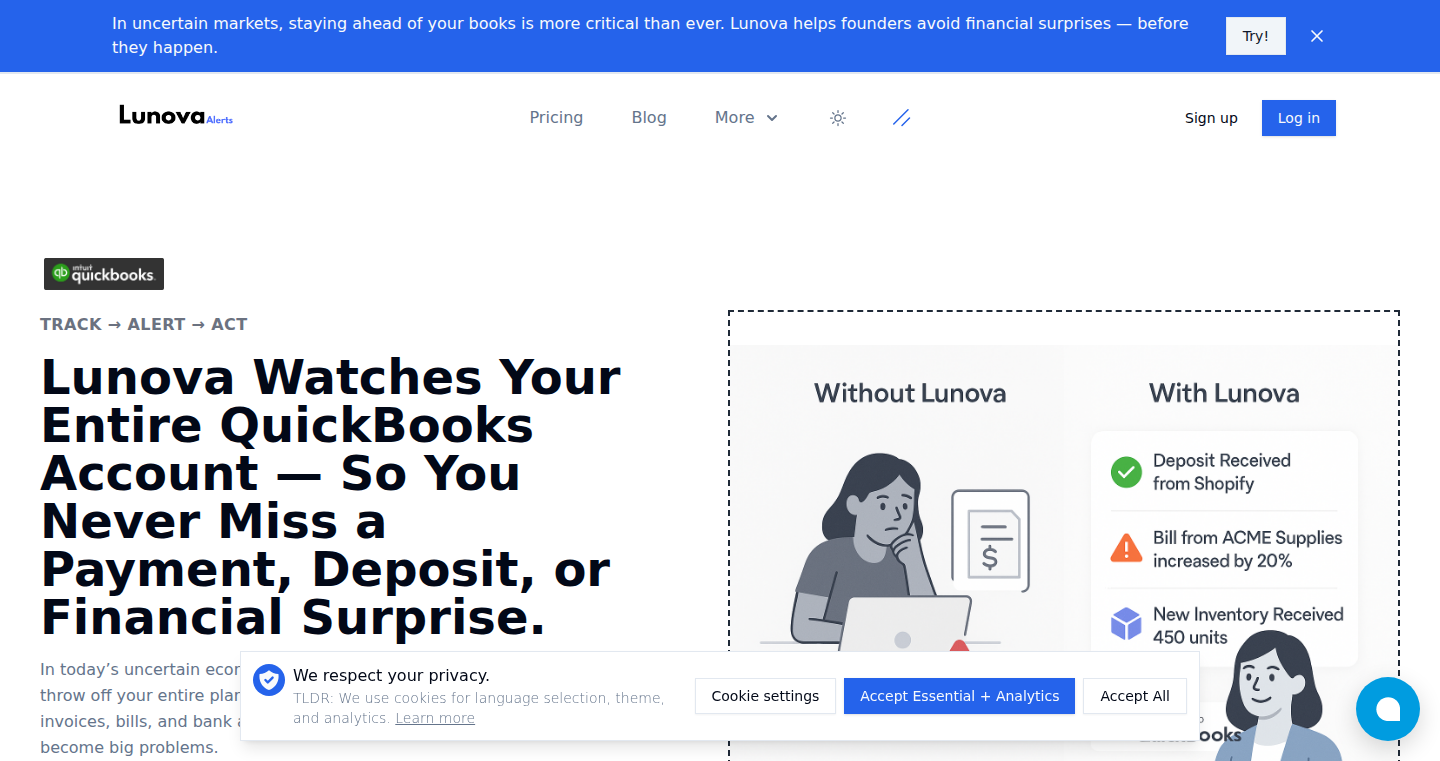
Author
chidog12
Description
Lunova is a custom alert system for QuickBooks, designed to send SMS or email notifications based on user-defined rules. This project tackles the problem of passively monitoring financial data. Instead of constantly checking QuickBooks, users set up rules (like 'trigger alert if a payment is overdue') and receive timely alerts. The core innovation lies in its rule-based engine, allowing flexible configuration and proactive financial monitoring, all without needing a full-fledged accounting software integration.
Popularity
Points 1
Comments 0
What is this product?
Lunova is a system that watches your QuickBooks data for things you care about, like overdue invoices or unusual transactions. It works by letting you create rules. For example, you could say, 'If an invoice is unpaid for more than 30 days, send me an email'. When the conditions of your rules are met, it automatically sends you a notification. The innovation is in its flexibility. You don't need to build a complicated, full-blown integration with QuickBooks. You can define the behavior of the notification system using simple rules, reducing the overhead of financial monitoring.
How to use it?
Developers can use Lunova by connecting it to their QuickBooks account. They would then define rules through a configuration interface – specifying which QuickBooks data to monitor (like invoices, payments, or expenses), the conditions that trigger alerts (e.g., amount exceeds $1000), and the contact method (SMS or email). Lunova would periodically check the data against these rules and send notifications when necessary. This approach is valuable because it allows to automate the monitoring process. So you can react quickly and prevent financial losses without the need of constantly checking reports manually.
Product Core Function
· Rule-Based Alerting: Allows users to create custom rules based on QuickBooks data. This is valuable because it enables users to focus on specific financial events relevant to them, saving time and improving financial oversight. This could be used to immediately alert about the overdue invoices.
· Data Monitoring: Regularly checks QuickBooks data against user-defined rules. This is valuable because it provides real-time insights into financial activity, enabling quick responses to critical situations, for example, it alerts to any payment of a certain amount or to an unexpected expenditure.
· Notification System: Sends SMS or email alerts when rules are triggered. This is valuable because it ensures timely communication, allowing users to take immediate action when important events occur. For example, it can alert the user to any suspicious behavior in the account.
Product Usage Case
· A small business owner can configure Lunova to alert them when invoices are overdue, helping them chase payments and improve cash flow. For example, a restaurant owner can create a rule to send them a text message immediately if payments reach overdue status.
· An accountant can use Lunova to monitor large transactions for any client, enabling them to quickly identify potential errors or fraudulent activity. For example, a consulting company can set rules to alert about expenses over a certain amount or from an unexpected vendor.
· A project manager can use Lunova to monitor project costs against budgets, getting alerted if expenses are exceeding the planned amounts, enabling to take quick corrective actions. For example, the product manager can set up alerts for any budget breaches.
80
FastPitchDeck: AI-Powered Pitch Deck Generator
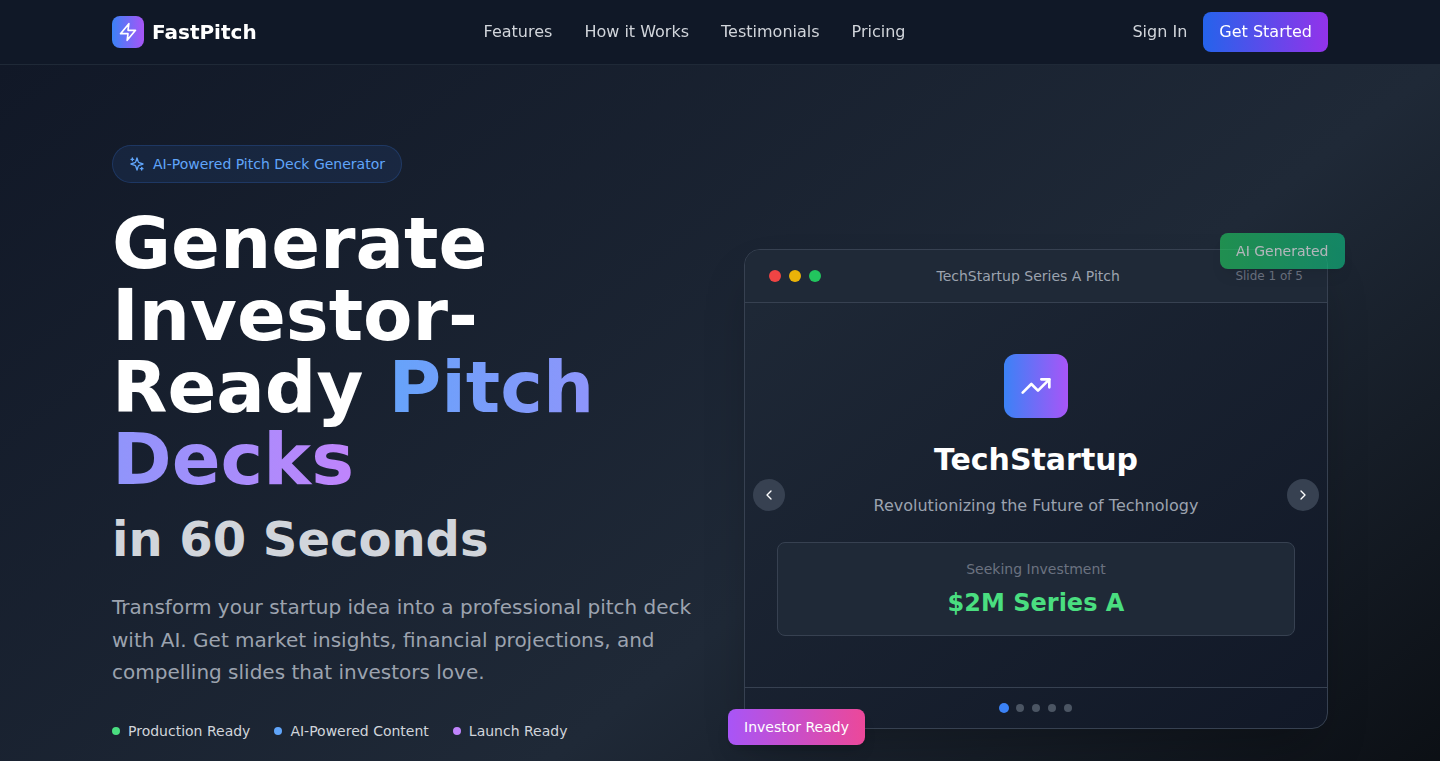
Author
ramyavarahagiri
Description
FastPitchDeck is an AI-powered tool designed to create investor-ready pitch decks in minutes. It tackles the common problem of founders spending excessive time on formatting and design instead of focusing on their messaging. The core innovation lies in its use of AI to suggest slide structures, auto-format content, and integrate live data, ensuring decks are always up-to-date and aligned with a startup's key metrics.
Popularity
Points 1
Comments 0
What is this product?
FastPitchDeck leverages Artificial Intelligence to simplify and accelerate the pitch deck creation process. It understands the best practices used by venture capitalists and suggests slide structures based on that knowledge. It auto-formats the content, eliminating the need for manual design adjustments. Moreover, it allows for live data integration from sources like Stripe or Google Analytics, ensuring the deck reflects the most current information. So what? This saves founders valuable time and effort, allowing them to focus on refining their story and securing funding.
How to use it?
Developers and founders can access FastPitchDeck through its web application. They can input their startup information and the AI will generate a preliminary deck outline. Users can then customize the slides, edit content, and connect to live data sources. The tool is designed to be collaborative, making it easy for multiple team members to contribute. So what? You can use it in your own project by just providing the necessary information. The rest can be automated.
Product Core Function
· AI-Powered Outline Generation: This feature analyzes best practices and generates a suggested structure for the pitch deck. This helps founders quickly create a compelling narrative. So what? It gives you a head start and guides you through the process, ensuring you cover the essential points that investors look for.
· One-Click Styling: Automated formatting capabilities, eliminating the need for manual design work. This makes the deck visually appealing without requiring design expertise. So what? You can focus on content instead of getting lost in the details of the design.
· Live Data Integration: Connecting slides to live data sources such as Stripe and Google Analytics. This keeps the deck up-to-date with the latest metrics. So what? It ensures the deck always reflects the most current performance data, building trust and credibility with investors.
· Collaborative Editing: The tool supports collaborative editing, making it easy for teams to work together on a pitch deck. So what? Team members can provide their inputs at the same time.
Product Usage Case
· Startup Fundraising: A startup founder preparing for a seed round can use FastPitchDeck to quickly create a compelling pitch deck that showcases their product and market opportunity. So what? They can get the pitch deck done in hours instead of days.
· Investor Meetings: When a founder needs to update their pitch deck with the latest metrics before an investor meeting. Using the live data integration feature, they can ensure that their deck always has the latest and most accurate data. So what? Save time and ensure accuracy in their presentation.
· Pitch Competitions: In preparation for a pitch competition, a team can use FastPitchDeck to quickly generate a high-quality presentation, which allows them to focus on the presentation instead of the design. So what? Founders can focus on the delivery and pitch, without the hassle of creating the deck.
81
Kichan.ai: Web Automation Script Generator
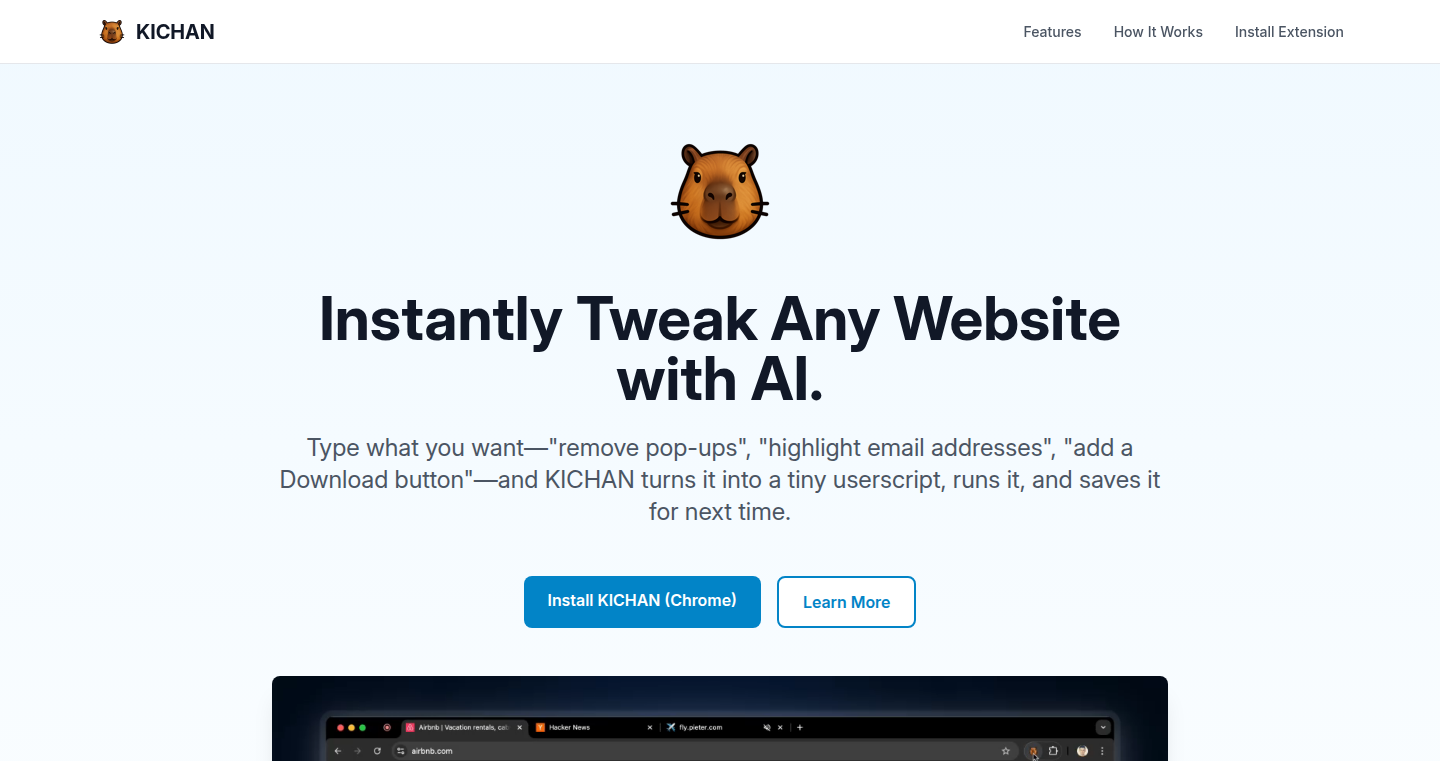
Author
k1rd
Description
This Chrome extension allows you to create custom scripts that modify and interact with web pages without writing any code. You give it instructions (prompts) or right-click on page elements to add context. The extension then generates a script and injects it into the webpage. This simplifies web automation, enabling users to automate tasks or customize web experiences easily. The innovation lies in its prompt-based approach and dynamic script generation, eliminating the need for users to write complex code.
Popularity
Points 1
Comments 0
What is this product?
Kichan.ai is like a smart assistant for web pages. You tell it what you want to happen (e.g., fill a form, click a button) using prompts or by selecting elements. It then automatically creates a script and runs it on the webpage. The core technology is the automated script generation based on user instructions. So it saves you time and effort, especially if you're not a programmer.
How to use it?
Install the Chrome extension. Right-click on elements you want to interact with or provide detailed prompts to the extension. The extension then generates and executes the script. You can then reuse the scripts or set them to run automatically. This is useful for automating repetitive tasks like filling forms, data extraction, and website customization.
Product Core Function
· Prompt-based script generation: The extension takes natural language prompts as input to generate the necessary scripts. This means you tell it what you want it to do instead of writing code. So, this saves you from learning to code.
· Element context collection via right-click: By right-clicking on specific elements on a web page, the extension captures the context needed for automation. This allows precise targeting of elements for automation. So, this simplifies interacting with specific parts of the web pages.
· Dynamic script injection: The generated scripts are injected and run directly in the target web pages, enabling real-time manipulation and interaction. So, this makes automation immediate and responsive.
· Reusable and auto-load scripts: Scripts can be saved and reused, or set to run automatically on specific web pages. This automates processes so you don't have to repeatedly do them yourself.
Product Usage Case
· Automated form filling: You can set up a script to automatically fill out online forms with your pre-defined information. So, this saves you time on repetitive data entry.
· Data extraction: Automate the process of extracting data from websites, such as product prices or stock information. So, this lets you gather information without manual effort.
· Website customization: Modify the appearance or behavior of websites to suit your preferences, such as hiding elements or changing the layout. So, this enhances your browsing experience.
82
BugBlaze: AI-Powered Code Debugging CLI
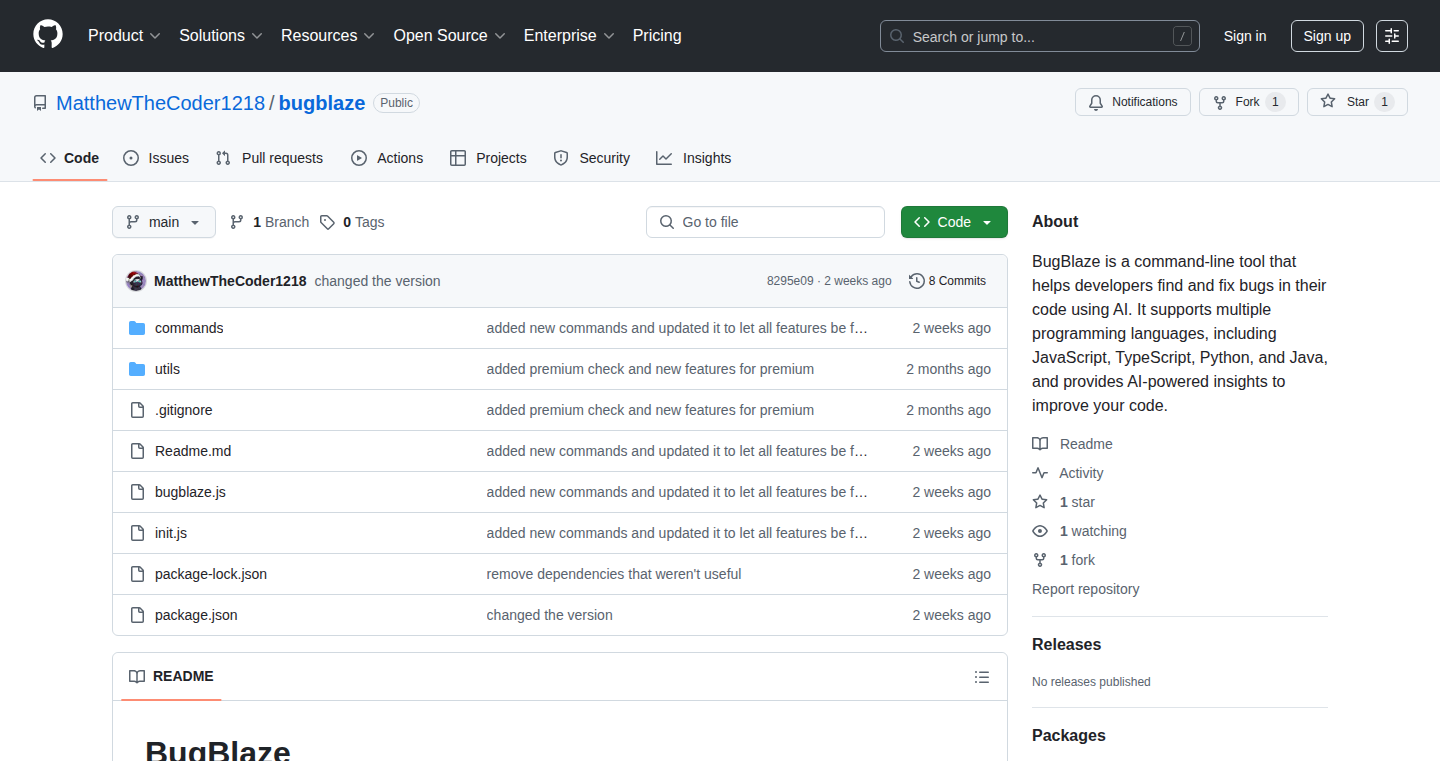
Author
lilprince1218
Description
BugBlaze is a command-line tool that uses AI to help developers understand, find, and fix bugs in their code. It integrates with various AI models (like Mistral via Groq) to provide explanations for errors, analyze code syntax and runtime issues, generate tests, documentation, and refactoring suggestions. It also offers a 'mentor mode' for step-by-step guidance and a 'health-scan' feature to proactively identify potential problems in the codebase. The core innovation lies in automating the debugging process by leveraging AI to mimic the expertise of a senior engineer, right in your terminal.
Popularity
Points 1
Comments 0
What is this product?
BugBlaze is essentially an AI-powered assistant for developers, accessible directly from the command line. It takes your code and uses AI to understand what's going wrong, why it's happening, and how to fix it. It's like having a smart coding buddy that can analyze your code, explain errors in plain English, suggest ways to improve your code, and even generate tests to ensure everything works as expected. The magic happens by combining the power of AI models like Groq (Mistral) with a simple command-line interface. So this is useful because it speeds up debugging, makes code easier to understand, and helps developers write better code faster.
How to use it?
Developers can use BugBlaze by installing it via npm and then running commands in their terminal. For example, to understand an error in a JavaScript file, you'd type `bugblaze explain path/to/file.js --explain`. To generate tests for a file, you'd use `bugblaze generate tests path/to/file.js`. The tool supports JavaScript, TypeScript, Python, Java, and JSX/TSX. To get started, simply install it globally using npm. You can use it in any development workflow where you're writing and debugging code, whether you're working on a small personal project or a large enterprise application. So this enables you to debug code quickly, and learn from the AI explanations.
Product Core Function
· Explain Errors with AI: BugBlaze uses AI to analyze your code and explain the causes of errors in simple language. This saves developers time and effort by eliminating the need to manually debug or search for solutions. So this lets you understand errors faster.
· Syntax and Runtime Analysis: The tool can analyze code for syntax errors and runtime issues, providing insights into potential problems before they become critical. This proactive approach helps prevent bugs and improves code quality. So this helps find bugs before they happen.
· Generate Tests, Docs, and Refactors: BugBlaze can automatically generate unit tests, documentation, and refactoring suggestions, saving developers from the tedious tasks of writing repetitive code and improving code maintainability. So this automates common development tasks.
· Health Scan: The health-scan feature proactively scans the codebase for potential issues like code complexity and vulnerabilities, providing a quick overview of areas that may need attention. This promotes better code quality. So this helps you find potential problems in your code.
· AI Mentor Mode: This feature provides context-aware, step-by-step guidance, acting as a virtual mentor to assist developers with debugging and coding tasks. So this acts as a virtual senior developer to help you understand your code.
· Interactive AI Chat: Developers can use the chat feature to interact with AI models for debugging and coding assistance. This is useful because it acts as a personal AI coding expert.
Product Usage Case
· Debugging a JavaScript Web Application: A developer encounters an error message in their React app. Using `bugblaze explain path/to/error.js --explain`, BugBlaze analyzes the code and explains the root cause of the error in plain language, helping the developer quickly understand and fix the issue. So this helps web developers debug their code faster.
· Improving Code Quality in a Python Project: A Python developer runs `bugblaze health-scan` on their project and identifies high code complexity in a specific module. They then use the tool's suggestions to refactor the module, improving its readability and maintainability. So this helps Python developers write cleaner and more maintainable code.
· Generating Unit Tests for a Java Class: A Java developer uses `bugblaze generate tests path/to/class.java` to automatically generate unit tests for a complex class. This saves time and ensures thorough testing of the code. So this enables faster development of tests.
83
ChromeDevTools MCP Wrapper
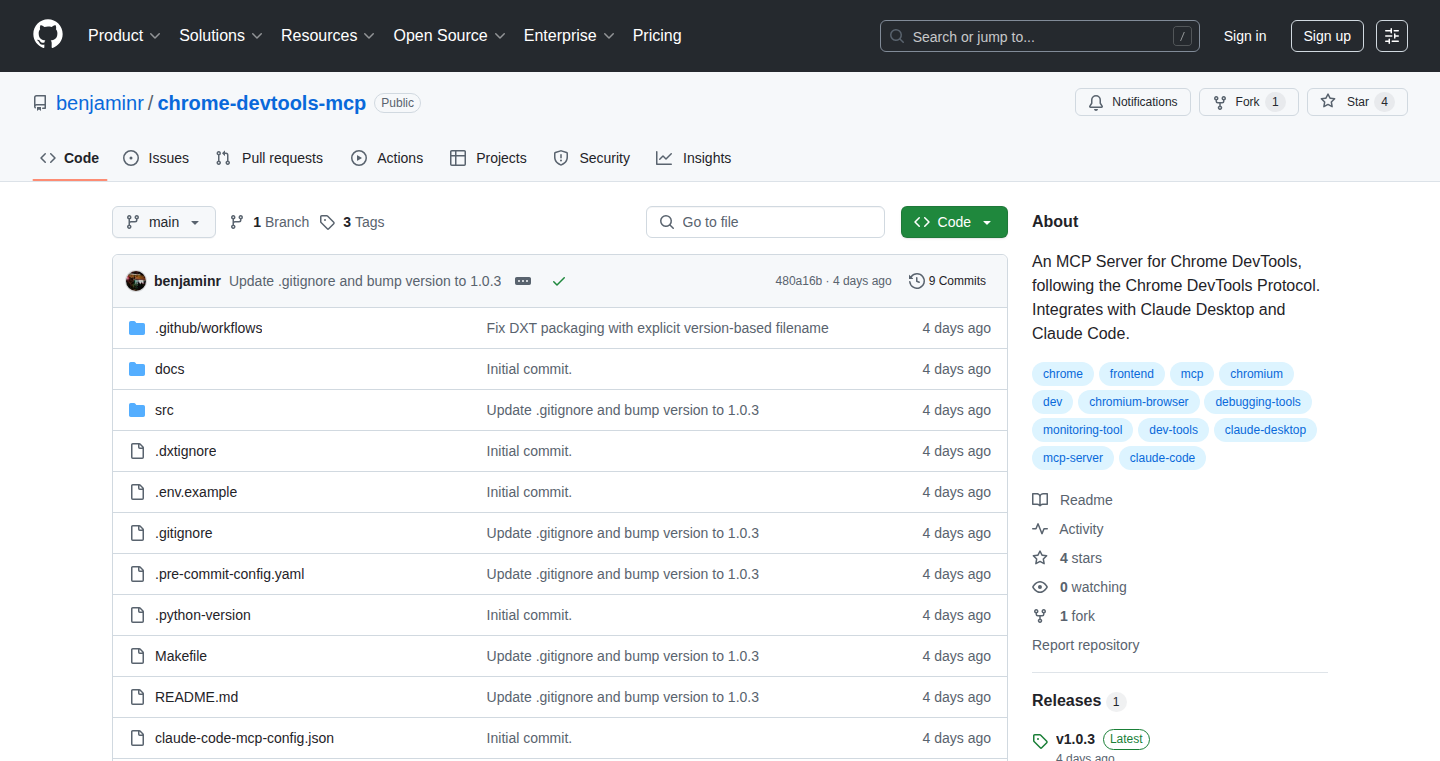
Author
benrr
Description
This project creates a server that acts as a 'wrapper' or 'translator' for the Chrome DevTools Protocol (CDP). It allows developers to interact with and control Chrome (or any Chromium-based browser) using the MessagePack (MCP) data format. The innovation lies in using MCP, a more efficient and compact data serialization format than the traditional JSON used by CDP. It helps developers to work with Chrome's internal workings easily. So, if you're a developer, this means faster communication and less overhead when debugging or automating browser tasks.
Popularity
Points 1
Comments 0
What is this product?
This project takes the standard Chrome DevTools Protocol (CDP), which uses JSON to communicate with a browser for debugging and automation, and wraps it in MessagePack (MCP). Think of it like converting a complex language (JSON) into a more streamlined and compact one (MCP). MCP is known for its efficiency, making data transfers faster and reducing the amount of data needed to be sent. This project exposes the browser's control interface over MCP, making it easier for developers to automate browser tasks, debug web applications, and build browser-based tools. So, you get a faster and more efficient way to interact with Chrome.
How to use it?
Developers can use this by setting up a server that listens for MCP-formatted messages. They can then send commands to the server, which in turn communicates with the Chrome browser using CDP. The responses from the browser, also in MCP format, are then relayed back to the developer. This allows developers to control the browser remotely or automate tasks. For example, you could automate UI testing, take screenshots, or monitor network traffic. You would connect to this server from your test scripts or automation tools. So, you can integrate it into your automation and debugging workflows easily.
Product Core Function
· MCP-based communication with Chrome: The core functionality is to use the efficient MessagePack data format for all communication with Chrome, instead of the default JSON. Value: This significantly reduces the size of the data exchanged, leading to faster performance and lower network overhead. Application: Ideal for performance-critical applications, especially when dealing with high volumes of browser interactions or when network bandwidth is limited. So this makes interactions faster.
· Chrome DevTools Protocol Compatibility: It still works with the Chrome DevTools Protocol. Value: It enables all the features of the Chrome DevTools Protocol to be used, such as inspecting the DOM, setting breakpoints, monitoring network requests, etc. Application: Great for debugging and inspecting websites remotely, creating testing scenarios, and automating browser interactions, providing the same functionalities, but using a more efficient communication method. So, you still get all the features you are used to.
· Server-side implementation: The server provides a way for developers to interact with chrome. Value: The server acts as an intermediary, decoupling the control logic from the browser itself. Application: Enables the creation of browser automation tools, remote debugging solutions, and other applications that need to control or interact with a Chrome browser without direct access to the browser's user interface. So, you can run your programs without interacting with the browser directly.
Product Usage Case
· Automated UI testing: Developers can write scripts to automate UI testing of web applications. These scripts can send commands to the MCP server, which then interacts with the Chrome browser to perform tasks like clicking buttons, filling in forms, and verifying the content. So, you can easily test your websites and applications automatically.
· Remote debugging: Developers can use the MCP server to debug web applications running on remote devices. They can inspect the DOM, set breakpoints, and monitor network requests, as if they were debugging locally. So, it makes debugging much easier.
· Browser automation: Developers can create bots to automate tasks such as web scraping, data extraction, or web application monitoring. These bots can use the MCP server to control the Chrome browser and interact with web pages. So, it is an easy tool to work with automation.
84
DXT Registry: Unified MCP Server List
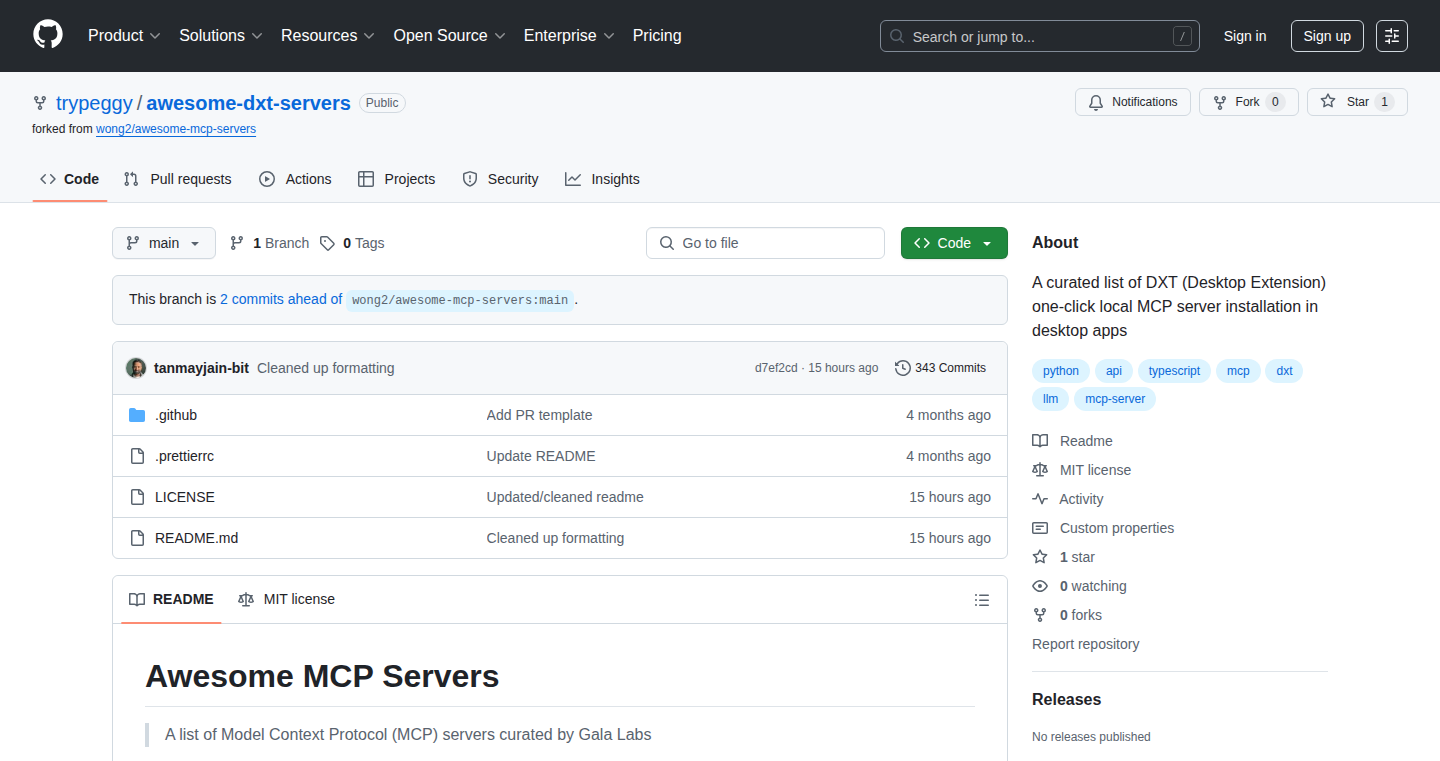
Author
tanmay-gala
Description
This project creates a central, easy-to-access list of good MCP servers (specifically for DXT, the latest step from Anthropic's MCP). It solves the problem of scattered and outdated server lists by providing a single, up-to-date resource. The innovation lies in its simplicity: a GitHub-based registry for one-click MCP install, making it easier for developers to find and use the best servers. This leverages the power of open-source collaboration and GitHub's infrastructure.
Popularity
Points 1
Comments 0
What is this product?
This is a curated list of DXT-ready MCP servers. Instead of searching through various sources or dealing with outdated information, developers can find the servers they need in one place. The technology is based on GitHub, using its platform as a registry. Users contribute to the list, which is a simple text file, making it easily maintainable and accessible. So, it's a simple, community-driven solution to server discovery.
How to use it?
Developers use this by referencing the GitHub repository. They can find the list of available servers, each entry pointing to a specific MCP server. It works by providing a single source of truth for discovering DXT-ready servers. Developers can then use these servers for their projects. Think of it as a phone book for servers; you find the right number (server address) and then connect to it. So, you integrate it by simply referencing the list and using the server addresses provided.
Product Core Function
· Centralized Server Listing: Provides a single, reliable source for finding compatible DXT-ready servers. This eliminates the need to search multiple, potentially outdated sources. So, it saves time and ensures you're connecting to the correct servers.
· Community-Driven Updates: Uses a GitHub repository, which encourages community contributions to keep the list fresh and accurate. This means the list stays up-to-date with the latest server information. So, you benefit from the collective knowledge and effort of the community.
· Easy Access and One-Click Install: The GitHub format allows for easy navigation and integration. The one-click install aspect simplifies the connection process. So, it's designed for ease of use, letting you quickly get started.
· Simple and Lightweight: The project's core is a simple text file on GitHub. This keeps it easy to understand, maintain, and scale. No complex infrastructure is required. So, it ensures the project is fast, reliable and easily accessible.
Product Usage Case
· AI Model Development: Developers working with AI models can quickly find DXT-compatible servers to test and deploy their models, streamlining the development process. So, you can use this to quickly find appropriate infrastructure for running AI models.
· Research Projects: Researchers studying AI or other related fields can use this registry to find the best servers for their experiments, reducing the time spent on infrastructure setup. So, it helps in quickly setting up the required infrastructure for the research.
· Project Setup and Configuration: When starting a new project that requires access to DXT servers, developers can use this registry to quickly configure their environment. So, it makes the setup of new projects that depend on DXT servers much quicker.
85
ExcelFormulas.co - A Minimalist Excel Formula Lookup Engine

Author
coolpool
Description
This project is a clean and fast online tool (excelformulas.co) designed to quickly look up Excel formula syntax and explanations. It directly addresses the problem of sifting through lengthy documentation or video tutorials to find the correct syntax for Excel formulas. The innovation lies in its minimalist design and focus on providing concise, plain-language explanations, making it a user-friendly resource for Excel users. So this is useful to save time and frustration when working with Excel.
Popularity
Points 1
Comments 0
What is this product?
This is a simple website where you can search for Excel functions and get their syntax and plain-language explanations. It uses a streamlined approach, stripping away the extra information often found on official documentation sites, which can be overwhelming. The core technology is likely a database or structured text files containing formula information, coupled with a search engine to quickly find relevant results. So this helps you find formulas quickly, without the noise.
How to use it?
Developers can use excelformulas.co by simply going to the website and searching for the Excel function they need. They can also browse functions by category. It's great for developers who frequently work with data in Excel, or anyone who uses Excel formulas and wants to quickly find the right syntax and understand how they work. So this is a quick reference guide while you're building a spreadsheet.
Product Core Function
· Formula Search: Allows users to search for specific Excel formulas by name or keyword. This saves time compared to manually browsing documentation.
· Syntax Display: Presents the formula's syntax in a clear and concise format. It prevents errors while using Excel.
· Plain-Language Explanations: Provides easy-to-understand explanations of what each formula does, avoiding technical jargon.
· Categorized Browsing: Allows users to browse common formulas by category, helping them discover formulas they might not know existed. Helps to improve efficiency for Excel users.
Product Usage Case
· Data Analysis: When analyzing large datasets in Excel, developers can quickly look up formulas for tasks like calculating averages, sums, or identifying specific data points. This is especially helpful when you need to analyze a large table of data.
· Report Generation: When creating reports, users can use the tool to find formulas for generating charts, conditional formatting, or summarizing data. It helps ensure reports are accurate.
· Automation: Developers can use this to build more automated spreadsheets. It's helpful when needing to generate different kinds of charts with data.
86
Fume Protocol: Automated On-Chain Fund Administration
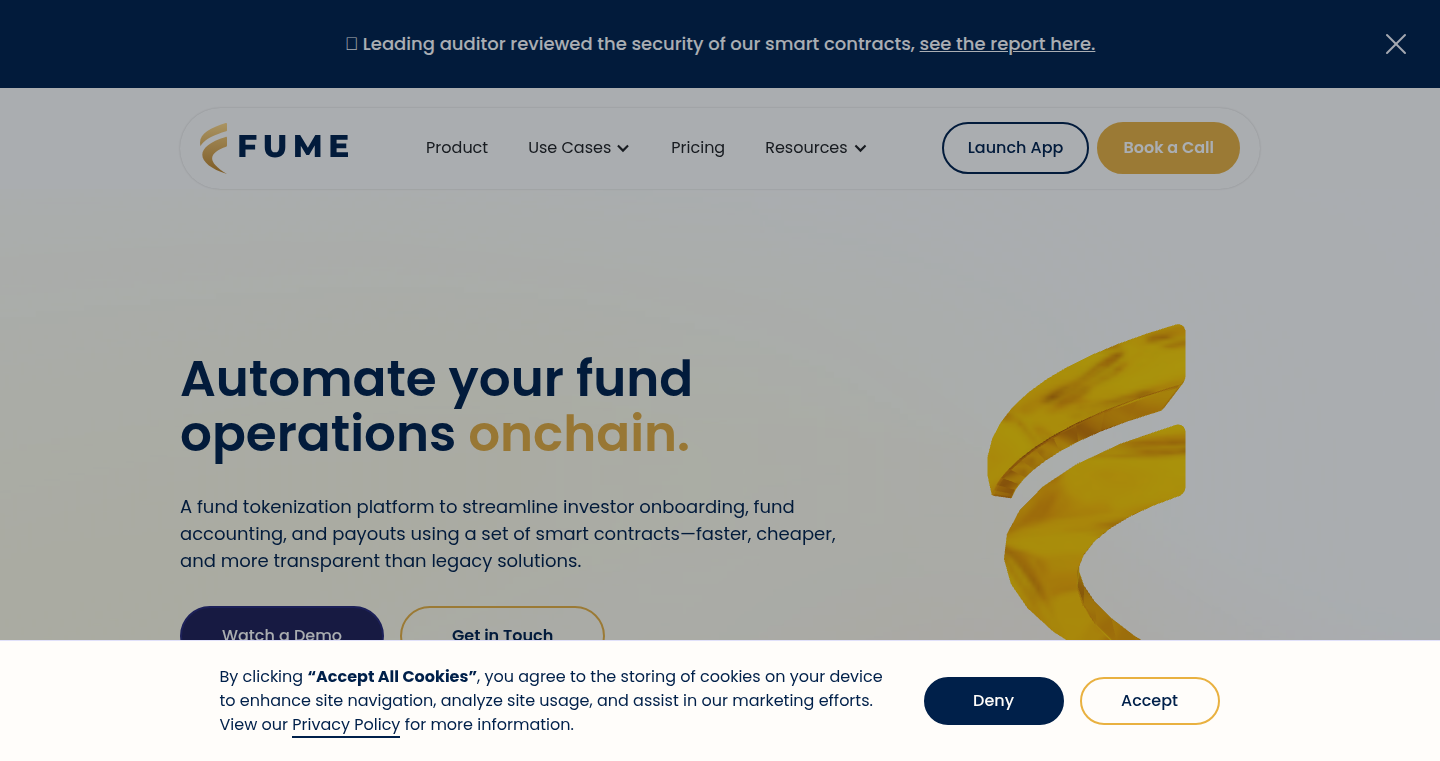
Author
fume_protocol
Description
Fume Protocol is an EVM-based protocol that automates the administration of investment funds using smart contracts and stablecoins. It addresses the cumbersome administrative tasks associated with traditional fund management, such as fund unit tokenization, net asset value (NAV) calculations, fee extraction, and distributions. This is achieved through a single-click operation, offering efficiency and transparency. So this automates and simplifies the complicated process of managing investment funds.
Popularity
Points 1
Comments 0
What is this product?
This is a protocol built on the Ethereum Virtual Machine (EVM) designed to streamline fund administration. The core innovation lies in its use of smart contracts to automate previously manual processes. It tokenizes fund units, meaning it creates digital representations of ownership that can be easily traded. It also makes instant NAV calculations, which is the value of the fund per unit, allowing for up-to-date valuation. Furthermore, it automatically extracts fees and handles distributions to investors. So this eliminates the need for manual calculations and reduces the potential for errors, making fund management more efficient and transparent.
How to use it?
Developers and asset managers can use the Fume Protocol to automate their fund administration. This could involve integrating the protocol into their existing fund structures. The protocol's smart contracts handle the complexities of tokenizing fund units, calculating NAV, and managing distributions. The integration process likely involves deploying and configuring the smart contracts to match the specific requirements of the fund. So, developers can create tools and interfaces that leverage the protocol's features, providing users with automated and transparent fund management solutions.
Product Core Function
· Tokenization of Fund Units: The protocol creates digital tokens representing fund ownership. This allows for easier trading, fractional ownership, and increased liquidity. So this is great for making funds accessible to a wider audience and simplifying trading.
· Instant NAV Calculations: It performs real-time net asset value calculations, providing up-to-the-minute valuations. This ensures accurate and transparent fund pricing. So you can get immediate feedback on how the fund is performing without waiting on delayed reports.
· Automated Fee Extraction: The protocol automatically deducts fees according to pre-defined rules encoded in the smart contracts. This increases transparency and reduces the potential for manipulation. So this ensures fees are always handled fairly and automatically.
· Automated Distributions: The protocol handles the distribution of earnings to fund participants. This streamlines the distribution process, making it faster and more reliable. So investors get their payouts quicker and more efficiently.
Product Usage Case
· Decentralized Investment Funds: Creating fully decentralized investment funds where all operations, including unit issuance, NAV calculation, and distributions, are automated on-chain. So this provides a transparent and verifiable fund operation.
· Tokenized Venture Capital: Applying the protocol to tokenized venture capital funds, offering a more liquid and accessible way to invest in early-stage companies. So this helps venture capital to be more accessible and less complex.
· Automated Portfolio Rebalancing: Using the protocol to create automated portfolio rebalancing strategies, based on smart contract conditions and triggers. So this makes the process of rebalancing more efficient and less costly.
87
FlowMolio: Figma to Live Data Previews
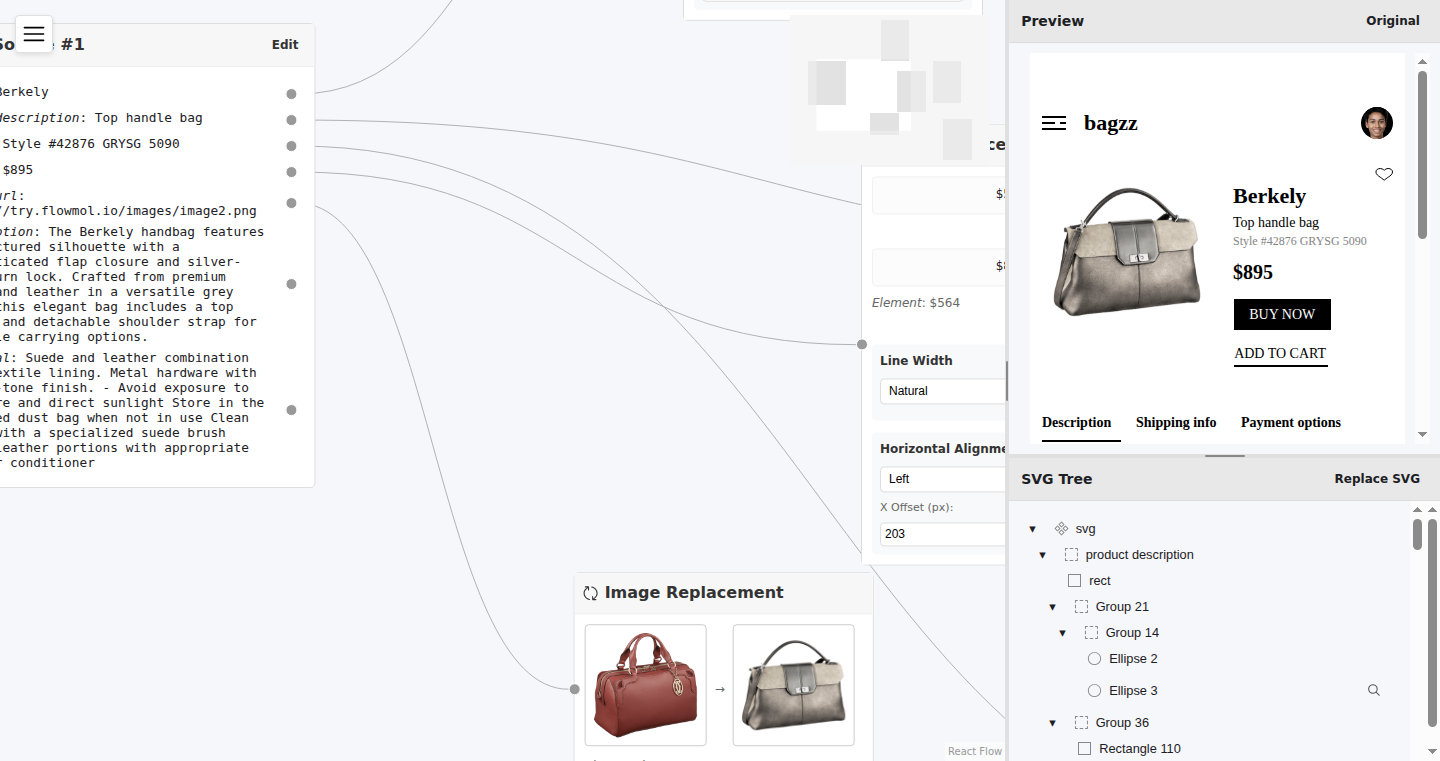
Author
crivlaldo
Description
FlowMolio is a no-code tool that transforms Figma mockups into live, interactive previews connected to your APIs. It addresses the common problem of visualizing dynamic data within mobile app designs, a challenge often faced when working with headless CMS (Content Management Systems). Instead of relying on cumbersome methods like exporting Figma designs as React components, FlowMolio allows you to export your design as SVGs, visually connect data fields from your APIs, and instantly see real-time previews with actual content. This significantly streamlines the development process, reducing the effort required to integrate designs with dynamic data sources.
Popularity
Points 1
Comments 0
What is this product?
FlowMolio is essentially a visual editor that bridges the gap between your Figma designs and your application's live data. It leverages the power of SVG (Scalable Vector Graphics) exported from Figma, enabling you to treat your design as a canvas. You can then visually map data fields from your APIs onto specific elements within your design. Behind the scenes, it utilizes technologies like xyflow/react, react-complex-tree, and zustand for its editor functionalities, along with extensive unit tests to ensure stability. So, what's the value? You get instant previews of your designs populated with real-world data, making it easier to iterate and refine designs before any actual coding is done. This also speeds up development for non-technical users. For instance, if your design has a product name field, you can connect that field to the product name from your API, and when the API updates, the preview also updates.
How to use it?
Developers integrate FlowMolio previews into their projects with a simple code snippet. The `dataSources` parameter allows you to pass in your data (e.g., product details from an API), and the `blueprint` parameter refers to the saved configuration from FlowMolio. This means, in a mobile app, you can use it like `<FlowMolioPreview dataSources={{"product": productDetails}} blueprint={savedBlueprint} />`. The process is as follows: 1) Design in Figma. 2) Export design to SVG. 3) Use FlowMolio's editor to connect data fields from APIs to the visual elements in your design. 4) Save the configuration (blueprint). 5) Integrate the saved blueprint and data sources in your app. So, if you want a live preview in your mobile app, you can visualize the design with actual data from your API.
Product Core Function
· Visual Data Mapping: FlowMolio allows you to visually connect your Figma design elements (like text boxes, images, etc.) to data fields from your APIs. This eliminates the need to manually code data bindings. So, this means you can see your designs populated with real data without writing code.
· Real-time Preview: As data changes in your API, the previews within FlowMolio update in real-time. You can see how your design responds to different data scenarios instantly. This improves the iteration process.
· No-Code Editor: The user-friendly editor allows designers and developers to visually configure data connections without writing code. It simplifies the process of integrating designs with dynamic data.
· SVG-Based Rendering: It leverages the flexibility of SVG, which allows for scalability and easy integration with various platforms. So, your designs look great on any screen, and it's easy to change the size without losing quality.
· Blueprint Export: The editor saves the data connections in a 'blueprint' file, enabling easy integration of live previews into your applications.
· Integration via Simple Snippet: The live preview is incorporated into your application with a simple code snippet using components from the tool itself. So, you don’t have to learn new complex frameworks to use the feature.
Product Usage Case
· Mobile App Development: A mobile app development team can design the product detail page in Figma. Using FlowMolio, they can then connect the product name, price, and image fields to the API. This enables them to visualize the page with actual product data without writing code.
· E-commerce Product Pages: E-commerce businesses can use FlowMolio to preview product listings directly from their product catalogs. When the price of a product changes in the database, the preview automatically updates, showing the latest price.
· CMS Integration: Developers integrating with a headless CMS can use FlowMolio to visualize data retrieved from the CMS in a design. For example, they could create a blog post template and preview it with real blog post content.
88
PDFtoLink.app - Instant PDF Link Generator
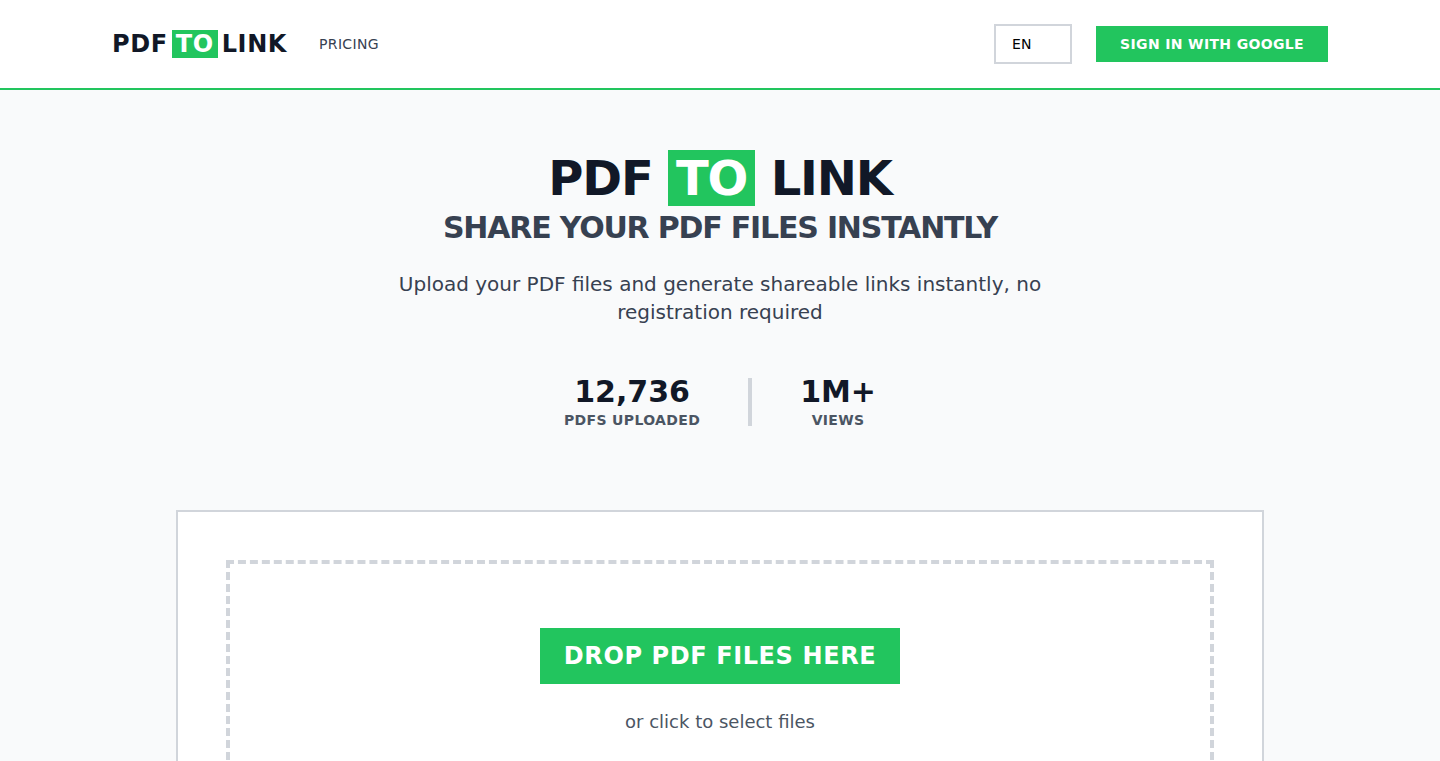
Author
Airyisland
Description
PDFtoLink.app is a simple web application that lets you upload PDF files and instantly generate shareable links. It leverages cloud storage and a lightweight web server to provide quick and easy PDF sharing without requiring user registration. The core technical innovation lies in its streamlined architecture, focusing on immediate functionality and user experience, offering a hassle-free way to share PDF documents.
Popularity
Points 1
Comments 0
What is this product?
PDFtoLink.app is a web application that takes your PDF files and provides a shareable link immediately. It's like having a virtual file hosting service that's incredibly easy to use. The technology behind it involves uploading the PDF to a cloud storage service, and then creating a unique web link to access the PDF. The innovation is in the simplicity; there's no account creation, no complex setup, just upload and share. So what? So it's a quick and easy way to share documents with anyone.
How to use it?
Developers can use PDFtoLink.app to quickly share documentation, reports, or any PDF-based resources within their projects or with their teams. Simply upload the PDF file and share the generated link. For example, you could easily share API documentation or project specifications with collaborators without having them install any software. You could even use it to quickly share mockups or designs. So what? So it simplifies communication and collaboration by providing a straightforward file-sharing mechanism.
Product Core Function
· Instant PDF Upload: The ability to upload a PDF file directly and initiate the linking process without delay. This is valuable because it saves time and streamlines the user experience.
· Shareable Link Generation: Upon upload, the application generates a unique, public-facing URL for the uploaded PDF. This feature offers instant access and ease of distribution.
· No Registration Requirement: Users can upload and share PDF files without creating an account. This increases usability and simplifies the user's experience, getting rid of the friction of account sign-ups.
· Cloud Storage Integration: The app uses cloud storage services (like AWS S3, Google Cloud Storage or similar) to host uploaded PDFs. This gives PDFtoLink.app a scalable and reliable infrastructure for storing and serving files.
· Lightweight Web Server: The front-end web server provides quick access to the hosted PDF files. This ensures a responsive user experience and minimal loading times.
Product Usage Case
· Sharing project documentation: A software development team can use PDFtoLink.app to quickly share project specifications with the team or client, eliminating the need for email attachments or complex file-sharing platforms.
· Distributing reports: A data scientist can upload reports and share the generated links with colleagues or stakeholders for review and feedback. Easy sharing helps speed up the feedback loop and overall project timeline.
· Sharing design mockups: A UI/UX designer can share design mockups as PDFs with the development team for implementation, providing easy access and instant availability.
· Collaborating on legal documents: A lawyer can easily share legal documents with their clients for review and comments. No need for email attachments or bulky uploads, just the link.
89
PG Essay Navigator: Interactive Knowledge Maps for Paul Graham's Essays
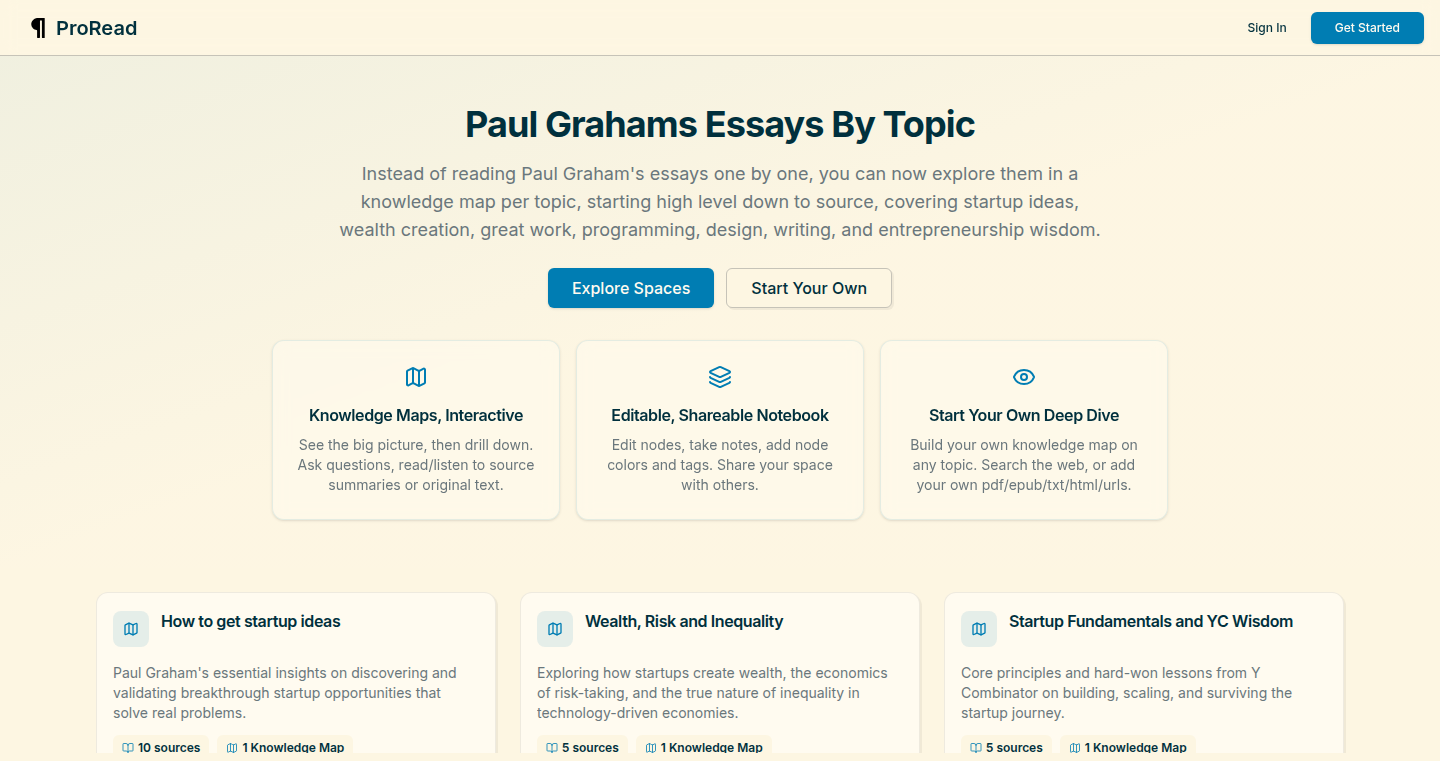
Author
kanodiaashu
Description
This project transforms Paul Graham's essays into interactive, topic-based knowledge maps. It tackles the problem of scattered information by organizing key insights from over 200 essays into interconnected maps. Users can explore relationships between ideas, use AI-powered Q&A for deeper understanding, and even create their own maps. The core innovation lies in the visual representation and the AI-driven interaction, making it easier to grasp the big picture and explore specific concepts. So this is useful because it helps you understand complex ideas more easily and quickly, instead of spending hours reading essays.
Popularity
Points 1
Comments 0
What is this product?
This project uses a combination of techniques. It first analyzes Paul Graham's essays, identifying key topics and concepts. Then, it organizes these concepts into hierarchical maps, creating a visual representation of how ideas relate to each other. The maps use a technology that allows users to click and drill down into specific ideas and source material. Furthermore, an AI chatbot allows users to query these maps. It helps users explore these maps, ask questions about specific topics and get insights from the original essays. So, instead of reading a huge pile of text, you get a helpful map and a chatbot that can answer your questions.
How to use it?
Developers can use this project as a model for organizing and visualizing large bodies of text. They could adapt the mapping and AI-driven interaction features to other contexts, like research papers, company documents, or even their own notes. To use it, you can go to the website and navigate the maps. You can click on different concepts to see how they relate to each other, or ask the AI chatbot any question about the concepts. Also you can create your own map with PDFs and URLs. This is really useful for anyone who needs to make sense of a lot of information.
Product Core Function
· Interactive Knowledge Maps: The core feature is the interactive maps. These maps visualize the connections between different concepts in Paul Graham's essays, creating a clear overview of his ideas and making it easier to understand the relationships between concepts. So you can see how different ideas are connected.
· AI Q&A: It uses an AI chatbot that can answer your questions about the content within the maps. This functionality allows users to explore concepts in detail and get insights directly from the source material. So you can ask questions and get answers directly from the information.
· Clone and Annotate Collections: Users can copy existing knowledge maps and modify them. This feature allows for personalized learning and knowledge management, enabling users to add their own notes, insights, and research. So you can create your own map based on existing ones.
· Custom Knowledge Map Creation: The project allows you to create knowledge maps based on various resources such as PDFs, URLs, or even web searches. It allows you to tailor the information to your specific needs and interests. So you can create your own map with documents you want to study.
Product Usage Case
· Research Paper Organization: Imagine you have hundreds of research papers. You can use the principles of this project to create maps that show the connections between different papers and their concepts. This helps you to grasp the information faster and more efficiently. So, if you are a researcher, you can grasp complex ideas more easily.
· Company Knowledge Base: A company could apply this project to organize internal documents, like project plans, customer data, or training materials. Interactive maps help employees find relevant information and understand the relationships between different company processes or products. So you can create internal map for your organization.
· Personal Note-Taking System: If you are a student, you can use this project's principles to organize your notes and study materials. You could create mind maps that show how different concepts relate to each other, making it easier to understand and remember the material. So you can study more efficiently.
90
Photo2Vector: The Image-to-Cartoonizer
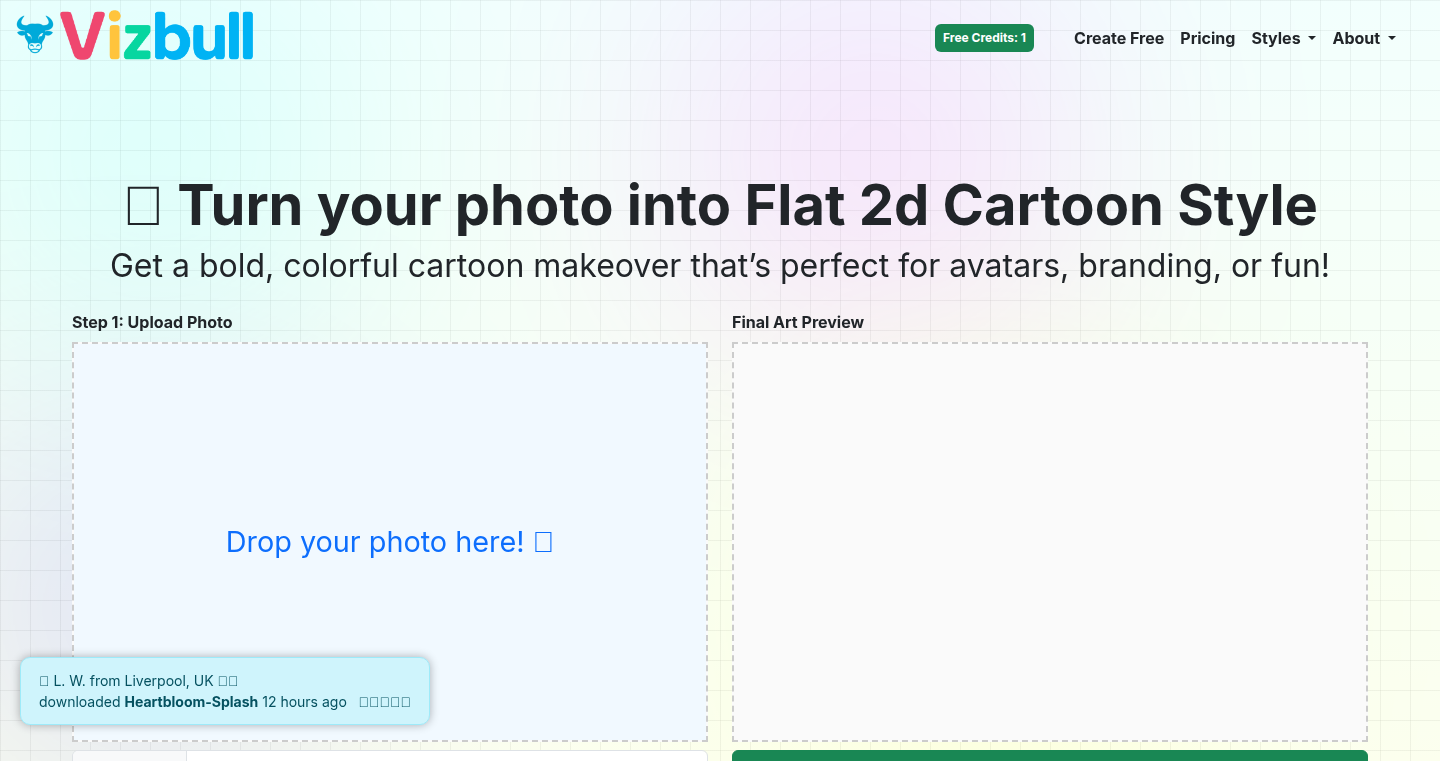
Author
rkj93
Description
This project converts a photo into a flat, cartoon-style vector graphic. It leverages image processing techniques to detect edges, simplify colors, and generate scalable vector graphics (SVGs). The innovation lies in its automated approach to stylistic image transformation, offering a quick and easy way to create stylized artwork from photos. It tackles the problem of manually tracing images or using complex graphic design software, simplifying the process for both technical and non-technical users. So, what does this do for me? It gives you a simple way to turn your photos into cool cartoon-like images instantly.
Popularity
Points 1
Comments 0
What is this product?
Photo2Vector is a tool that uses algorithms (a set of instructions for a computer) to analyze a photograph and redraw it as a vector graphic. The project uses edge detection (finding the outlines of objects in the photo), color simplification (reducing the number of colors), and vectorization (creating lines and shapes instead of pixels). The innovative part is the automation: the whole conversion process happens automatically, meaning you don't need to manually trace the image. This removes the need for expensive design software and simplifies the artistic process. So, what does this do for me? It's like having a quick and easy way to turn a photo into a cartoon.
How to use it?
Developers can use this project by integrating it into their applications or websites. They might use the project's code as a library or service. This would allow them to offer image-to-cartoon conversion as a feature within their own projects. Imagine a photo editing app or a website that lets users stylize their profile pictures. The integration process will involve calling the project's functions, providing the photo as input, and retrieving the resulting vector graphic (usually in SVG format). So, what does this do for me? Developers can use the project's functions to add image-to-cartoon functionality to their own apps, making them more versatile and user-friendly.
Product Core Function
· Edge Detection: Identifying the boundaries of objects in the image. Technical value: This is the foundation for creating the cartoon-like outlines. Application: Allows users to create outlines in the cartoon style, which would let their images have more depth and detail. It is useful for many applications where visual style is important, like profile pictures or posters.
· Color Simplification: Reducing the number of colors used in the photo to a limited palette. Technical value: This simplification gives the flat, cartoon style appearance. Application: For developers looking to create a cartoon aesthetic, or users who want their photos to appear less photorealistic and more stylized.
· Vectorization: Converting the image into a series of mathematical descriptions of lines and shapes (vectors). Technical value: This enables the resulting image to be scaled to any size without losing quality. Application: The result images can be used to produce high-resolution posters, website graphics, or be incorporated into other applications where scalability is important.
· SVG Output: Producing a Scalable Vector Graphics (SVG) file. Technical value: SVG is a widely used format for vector graphics that is supported by web browsers and many design tools. Application: SVG files can be used on the web and in print, providing flexibility and high quality for any size.
Product Usage Case
· Web Development: A developer integrating Photo2Vector into a website could allow users to convert their profile pictures into cartoon avatars. This enhances user experience and adds a playful element. The main technical advantages here are the automated processing of images and scalability of the SVG output. So, what does this do for me? It provides your users with a fun and attractive method of displaying their photos.
· Mobile App Development: A photo editing app could use Photo2Vector to offer a cartoon filter to its users. This would compete with similar filter options. The integration is simple, and the result delivers an enjoyable, unique experience. So, what does this do for me? Helps you develop user-friendly apps with unique features without dealing with all the complex image processing.
· Graphic Design: A designer could use Photo2Vector as a starting point for creating illustrations. They could then modify the generated vector graphic to refine the style and create custom artwork quickly. So, what does this do for me? It helps designers speed up the process of producing artwork.
91
ColorPal: A Simple Color Palette Generator
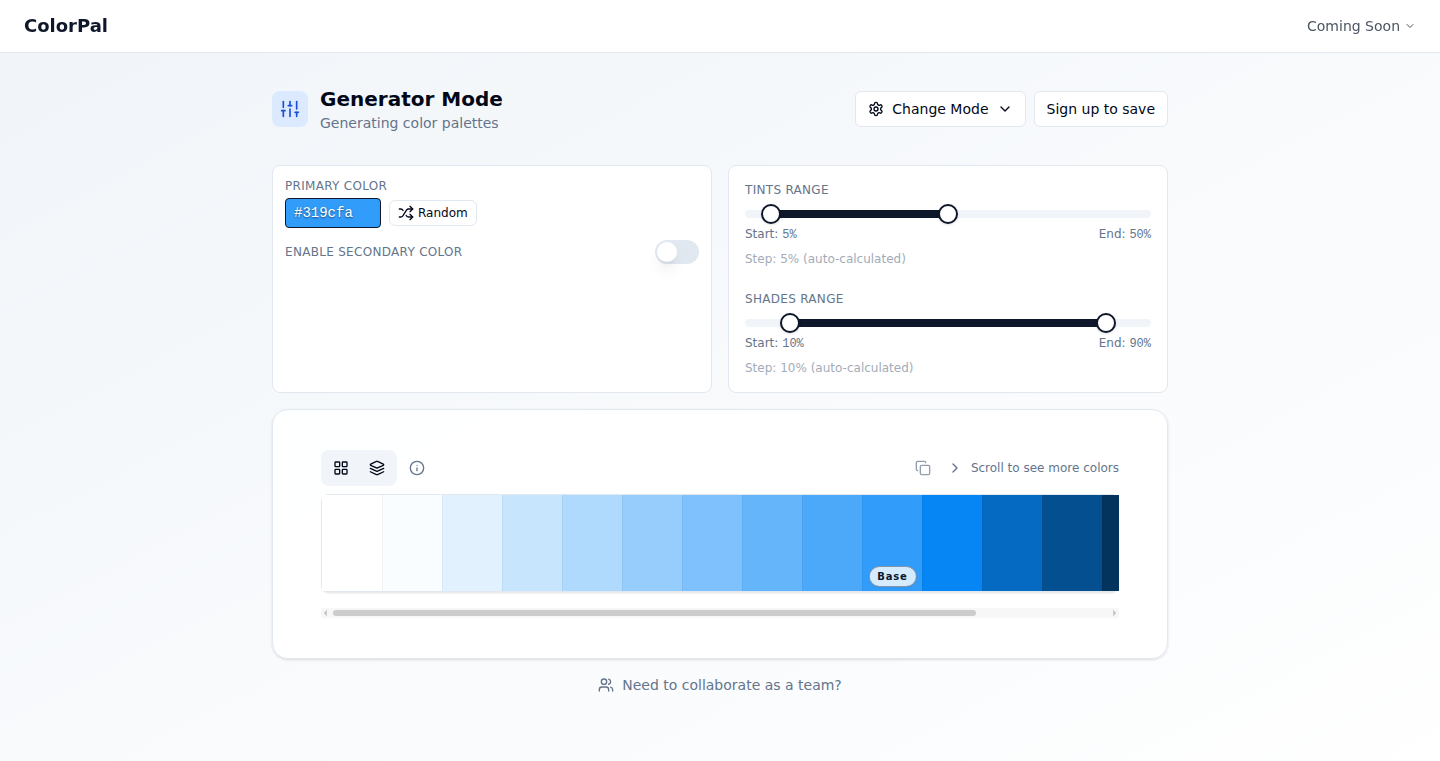
Author
mazahermuraj
Description
ColorPal is a straightforward tool designed to generate color palettes based on a single base color. It addresses the inconsistencies and limitations of using AI like ChatGPT for color palette generation in design workflows. The tool automatically generates tints and shades, offering two modes: palette generation and custom creation. This allows designers to quickly create and customize color palettes for their projects, streamlining the design process and providing more control over the color choices.
Popularity
Points 1
Comments 0
What is this product?
ColorPal is a web-based tool that helps designers and developers create color palettes. It takes a base color (inputted as a hex code, like #FF0000 for red) and automatically generates a range of tints (lighter versions) and shades (darker versions) of that color. The core innovation is its simplicity and directness. It provides a user-friendly interface to quickly generate and customize color palettes, which contrasts with the often unpredictable or cumbersome results from using AI models like ChatGPT for this purpose. So, this tool gives you more control over the colors and helps to create a consistent color scheme.
How to use it?
Developers and designers can use ColorPal by first inputting a base color, either by typing the hex code or using a color picker. The tool then generates a palette of tints and shades, which can be customized by adjusting the percentage steps for tint and shade generation. The generated color palette can be easily copied and pasted into design tools like Figma, Adobe Photoshop, or any other application that supports color code input. This allows for quick prototyping, UI design, and visual content creation. The tool is especially useful for web design, mobile app design, and branding where consistent and visually appealing color schemes are crucial.
Product Core Function
· Base Color Input: The ability to input a starting color (in hex code format). So, you can start with a specific color you like and build the palette around it.
· Tint and Shade Generation: Automatic generation of lighter (tints) and darker (shades) versions of the base color, with adjustable steps. This feature is super helpful to quickly create a consistent and visually appealing color scheme.
· Two Modes: Option to generate a palette automatically or customize it. This provides flexibility – either get a quick set of colors or fine-tune the palette.
· Customization: Ability to adjust the tint and shade generation steps (e.g., 5% tint steps, 10% shade steps). This lets you refine the colors to your exact preferences, giving you complete control over the palette.
· Copy-Paste Output: Easy copying of the generated color codes for use in design tools. So, it makes it extremely simple to get the colors into your design software.
· Free and No Signup: No sign-up or payment is required, meaning you can start using the tool instantly. So, it removes barriers to getting started.
Product Usage Case
· Web Design: A web designer can use ColorPal to quickly generate a color scheme for a new website, starting from a brand’s primary color and creating complementary tints and shades for different UI elements. This saves time and ensures color consistency across the entire website.
· Mobile App Design: A mobile app developer can use the tool to create color palettes for their app’s UI elements, ensuring that the app’s interface has a visually pleasing and consistent look and feel.
· Branding: A graphic designer can use ColorPal to create color palettes for branding purposes, selecting a primary brand color and then generating related tints and shades for use in marketing materials, logos, and other visual assets.
· UI Prototyping: Designers can use the generated color palettes in prototyping tools like Figma or Adobe XD to rapidly visualize and test different color schemes for a user interface, accelerating the design process.
· Accessibility Testing: Developers can utilize generated color palettes and modify them to comply with accessibility guidelines, guaranteeing the website or application can be easily used by people with visual impairments.
92
ForceAI: AI-Powered Workout Companion
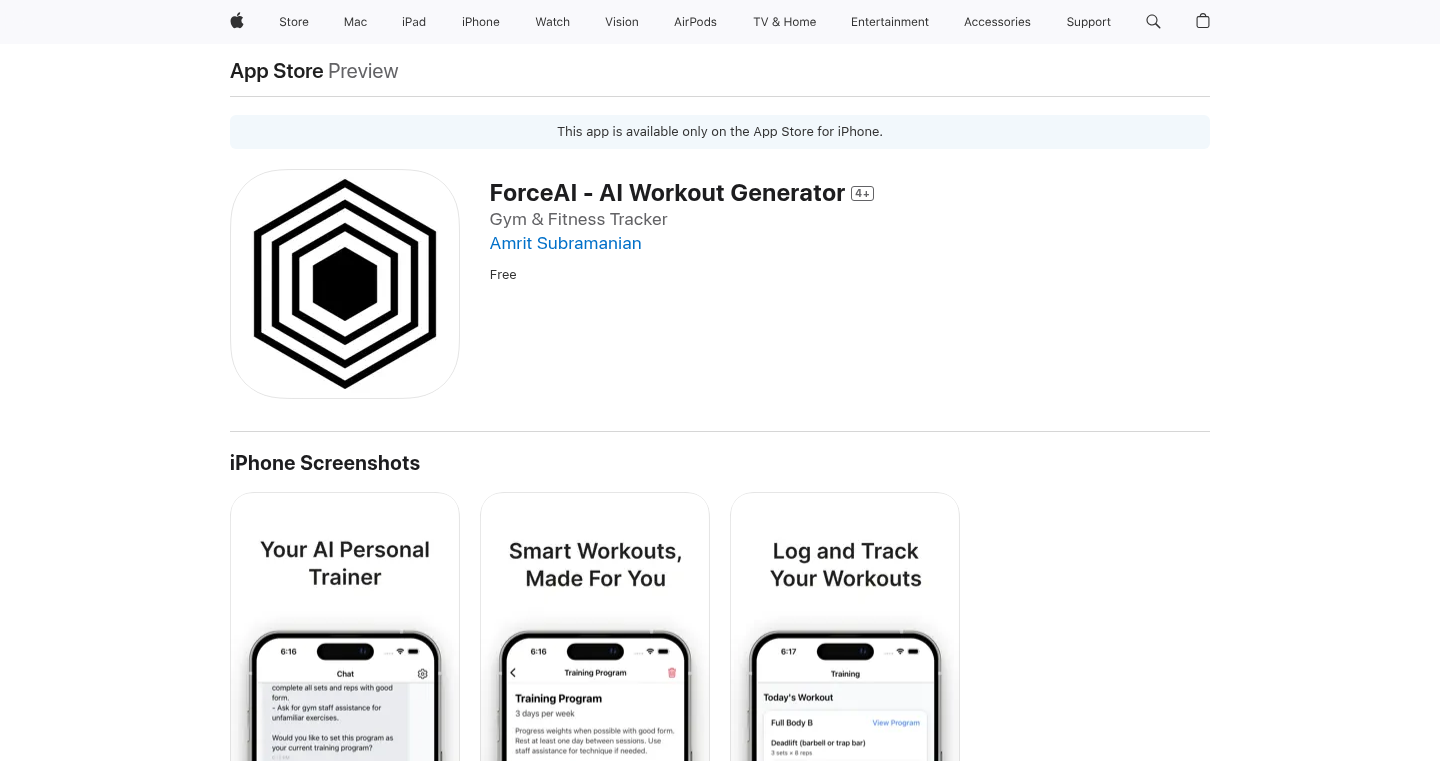
Author
asdev
Description
ForceAI is an iOS application that seamlessly integrates Artificial Intelligence (AI) into workout tracking. It eliminates the tedious copy-pasting between AI chatbots like ChatGPT and fitness tracking apps. The app allows users to generate workout programs, log exercises through a conversational interface (e.g., "I did 5 sets of squats at 135 lbs"), and receive AI-driven feedback and recommendations based on their workout history. The core innovation lies in bridging the gap between AI-powered workout generation and real-time tracking, offering a more streamlined and personalized fitness experience. So this helps you get better workout plans and track your progress easily.
Popularity
Points 1
Comments 0
What is this product?
ForceAI is essentially a smart personal trainer in your pocket. It leverages AI to create and adapt workout plans in real-time. Instead of manually inputting exercises and results, you can simply chat with the app. The AI then interprets your input, logs your workout, and can provide personalized advice, such as adjusting the weight or suggesting different exercises based on your performance. This project streamlines the process of workout generation, tracking, and analysis, all within a single, user-friendly interface. So it makes workout plan and tracking easier and smarter.
How to use it?
Developers can use ForceAI by integrating its core functionalities into similar fitness platforms or developing their own AI-powered fitness applications. The underlying technology can be adapted to create new products and services. The app's conversational interface offers an example of how to build a user-friendly interaction layer on top of complex AI models. The AI-driven recommendations can also be adapted to different domains requiring personalized suggestions and adjustments based on user history. So you can borrow the idea and build your own personalized assistant.
Product Core Function
· AI-Powered Workout Generation: This allows users to create complete training programs or individual workouts by chatting with the AI. The value is in automatically creating personalized workout plans, saving time and effort compared to manually planning workouts or relying on generic templates. For example, this can be applied in all the different fields of expertise.
· Instant Workout Loading: Workouts generated by the AI are instantly loaded into the app for easy tracking. This eliminates the need to manually input workouts, making the process much faster and less error-prone. This is very useful in various kinds of personal assistants and other scenarios where instant input is a must.
· Conversational Workout Logging: Users can log their sets and reps through a clean interface or by simply chatting: “I did 5 sets of squats at 135 lbs” and having it saved automatically. This provides a convenient and intuitive way to record workout data, making tracking less cumbersome. You can apply it to any application where instant data entry is required.
· AI-Driven Feedback and Recommendations: The AI provides advice, tweaks, and recommendations based on the user's workout history. This helps users to optimize their workouts and make progress. This is really useful in developing various fields like medical, business, and education.
Product Usage Case
· Fitness Tracking App: The core function of the product, it replaces the manual workout tracking. Imagine you are creating a fitness application, and your application is using AI to help users track and improve the fitness performance.
· Personalized Learning Platform: Adapting ForceAI's conversational logging and AI recommendation features, this could be used to create a platform where students can describe their learning progress through natural language, and the system can provide personalized study plans and recommendations. You can build a smart application to make your users to study much better.
· Automated Data Entry System: You can use the conversational interface from ForceAI to build a system where the users can input data by simply chatting, so it is easier and faster to collect the information.
93
CeresAi: Personalized AI Companions from Chat Logs
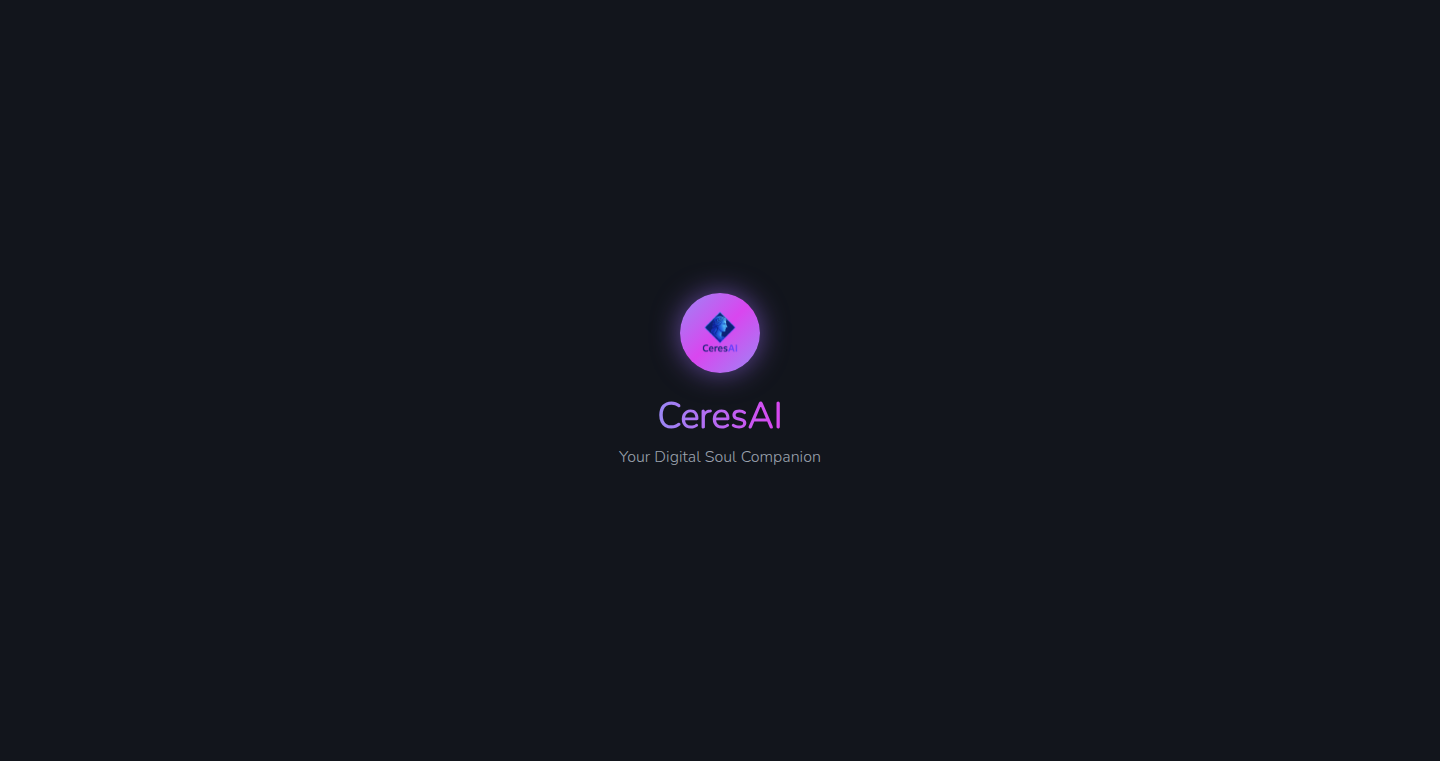
Author
Mahsanziak9
Description
CeresAi is a platform that lets you build AI companions based on your existing chat logs from WhatsApp, Instagram, or SMS. The magic lies in its ability to understand the unique way a person communicates – their specific phrases, emotional cues, and even past conversations. Think of it as creating a digital twin that can have realistic and heartfelt conversations with you. This solves the problem of generic chatbots and offers a more personalized and engaging experience.
Popularity
Points 1
Comments 0
What is this product?
CeresAi leverages advanced AI and natural language processing (NLP) techniques. It analyzes your chat history to learn a person's communication style. This involves complex algorithms to understand sentence structure, word choice, and sentiment. It then uses this learned information to generate responses that mimic the person's voice and personality. So, instead of a generic chatbot, you get something that feels like you're actually talking to the person. This is innovative because it moves beyond basic chatbots and offers a truly personalized experience. So, this is useful because you can create a digital companion to interact with and have meaningful conversations.
How to use it?
Developers can use CeresAi by providing their chat logs (e.g., from WhatsApp, Instagram, or SMS) as input. The platform analyzes the data and creates an AI companion. The companion can then be integrated into various applications or platforms, allowing users to interact with a digital representation of a person. For instance, a developer could build an app that allows users to reminisce with a digital version of a loved one or practice communication skills in a safe and realistic environment. So, this is useful because it provides a creative way to interact with AI and integrate it into different platforms or applications.
Product Core Function
· Chat Log Analysis: Analyzes chat histories (WhatsApp, Instagram, SMS) to identify communication patterns, including word choice, sentence structure, and sentiment. This is valuable because it forms the foundation for creating a personalized AI companion.
· Personalized Response Generation: Generates responses that mimic the learned communication style of the person, making conversations feel more authentic. This is valuable because it moves beyond generic chatbot responses, offering a more engaging interaction.
· Conversation Memory: Retains and utilizes past conversation data to maintain context and create a more coherent and meaningful conversational flow. This is valuable because it leads to more natural and realistic conversations.
· Pre-built Characters: Offers pre-configured AI characters for users to interact with (e.g., the Trump example). This is valuable because it provides instant access to engaging conversations and allows users to explore the platform's capabilities immediately.
Product Usage Case
· Creating a Digital Memorial: Developers can use CeresAi to create a digital representation of a deceased loved one, allowing family members to 'converse' with them and preserve memories. This is useful in providing comfort and a way to maintain a connection.
· Communication Practice: An educational app could utilize CeresAi to allow users to practice their communication skills with a virtual version of a friend, colleague, or family member, improving their ability to communicate in real life. This is useful for improving communication skills in a safe environment.
· Personalized Support Bots: Companies can use CeresAi to build customer service bots that communicate with customers in a way that feels more empathetic and personalized, enhancing the customer experience. This is useful for making customer service interactions more natural and effective.
· Entertainment Applications: Developers could integrate CeresAi into games or interactive stories, enabling users to interact with characters that truly feel alive and react to their conversations in personalized ways. This is useful for enhancing user engagement and immersion.
94
Gentoro: No-Code MCP Tool Generator Powered by GenAI
Author
GentoroAI
Description
Gentoro is a no-code platform that uses Generative AI (GenAI) to build tools for the Modular Components Platform (MCP). You can create, deploy, and test these tools without writing any code. Just paste in an OpenAPI spec (a standard way to describe how a web service works) or use natural language to describe the tool you want. It then automatically generates the tool, allowing you to deploy and test it immediately. So, this is a fast way to create tools that can be used with other AI frameworks like LangChain, accelerating the development process and reducing the need for manual coding.
Popularity
Points 1
Comments 0
What is this product?
Gentoro leverages GenAI to transform descriptions or OpenAPI specifications into functional MCP tools. Think of it as a smart translator that converts human-readable instructions or existing API definitions into ready-to-use components. This is innovative because it removes the traditional barriers of coding, making it easier for developers of all skill levels to create and deploy custom tools. The core technology uses GenAI models to interpret requirements and build the tools, simplifying a complex development process. So, this means you can get your tools built and running faster.
How to use it?
Developers can use Gentoro by either providing an OpenAPI specification or by describing the desired tool using natural language. Gentoro then automatically generates the MCP tool. After generation, the tool can be immediately deployed and tested. These tools are designed to work with any agent framework that supports MCP, such as LangChain or AutoGen. For example, you could describe a tool to retrieve customer data and Gentoro will build it, which can then be integrated into a LangChain-based application to provide a customized customer service solution. So, this allows developers to quickly prototype and integrate new functionalities.
Product Core Function
· OpenAPI Spec Parsing and Tool Generation: This feature allows users to input an OpenAPI specification, and Gentoro will automatically generate the corresponding MCP tool. This is valuable because it simplifies the integration of existing APIs, reducing the need to write custom code for API interaction. It provides a way to immediately create tools from established API standards. So, this is useful when you want to quickly turn an existing API into a usable tool.
· Natural Language Description to Tool Generation: Users can describe the tool they need in natural language, and Gentoro will interpret the description and generate the appropriate MCP tool. This is valuable because it lowers the barrier to entry for developers, making it easier to create tools even if they have limited coding experience. So, this helps to quickly create a prototype, enabling quicker experimentation and validation of ideas.
· Automated Deployment and Testing: Gentoro provides a built-in deployment and testing environment for the generated MCP tools. This allows developers to quickly test and validate their tools, ensuring they function correctly before integrating them into a larger system. So, this helps improve the efficiency of the development lifecycle by providing quick feedback loops.
· MCP Compatibility: The tools generated by Gentoro are compatible with any agent framework that supports MCP (e.g., LangChain, AutoGen). This interoperability enables seamless integration into existing AI workflows and applications. So, this allows developers to easily integrate the generated tools with popular AI frameworks.
Product Usage Case
· API Integration: A developer needs to integrate a third-party payment processing API into a chatbot. Using Gentoro, the developer could provide the OpenAPI specification for the payment API, and Gentoro would generate the necessary MCP tool. Then, they could integrate this tool with a framework like LangChain. So, this allows a quick setup of a payment processing integration without writing a lot of code.
· Customer Service Automation: A business wants to automate customer data retrieval. Using natural language, the business can describe the tool needed. Gentoro generates an MCP tool that retrieves customer data, then they integrate it into an agent framework to provide automated answers. So, this automates a customer service process by quickly building a tool that fits the requirements.
· Rapid Prototyping: A developer wants to experiment with different tools. They can quickly describe their requirements to Gentoro, which generates a tool for a specific use case. The developer can then test and refine the tool based on the initial output. So, this provides a quick way to test ideas and build proof-of-concept tools before investing heavily in development.
95
ProfileAIPro: AI-Powered Professional Headshot Generator

Author
starboat
Description
ProfileAIPro leverages the power of artificial intelligence to generate professional headshots for your LinkedIn profile. It addresses the common problem of needing high-quality, updated profile pictures without the hassle and expense of traditional photography. The project utilizes a combination of AI image generation and face enhancement techniques, offering a quick, realistic, and professional solution. The core innovation lies in automating the creation of headshots tailored to professional contexts, significantly reducing the time and cost associated with image updates.
Popularity
Points 1
Comments 0
What is this product?
This project employs AI to create professional headshots. You upload a few photos, and the system uses advanced image generation models to create new headshots in various styles and backgrounds. The AI understands what makes a photo "professional" in a LinkedIn context, automatically adjusting lighting, expressions, and overall image quality. The innovation here is the automation and accessibility of generating professional-looking images, effectively democratizing the process.
How to use it?
Developers can integrate this functionality into their own applications or services related to professional networking, recruitment, or identity verification. They might use ProfileAIPro's API (if available) to offer headshot generation as a feature within their platforms. For example, a career site could offer users the ability to quickly generate a professional photo directly within their profile editing process, or a recruitment tool could automatically enhance candidate profile pictures.
Product Core Function
· AI-Powered Image Generation: Uses sophisticated AI models to create realistic headshots. This means it can generate entirely new images based on your uploaded photos, offering a wider variety of looks. So what? This allows for quick updates to your professional image without the need for new photoshoots, saving you time and money.
· Face Enhancement and Refinement: The AI automatically enhances the faces in the generated images, improving details like skin tone, lighting, and overall image quality. So what? This ensures the final images look polished and professional, increasing your profile's visual impact.
· Style and Background Customization: Allows for selection of various professional styles and backgrounds. So what? You can tailor your headshot to fit your industry or personal brand, creating a more personalized image.
· Quick Processing and Delivery: Generates the headshots rapidly. So what? This provides instant access to updated professional headshots, removing the long wait times often associated with traditional photography.
· Batch Processing (Potentially): The ability to generate multiple headshots at once. So what? This allows you to quickly experiment with different styles and find the perfect image for your needs.
Product Usage Case
· A professional networking platform could integrate ProfileAIPro to allow users to update their profile pictures directly within the platform, enhancing user experience and profile engagement. This solves the problem of outdated or low-quality profile photos, which can negatively impact a user's professional image. So what? This can boost user engagement and improve the platform's perceived value.
· A recruitment agency could use ProfileAIPro to automatically generate professional headshots for candidates. This streamlines the application process and ensures that candidate profiles are visually appealing, improving the first impression on potential employers. So what? This speeds up the recruitment process and enhances candidate presentation.
· A personal branding service could utilize ProfileAIPro as a core offering. This solves the problem of clients needing high-quality, up-to-date professional images quickly and cost-effectively. So what? It adds value to the service by offering a faster and more affordable solution.
· An HR department in a large company could use ProfileAIPro to create a standardized and professional headshot look for its employees for internal company directories and other internal purposes, improving the company's brand identity and visual consistency. So what? It ensures all employee profiles look professional.
96
Memva: Terminal-Native Software Sales
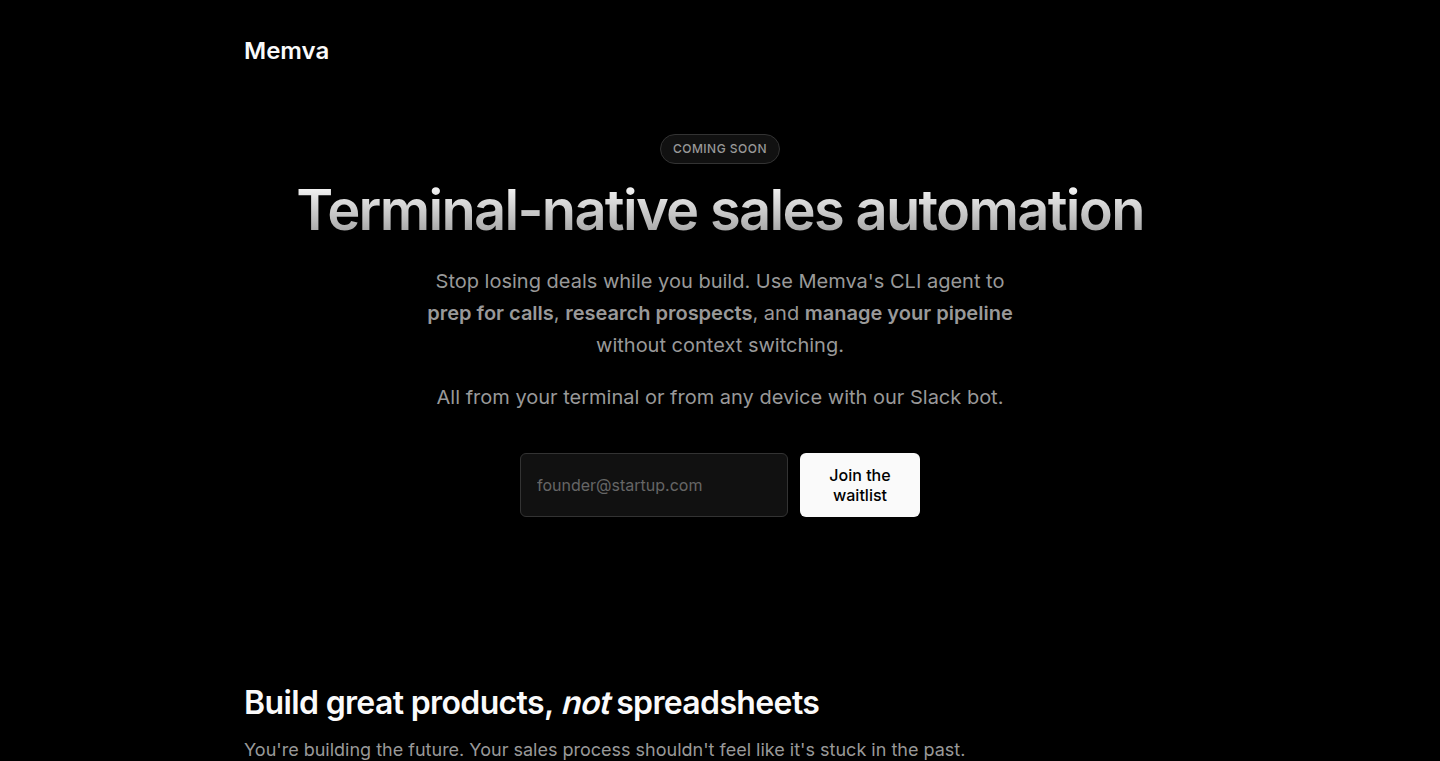
Author
mbm
Description
Memva is a command-line tool that enables developers to sell their software directly from the terminal. It focuses on providing a streamlined experience for both sellers and buyers, eliminating the need for external websites or complex setups. The core innovation lies in its simplicity and integration with the developer's workflow, solving the problem of cumbersome software distribution.
Popularity
Points 1
Comments 0
What is this product?
Memva is a CLI tool that acts like a mini-store for your software, right inside the terminal. Instead of forcing users to navigate web pages to buy and then figure out how to install your software, Memva simplifies the process. It uses terminal commands to manage licenses, handle payments (likely through Stripe or similar services), and deliver software directly to the user. The innovation is in its focus on developer experience – allowing developers to quickly set up a sales channel without leaving their development environment. So, this enables developers to sell software with minimal friction.
How to use it?
Developers would install Memva, configure their software details (price, license terms, etc.), and then include a simple command in their project's README or documentation. When a user wants to buy the software, they run this command in their terminal. Memva takes care of the rest: payment, license generation, and installation (if automated). This is useful for selling command-line tools, libraries, or any software that can be distributed as a package or accessible via the terminal. So, this allows developers to sell their CLI tools directly without needing to set up a website or manage payment processing manually.
Product Core Function
· License Management: Generate and manage software licenses automatically. This helps prevent unauthorized use of the software, and ensures only paying users can access the full features. For example, imagine you develop a cool tool that helps with code formatting; you can manage who is using the tool. This saves you time and adds security.
· Payment Processing: Integrate with payment gateways to handle transactions. This is a huge time saver because developers don't need to build the payment integration from scratch. So, if you want to get paid for your open-source CLI utility, Memva would enable it.
· Software Delivery: Provide a mechanism to securely deliver the software to the buyer after successful payment. This could be a download link, a package installation, or simply unlocking features within the tool itself. For instance, if you sell a CLI tool that helps manage AWS resources, Memva can automatically unlock the premium features after payment. So, this automatically delivers your software once payment is complete.
· Terminal-Based Interface: Provide a seamless user experience from the terminal, eliminating the need for external websites. This allows developers to maintain a simple and integrated selling experience. So, the buying experience becomes much easier for the end-user.
Product Usage Case
· Selling Command-Line Utilities: A developer creates a powerful CLI tool for data analysis. Using Memva, they embed a command in their README.md file that users can use to purchase a license. When a user runs the command, they are guided through the purchase process and receive a license key, which activates the software. So, this simplifies selling of command-line tools.
· Distributing Open-Source Software with Paid Features: A developer wants to offer a 'pro' version of their open-source project. They use Memva to handle payments and unlock the pro features for users who pay. When a user buys a pro license, Memva will install the required package or enable the additional features. So, this enables developers to monetize their open-source project.
· Selling Custom Software Packages: A developer builds a custom script for a client and wants to sell it as a one-time package. Memva allows them to set up the sale process in a few simple steps, providing a secure way to receive payments and deliver the software to the client directly. So, this provides a streamlined sale process for custom-built software.
97
Word Pivot - A Daily Word Puzzle Solver
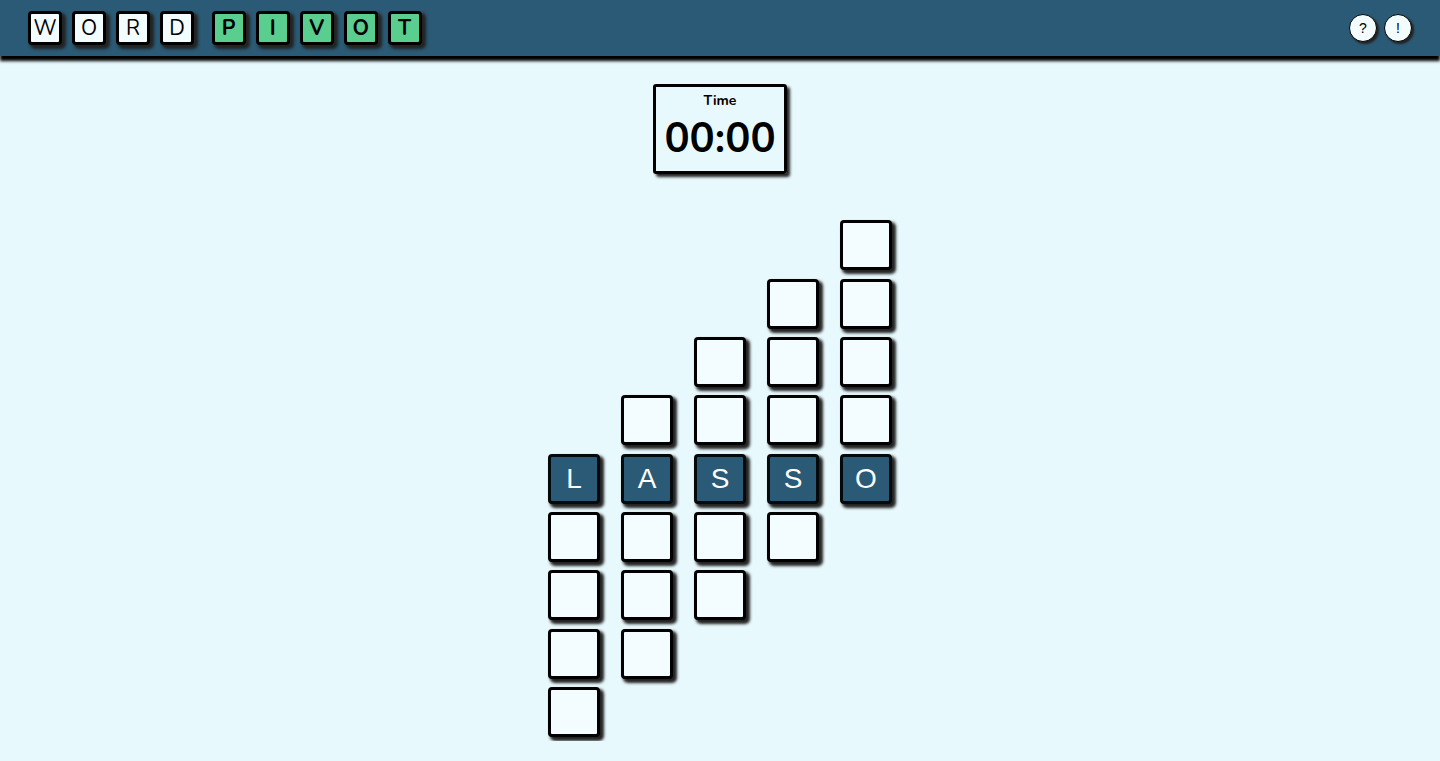
Author
max0563
Description
Word Pivot is a minimalistic daily word game solver. It takes your current word game progress (letters, positions, and excluded letters) and uses a dictionary and simple word matching to suggest possible solutions. The technical innovation lies in its streamlined approach to filtering words based on a limited set of information, providing a fast and efficient way to crack daily word puzzles. This project tackles the problem of the tedious trial-and-error approach in word games, offering a computational advantage.
Popularity
Points 1
Comments 0
What is this product?
Word Pivot is a simple program that helps you solve those daily word puzzles you might find online. It works by taking the letters you know are in the word, their positions (if you know them), and the letters you know are *not* in the word. It then uses a list of words (a dictionary) and checks them against these clues to find possible answers. The innovation is its ease of use and speed: it quickly narrows down the possibilities, saving you time and frustration. So, it's like having a smart assistant for word games.
How to use it?
As a developer, you'd likely use Word Pivot by inputting the information about the puzzle you're stuck on (letters, positions, excluded letters) through a simple command-line interface or a similar input method. You'd get a list of potential solutions back. It's great if you're creating a word game or just want a quick helper. Think of it as an API you could integrate to offer hints or solve puzzles programmatically.
Product Core Function
· Word Filtering: This is the core function. The program takes your input (known letters, positions, and excluded letters) and compares it against a dictionary of words. Value: Provides a fast and efficient way to narrow down the possible words. Application: Useful for creating a game helper or analyzing word patterns in datasets.
· Dictionary Integration: The project uses a dictionary (word list) as its source of potential answers. Value: Allows the program to check your input against a wide range of words. Application: Core building block for any word-related application.
· Command-line interface (or similar input): The way you provide your word game clues to the solver. Value: Simplifies user interaction and makes the tool easy to use. Application: Provides a simple way for users to interact with a more complex algorithm.
Product Usage Case
· Word Game Assistant: You're stuck on the daily word game? Input the known information, and Word Pivot will suggest potential solutions. So this saves you time and guesses, leading to a quicker solution.
· Educational Tool: You are a teacher wanting to illustrate how word patterns and algorithms interact. You could use it as a demonstration tool. So, it provides an interactive way to teach vocabulary or language concepts.
· Data analysis : You need a fast way to find words that match specific patterns in a large text corpus. You provide known information, and it will filter through a vast library of words. So, it aids you in data analysis and natural language processing tasks.
98
HaloTool: AI Tool Navigator with Real-time Traffic Insights
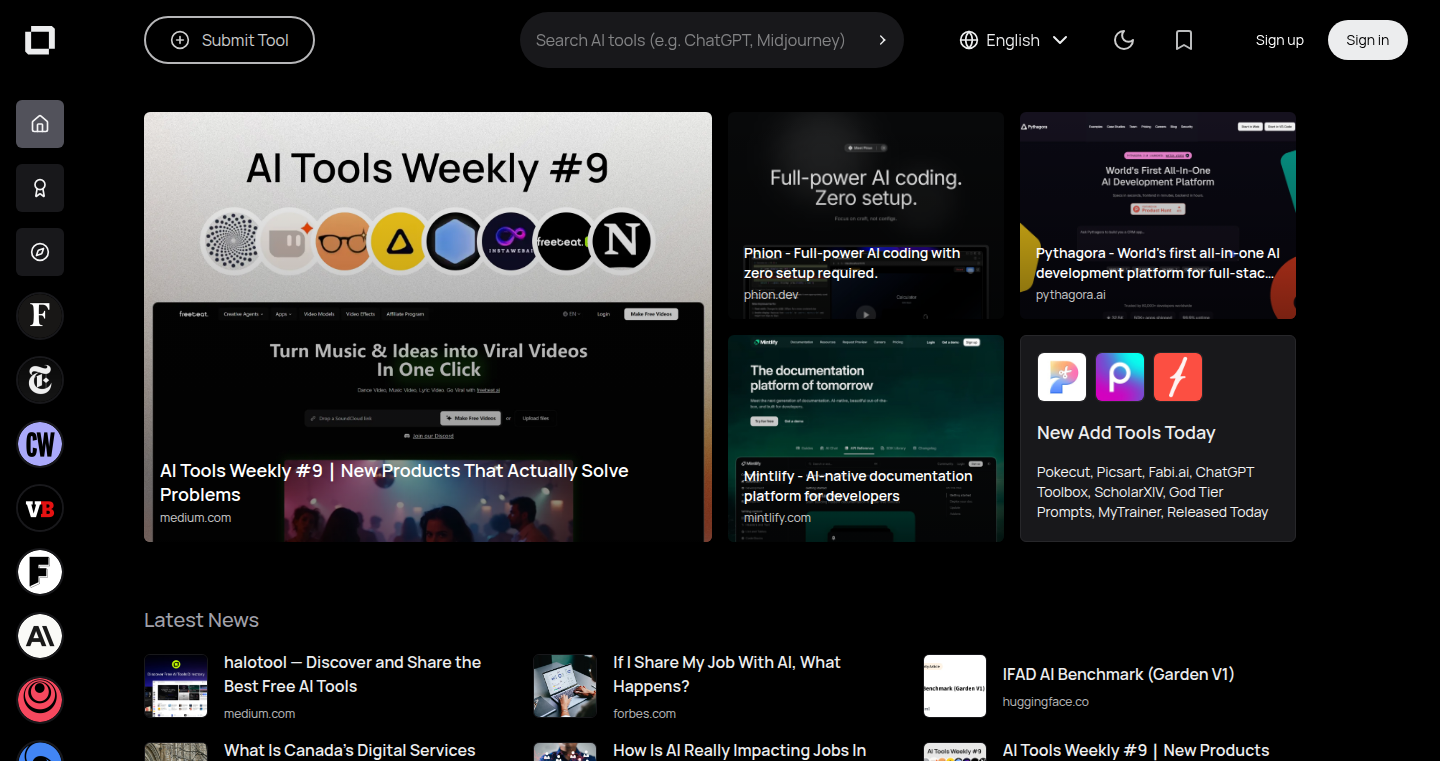
Author
ximu
Description
HaloTool is a curated directory designed to help you discover free and practical AI tools efficiently. It goes beyond simple listings by providing real-time traffic trend data, allowing users to identify tools that are actively being used. This project tackles the problem of information overload in the rapidly evolving AI landscape, filtering out outdated and irrelevant tools. Furthermore, it offers curated AI news in multiple languages, making it a comprehensive resource for staying informed.
Popularity
Points 1
Comments 0
What is this product?
HaloTool is essentially a smart search engine for AI tools. It uses a comprehensive database of over 1000 AI tools, constantly updated. The core innovation lies in its ability to show you not only what AI tools exist, but also how popular they are, based on real-time traffic data. This lets you avoid dead ends and focus on the tools that matter. So this is useful because it saves you time and directs you towards tools that are actively being used and maintained.
How to use it?
Developers can use HaloTool as their starting point for any AI project. For instance, if you need an AI tool for image generation, you can filter by category and see which free options are trending. You can then directly access the tool and see its usage trends. This project is also beneficial for understanding current AI tool usage trends. You can find it on halotool.com.
Product Core Function
· Curated Directory: HaloTool maintains a hand-picked collection of AI tools, ensuring quality and relevance. This saves you time and ensures you are not exposed to outdated or spammy resources. It also helps you filter and discover AI tools more efficiently. So this helps me save time in researching the right tools.
· Real-time Traffic Trends: Each tool listing includes traffic trend data, providing insights into its actual usage. This allows you to prioritize tools that are actively used, improving your chances of finding useful and well-supported solutions. This tells you which tools are actually being adopted by others.
· Multi-language Support for AI News: The inclusion of AI news in Chinese, English, Japanese, and Korean, indicates a commitment to global reach, making HaloTool a valuable resource for developers and enthusiasts worldwide. It helps you stay informed about the latest developments in the field and what the experts are saying.
· Filtering and Search: HaloTool provides a suite of filtering options (language, category, pricing, platform) to narrow down search results. This reduces the time and effort needed to find the perfect AI tool for a specific task.
· Daily Updates: The constant updates to the tool database and news feed indicate a commitment to accuracy and being current. This provides the users with the most relevant tools.
Product Usage Case
· A developer looking to build an AI-powered chatbot can use HaloTool to find and compare various natural language processing (NLP) tools. The traffic data helps them choose popular tools. So this allows a developer to identify popular and trending solutions.
· A marketing team exploring AI-driven content generation tools can use HaloTool to filter by content creation categories. By analyzing traffic trends, they can then select the tools being actively used, which indicates functionality and support. So this ensures the marketing team won't be wasting time in obsolete products.
· A researcher can explore the AI landscape and stay up to date on the latest developments in AI, accessing the international AI news through multiple languages. So the researcher can see the development and trend of AI